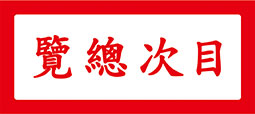Study Abroad
Study Abroad
Madame Chiang Soong Mei-ling was born on 4 March 1898, in the 24th year of the Kuang-hsü reign. She passed away on 23 October 2003, in the 92nd year of the Republic of China. Her family was from Wen-ch’ang County (文昌縣), Kwangtung Province, but she was born in Shanghai. Her father, tzu Yao-ju (耀如), original name Chia-shu (嘉樹), was a Christian pastor and a revolutionary elder. She had older sisters Ai-ling (靄齡) and Ch’ing-ling (慶齡), older brother Tzu-wen (子文,also known as Tse-vung) and younger brothers Tzu-liang (子良) and Tzu-an (子安). In 1904, the 30th year of the Kuang-hsü reign, she entered McTyeire School in Shanghai. In 1908, the 34th year of the Kuang-hsü reign, she moved to live in the United States at the age of eleven. In 1912, the 1st year of the Republic, she entered the Wesleyan College in Georgia. In 1913, the 2nd year of the Republic, she enrolled at Wellesley College in Massachusetts. In 1917, the 6th year of the Republic, she returned to China.
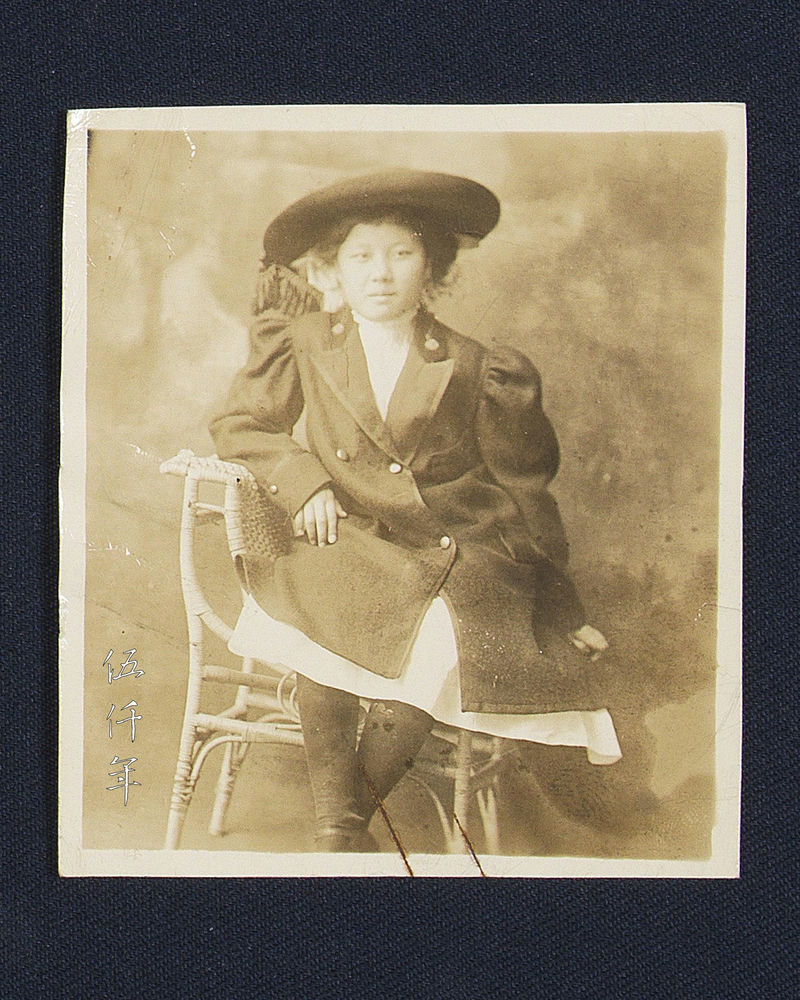
Madame Chiang Kai-shek at age ten. Photograph courtesy Mr. Roy Delbyck
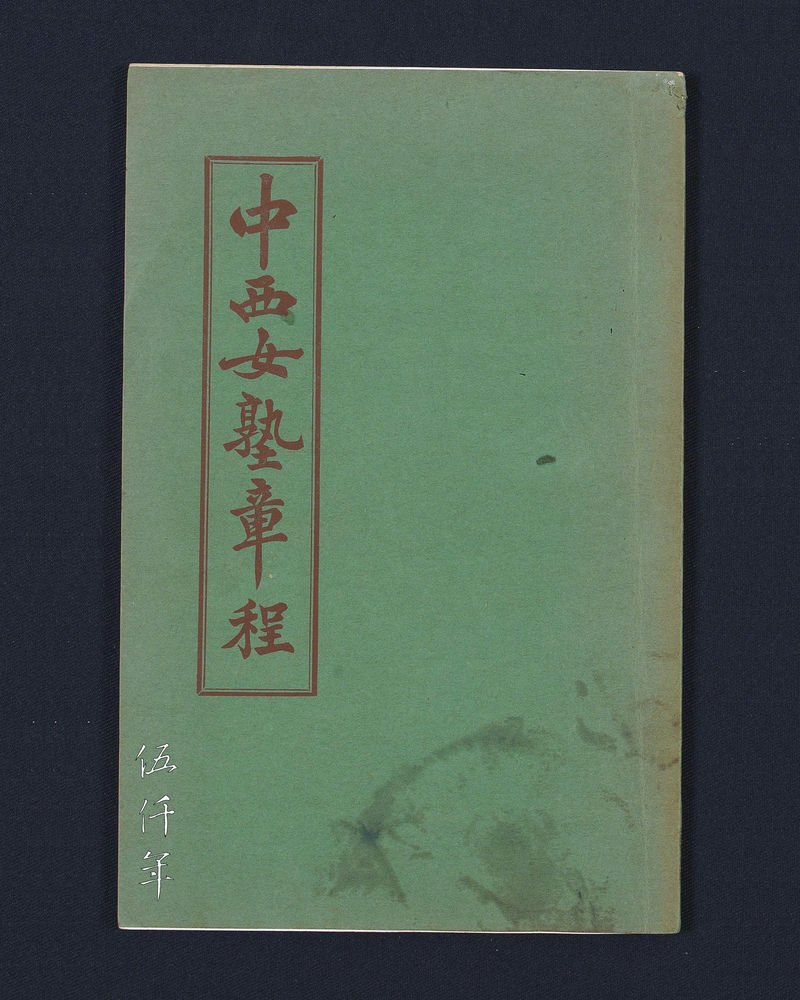
Front cover of McTyeire School yearbook with Chinese title. Madame Chiang Kai-shek enrolled at McTyeire School, Shanghai, in 1904. Photograph courtesy Mr. Roy Delbyck

Back cover of McTyeire School yearbook with English title. Madame Chiang Kai-shek enrolled at McTyeire School, Shanghai, in 1904. Photograph courtesy Mr. Roy Delbyck

Programme of annual concert in the school chapel by the students of music and expression at McTyeire School on 1 July 1910. Photograph courtesy Mr. Roy Delbyck

Front cover of the 1917 edition of Legenda, Wellesley College yearbook. Madame Chiang Kai-shek enrolled at Wellesley College in 1913. Photograph courtesy Mr. Roy Delbyck
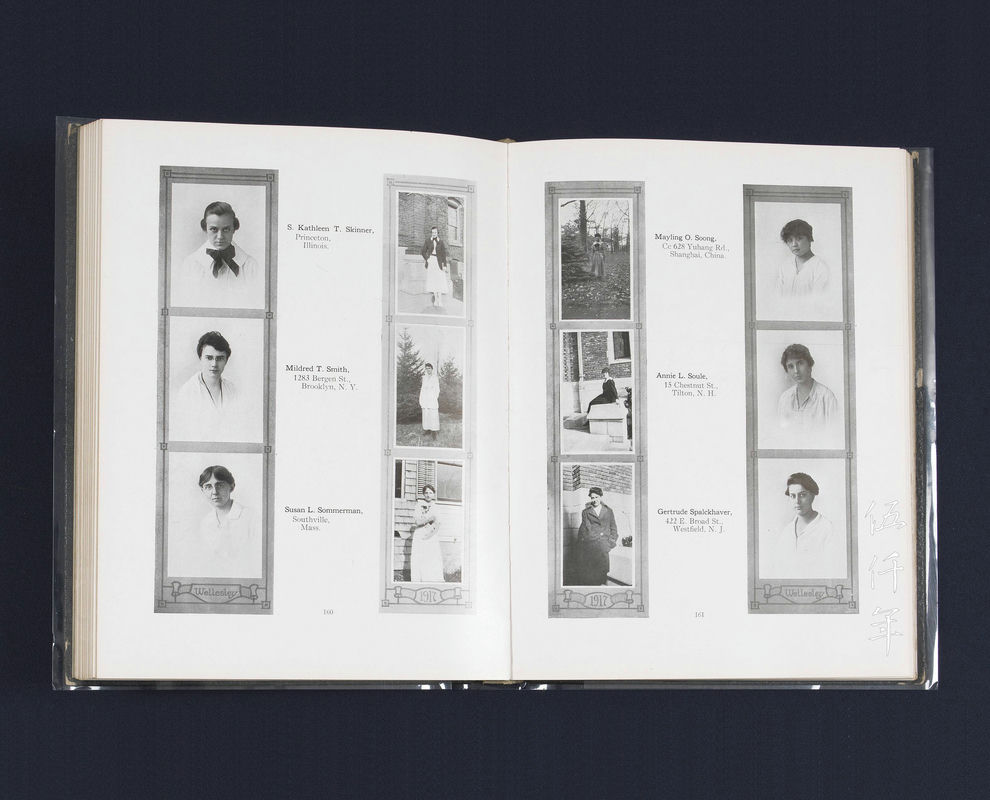
Inside pages of the 1917 edition of Legenda, Wellesley College yearbook, with photograph of Madame Chiang Kai-shek at right upper corner of the recto page. Photograph courtesy Mr. Roy Delbyck

Admission of Chinese Students to American Colleges compiled by John Fryer, missionary and scholar, in 1909. There were already many students studying in America by 1909. Photograph courtesy Mr. Roy Delbyck

Front cover of China’s Claims at the Peace Table, published by the China Society of America in March 1919, to reiterate China’s position at the Paris Peace Conference. Photograph courtesy Mr. Roy Delbyck

Inside page of China’s Claims at the Peace Conference, published by the China Society of America in March 1919. Photograph courtesy Mr. Roy Delbyck
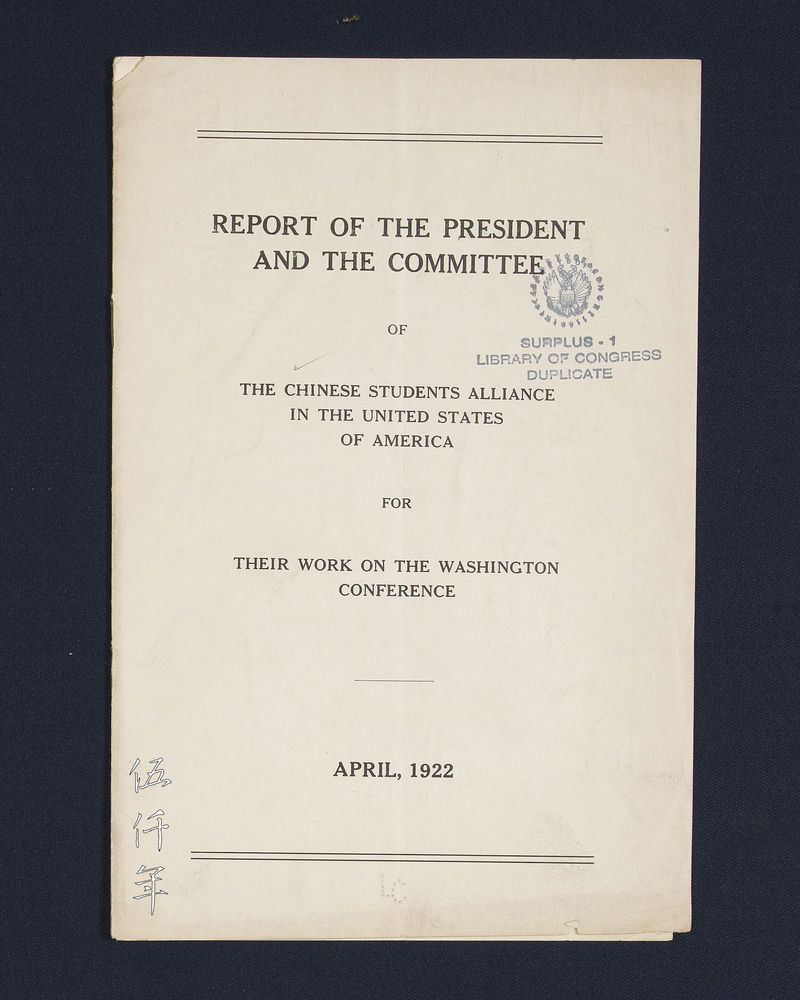
Front cover of Report of the President and the Committee of the Chinese Students Alliance in the United States of America for Their Work on the Washington Conference, published in April 1922. Chinese students in America were deeply interested and involved in Chinese political issues and international affairs. Photograph courtesy Mr. Roy Delbyck

Inside page of Report of the President and the Committee of the Chinese Students Alliance in the United States of America for Their Work on the Washington Conference. Photograph courtesy Roy Delbyck
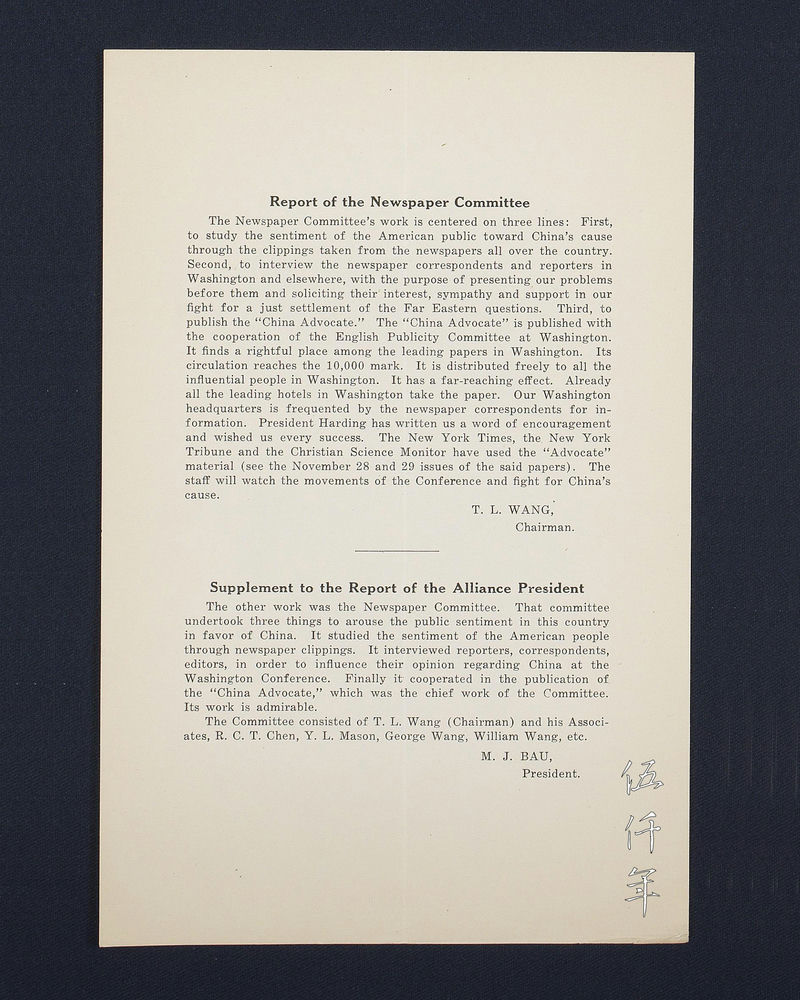
Inside page of Report of the President and the Committee of the Chinese Students Alliance in the United States of America for Their Work on the Washington Conference. Photograph courtesy Mr. Roy Delbyck

Front cover of Makers of New China in College in America. The illustration and title convey the optimism and hope of Chinese students for a New China. Photograph courtesy Mr. Roy Delbyck
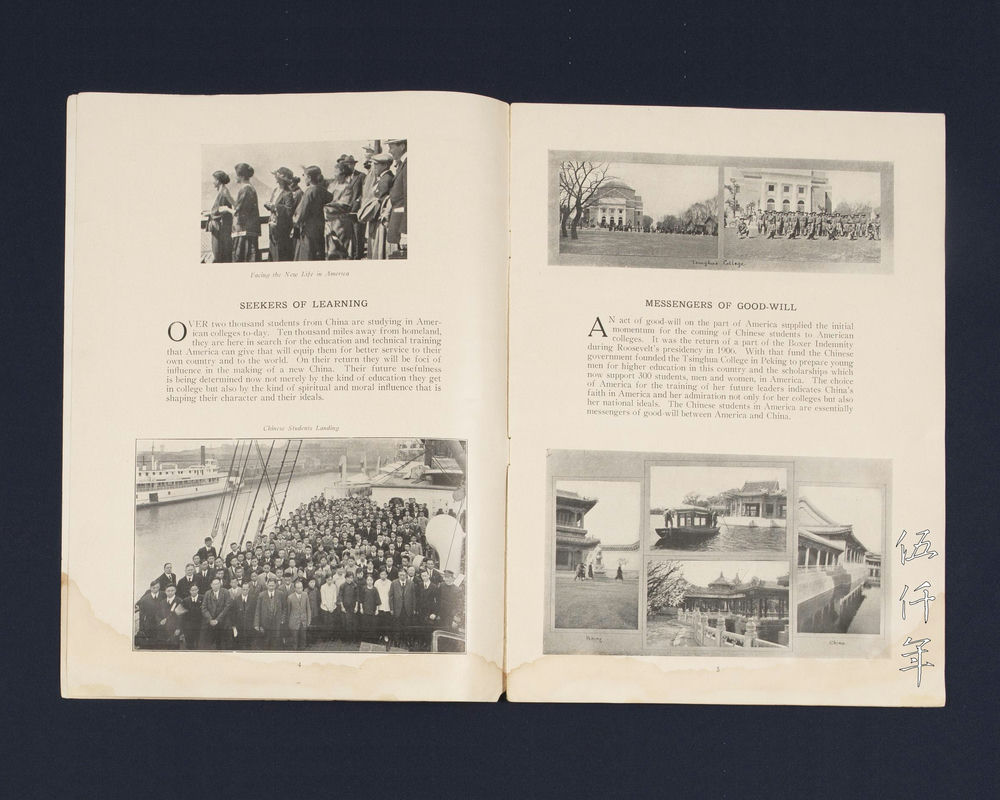
Inside pages of Makers of New China in College in America. Photograph courtesy Mr. Roy Delbyck
Marriage in Shanghai
Marriage in Shanghai
After Madame Chiang Soong Mei-ling returned to China, she first taught at the Young Women’s Christian Association in Shanghai. Afterwards, she worked at the Child Labour Working Committee of the Ministry of Labour and the Eastern Times (上海時報). In 1927, the 16th year of the Republic, she married the late President Chiang Kai-shek. The wedding was held at the Majestic Hotel in Shanghai. Under her influence, President Chiang became a Christian. In 1934, the 23rd year of the Republic, President Chiang initiated the New Life Movement (新生活運動) in Nan-ch’ang (南昌) and she assisted in its promotion. In 1936, the 25th year of the Republic, she became superintendent of the Women’s Work Guidance Committee of the Association for the Advancement of New Life Movement (新生活促進總會婦女工作指導委員會指導長). On 12 December of the same year, when Chang Hsüeh-liang (張學良) abducted President Chiang during the Sian Incident, Madame Chiang’s skillful handling of the situation played a crucial role in resolving the crisis.
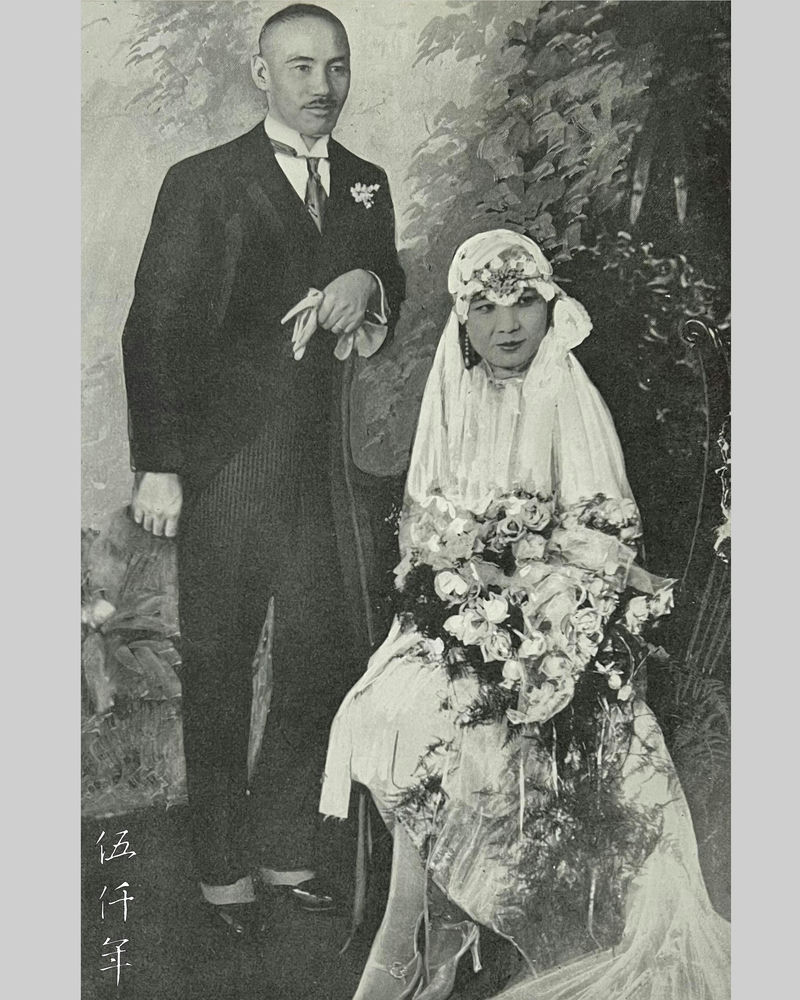
Artist’s illustration of the wedding of President Chiang Kai-shek and Ms. Soong Mei-ling on 1 December 1927. Photograph courtesy Private Collection
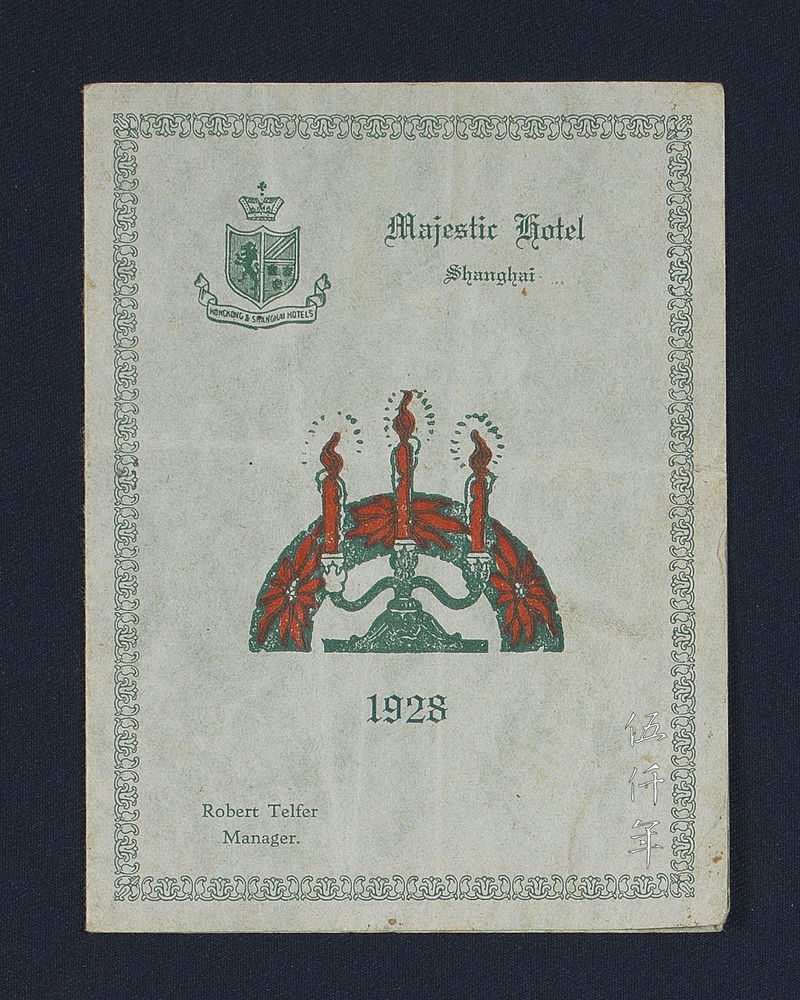
The wedding of President Chiang Kai-shek and Ms. Soong Mei-ling on 1 December 1927 took place at the Majestic Hotel in Shanghai. Front cover of Christmas Menu from the Majestic Hotel dated 24 December 1928. Photograph courtesy Mr. Roy Delbyck

Inside pages of the Christmas Menu from the Majestic Hotel dated 24 December 1928. Photograph courtesy Mr. Roy Delbyck
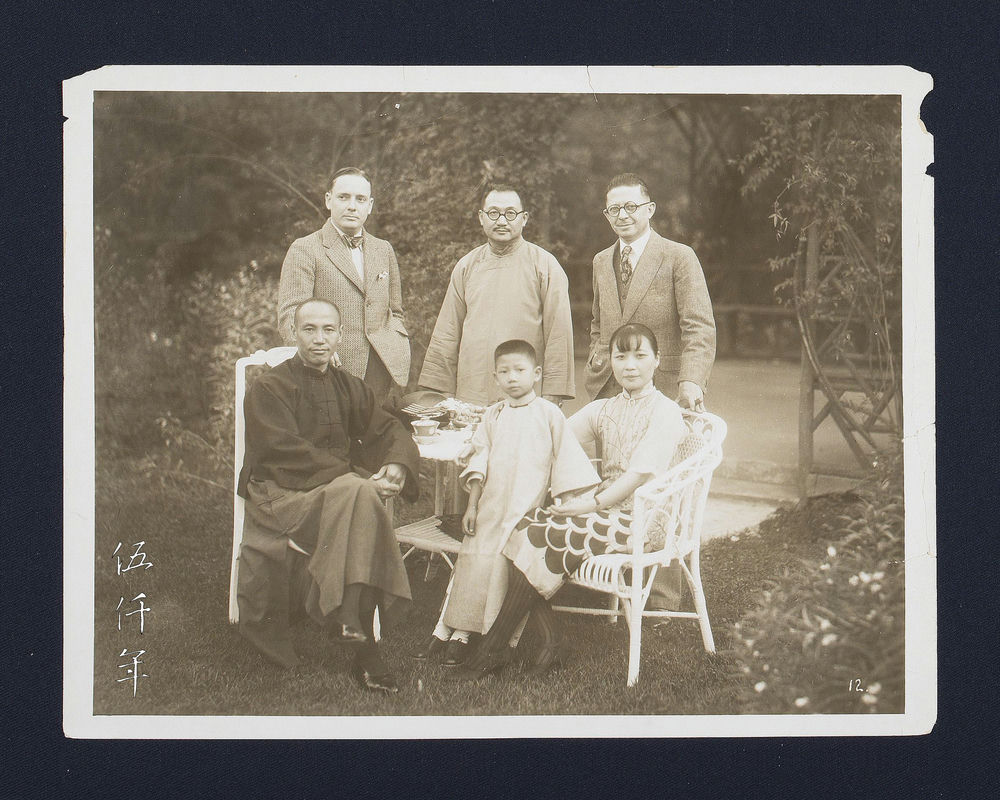
Photograph of President Chiang Kai-shek (left), Madame Chiang Kai-shek (right) and K’ung Hsiang-hsi (孔祥熙, centre). Photograph courtesy Mr. Roy Delbyck

Madame Chiang Kai-shek attending a military parade on 11 November 1929. Photograph courtesy Mr. Roy Delbyck
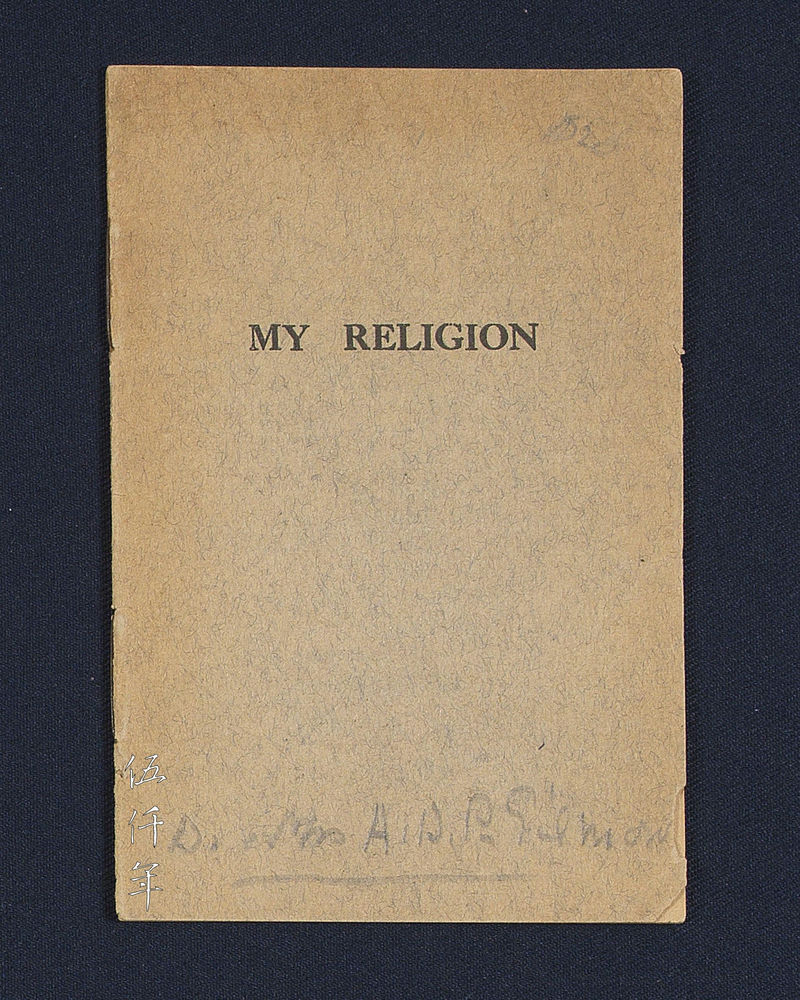
Front cover of My Religion by Madame Chiang Kai-shek, the article was earlier published on 14 May 1934 in the Shanghai Evening Post and Mercury. Madame Chiang Kai-shek wrote this article as a devout Christian, hence the sub-title A Personal Exposition by the First Lady of Present China. Photograph courtesy Mr. Roy Delbyck
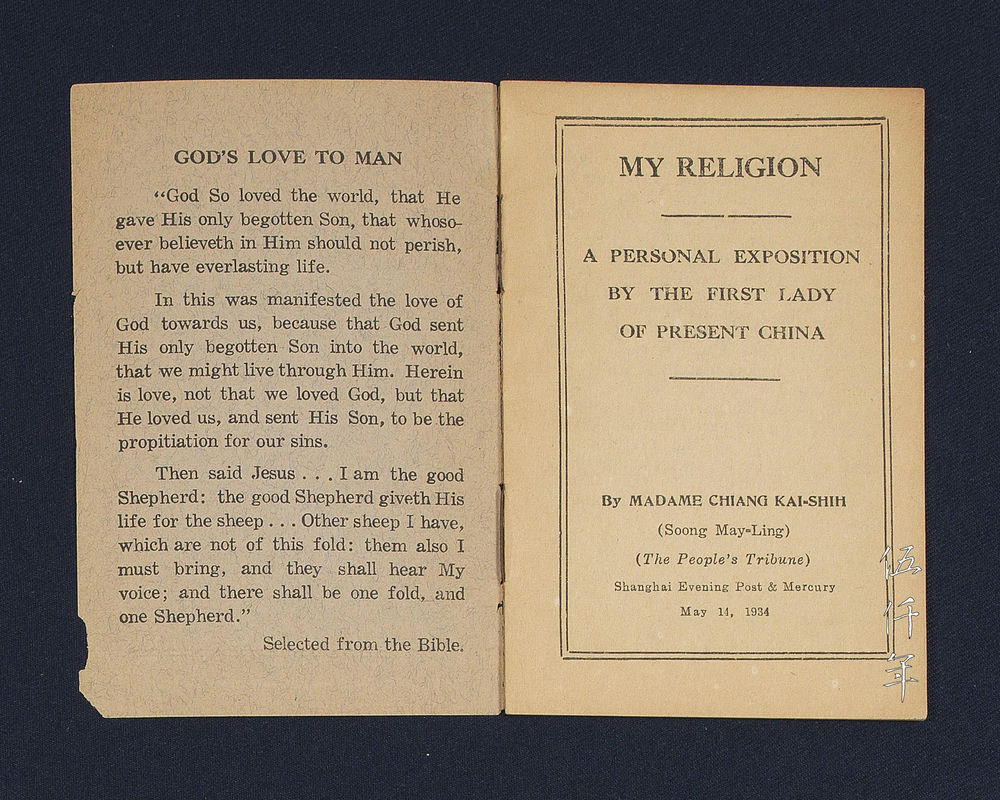
Inside page of My Religion by Madame Chiang Kai-shek. Photograph courtesy Mr. Roy Delbyck
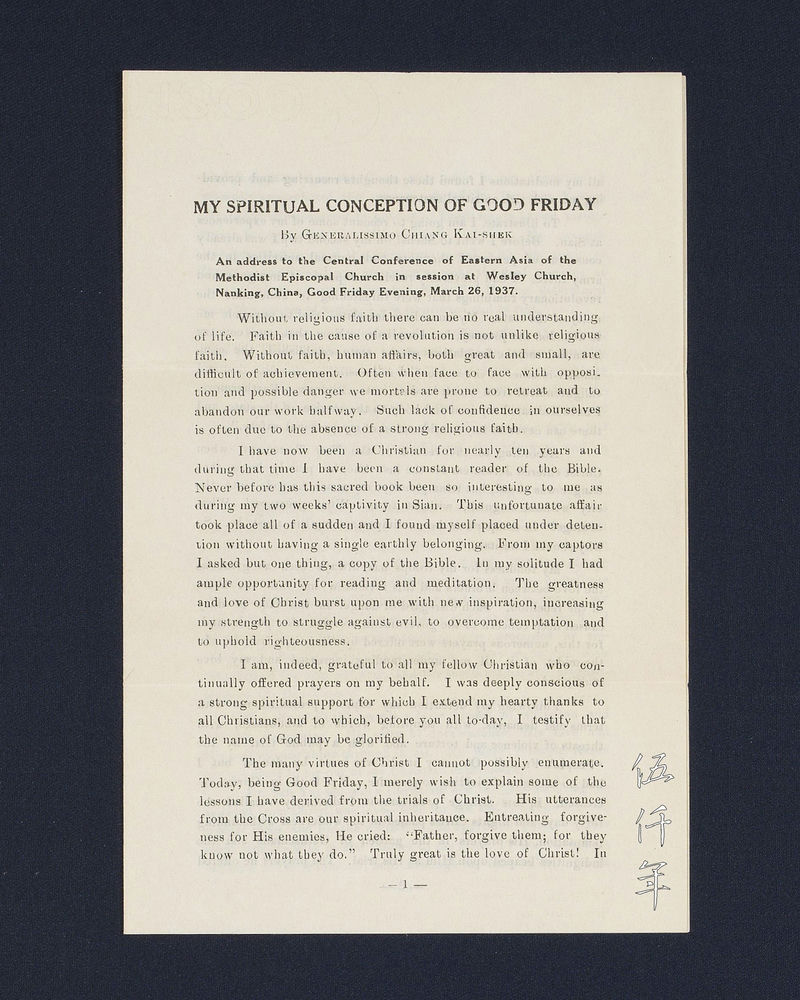
A copy of the English translation of the homily delivered by President Chiang Kai-shek on 26 March 1937 at the Wesley Church in Nanking, titled My Spiritual Conception of Good Friday. President Chiang became a Christian through the influence of Madame Chiang. On 12 December 1936 he was kidnapped by his subordinates in Sian, and the mutiny was finally settled on 25 December 1936. The homily was about his religious experience during the kidnapping. Photograph courtesy Mr. Roy Delbyck
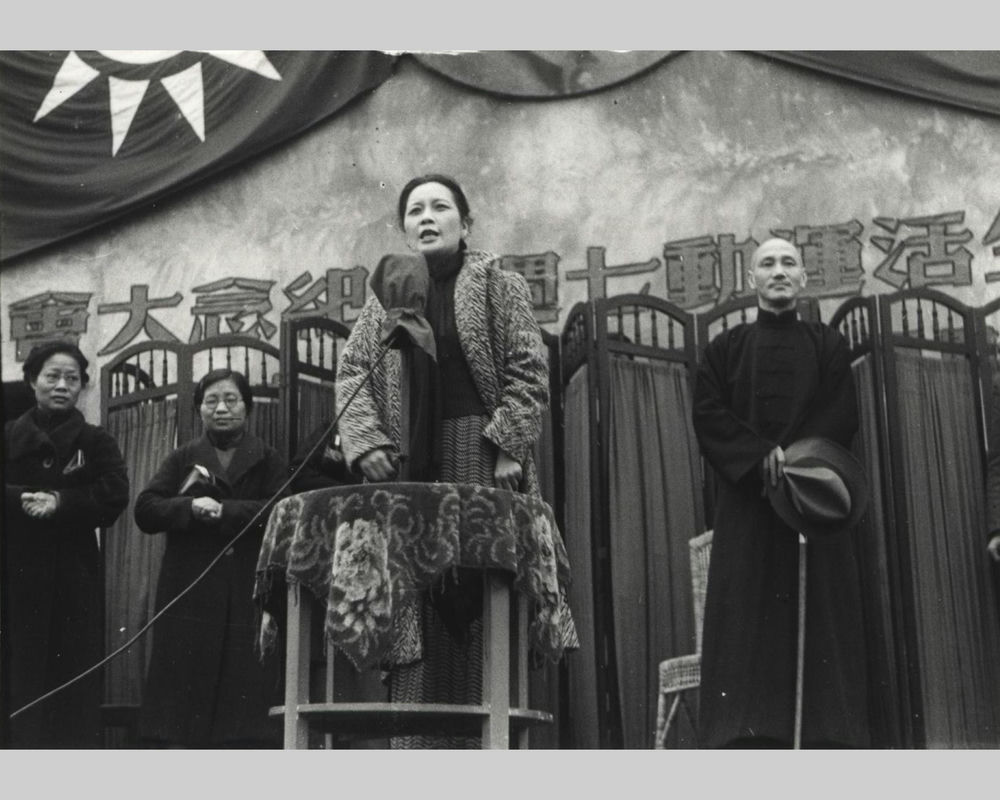
Madame Chiang Kai-shek giving a speech on 18 February 1942 at the Commemoration of the Seventh Anniversary of the New Life Movement. Photograph courtesy Mr. Roy Delbyck
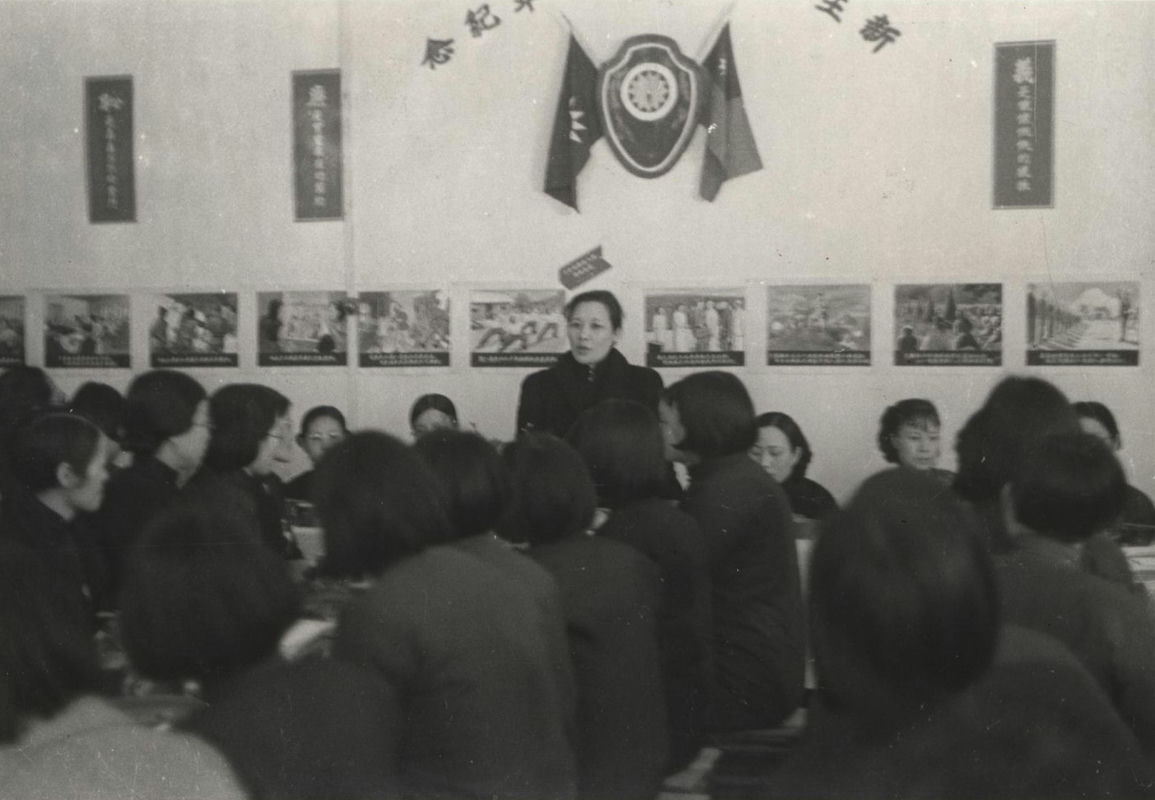
Madame Chiang Kai-shek speaking at one of the many New Life Movement events. Photograph courtesy Mr. Roy Delbyck

A silk banner commissioned by the Ladies Committee of the Association for the Advancement of New Life Movement in support of Madame Chiang Kai-shek as supervisor, dated April 1941. Photograph courtesy Mr. Roy Delbyck

Front cover of Outline of the New Life Movement by General Chiang Kai-shek, translated by Madame Chiang Kai-shek. Photograph courtesy Mr. Roy Delbyck

Inside pages of Outline of the New Life Movement by General Chiang Kai-shek, translated by Madame Chiang Kai-shek. Photograph courtesy Mr. Roy Delbyck
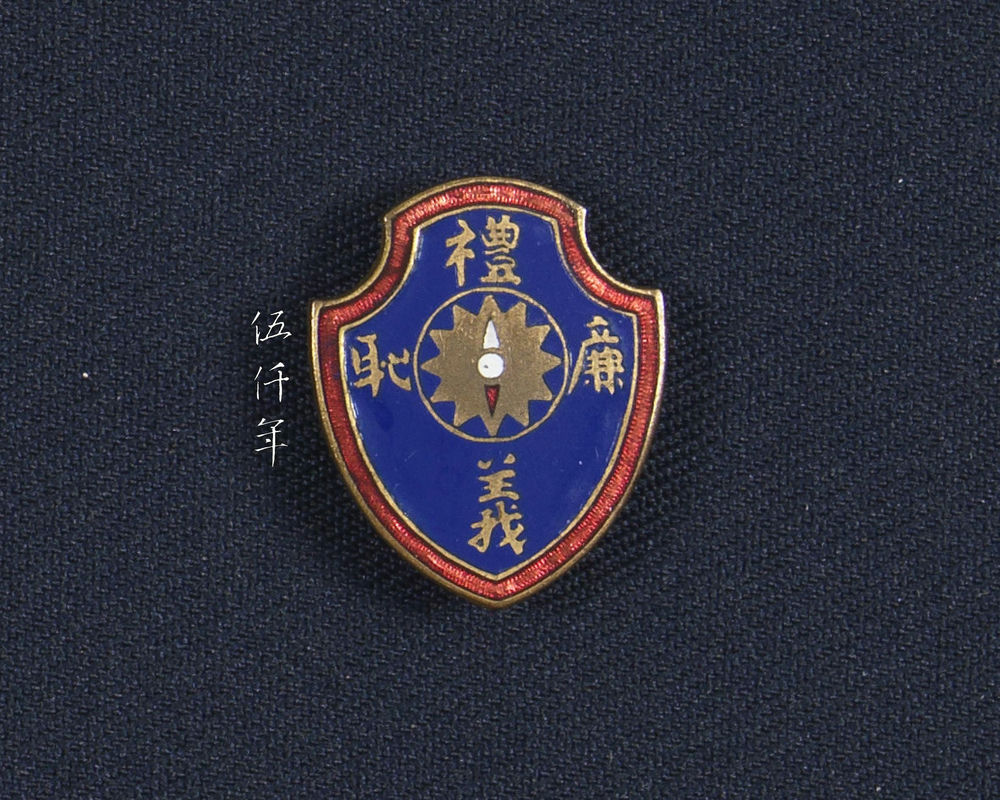
Metal badge pin of the New Life Movement, with the four Chinese characters of Propriety (禮), Righteousness (義), Integrity (廉) and Shamefulness (恥). Photograph courtesy Mr. Roy Delbyck
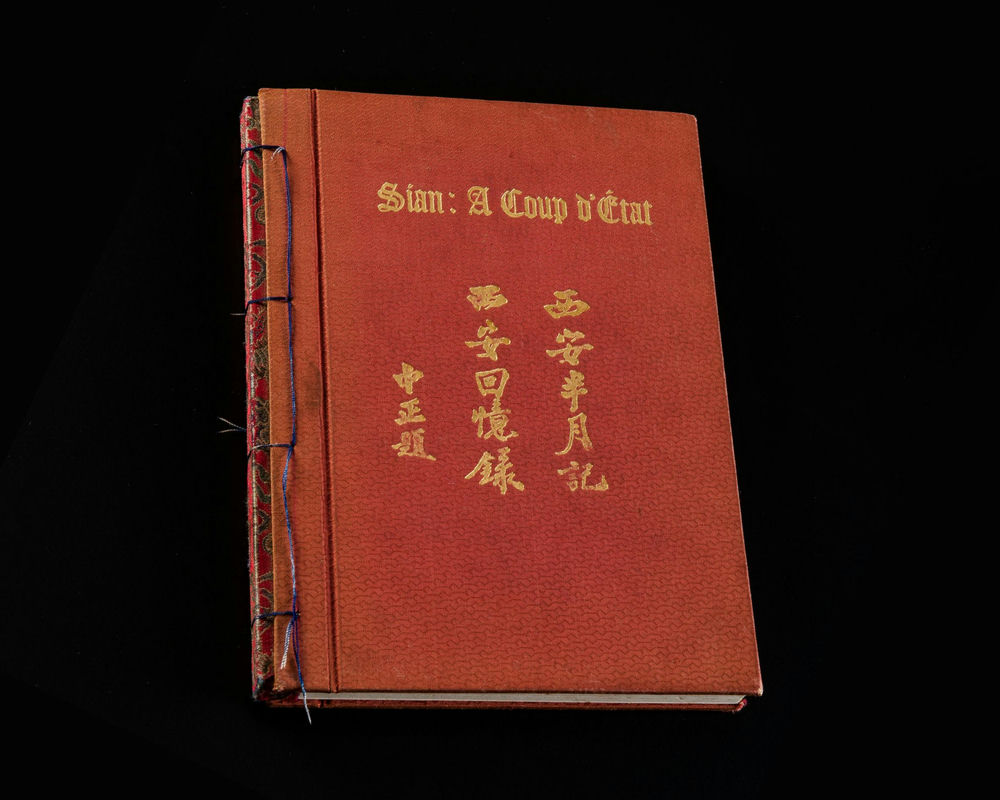
Front cover of Sian: A Coup d’Etat, by President Chiang Kai-shek and Madame Chiang Kai-shek, published in 1937.

Inside pages of Sian: A Coup d’Etat by President Chiang Kai-shek and Madame Chiang Kai-shek, published in 1937
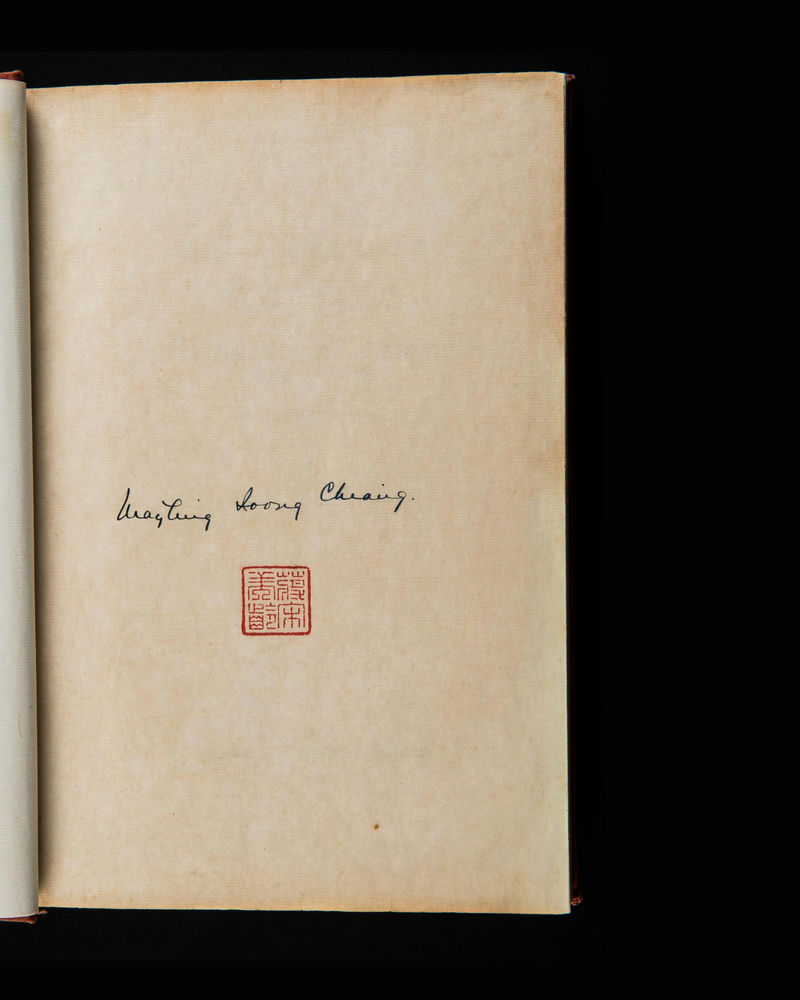
Inside page of Sian: A Coup d’Etat, signed by Madame Chiang Kai-shek
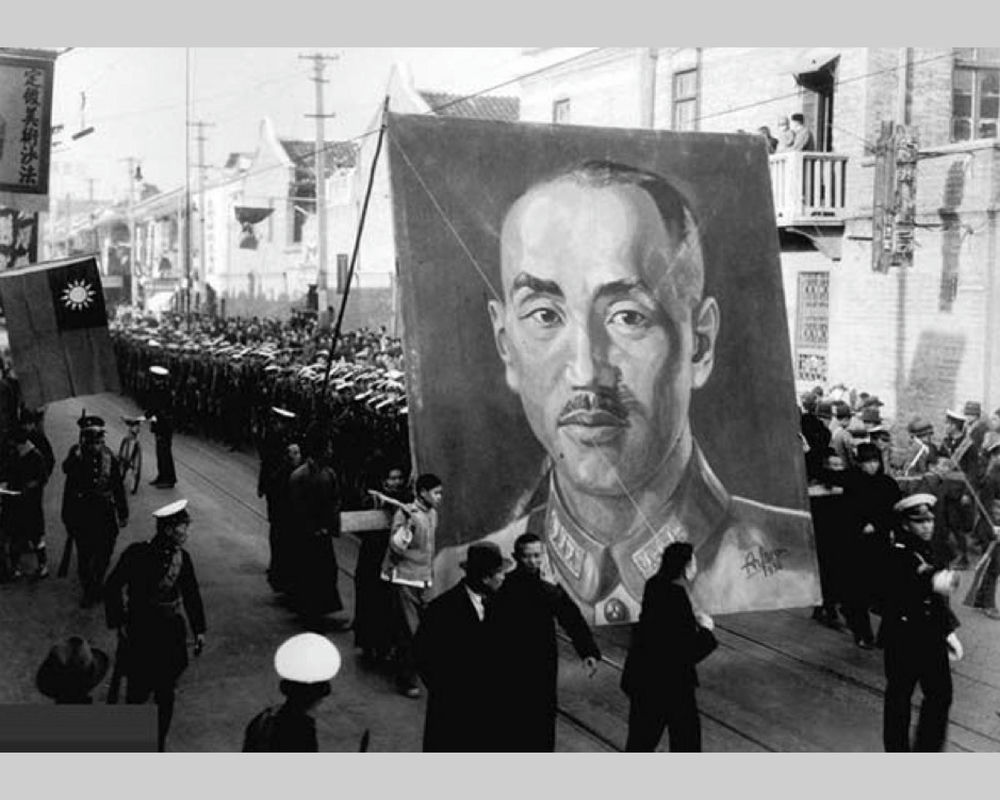
Chinese celebrating the release of President Chiang Kai-shek from the Sian mutiny at the end of December 1936

Front cover of Kuling Estate-Directory and General Information for Visitors with Chinese title, published in 1935. Photograph courtesy Mr. Roy Delbyck

Back cover of Kuling Estate-Directory and General Information for Visitors with English title, published in 1935. Photograph courtesy Mr. Roy Delbyck

Page 14 of Kuling Estate-Directory and General Information for Visitors, with Madame Chiang Kai-sheik’s entry. Photograph courtesy Mr. Roy Delbyck

Front page of The China Colleges Volume III Number 1 Spring 1937, reporting on Madame Chiang Kai-sheik’s international broadcast from Nanking on 20 February 1937. Photograph courtesy Mr. Roy Delbyck
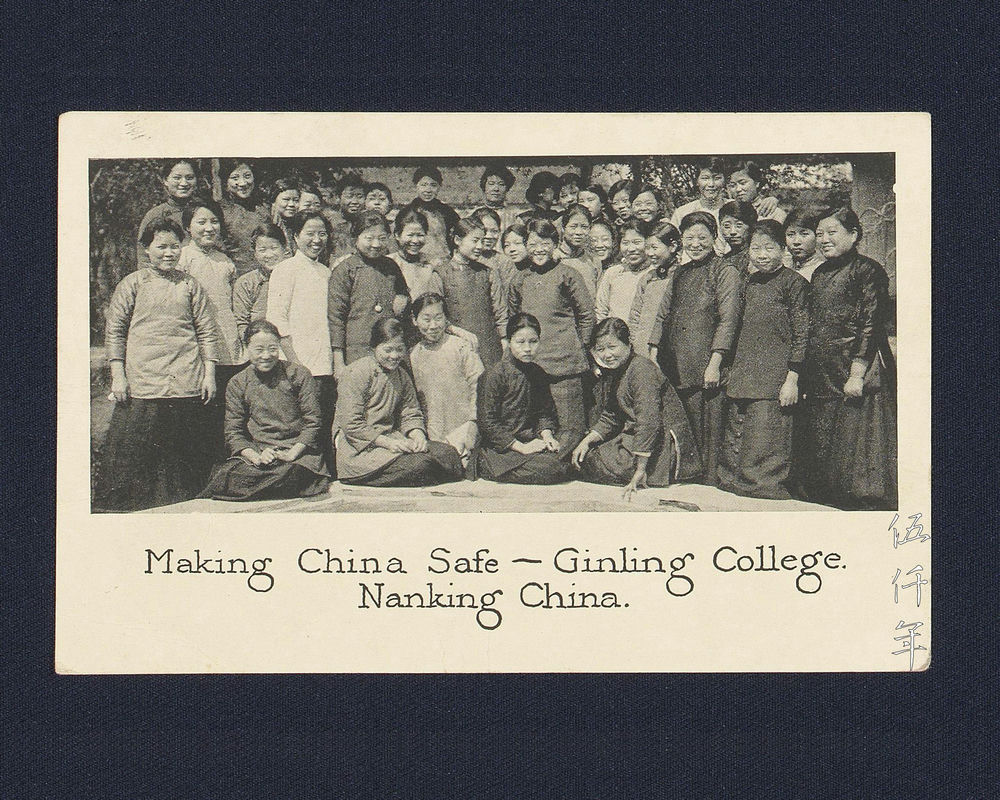
Postcard of students from Ginling College, Nanking, with the caption : Making China Safe, circa 1920s. Photograph courtesy Mr. Roy Delbyck
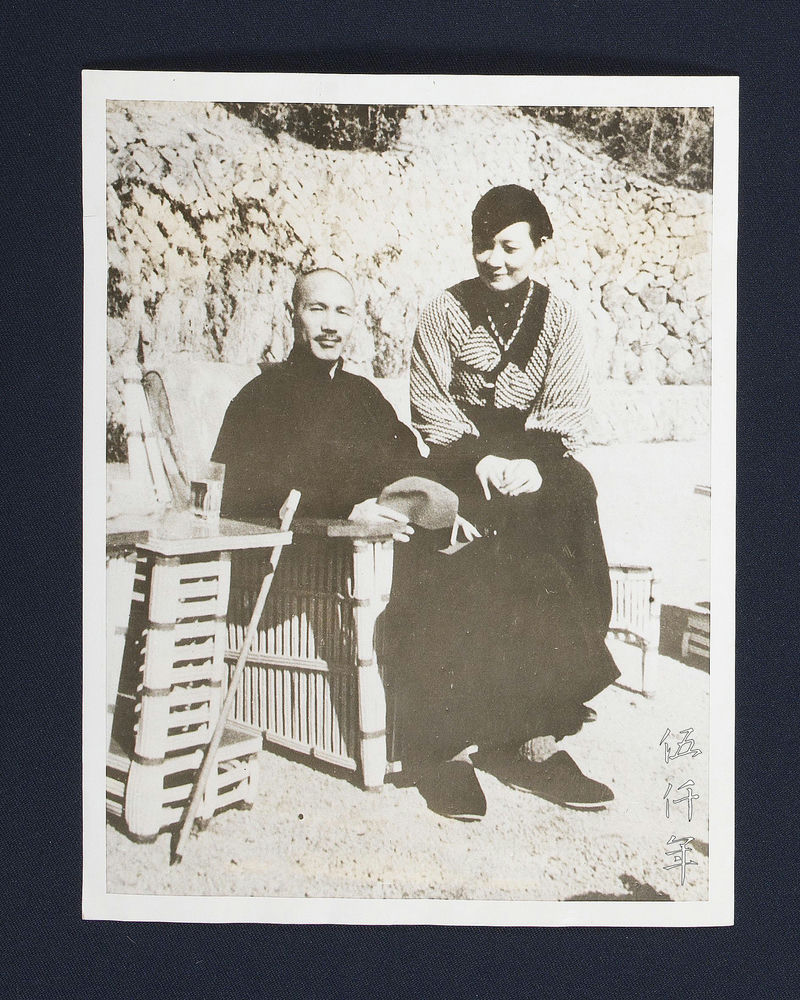
Photograph of President Chiang Kai-shek and Madame Chiang Kai-shek at Mo-kan-shan Mountain near Hang-chou of Chekiang Province, dated 15 March 1937. Photograph courtesy Mr. Roy Delbyck
New Air Force
New Air Force
After Kuomintang’s Northern Expedition victory in 1928, the 17th year of the Republic, the Central Military Academy in Nanking established its first aviation unit. In the following year, the aviation unit was moved to Chien-ch’iao (筧橋) in Hang-chou (杭州). In 1932, the 21st year of the Republic, the aviation unit was renamed the Central Aviation Academy (中央航空學校) and came under the jurisdiction of the Aviation Bureau of the Military and Political Affairs Department of the Nationalist Government (國民政府軍政部航空署). The Aviation Bureau was originally located in Nanking, but later moved to Hang-chou. To this day, the Air Force of the Republic of China still regards Chien-ch’iao in Hang-chou as the cradle of its establishment. In 1934, the 23rd year of the Republic, the Aviation Bureau was reorganized into the Aviation Commission, and relocated from Hang-chou to Nan-ch’ang. It was placed under the National Military Council (中央軍事委員會), which had been re-established in February 1932, the 21st year of the Republic with the late President Chiang Kai-shek as president. In January 1936, the 25th year of the Republic, both the National Military Council and the Aviation Commission relocated from Nan-ch’ang to Nanking. In February, Madame Chiang was appointed secretary-general of the Aviation Commission and was tasked with planning and expanding the Chinese Air Force. President Chiang relied on her deeply in this matter. Madame Chiang worked studiously, investigating and researching the development of air force, establishing aviation schools, selecting pilots, expanding airfields and maintenance facilities, procuring military aircraft, and successively organizing international air squadrons and American Volunteer Group to resist Japanese invasion. She later became the Honorary Commander of the American Volunteer Group. With regard to the establishment of the Chinese Air Force, she made outstanding contributions, earning acclaim as the “Mother of the Chinese Air Force”. Madame Chiang also regarded this as her lifelong honour.
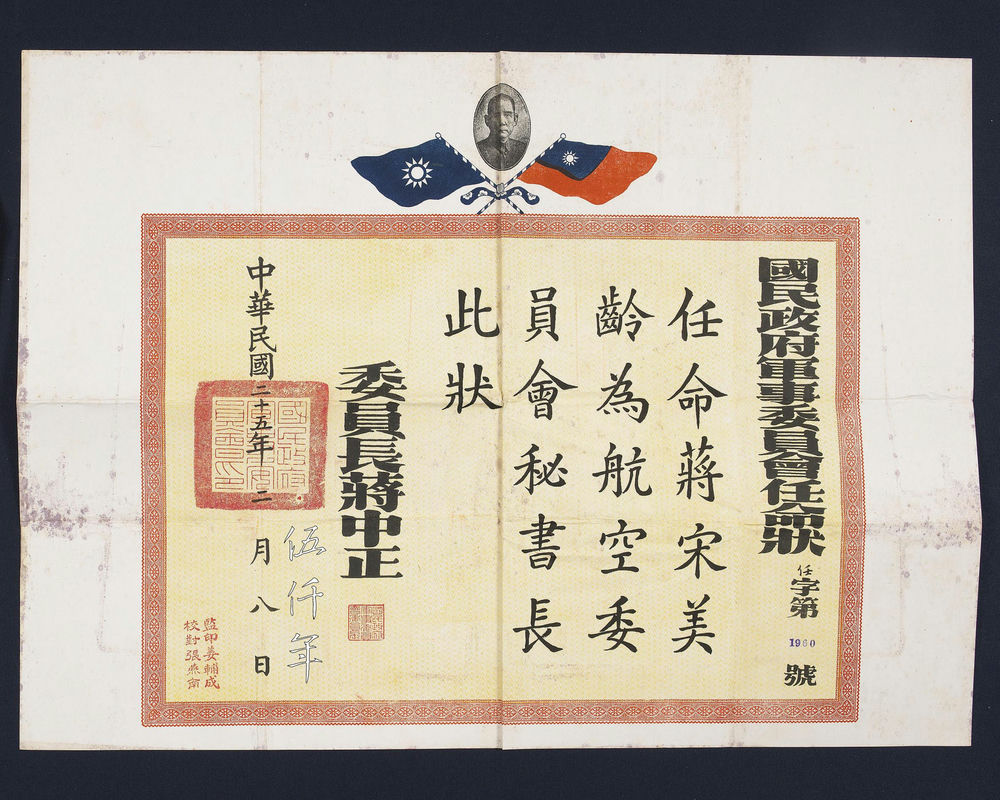
Certificate of appointment as the Secretary-General of the Chinese Aviation Commission, presented by the National Military Council of the National Government to Madame Chiang Kai-shek, issued on 8 February 1936. Photograph courtesy Private Collection
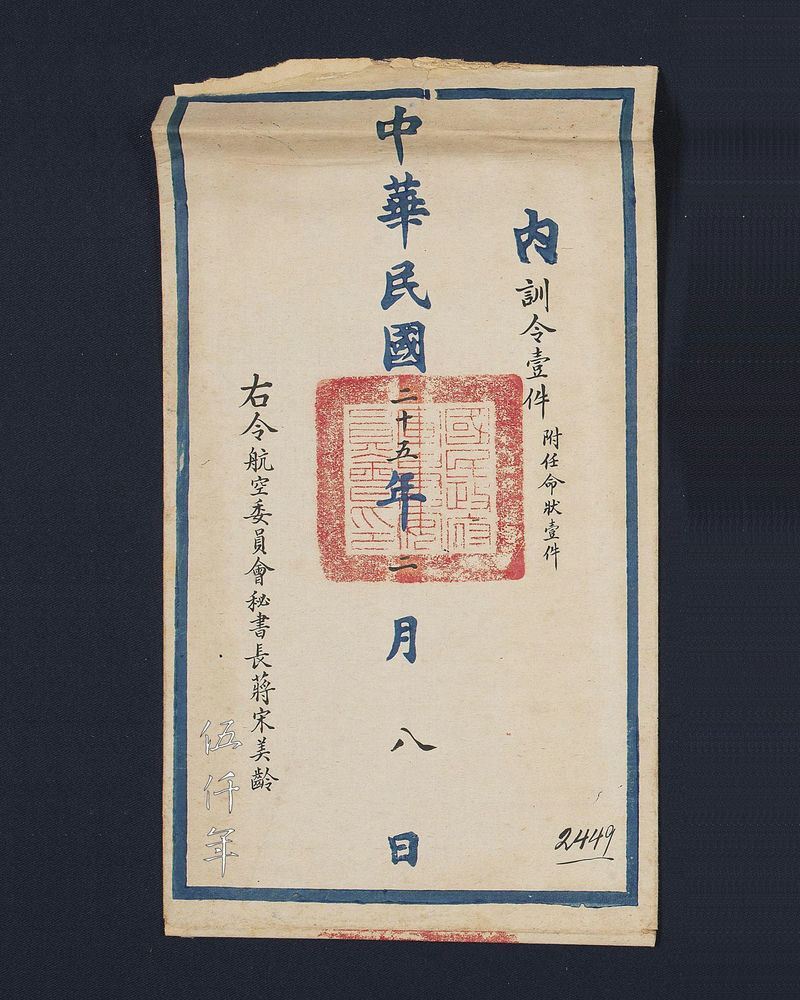
Front of envelope for the certificate of appointment as the Secretary-General of the Chinese Aviation Commission, presented by the National Military Council of the National Government to Madame Chiang Kai-shek, dated 8 February 1936. Photograph courtesy Private Collection
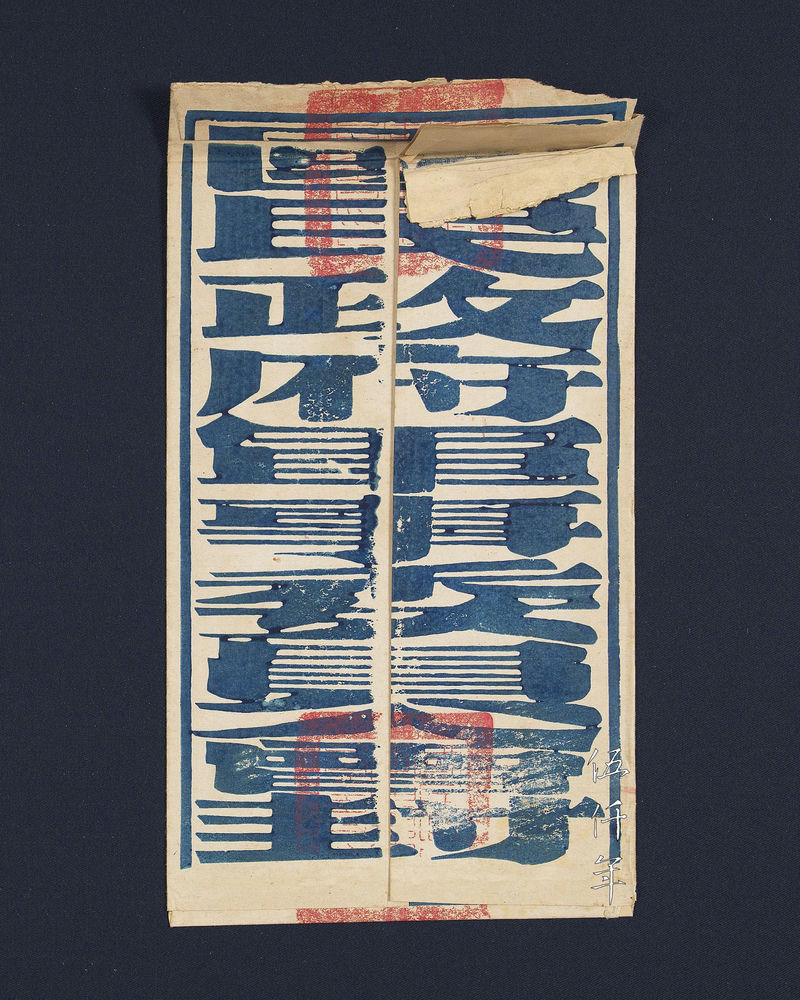
Back of envelope for the certificate of appointment as the Secretary-General of the Chinese Aviation Commission, presented by the National Military Council of the National Government to Madame Chiang Kai-shek. Photograph courtesy Private Collection

Certificate of appointment as the Commission Member of the Chinese Aviation Commission, presented by the National Military Council of the National Government to Madame Chiang Kai-shek, issued in March 1938. Photograph courtesy Private Collection

Front of envelope for the certificate of appointment as the Commission Member of the Chinese Aviation Commission, presented by the National Military Council of the National Government to Madame Chiang Kai-shek, dated April 1938. Photograph courtesy Private Collection
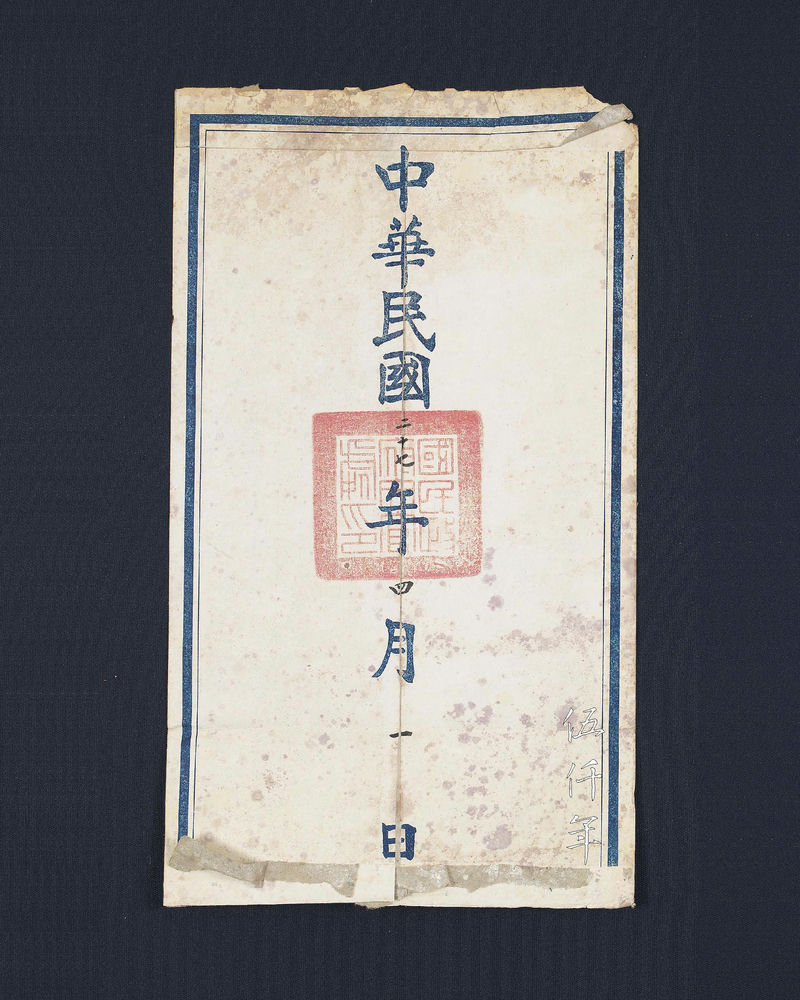
Back of Envelope for the certificate of appointment as the Commission Member of the Chinese Aviation Commission, presented by the National Military Council of the National Government to Madame Chiang Kai-shek. Photograph courtesy Private Collection
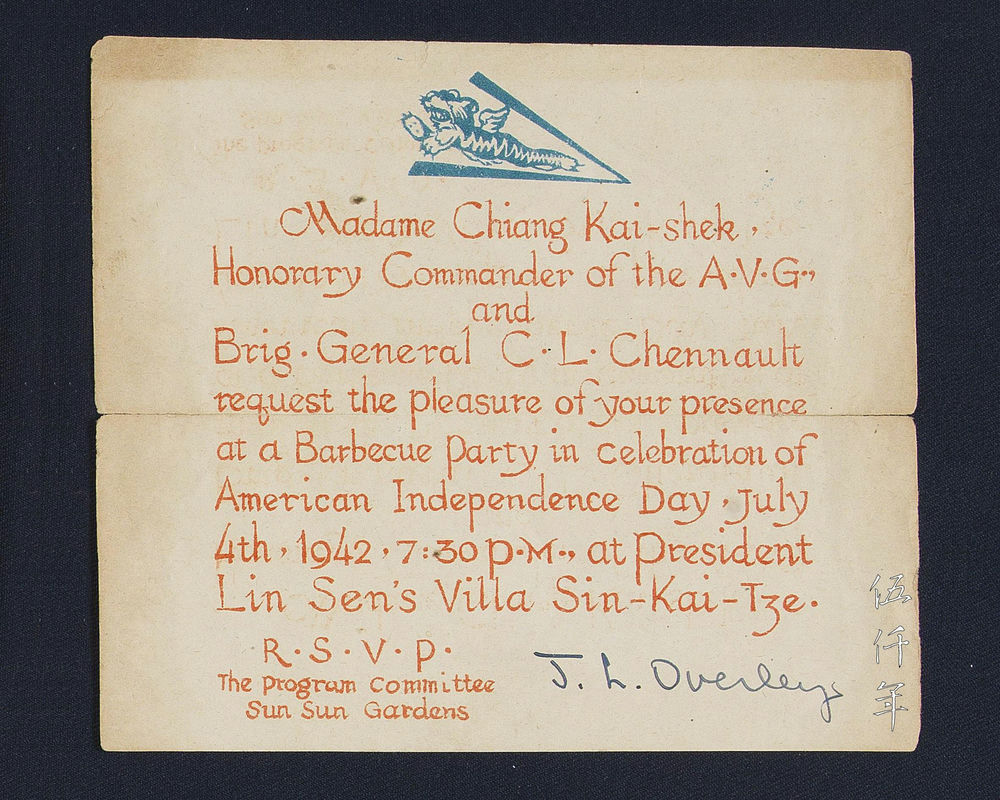
Invitation card from Madame Chiang Kai-shek, Honorary Commander of the American Volunteer Group, and Brigadier-General Claire Chennault to members of the American Volunteer Group, to attend a barbecue party on 4 July 1942 at President Lin Sen’s villa. Photograph courtesy Mr. Roy Delbyck
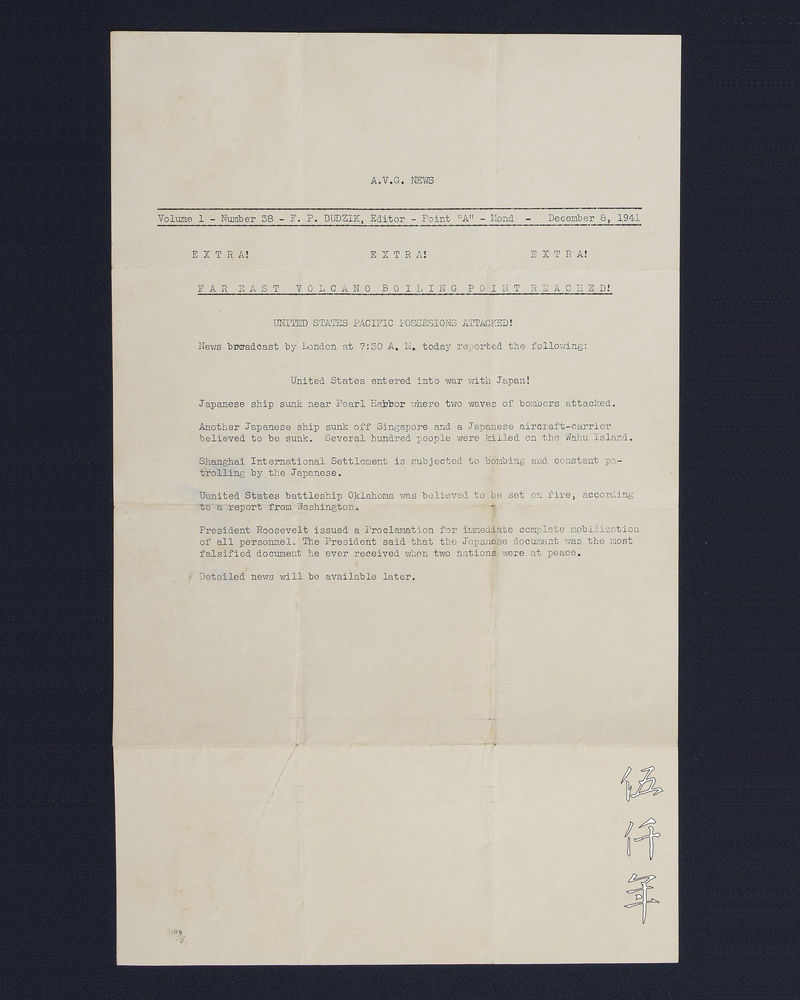
A.V.G. News Volume 1 Number 38, dated 8 December 1941, reporting that the United States had entered into war with Japan. Photograph courtesy Mr. Roy Delbyck
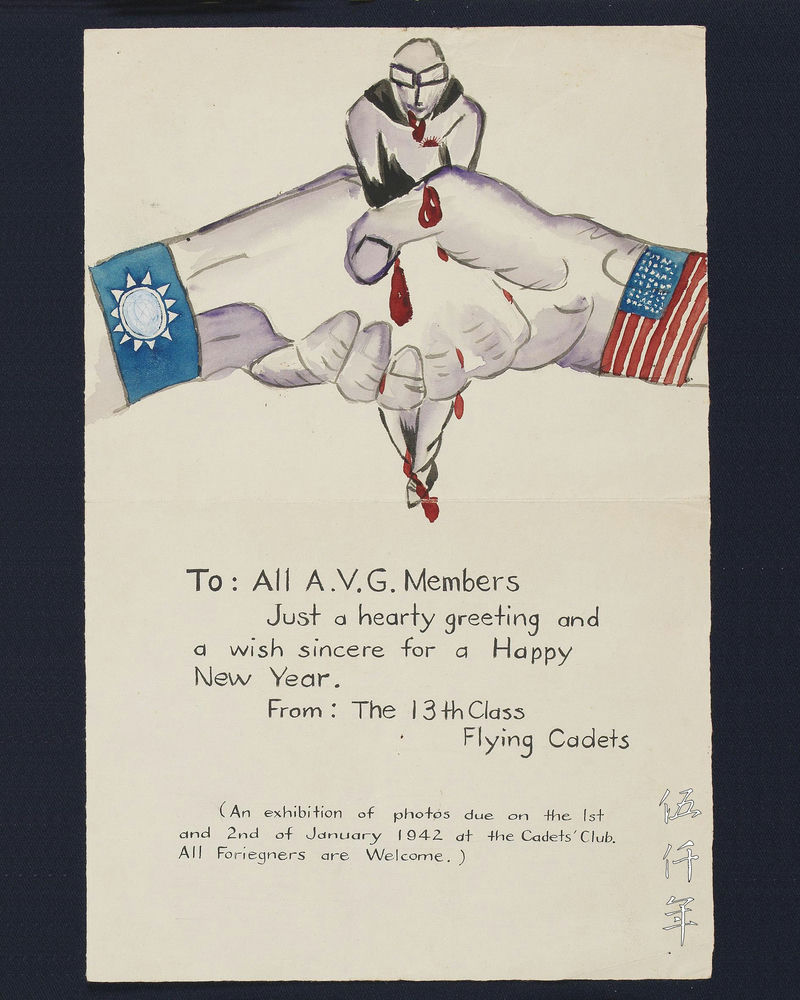
Hand-drawn poster for a photograph exhibition on 1 and 2 January 1942 at the Cadets’ Club of the American Volunteer Group. Photograph courtesy Mr. Roy Delbyck
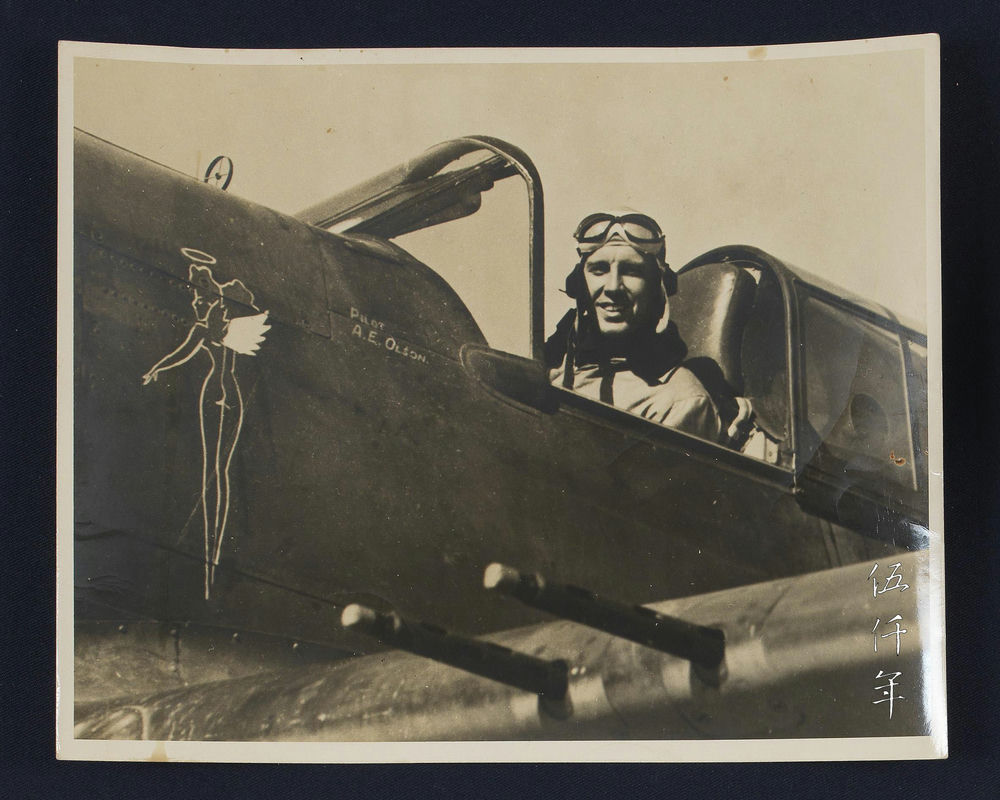
A pilot of the American Volunteer Group in cockpit. Photograph courtesy Mr. Roy Delbyck
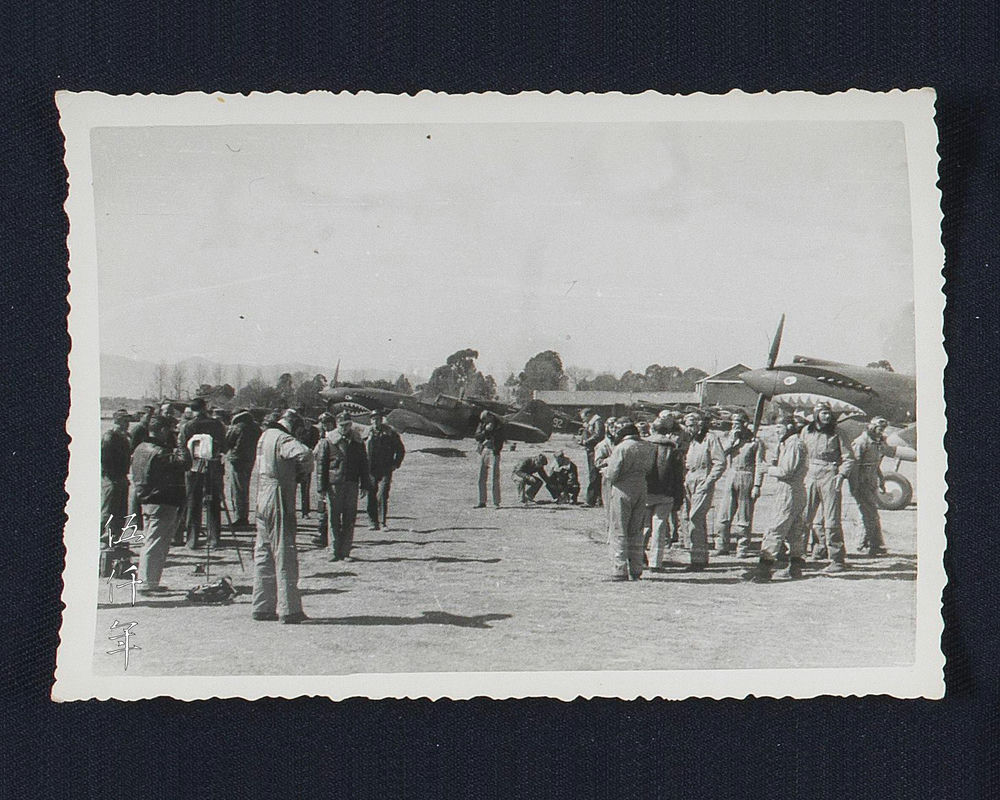
Members of the American Volunteer Group and P-40 Tomahawk planes on runway. Photograph courtesy Mr. Roy Delbyck

A P-40 Tomahawk on a transport vehicle. Photograph courtesy Mr. Roy Delbyck

A P-40 Tomahawk with maintenance crew. Photograph courtesy Mr. Roy Delbyck
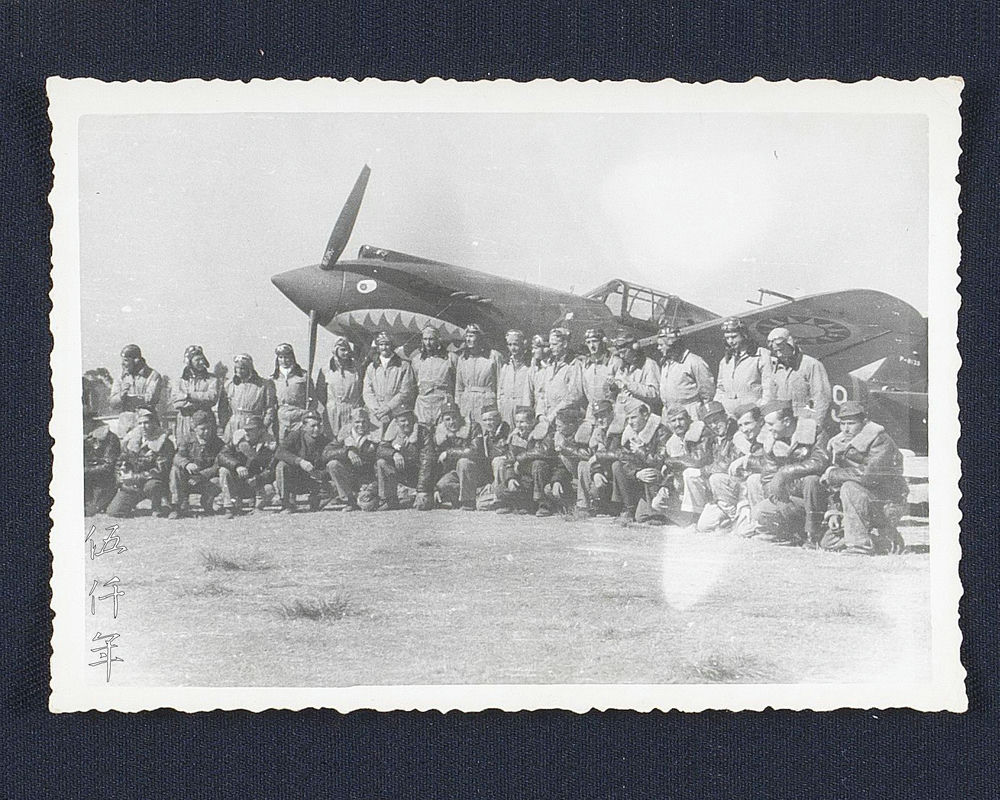
Members of the American Volunteer Group in front of a P-40 Tomahawk. Photograph courtesy Mr. Roy Delbyck
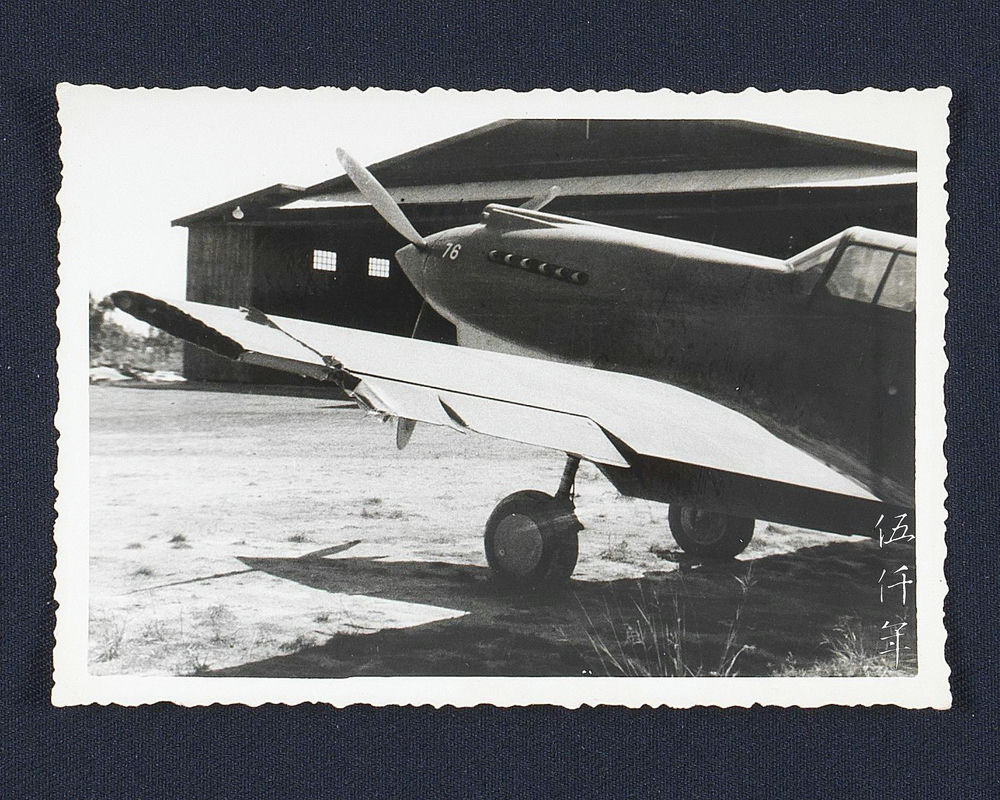
A P-40 Tomahawk in front of an airplane hangar. Photograph courtesy Mr. Roy Delbyck
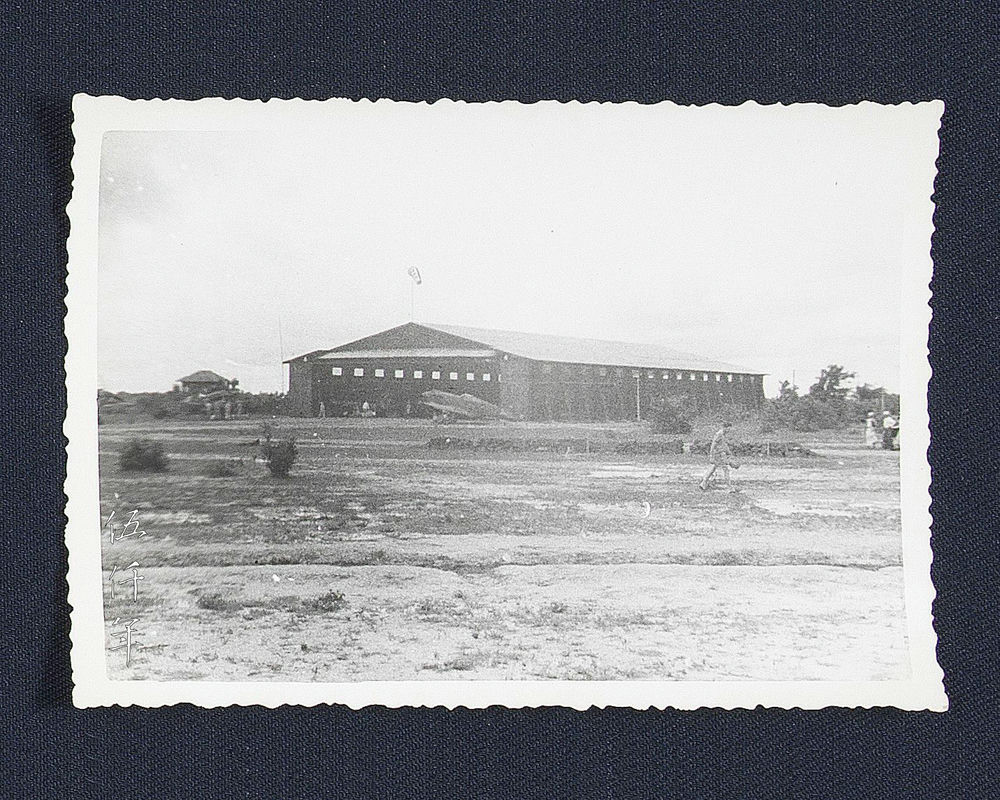
View of an aircraft hangar. Photograph courtesy Mr. Roy Delbyck
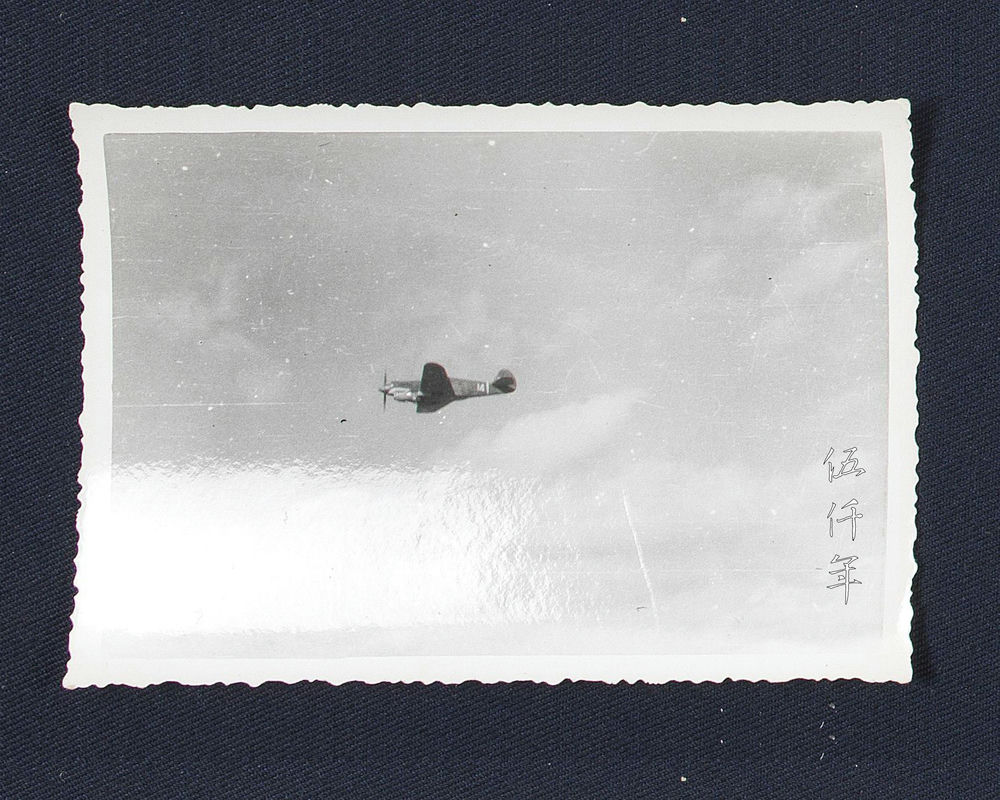
A P-40 Tomahawk in flight. Photograph courtesy Mr. Roy Delbyck
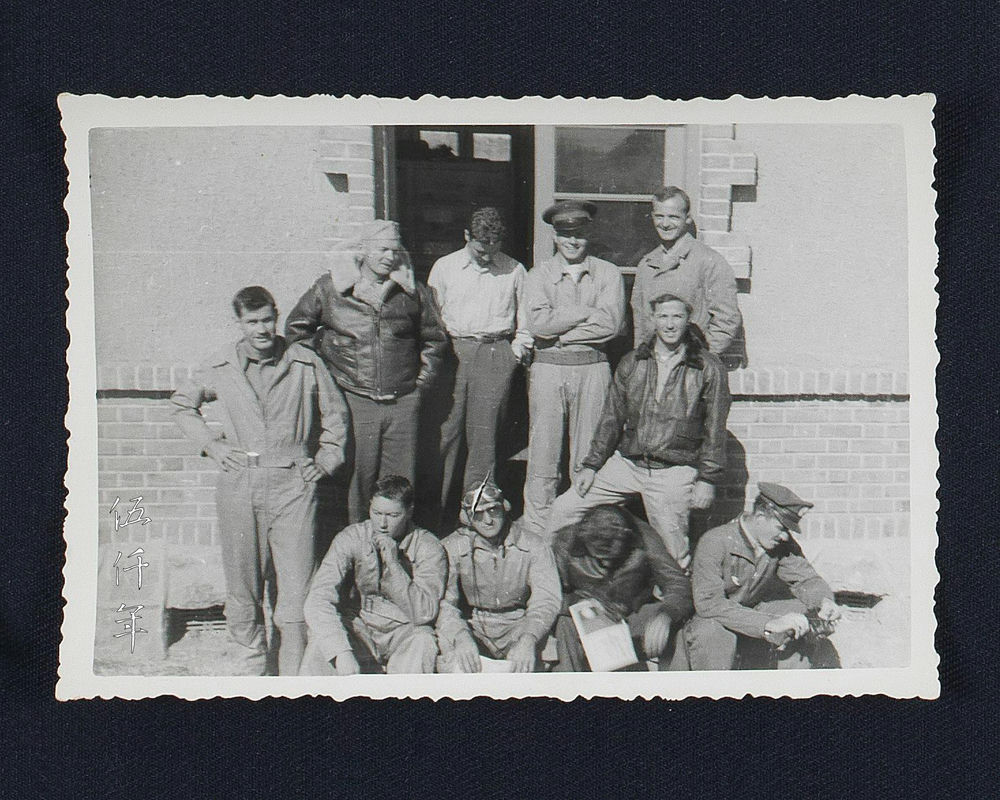
Members of the American Volunteer Group outside a building at military base. Photograph courtesy Mr. Roy Delbyck

A pilot of the American Volunteer Group in cockpit. Photograph courtesy Mr. Roy Delbyck
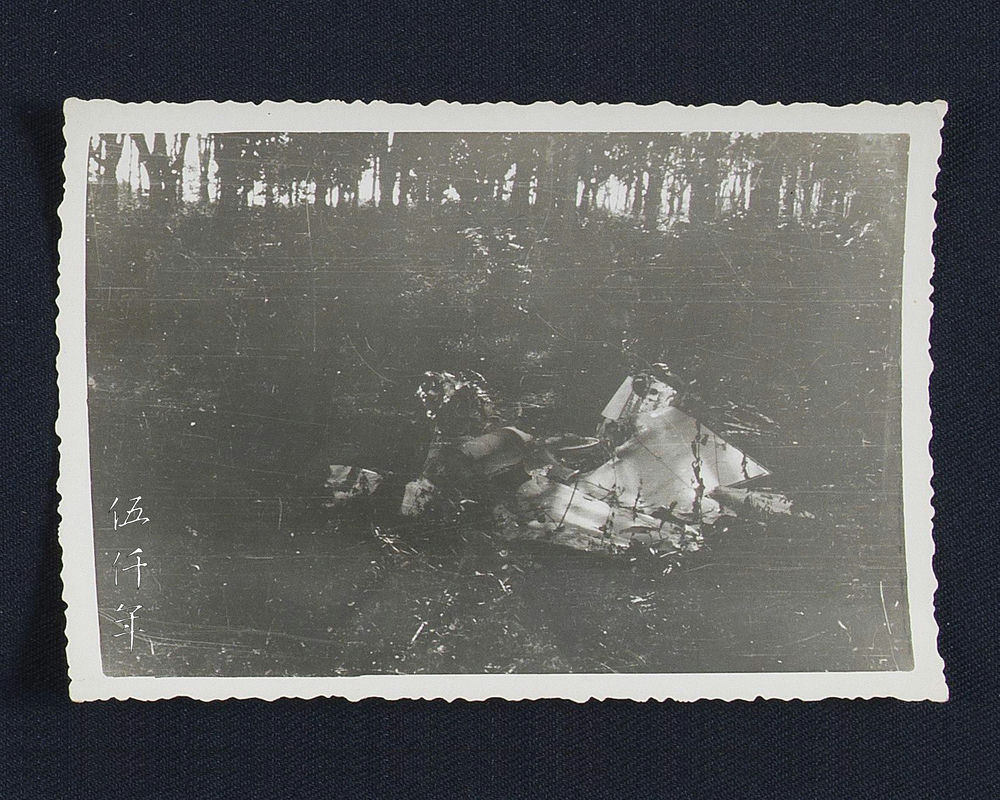
A crashed P-40 Tomahawk. Photograph courtesy Mr. Roy Delbyck
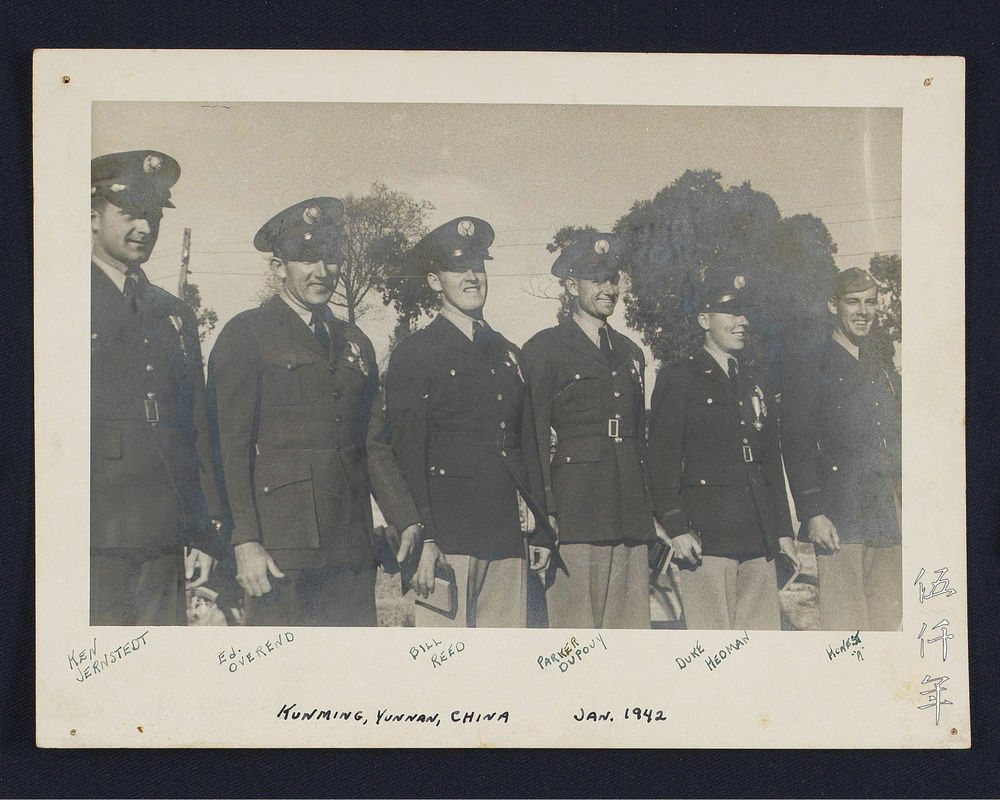
Group portrait of members of the American Volunteer Group taken in Kunming, Yunnan Province, in January 1942. Photograph courtesy Mr. Roy Delbyck
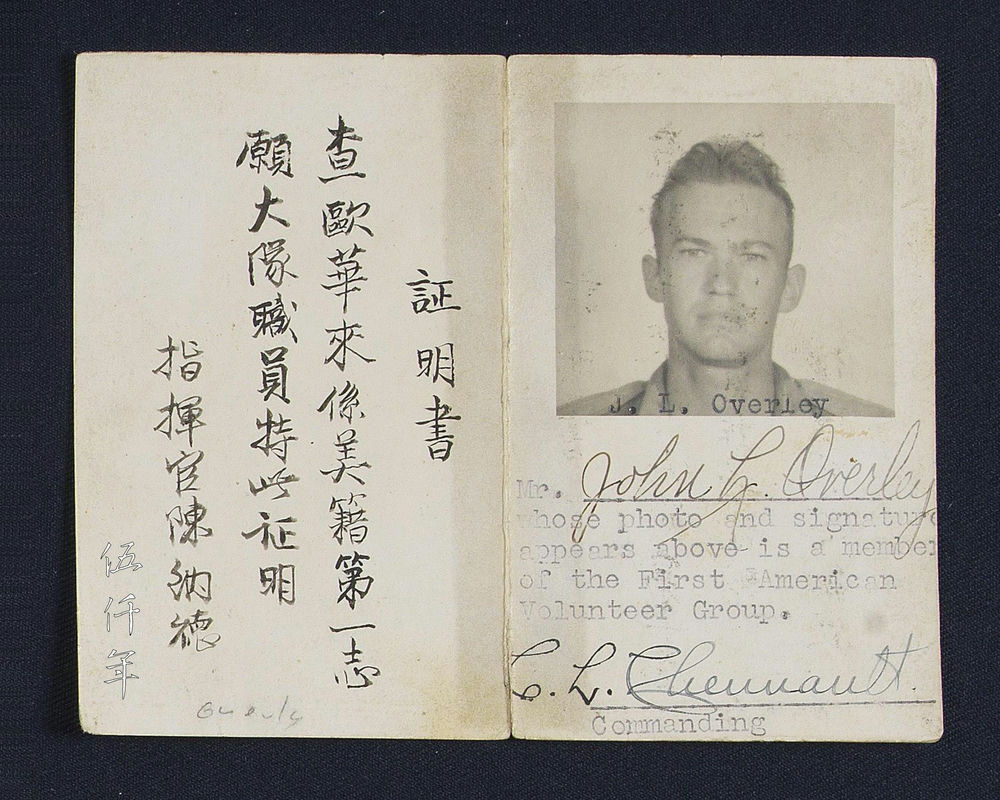
Identity card of John Overley, member of the American Volunteer Group, signed by Claire Chennault. Photograph courtesy Mr. Roy Delbyck

First page of List of the Duties of All Staff and Pilot Personnel of the American Volunteer Group, dated 9 January 1942. Photograph courtesy Mr. Roy Delbyck
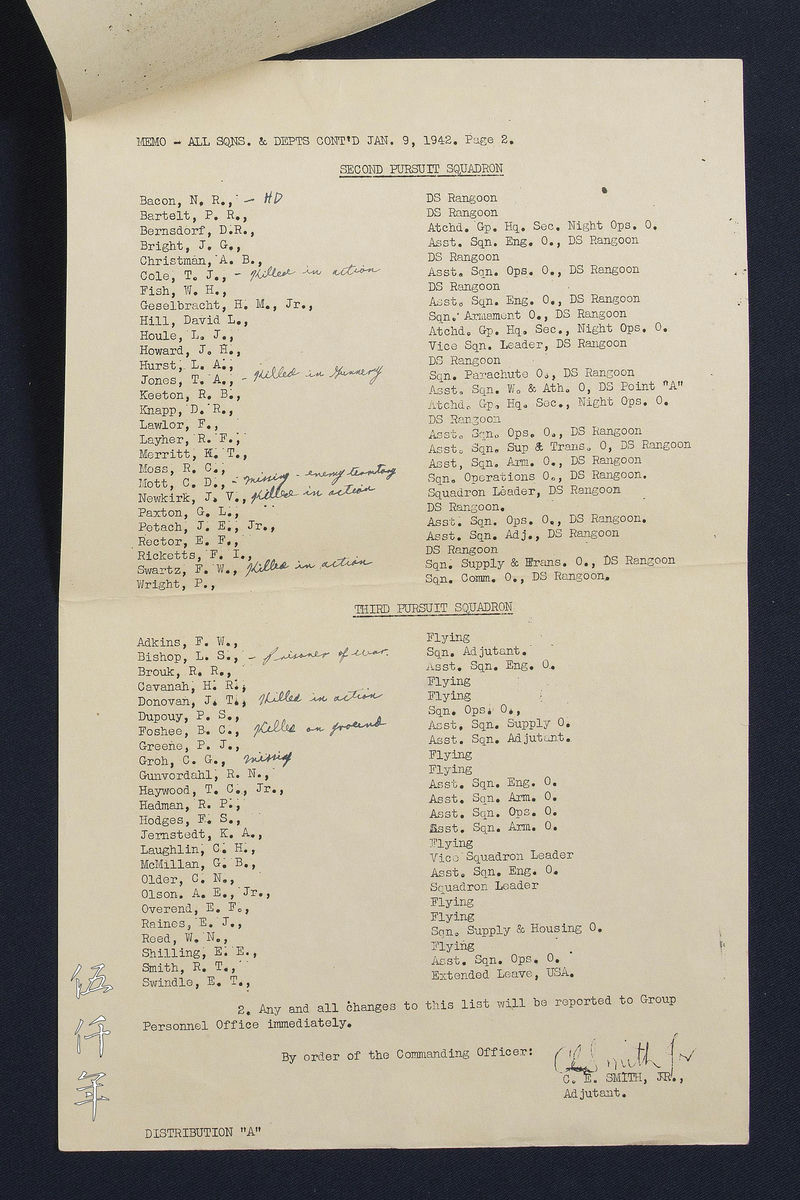
Second page of List of the Duties of All Staff and Pilot Personnel of the American Volunteer Group, dated 9 January 1942. Photograph courtesy Mr. Roy Delbyck

First page of Status of A. V. G. Aircraft prepared by the Headquarters of American Volunteer Group in Kunming, dated 20 June 1942. Photograph courtesy Mr. Roy Delbyck

Second page of Status of A. V. G. Aircraft prepared by the Headquarters of American Volunteer Group in Kunming, dated 20 June 1942. Photograph courtesy Mr. Roy Delbyck

Front cover of Class of 44-J Thunderbird Field No. 1 Yearbook. Photograph courtesy Mr. Roy Delbyck
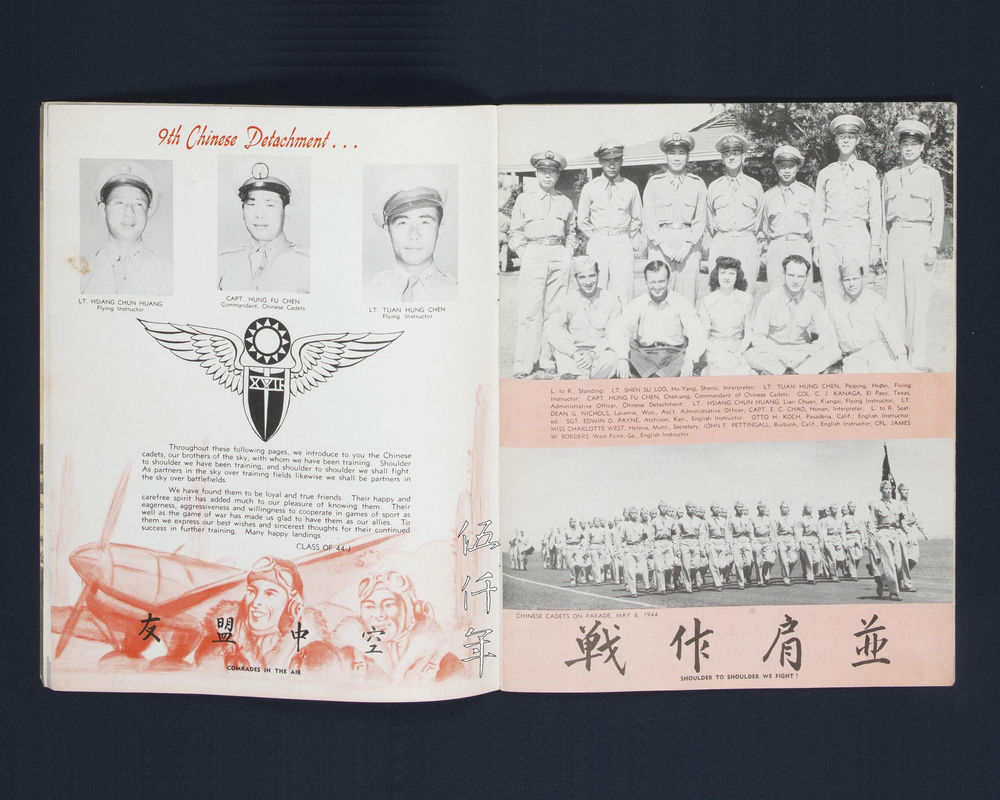
Inside pages of Class of 44-J Thunderbird Field No. 1 Yearbook, documenting names and photographs of Chinese pilots being trained in America. Chinese slogans on the pages are: Comrades in the Air and Shoulder to Shoulder We Fight. Photograph courtesy Mr. Roy Delbyck
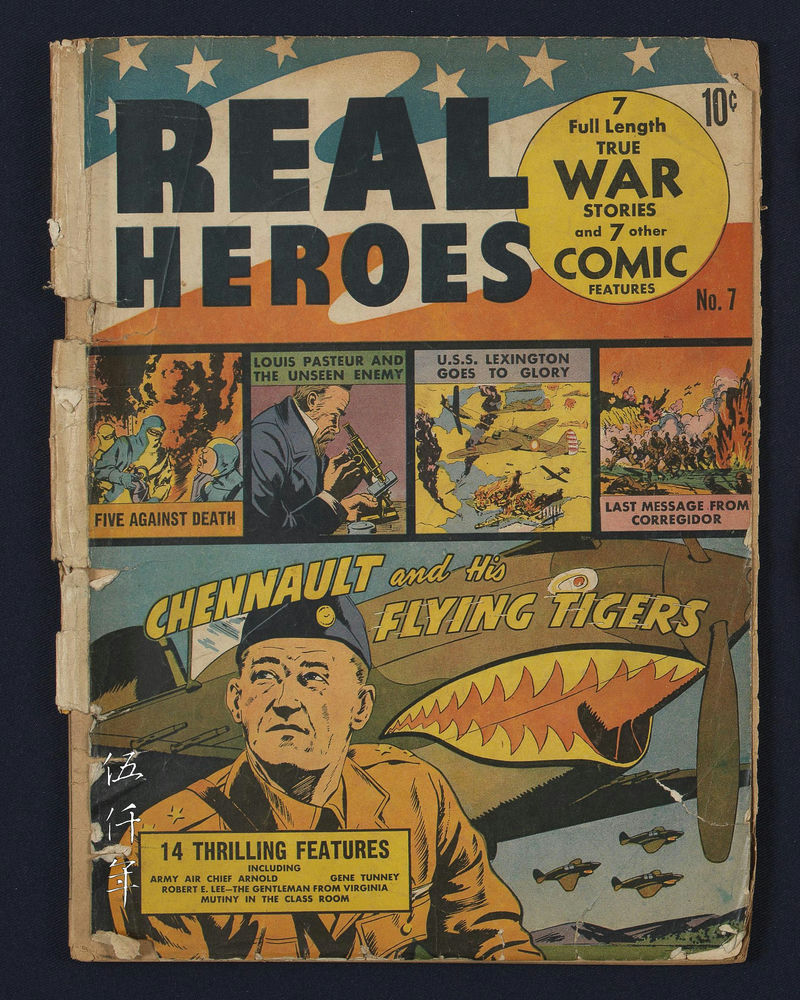
Real Heroes comic book with special feature of Chennault and His Flying Tigers. Photograph courtesy Mr. Roy Delbyck
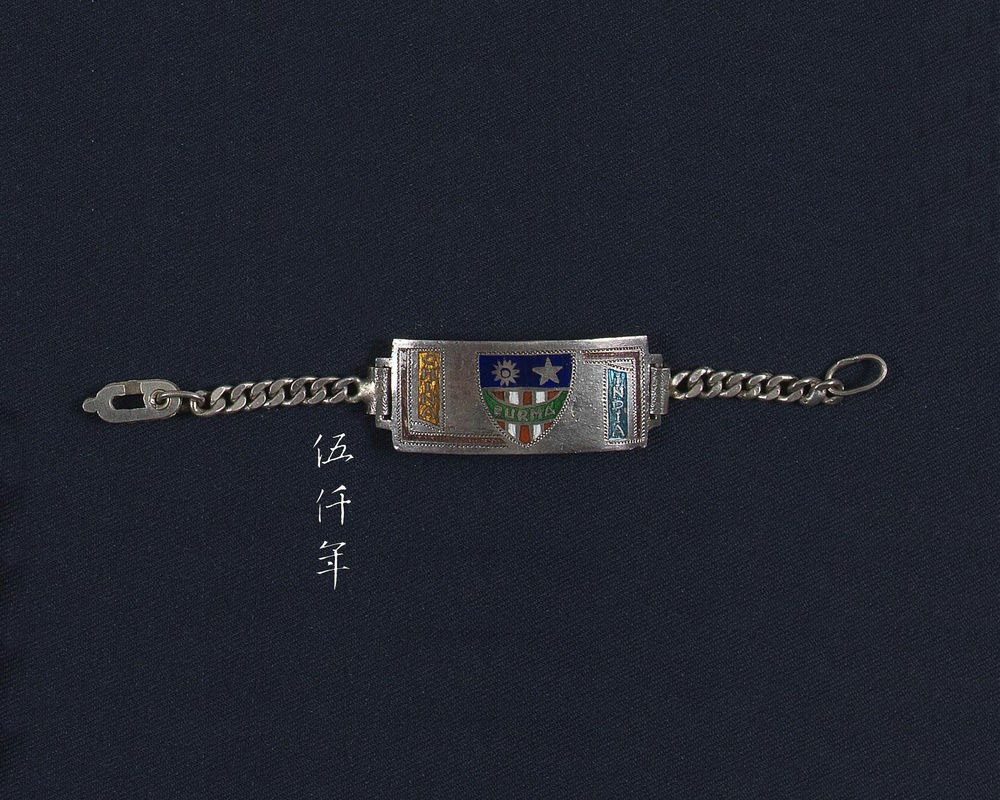
Silver bracelet with enamel insignia from the China Burma India Theatre. Photograph courtesy Mr. Roy Delbyck
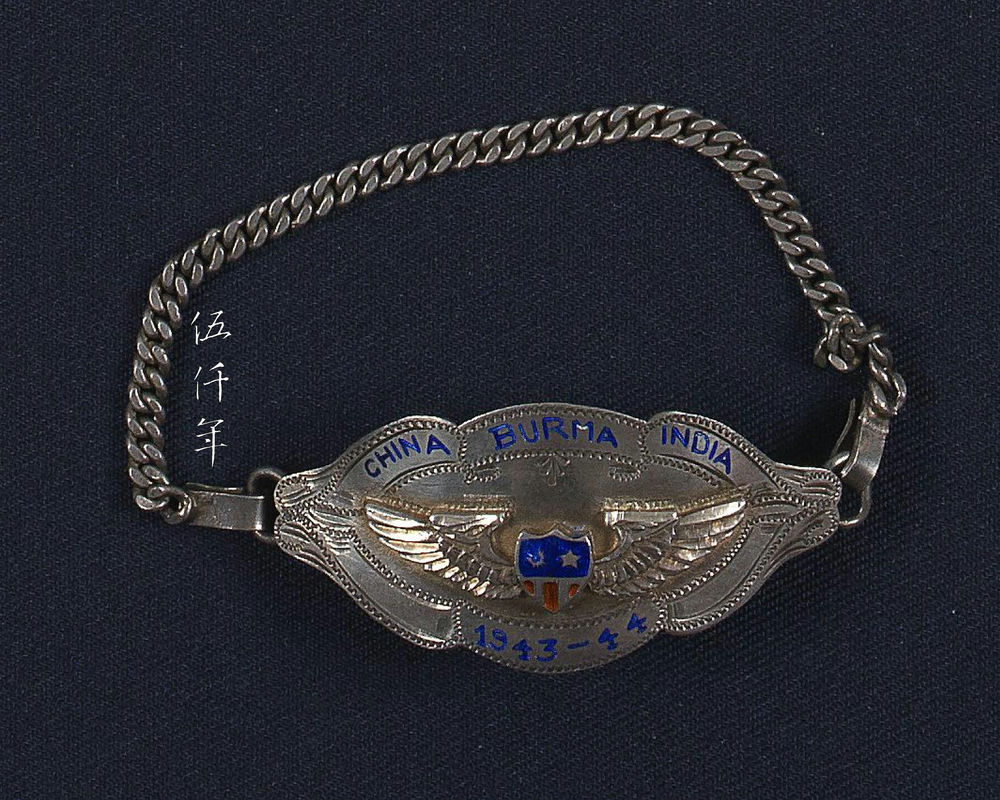
Silver bracelet with enamel insignia from the China Burma India Theatre. Photograph courtesy Mr. Roy Delbyck
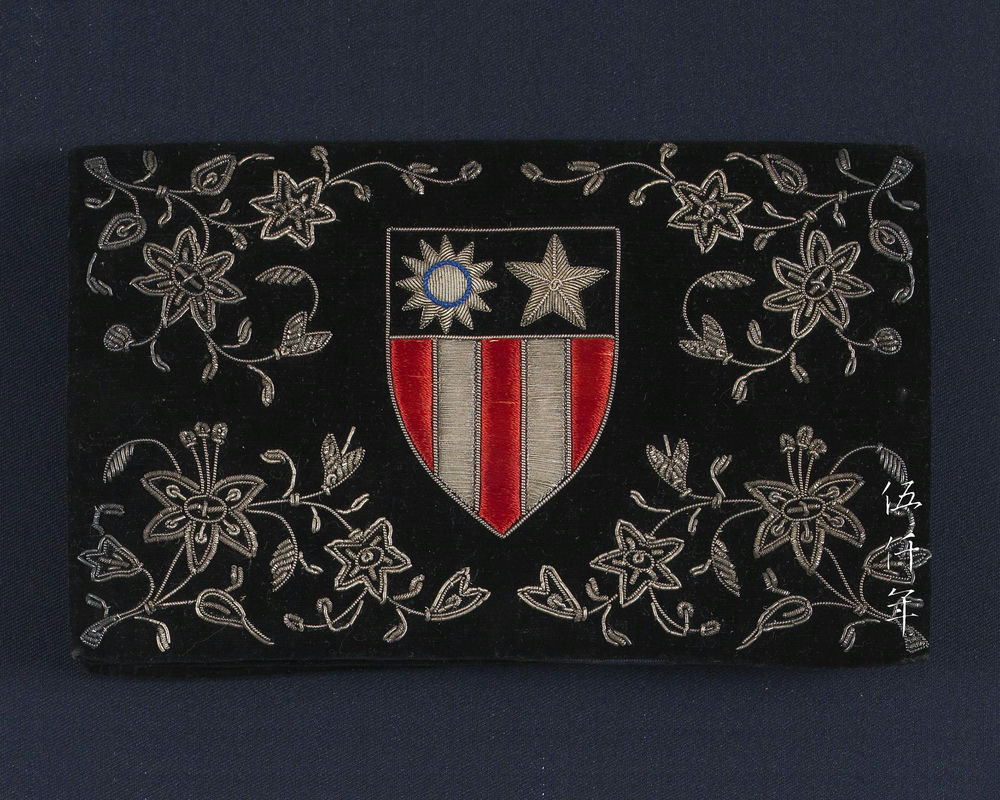
Handbag with embroidered insignia from the China Burma India Theatre. Photograph courtesy Mr. Roy Delbyck

Blood chit with the Chinese and American flags. Photograph courtesy Mr. Roy Delbyck
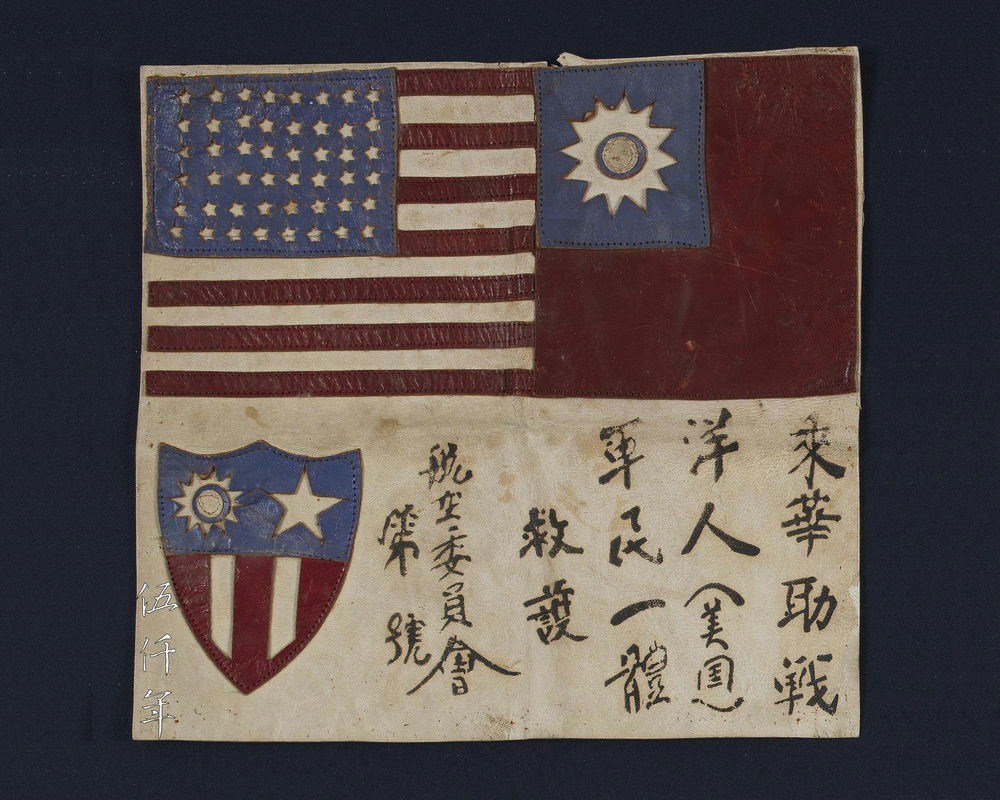
Blood chit with the Chinese and American flags, as well as the China Burma India Theatre insignia. Photograph courtesy Mr. Roy Delbyck
Care for War Orphans
Care for War Orphans
On 7 July 1937, the 26th year of the Republic, the Marco Polo Bridge Incident erupted, marking the outbreak of the War of Resistance Against Japanese Aggression. On 1 August the same year, to rally and utilize the strength of women in the resistance effort, the National Chinese Women’s Association for War Relief (中國婦女慰勞自衛抗戰將士總會) was established in Nanking, with Madame Chiang as chairwoman. In the following year, on 10 March, the Wartime Nursery for Children (戰時兒童保育會) was established in Han-k’ou to help war orphans. It was under the jurisdiction of the National Chinese Women’s Association for War Relief, with Madame Chiang as the director. The Wartime Nursery for Children established twelve branches successively within the country, two overseas branches, forty five orphanages, and including those orphanages that were merged, a total of sixty one orphanages. During the war these orphanages collectively rescued around 30,000 children.

Cover picture card from a bubble gum package that contains 240 picture cards titled Horrors of War, with a number of picture cards on the war in China. Photograph courtesy Mr. Roy Delbyck
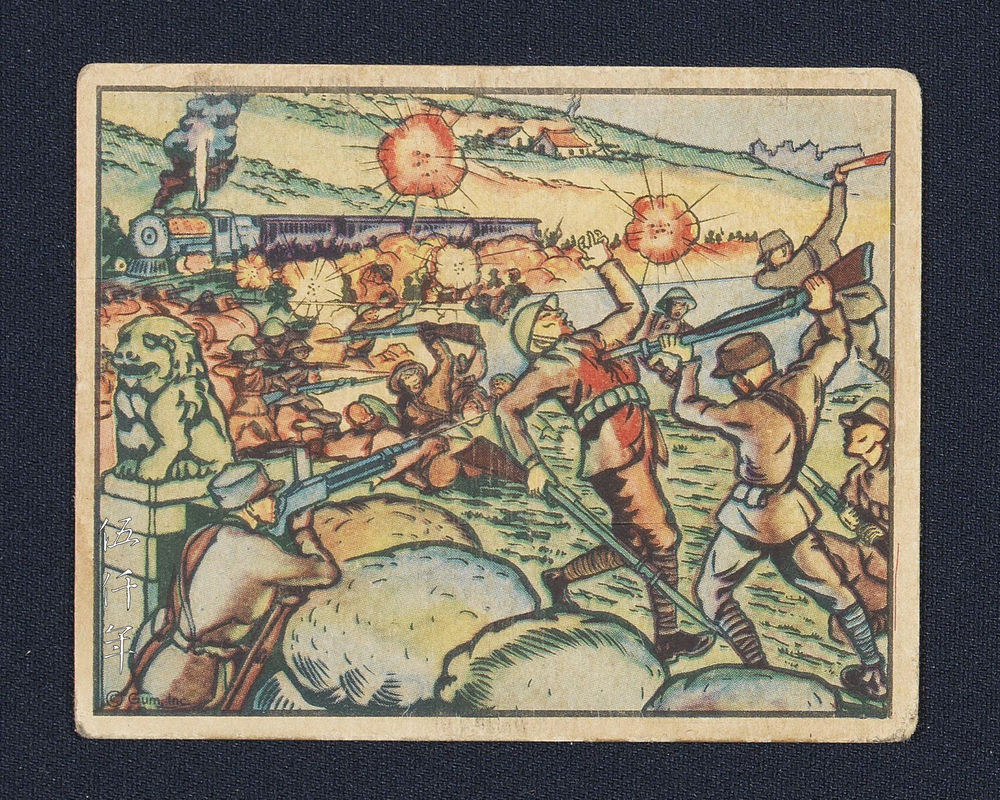
Front of Picture Card No. 1, illustrating the Marco Polo Bridge Incident with Chinese forces battling Japanese forces on 10 July 1937. Photograph courtesy Mr. Roy Delbyck

Back of Picture Card No. 1, with text describing the Marco Polo Bridge Incident on 10 July 1937. Photograph courtesy Mr. Roy Delbyck
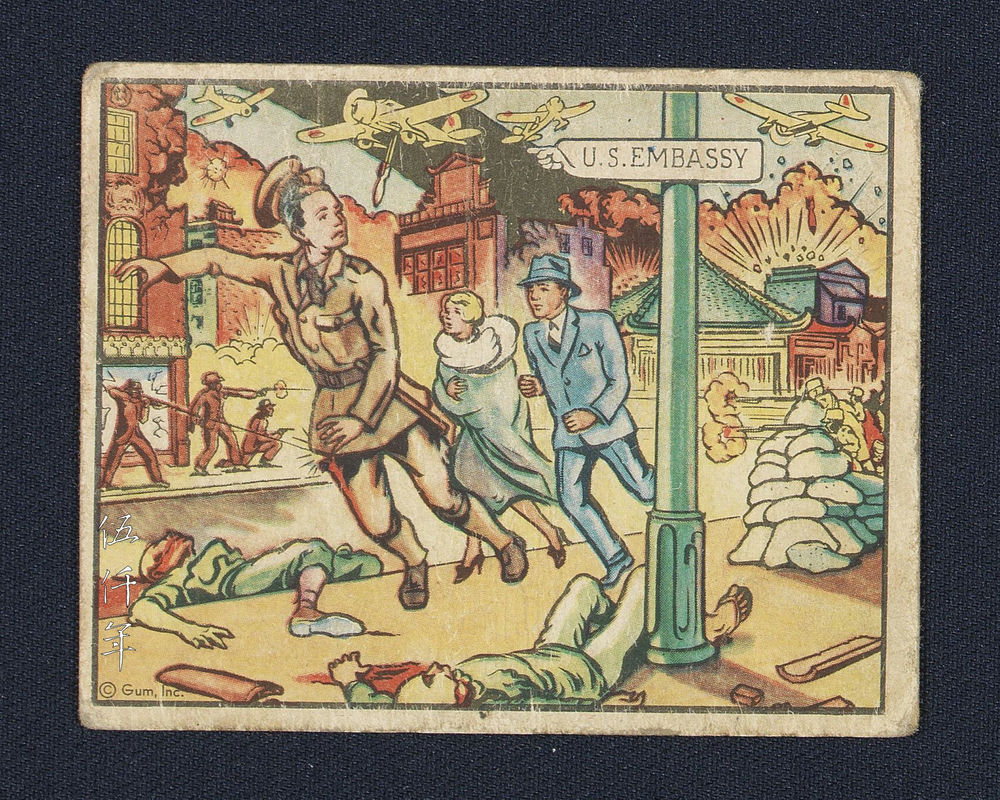
Front of Picture Card No. 3, illustrating the Japanese bombardment of Peking on 28 July 1937. Photograph courtesy Mr. Roy Delbyck
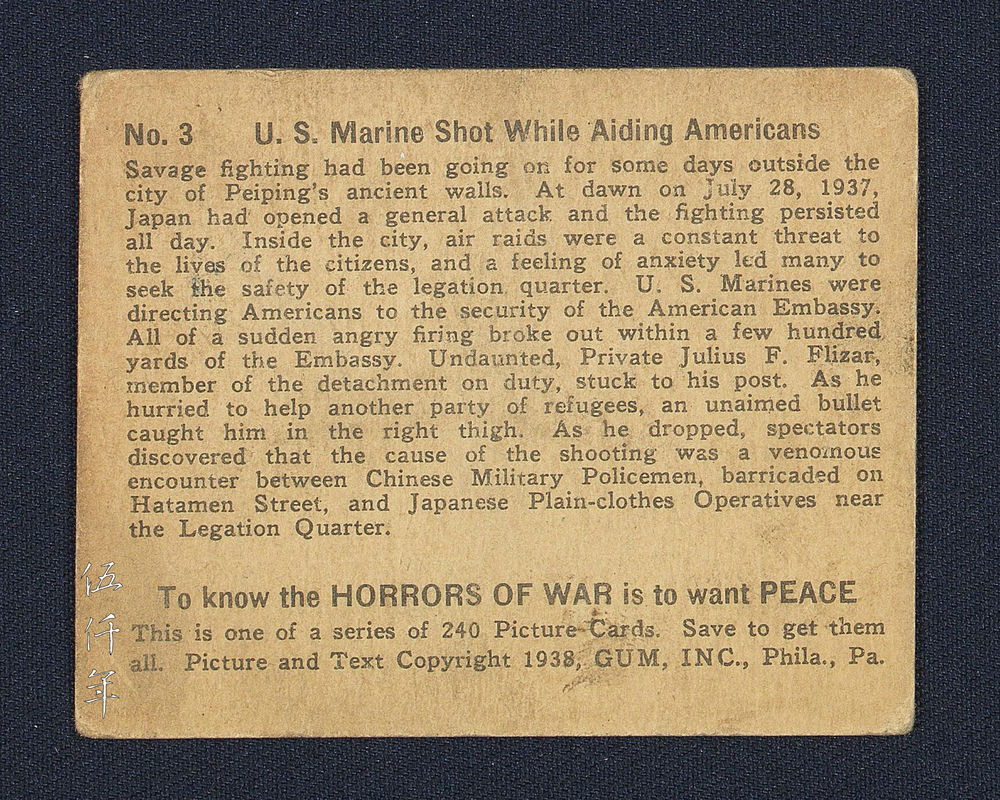
Back of Picture Card No. 3, with text describing the Japanese bombardment of Peking on 28 July 1937. Photograph courtesy Mr. Roy Delbyck
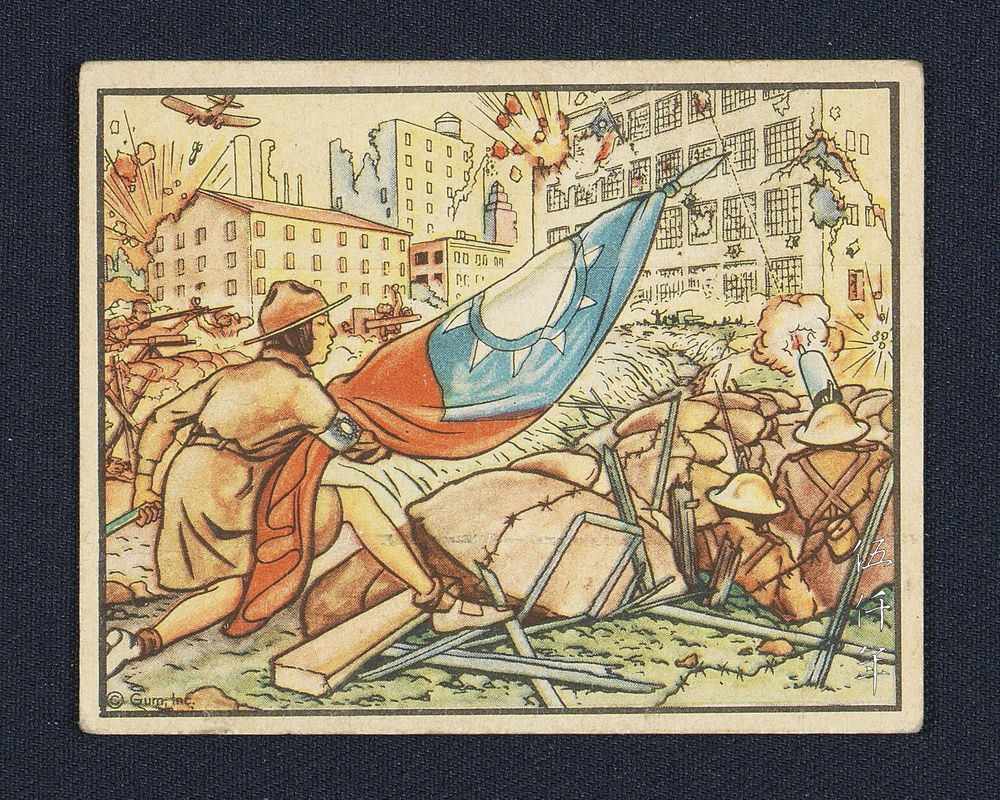
Front of Picture Card No. 17, illustrating the Girl Scout Yang Hui-min (楊惠敏) carrying the flag of the Republic of China ready to go undetected into the Ssu-hang Warehouse Fortress on 29 October 1937. Photograph courtesy Mr. Roy Delbyck

Back of Picture Card No. 17, with text describing the Girl Scout Yang Hui-min carrying the flag of the Republic of China ready to go undetected into the Ssu-hang Warehouse Fortress on 29 October 1937. Photograph courtesy Mr. Roy Delbyck
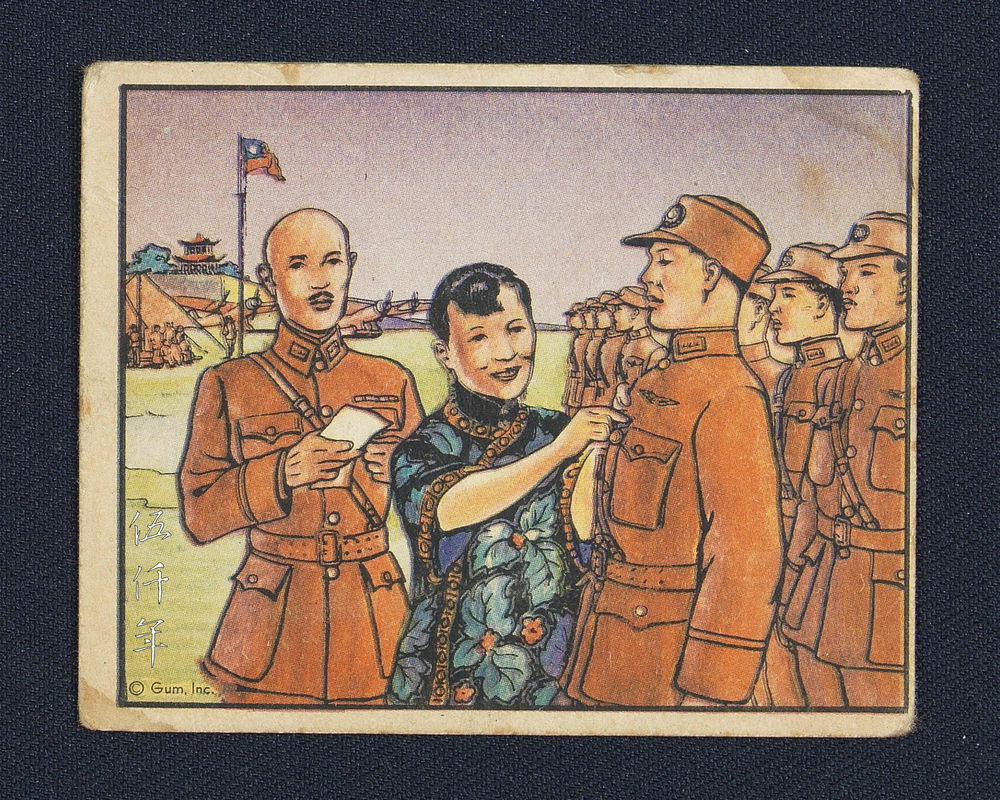
Front of Picture Card No. 63, illustrating President Chiang Kai-shek and Madame Chiang decorating the Chinese Air Force aces on 3 January 1938. Photograph courtesy Mr. Roy Delbyck
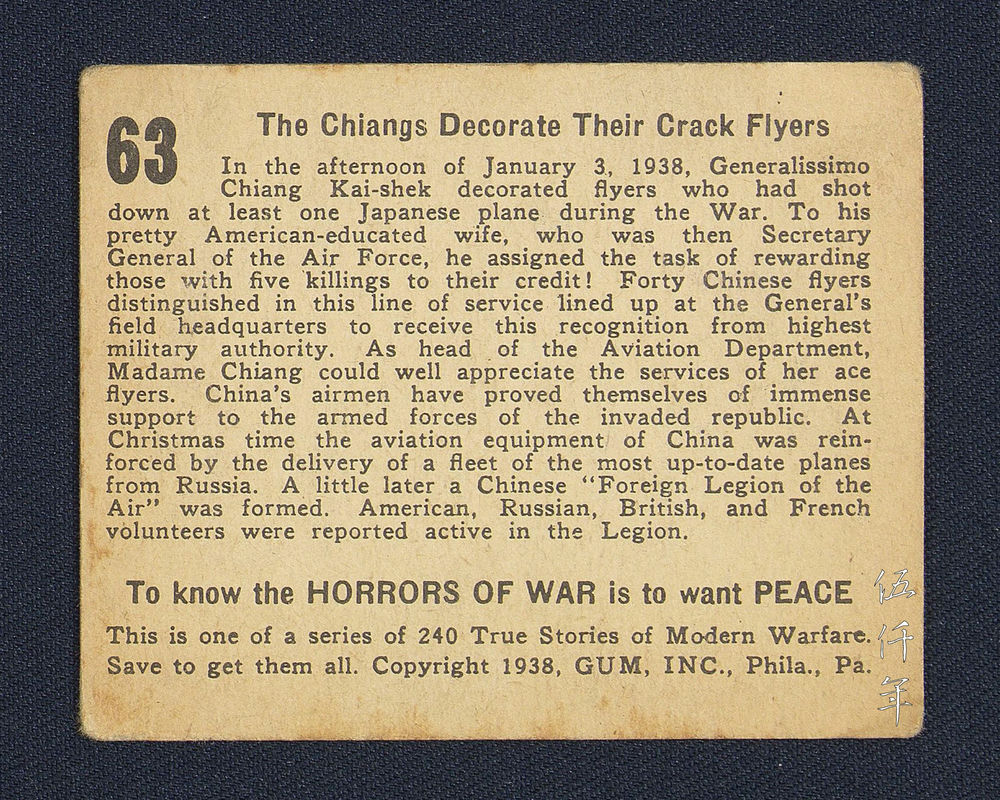
Back of Picture Card No. 63, with text describing President Chiang Kai-shek and Madame Chiang decorating the Chinese Air Force aces on 3 January 1938. Photograph courtesy Mr. Roy Delbyck
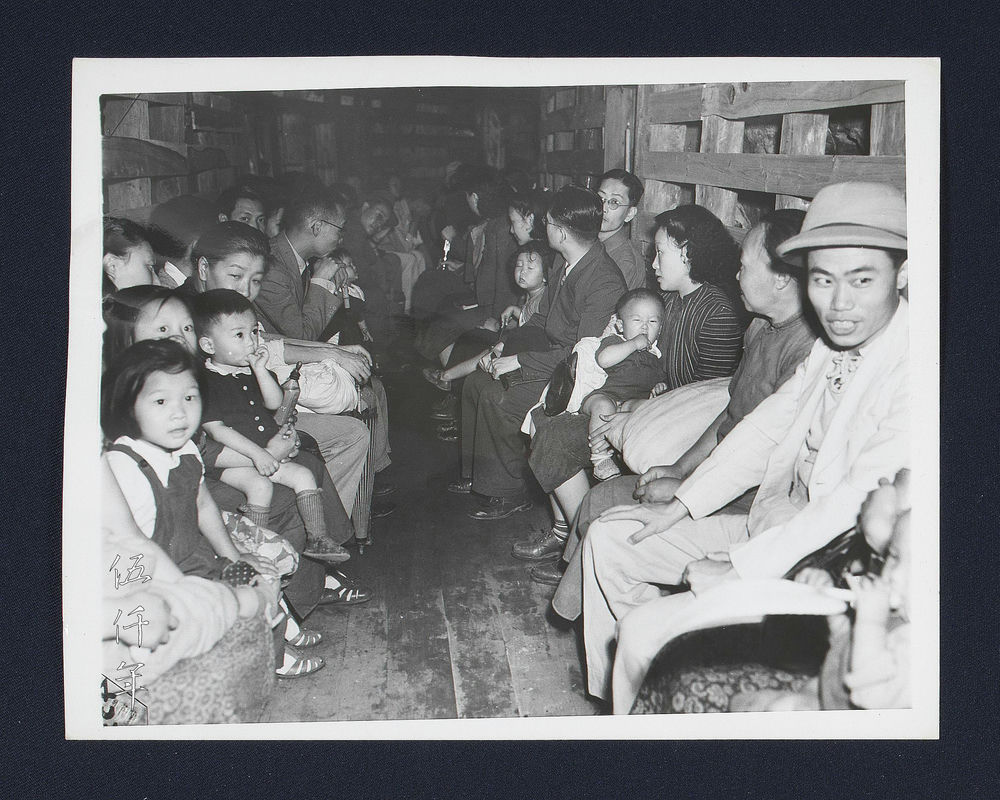
Chinese adults and children hiding in bomb shelter during Japanese raids on 20 August 1943. Photograph courtesy Mr. Roy Delbyck

Madame Chiang Kai-shek is seen here stepping over the debris of houses bombed by Japanese airplanes in Ch’ung-ch’ing, the provisional capital of China, on 29 April 1940. Photograph courtesy Mr. Roy Delbyck
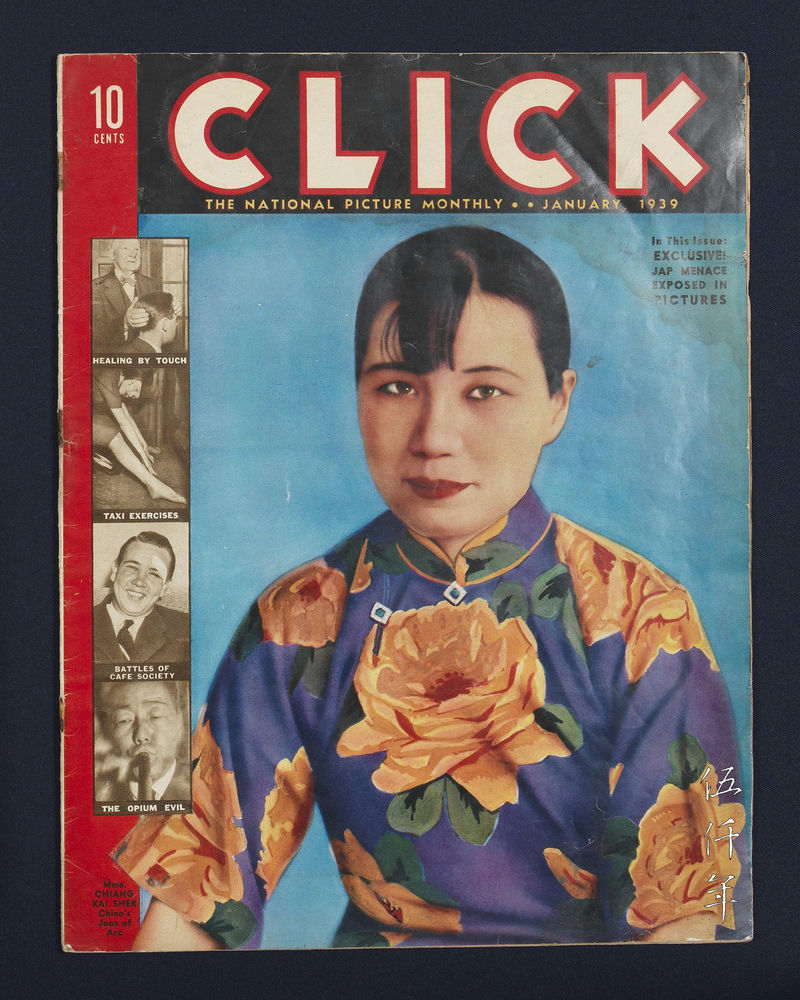
Madame Chiang Kai-shek graced the cover of Click monthly magazine in January 1939. Photograph courtesy Mr. Roy Delbyck
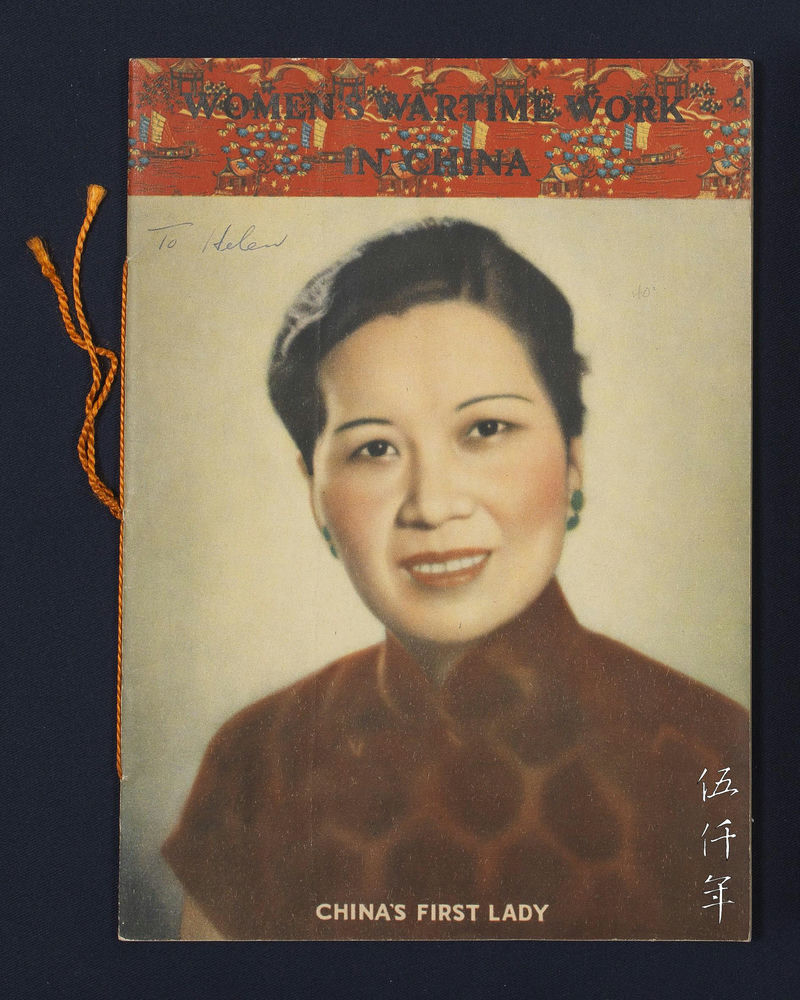
Madame Chiang Kai-shek graced the cover of Women’s Wartime Work in China. Photograph courtesy Mr. Roy Delbyck
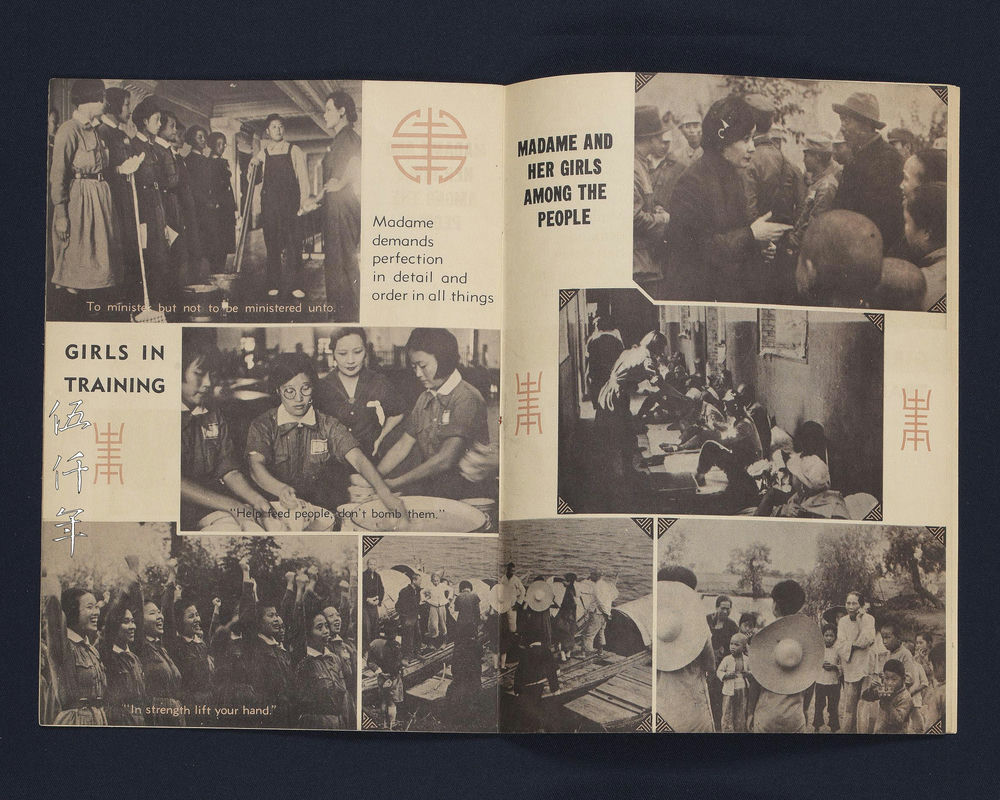
Inside pages of Women’s Wartime Work in China. Photograph courtesy Mr. Roy Delbyck
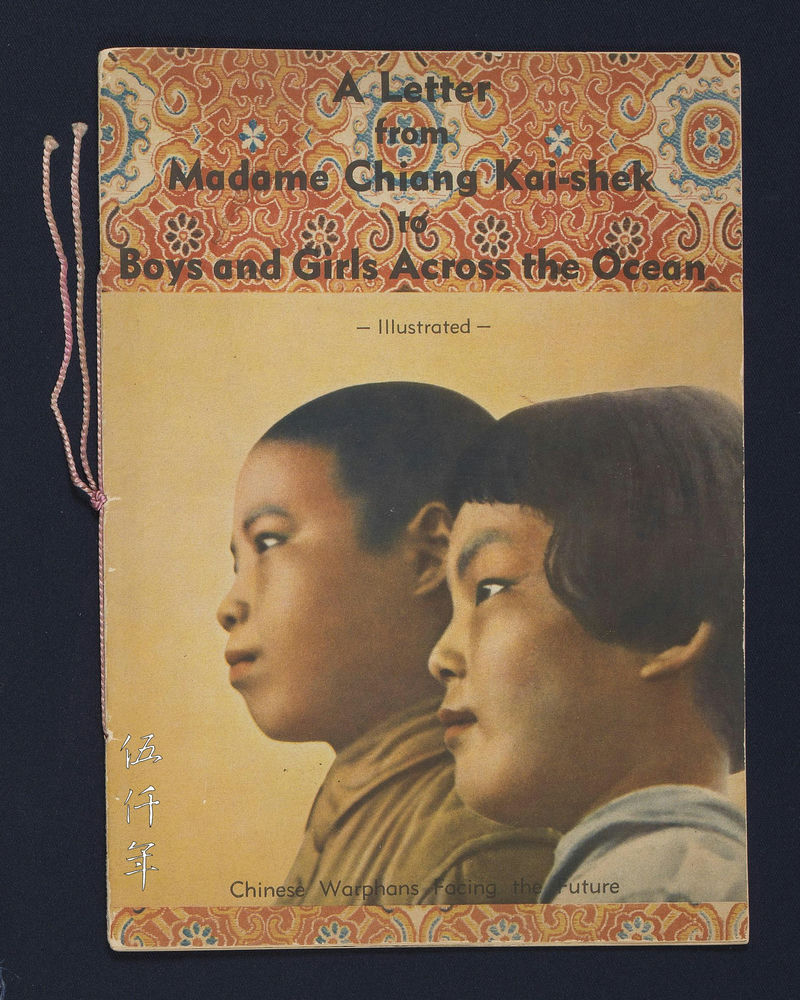
Front cover of A Letter from Madame Chiang Kai-shek to Boys and Girls Across the Ocean, printed in 1940 in Ch’ung-ch’ing, the provisional capital of China. Photograph courtesy Mr. Roy Delbyck

Inside pages of A Letter from Madame Chiang Kai-shek to Boys and Gorls Across the Ocean, printed in 1940 in Ch’ung-ch’ing, the provisional capital of China. Photograph courtesy Mr. Roy Delbyck
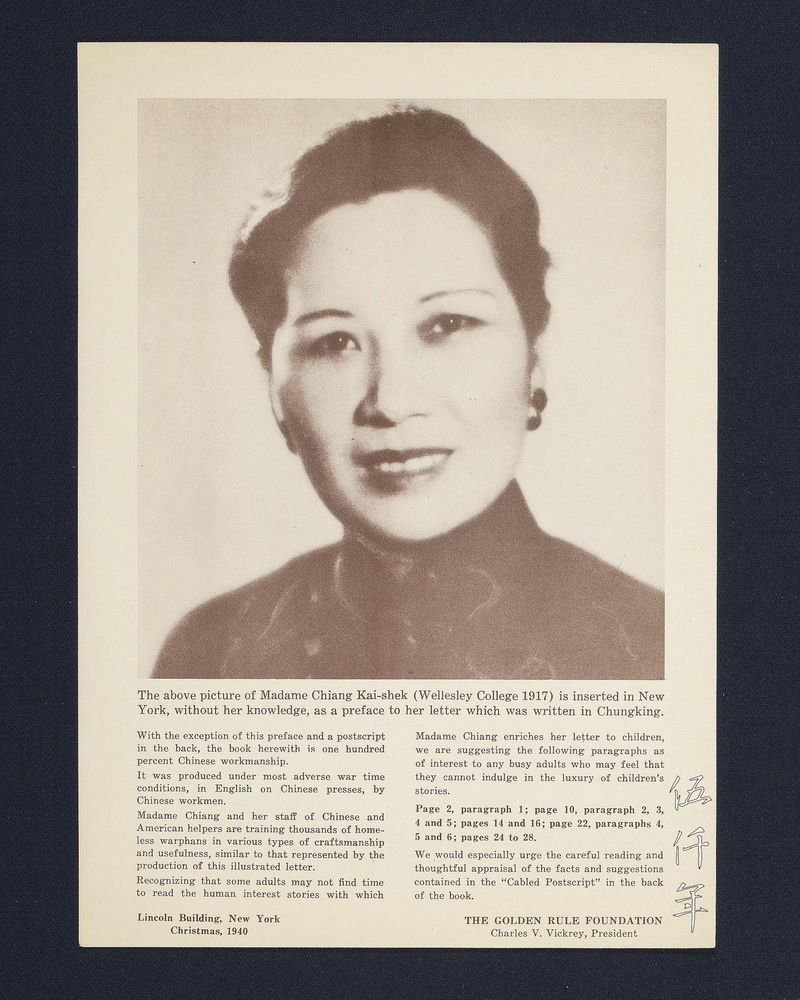
Front of insert page of A Letter from Madame Chiang Kai-shek to Boys and Girls Across the Ocean, printed in 1940 in America. Photograph courtesy Mr. Roy Delbyck
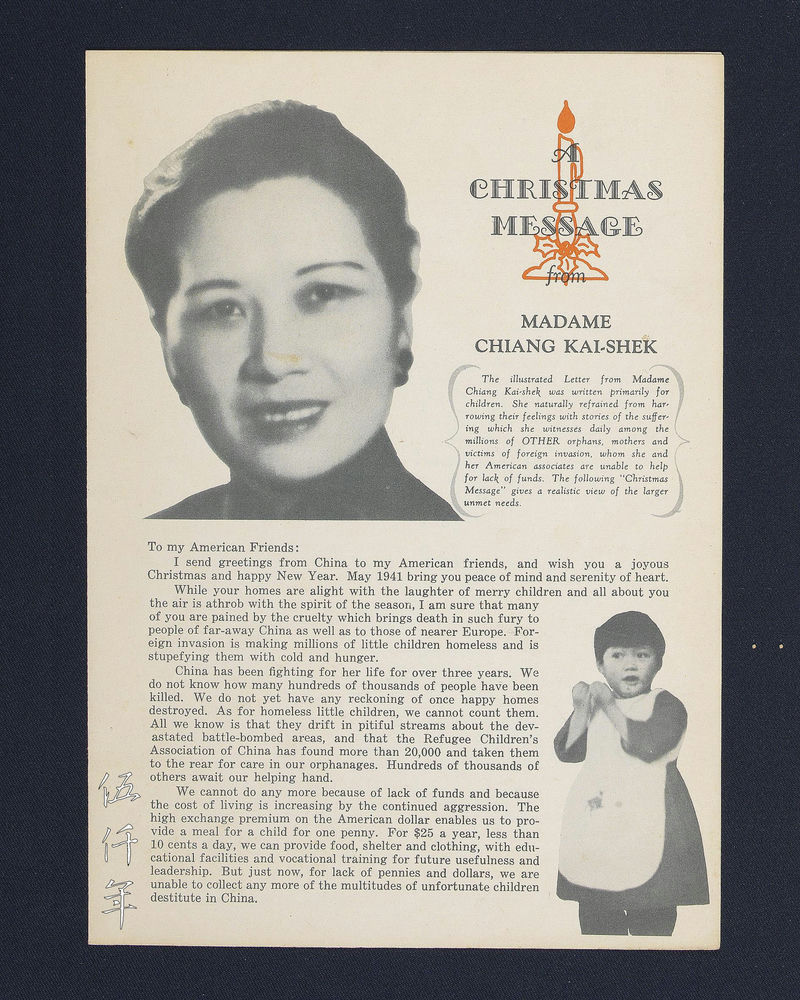
Back of insert page of A Letter from Madame Chiang Kai-shek to Boys and Girls Across the Ocean, with Christmas message. Photograph courtesy Mr. Roy Delbyck
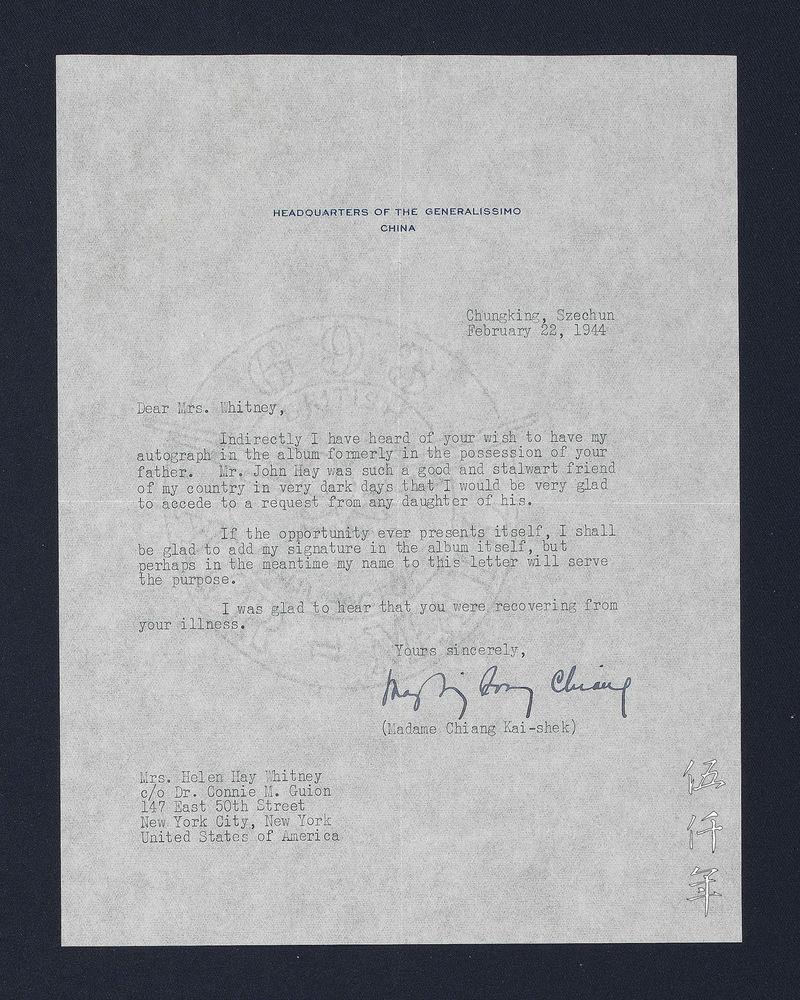
Letter to Mrs. Helen Hay Whitney, daughter of Secretary of State John Milton Hay, signed by Madame Chiang Kai-shek, dated 22 February 1944 from Ch’ung-ch’ing, the provisional capital of China. Photograph courtesy Mr. Roy Delbyck

Inside pages of I Bear My Witness by Generalissimo Chiang Kai-shek, printed by the Young Men’s Christian Association in 1943 in New York. Photograph courtesy Mr. Roy Delbyck

Front cover of We Believe, by Generalissimo and Madame Chiang Kai-shek. Photograph courtesy Mr. Roy Delbyck
Support India
Support India
By the mid-nineteenth century, Britain had largely conquered India, but in the 1920s, Indian political leaders like Gandhi and Nehru were beginning to advocate Indian independence. Although British Raj declared war on Germany in 1939 and Britain had conscripted a large number of Indian troops to various battlefields, many Indian politicians opposed supporting the British and prioritized Indian independence. There were many who considered collaborating with Japan to overthrow British rule. On 4 February 1942, the 31st year of the Republic, President Chiang accompanied by his wife, left Ch’ung-ch’ing (重慶) to visit India which was of great strategic importance. During the visit, on one hand he discussed the China-Burma-India war theater with the British and on the other hand, he met with Indian political leaders such as Nehru and Gandhi. President Chiang and his wife were staunch nationalists and very sympathetic towards the anti-colonial movement. His meeting with Gandhi was especially annoying to the British. As Madame Chiang was fluent in English, her interpretation during conversations with Nehru and Gandhi helped President Chiang in understanding the nuances and details.
Before leaving India on 21 February, President Chiang published Message to the Indian People in which he concluded with:
“I also firmly believe that our ally, Britain, will not wait for the Indian people to make demands, but will swiftly grant the Indian people real political power.”
President Chiang and his wife’s stand on national self-determination was a thorn in the side of British colonialism. For Indian independence, the Republic of China was willing to risk its relationship with its ally Britain. However, as soon as the Chinese mainland fell to the communists, India established diplomatic relations with the Chinese Communists on 1 April 1950. In a world driven by self-interest, President Chiang Kai-shek’s adherence to righteousness to mold a Confucian China still inspires admiration eight decades later.
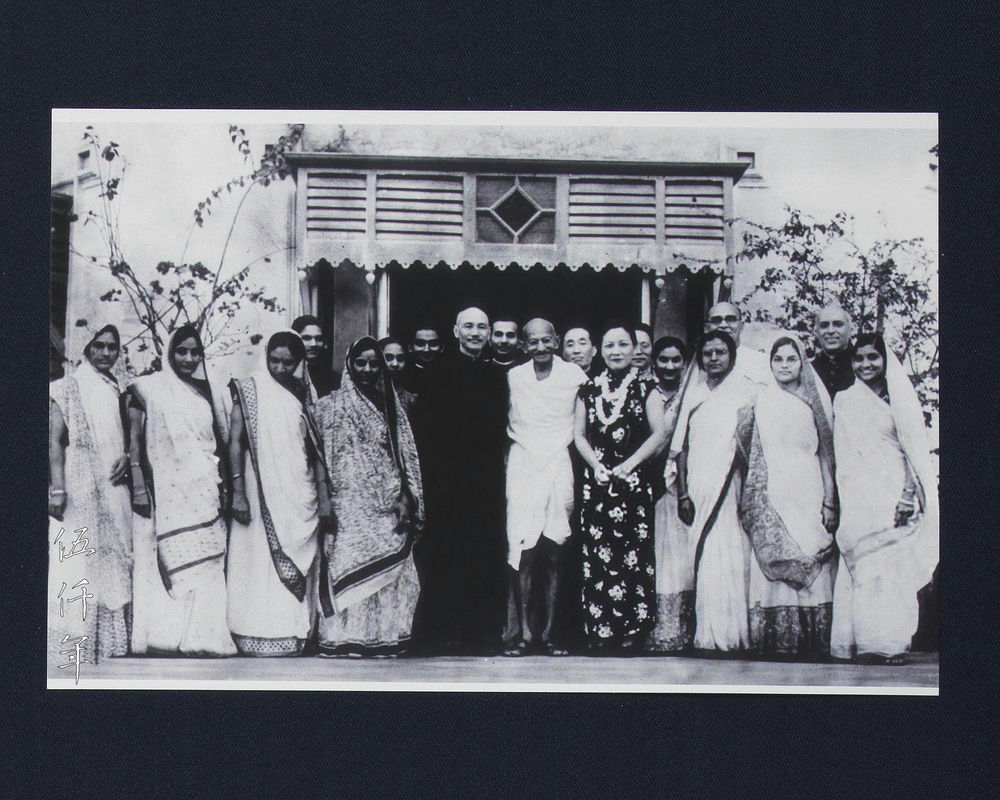
Group portrait of President Chiang Kai-shek, Madame Chiang Kai-shek and Gandhi in India, February 1942. Photograph courtesy Mr. Roy Delbyck
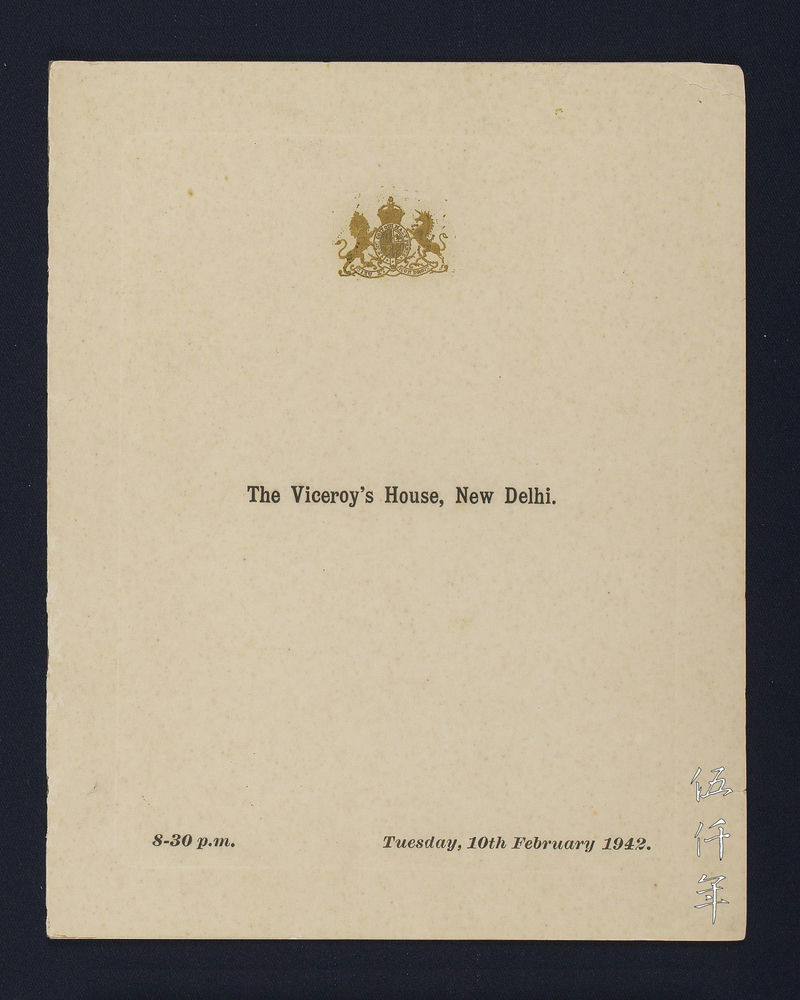
The Viceroy of India hosted a dinner to welcome President Chiang Kai-shek and Madame Chiang Kai-shek on 10 February 1942. Front cover of the dinner programme. Photograph courtesy Mr. Roy Delbyck

The Viceroy of India hosted a dinner to welcome President Chiang Kai-shek and Madame Chiang Kai-shek on 10 February 1942. Seating plan of the dinner. Photograph courtesy Mr. Roy Delbyck
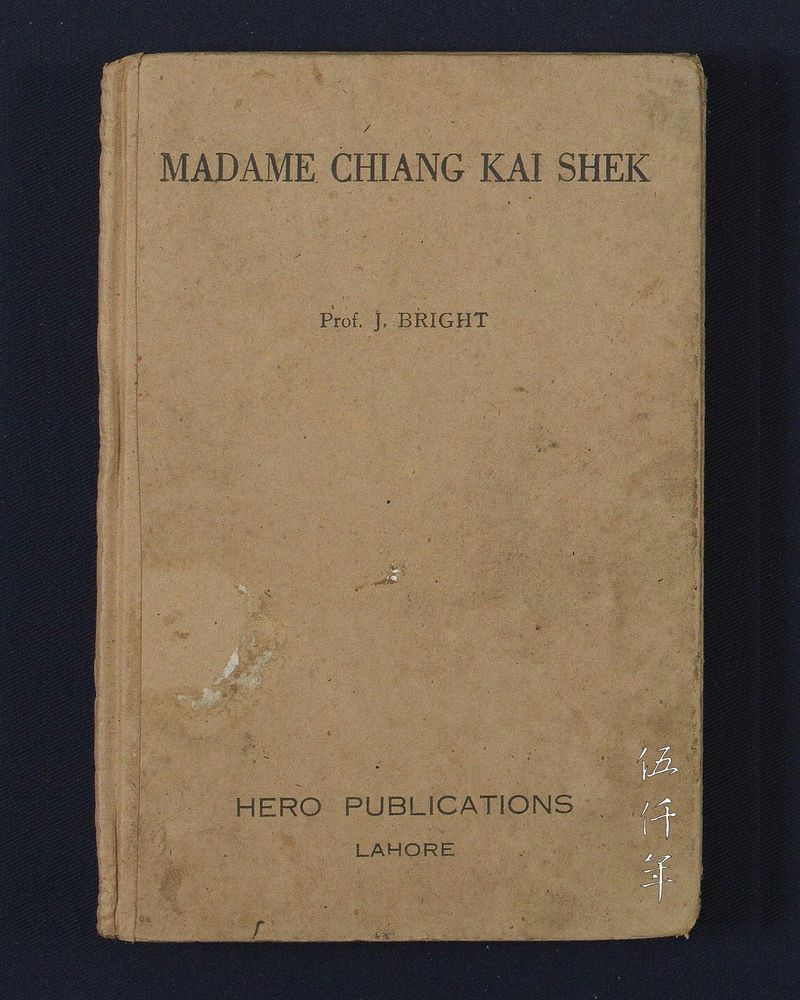
Front cover of Madame Chiang Kai-shek by Professor J. Bright, published in late 1942 in Lahore. Photograph courtesy Mr. Roy Delbyck
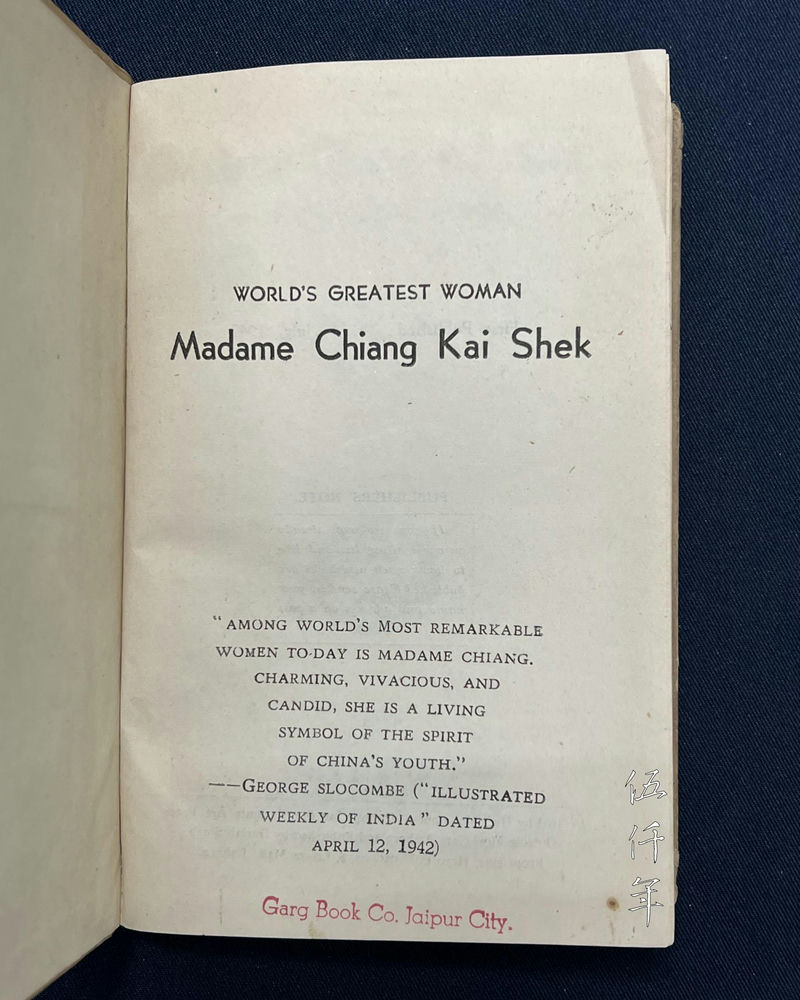
Title page of Madame Chiang Kai-shek, with subtitle: World’s Greatest Woman. Photograph courtesy Mr. Roy Delbyck

Dedication printed at the back of the title page: To Mahatama Gandhi, world’s greatest man, who even captivated Madame Chiang Kai-shek, world’s greatest woman. Photograph courtesy Mr. Roy Delbyck

Preface page of Madame Chiang Kai-shek. Photograph courtesy Mr. Roy Delbyck
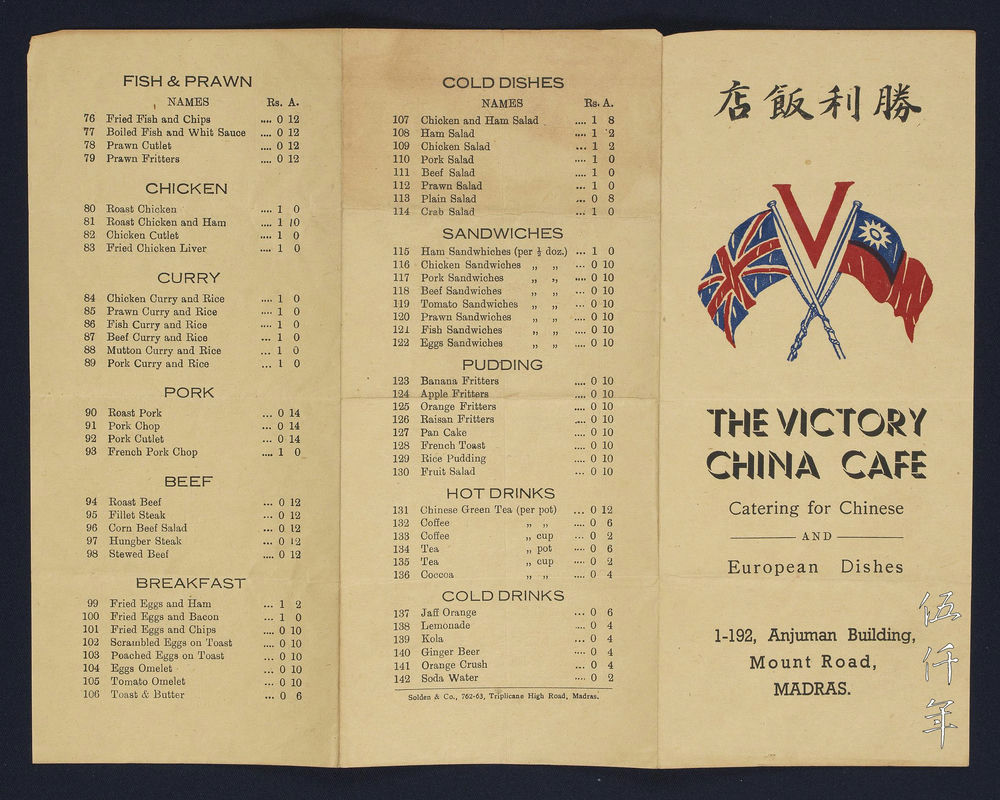
Menu of The Victory China Cafe in Madras. As India was ruled by Britain at the time, both Chinese and British flags were printed on the menu. The name of Victory China Cafe also reflected the hope of overseas Chinese. Photograph courtesy Mr. Roy Delbyck
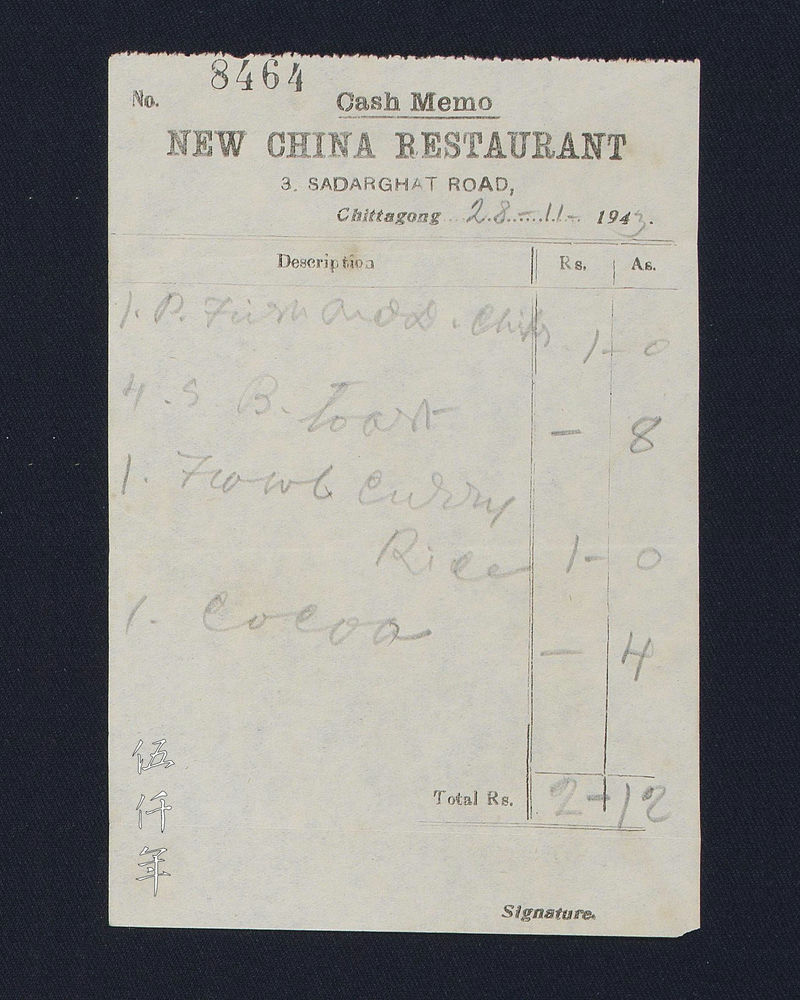
Cash memo of New China Restaurant in Chittagong. The name of New China conveyed the aspiration of overseas Chinese. Photograph courtesy Mr. Roy Delbyck

Menu of China Hotel in Colombo, Sri Lanka. The flag of the Republic of China was placed in the middle of the logo, embraced as the identity of overseas Chinese. Photograph courtesy Mr. Roy Delbyck

Menu of Free China Hotel in Colombo, Sri Lanka. The name of Free China reflected the yearning of overseas Chinese. Photograph courtesy Mr. Roy Delbyck
Persuade America
Persuade America
Harking back to 1942, the 31st year of the Republic, also the 5th year of the War of Resistance Against Japanese Aggression, Madame Chiang’s chronic illness became severe, and in mid-November she traveled to the United States for medical treatment. She arrived in New York on 27 November and was admitted to the Presbyterian Hospital. She was discharged in February the following year. President Roosevelt and his wife invited Madame Chiang to stay at their private residence in Hyde Park for six days. On 18 February she was invited to Washington to address the US Congress, to both the Senate and the House of Representatives. Her address in the House of Representatives lasted approximately twenty one minutes and was broadcasted by radio, reaching countless listeners. On 1 March Madame Chiang arrived in New York from Washington, starting her official visit to New York. On 6 March she arrived in Boston and the following day, she returned to speak at her alma mater, Wellesley College. On 9 March she returned to New York, and on March 19, she arrived in Chicago from New York. On 25 March, she arrived in San Francisco from Chicago, and on 31 March she arrived in Los Angeles from San Francisco. On 4 April she delivered an outdoor speech in Hollywood at Hollywood Bowl, attended by approximately 30,000 people. On 11 April she returned to New York from Los Angeles.
Madame Chiang’s visit to the United States showcased her talent and style, captivating the politicians as well as the general public. She persuaded public opinion and dispelled prejudices against the Chinese. Furthermore, various sectors contributed funds to assist China’s war effort. Her visit was especially helpful to the long-term fundraising for aid by the United China Relief organization which was established in New York in 1941.
Madame Chiang’s visit to the United States accelerated the repeal of the Chinese Exclusion Act. On 17 December 1943, the U.S. Congress finally passed the Repeal of the Chinese Exclusion Act, also known as the Magnuson Act.
Washington
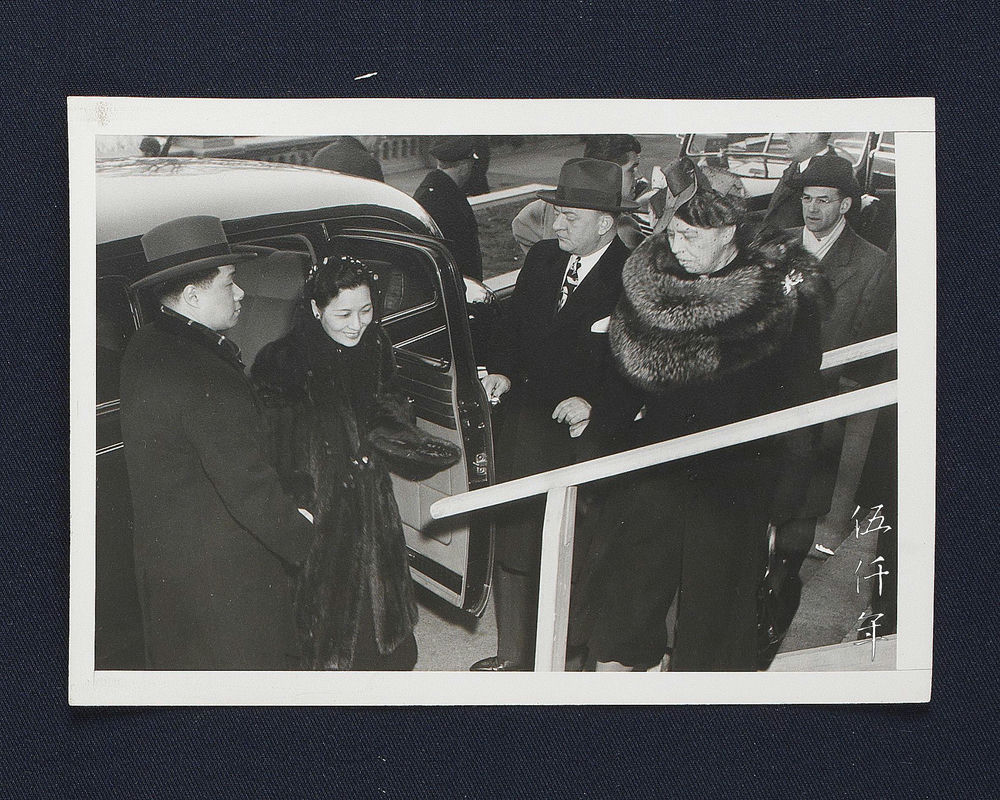
Photograph of Madame Chiang Kai-shek taken during her visit to Washington between 17 February and 28 February 1943. Standing on the right is Mrs Eleanor Roosevelt. Photograph courtesy Mr. Roy Delbyck
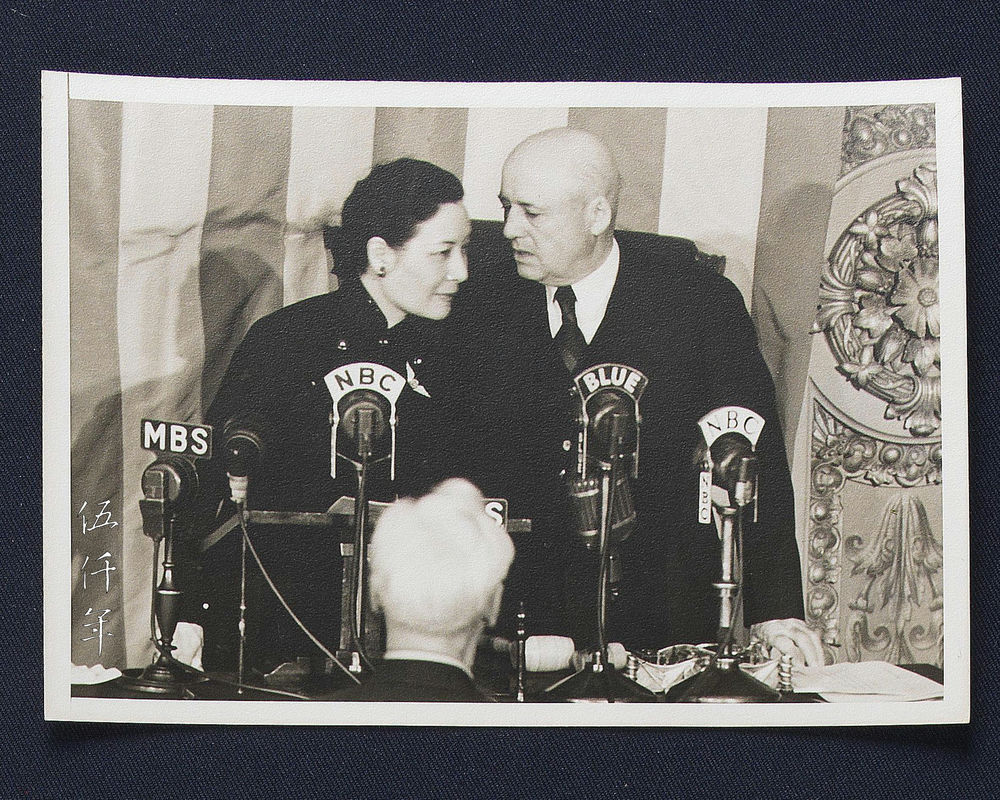
Madame Chiang Kai-shek speaking with House Speaker Sam Rayburn before the address in the afternoon of 18 February 1943. Photograph courtesy Mr. Roy Delbyck

Madame Chiang Kai-shek addressing the House of Representatives in the afternoon of 18 February 1943. Standing on the right is House Speaker Sam Rayburn. Photograph courtesy Mr. Roy Delbyck
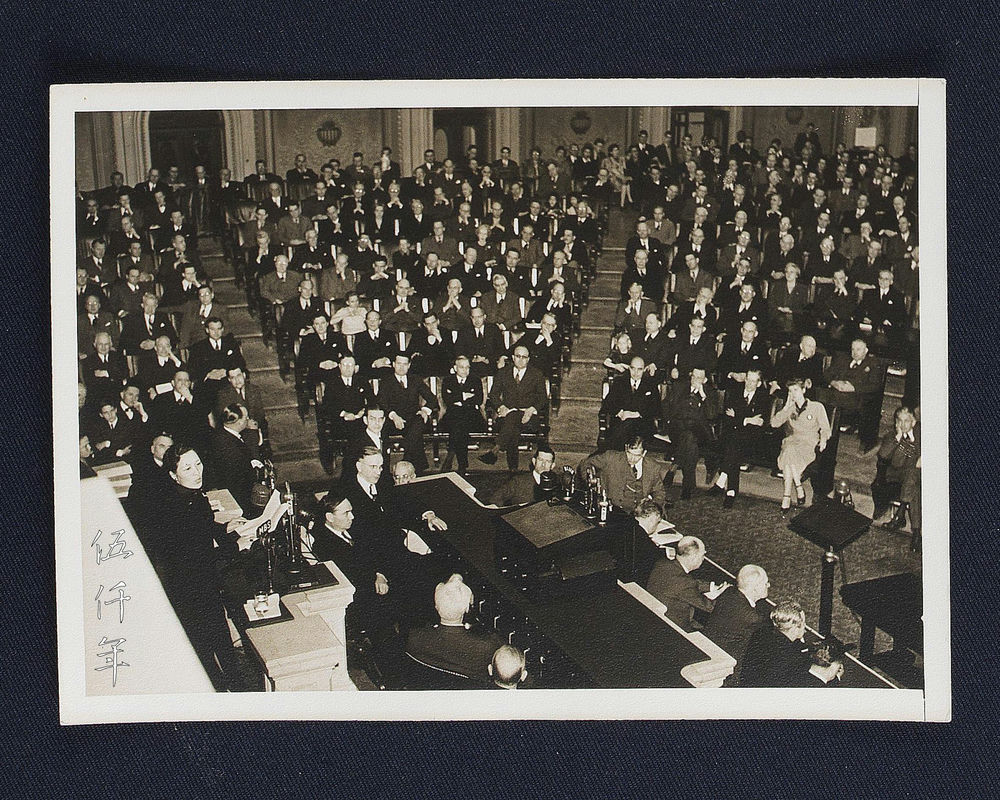
View of the House floor during the address by Madame Chiang Kai-shek in the afternoon of 18 February 1943. Photograph courtesy Mr. Roy Delbyck
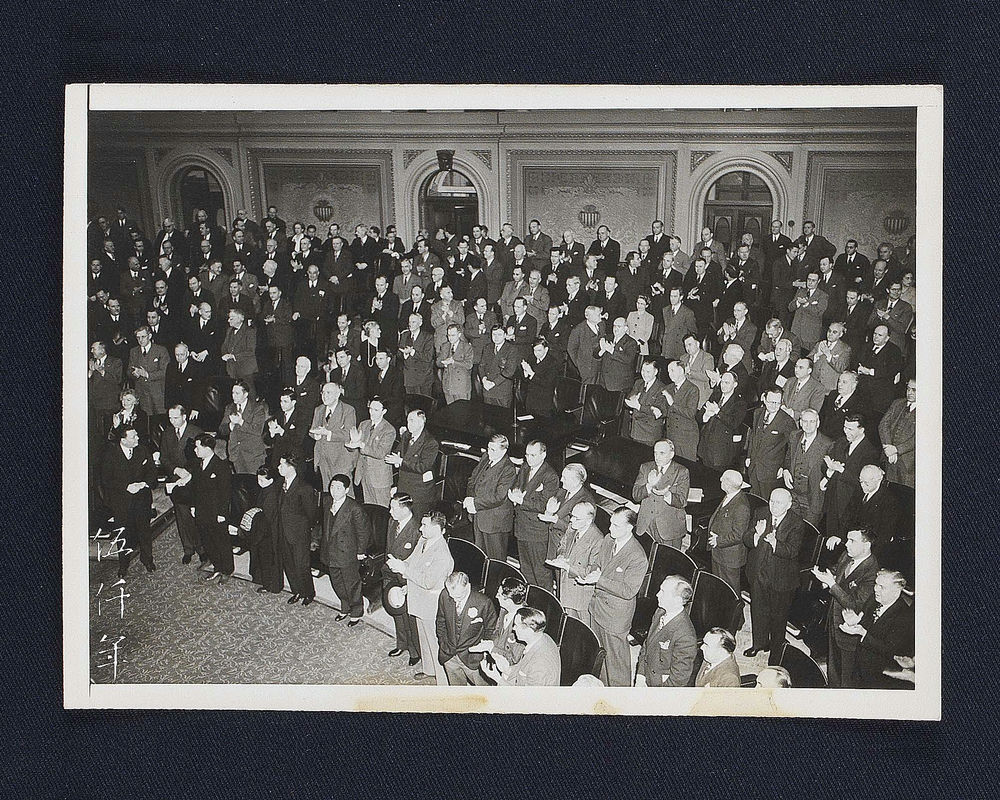
Standing ovation from the House after the address by Madame Chiang Kai-shek in the afternoon of 18 February 1943. Photograph courtesy Mr. Roy Delbyck
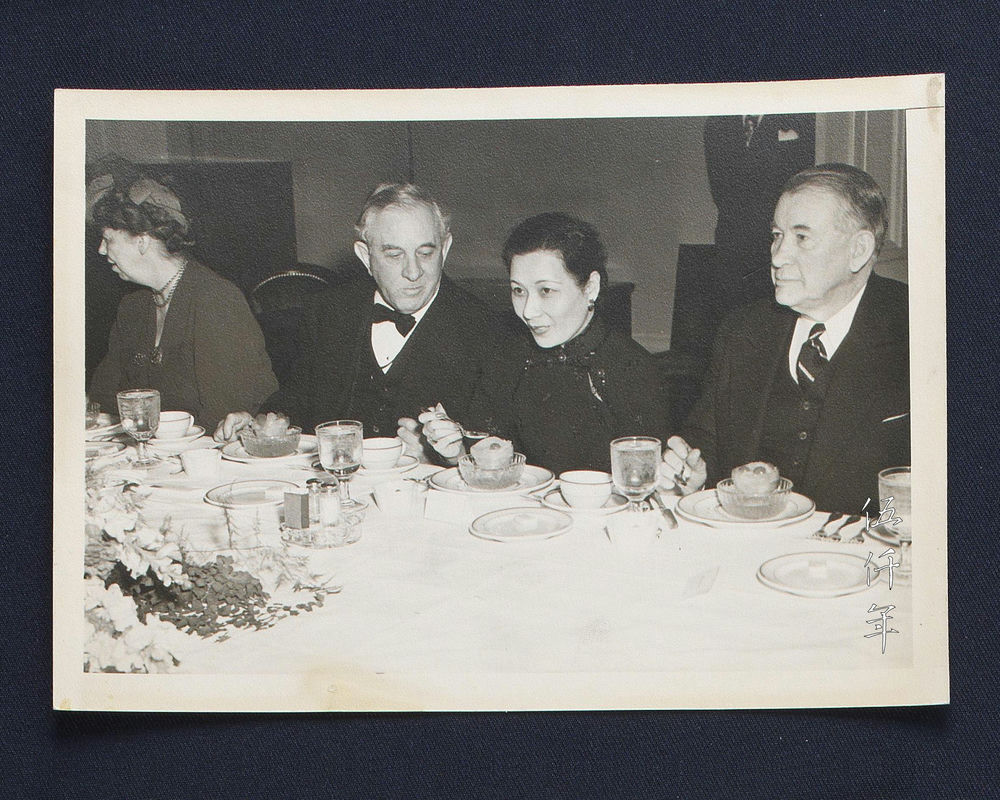
Luncheon given by the Senators and Representatives of Congress to honour Madame Chiang Kai-shek after her address in the afternoon of 18 February 1943. Mrs. Eleanor Roosevelt (first on left), Senator Tom Connally (second on left), Madame Chiang Kai-shek (second on right) and majority leader Allen Barkley (first on right). Photograph courtesy Mr. Roy Delbyck

Mrs. Eleanor Roosevelt presented Madame Chiang Kai-shek with the Chi Omega sorority medal at the White House in the afternoon of 19 February 1943. Photograph courtesy Mr. Roy Delbyck
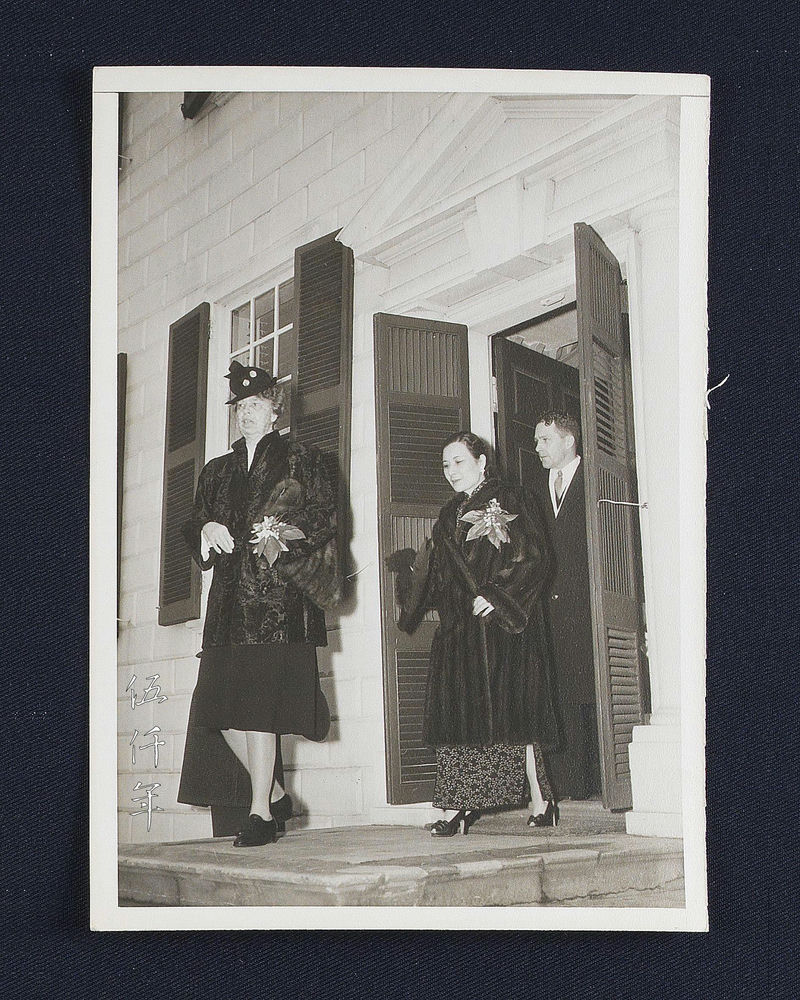
Madame Chiang Kai-shek visited the Mount Vernon mansion of George Washington, first President of the United States, on his birth anniversary of 22 February 1943, accompanied by Mrs. Eleanor Roosevelt. Photograph courtesy Mr. Roy Delbyck
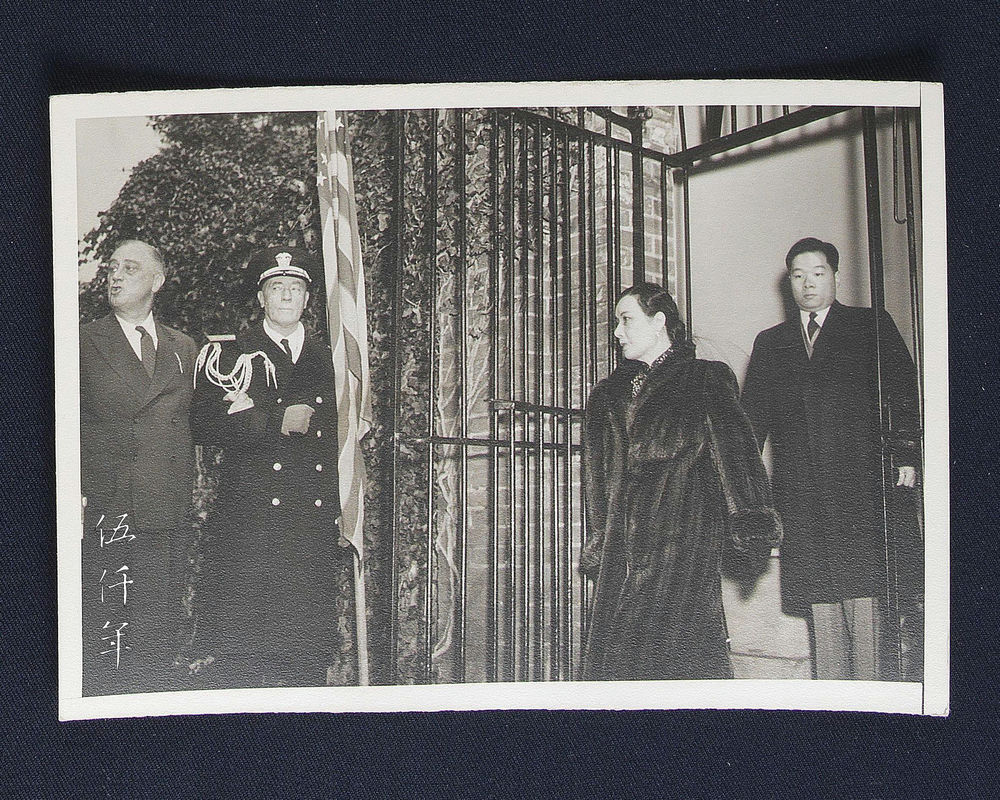
After leaving the Mount Vernon mansion of George Washington, Madame Chiang Kai-shek visited Washington’s tomb to lay a wreath on the same day of 22 February 1943. Standing on the left is President Roosevelt. Photograph courtesy Mr. Roy Delbyck
New York

Madame Chiang Kai-shek arrived in New York on 1 March 1943. A few days beforehand, on 25 February, Fiorello H. La Guardia who was the mayor of New York, wrote to invite the president of Uptown Chamber of Commerce to attend the welcome ceremony in the City Hall Plaza and the reception in the City Hall. Photograph courtesy Mr. Roy Delbyck
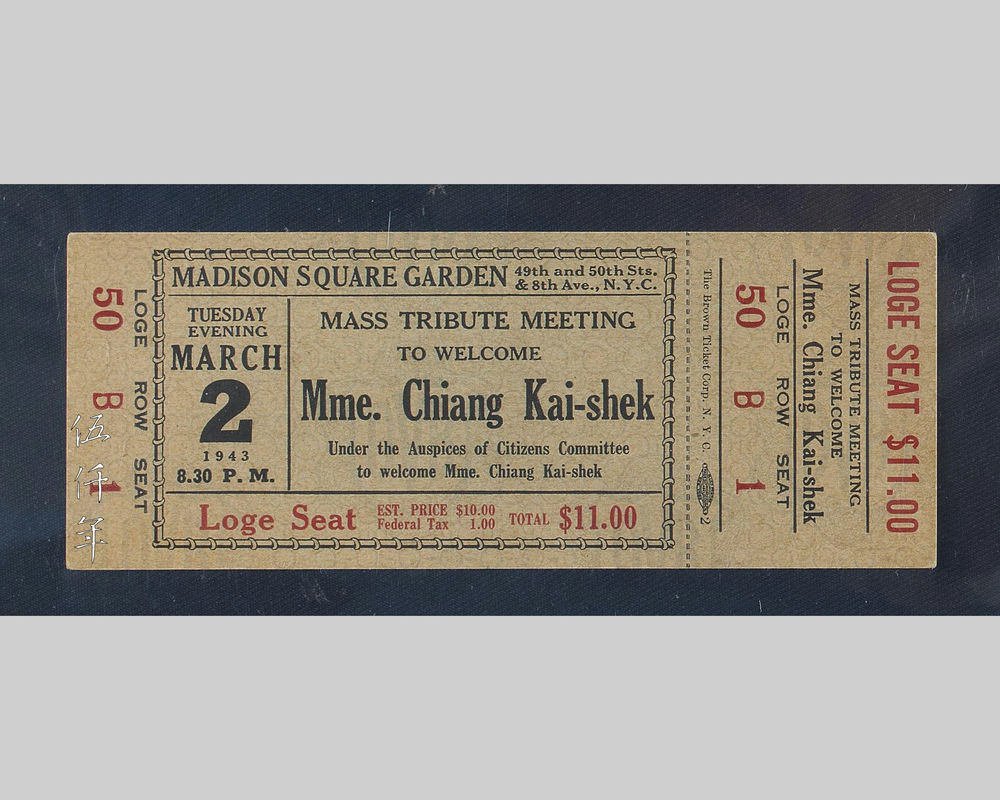
Ticket to attend the Mass Tribute Meeting to Welcome Madame Chiang Kai-shek at Madison Square Garden at 8:30 pm on 2 March 1943. Photograph courtesy Mr. Roy Delbyck
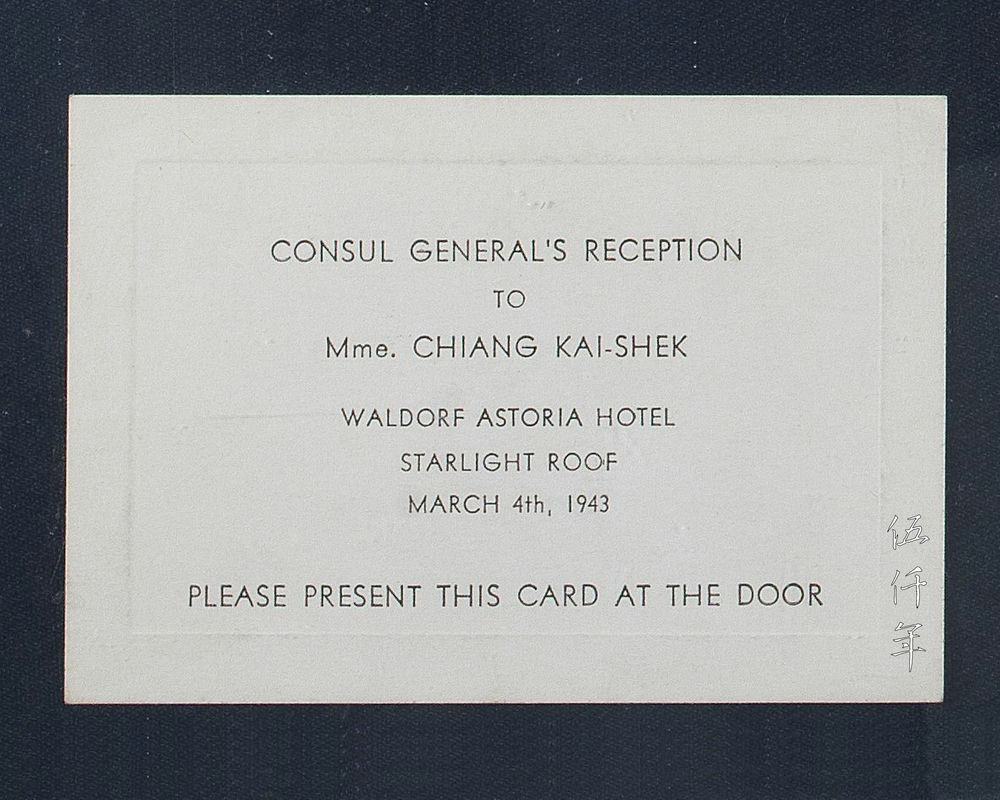
Invitation to the Reception for Madame Chiang Kai-shek hosted by the Consul General of the Republic of China at the Waldorf Astoria Hotel on 4 March 1943. Approximately 1,100 guests attended the Reception. Photograph courtesy Mr. Roy Delbyck
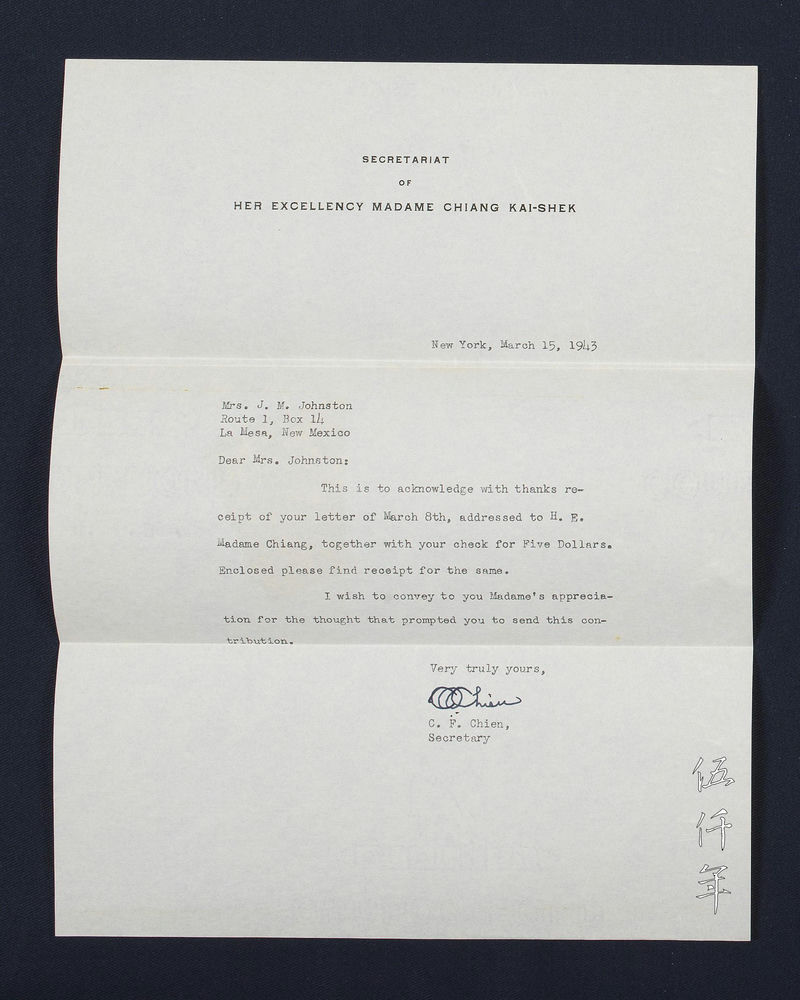
During Madame Chiang Kai-sheik’s tour of the United States, many were inspired to support the cause of China. This is a thank you letter from the secretariat of Madame Chiang Kai-shek to the donor Mrs. Johnston who contributed five dollars to the war orphans of China, dated 15 March 1943. Photograph courtesy Mr. Roy Delbyck

Receipt to Mrs. Johnston who contributed five dollars to the war orphans of China, dated 14 March 1943. Photograph courtesy Mr. Roy Delbyck
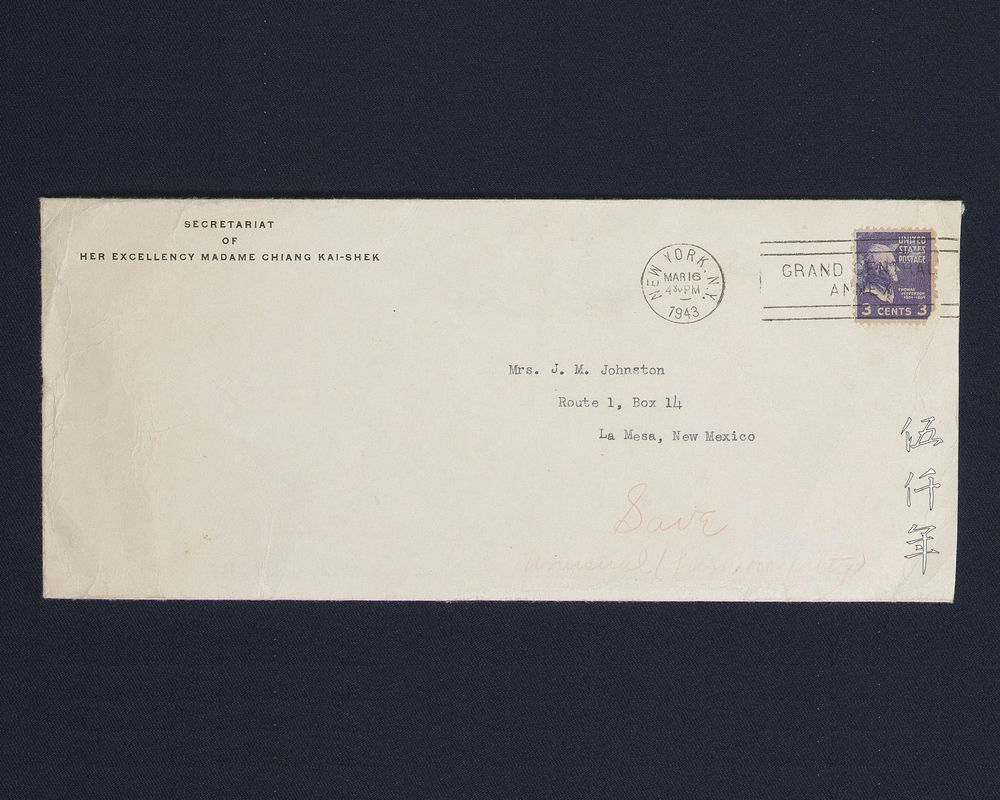
Envelope of the letter and receipt addressed to Mrs. Johnston. Photograph courtesy Mr. Roy Delbyck
Boston

On 6 March 1943, Madame Chiang Kai-shek arrived in Boston and drove to Wellesley. The following day, she gave a speech at her alma mater Wellesley College. This photograph was taken on 8 March while strolling the grounds of Wellesley College with Lieutenant Commander Mildred McAfee, president of Wellesley College. Photograph courtesy Mr. Roy Delbyck
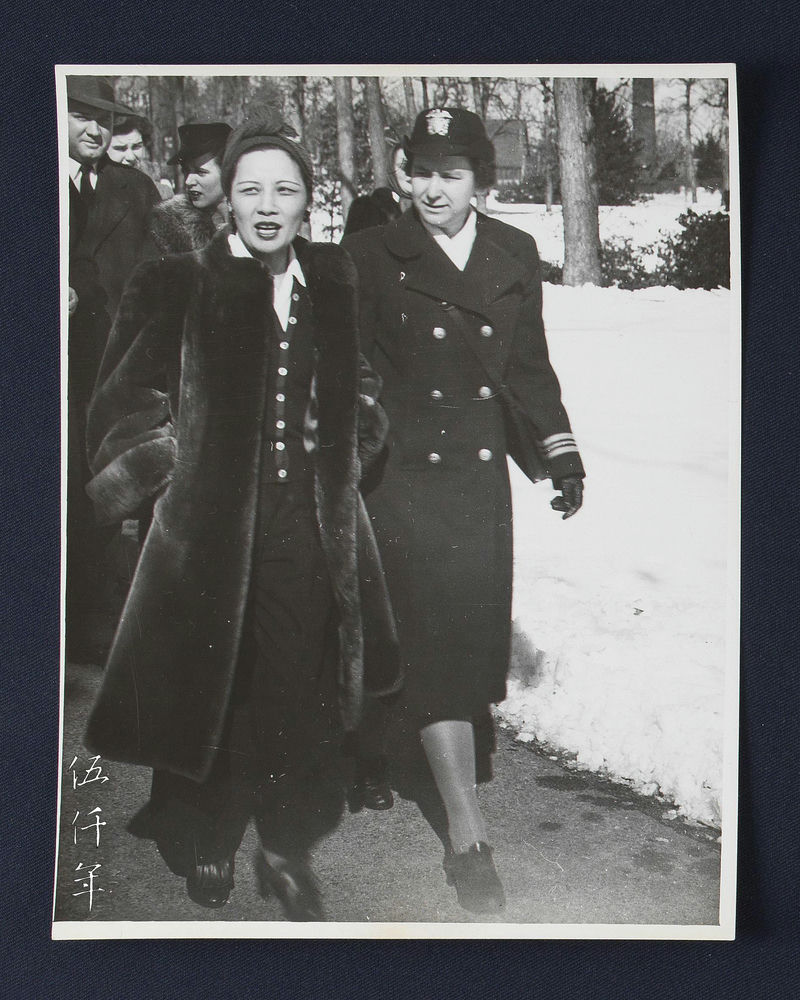
Madame Chiang Kai-shek visited Wellesley College from 6 March to 8 March for three days. This photograph was taken on 8 March while strolling the grounds of Wellesley College with Lieutenant Commander Mildred McAfee, president of Wellesley College.
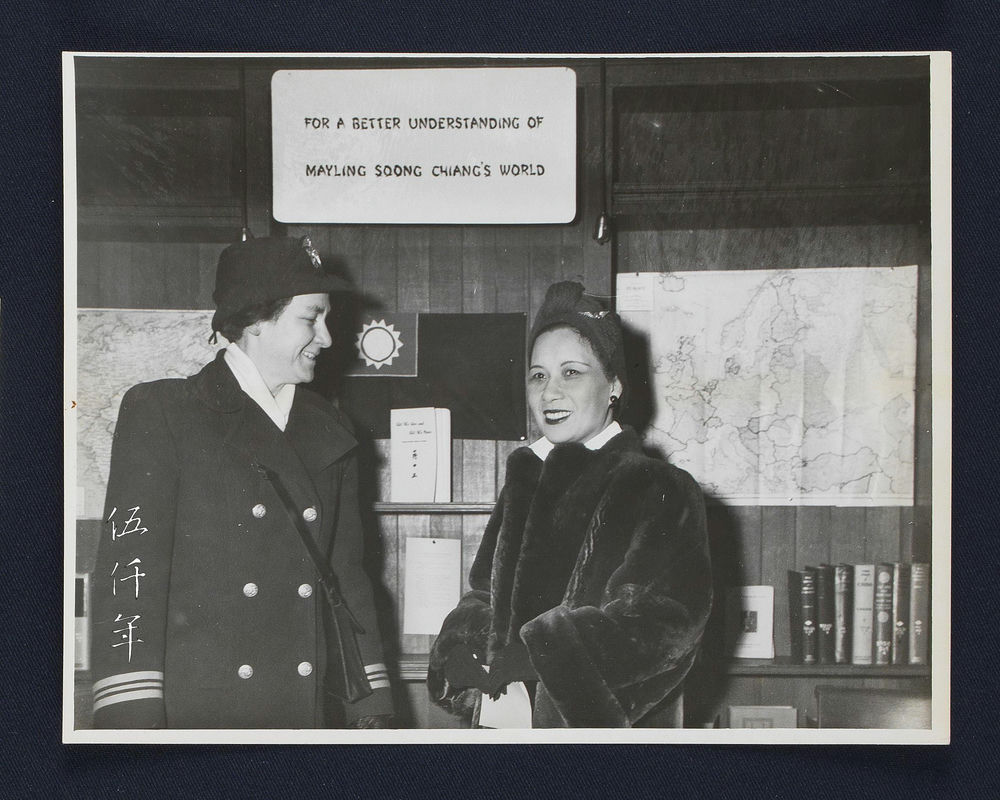
On 8 March 1943, Madame Chiang Kai-shek visited the library of Wellesley College in the company of Lieutenant Commander Mildred McAfee, president of Wellesley College. On the back wall, there are the flag of the Republic of China, a map of China, a book by President Chiang Kai-shek, and other books about China. The words on the horizontal plaque read: For a Better Understanding of Mayling Soong Chiang’s World
Chicago
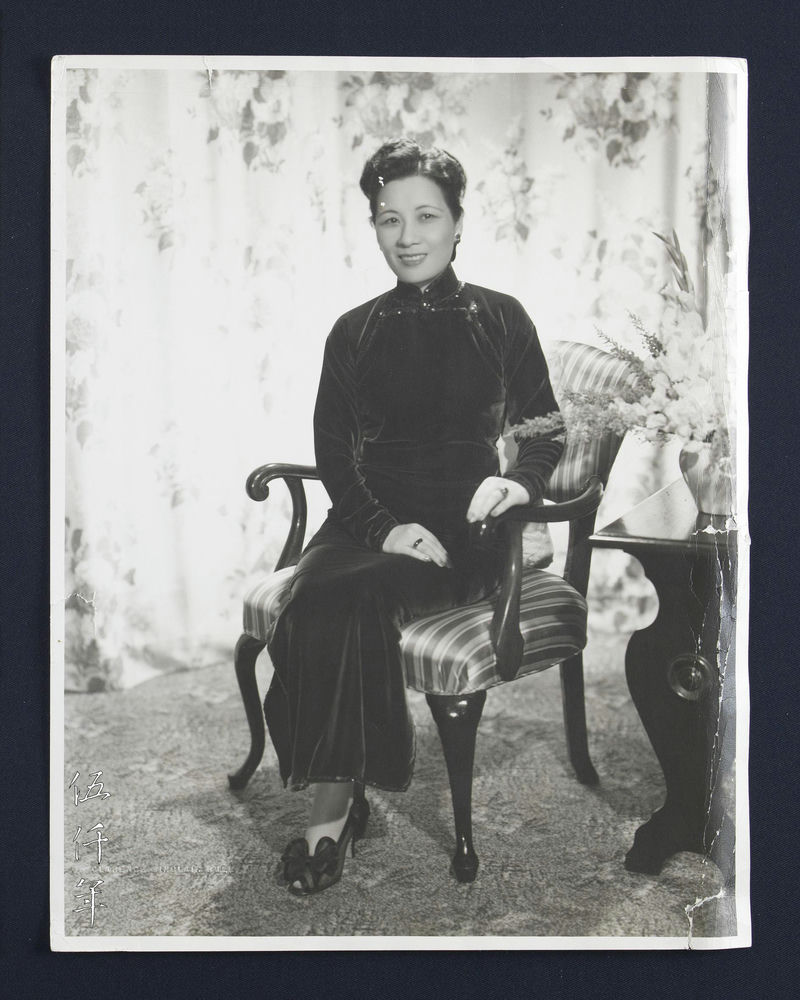
On 19 March 1943, Madame Chiang Kai-shek arrived in Chicago from New York. This photograph was taken during her stay in Chinago. Photograph courtesy Mr. Roy Delbyck

At 5 pm on 21 March 1943, Madame Chiang Kai-shek arrived at the Chinatown City Hall in Chicago to give a speech. Photograph courtesy Mr. Roy Delbyck
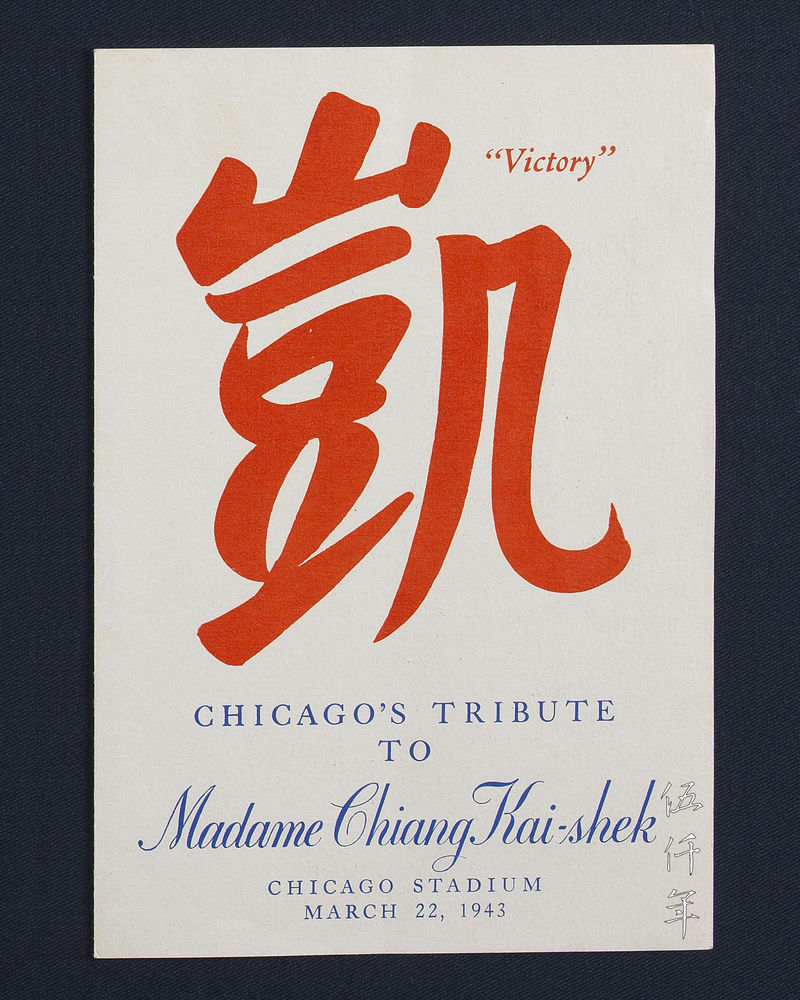
On 22 March 1943, Madame Chiang Kai-shek gave an address at the Chicago Stadium, attended by approximately 23,000. Front cover of the event programme. Photograph courtesy Mr. Roy Delbyck

On 22 March 1943, Madame Chiang Kai-shek gave an address at the Chicago Stadium, attended by approximately 23,000. Inside pages of the event programme. Photograph courtesy Mr. Roy Delbyck
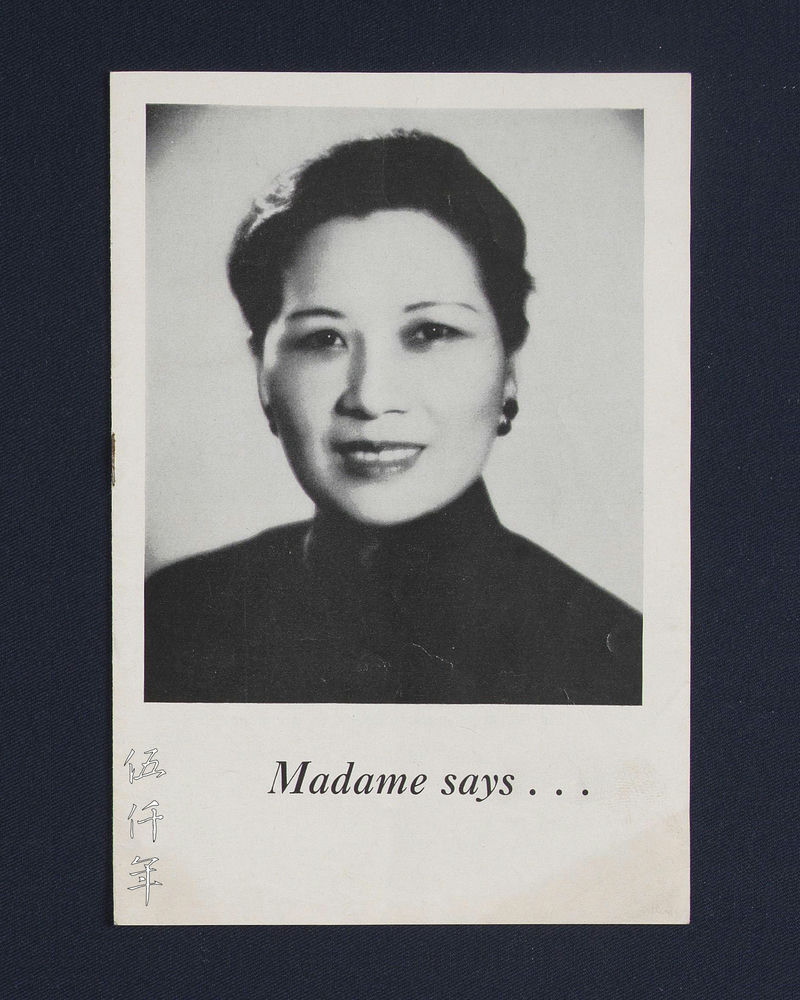
On 22 March 1943, Madame Chiang Kai-shek gave an address at the Chicago Stadium, attended by approximately 23,000. Front cover of the booklet that was distributed at the event, printed with her speech to Congress. Photograph courtesy Mr. Roy Delbyck

On 22 March 1943, Madame Chiang Kai-shek gave an address at the Chicago Stadium, attended by approximately 23,000. Inside pages of the booklet that was distributed at the event, printed with her speech to Congress. Photograph courtesy Mr. Roy Delbyck
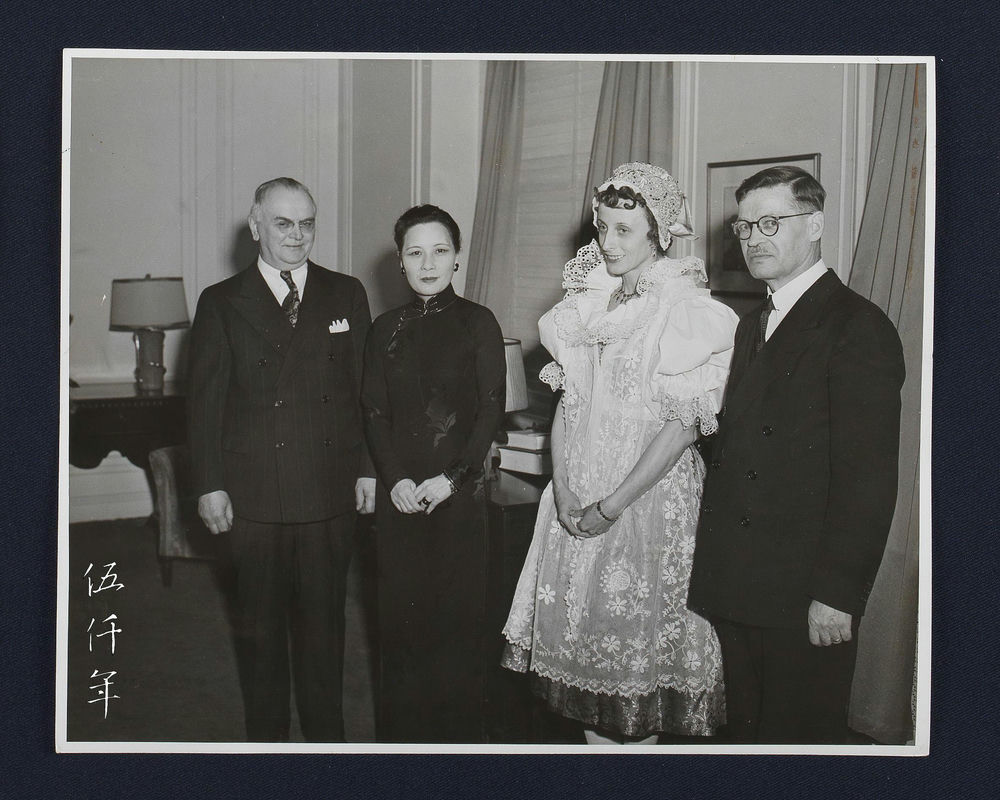
Madame Chiang Kai-shek receiving a few visitors in her suite at Drake Hotel. Photograph courtesy Mr. Roy Delbyck
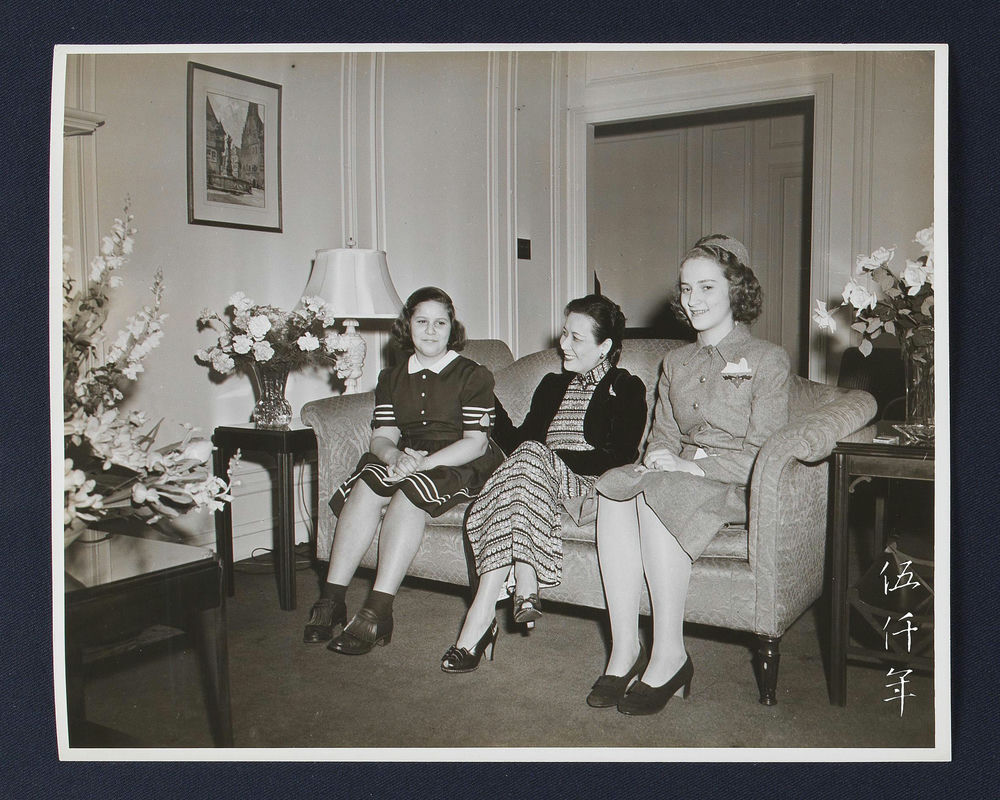
Madame Chiang Kai-shek in the company of two girls in her suite. One conjectures that they are the daughters of Governor Dwight Green. Photograph courtesy Mr. Roy Delbyck
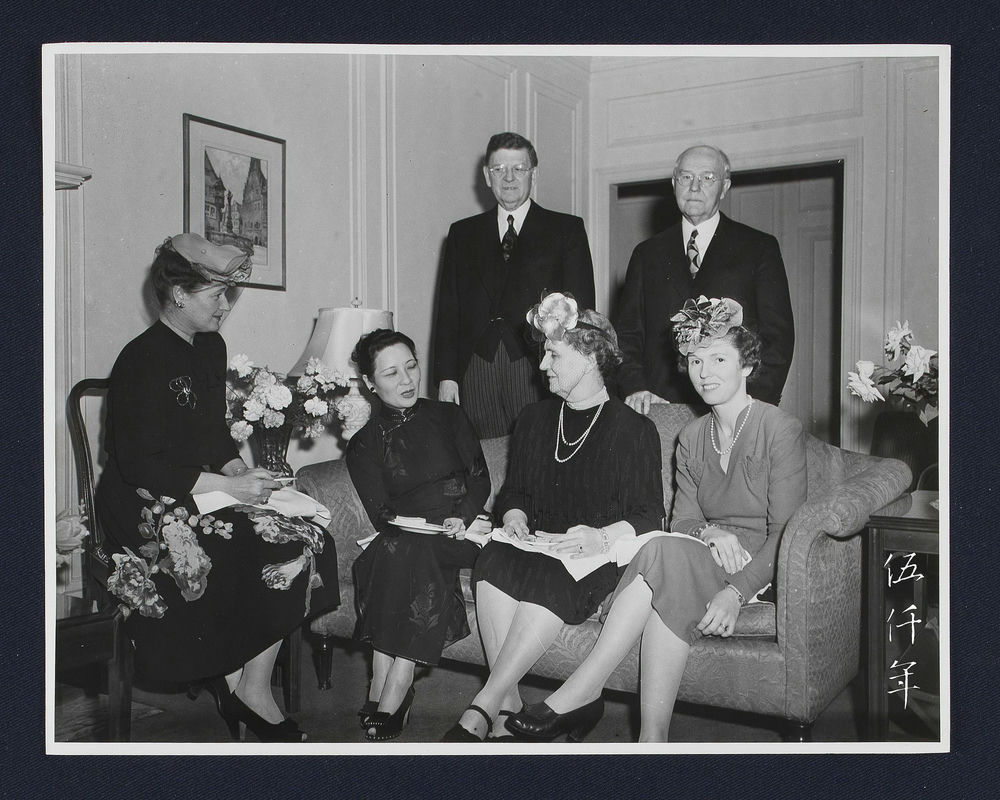
Madame Chiang Kai-shek receiving guests in her suite. On the left is Mayor Edward Kelly, on the right is Silas Strawn, chairman of the citizens welcoming committee. Photograph courtesy Mr. Roy Delbyck
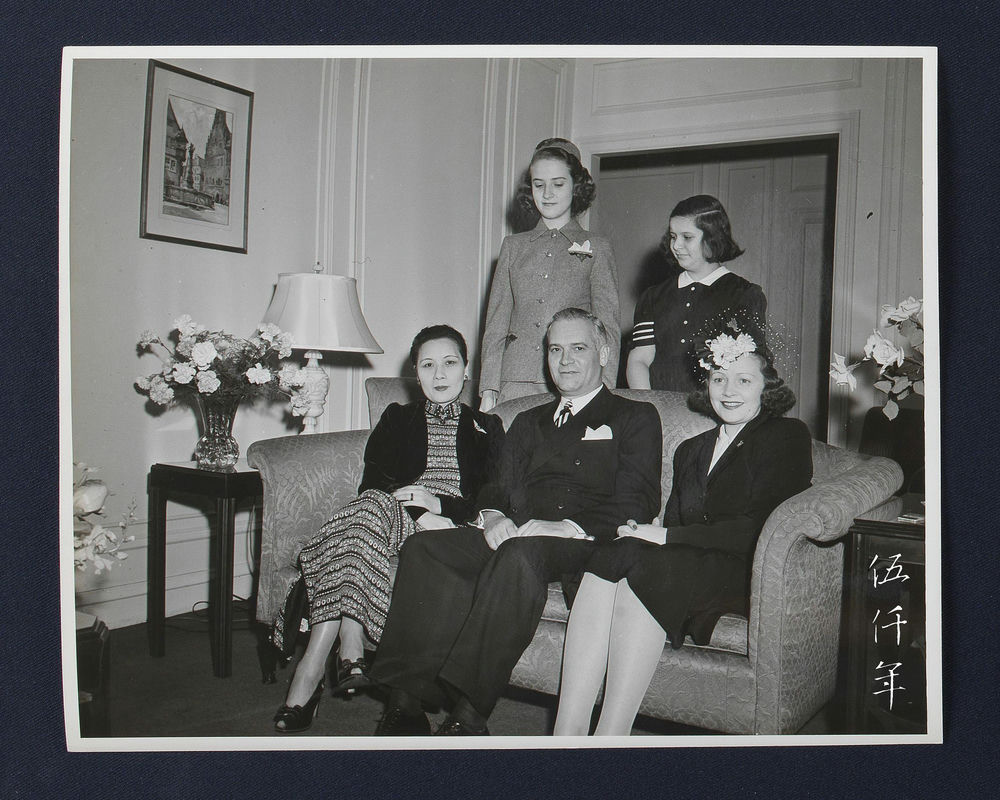
Madame Chiang Kai-shek receiving guests in her suite. In the middle is Governor Dwight Green. Photograph courtesy Mr. Roy Delbyck
San Francisco
Train Station
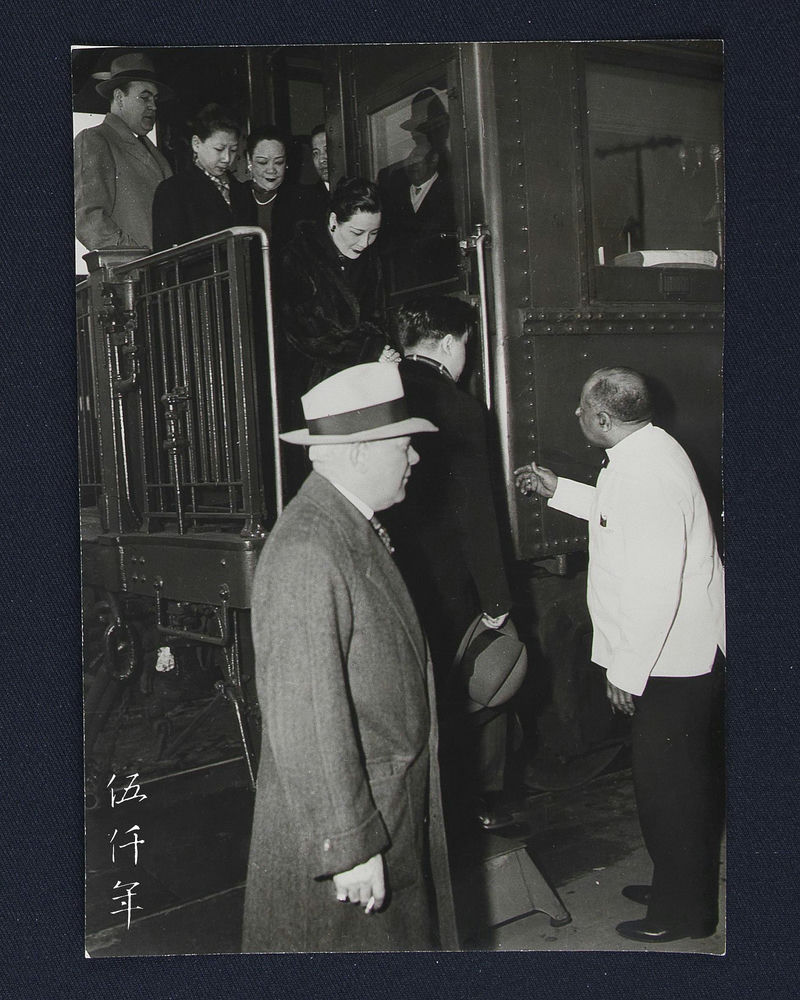
At 9:05 am on 25 March 1943, Madame Chiang Kai-shek reached the station at Oakland from Chicago. Photograph courtesy Mr. Roy Delbyck
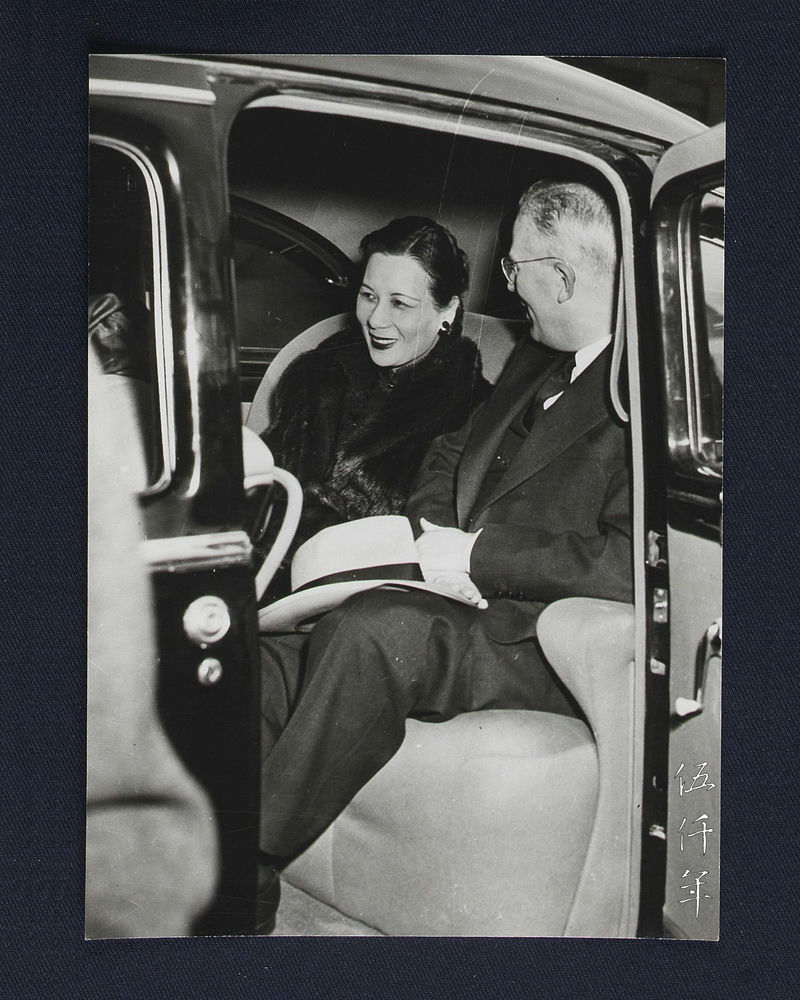
On 25 March 1943, Madame Chiang Kai-shek was greeted at the station by Governor Earl Warren (right). Photograph courtesy Mr. Roy Delbyck
Pier 14
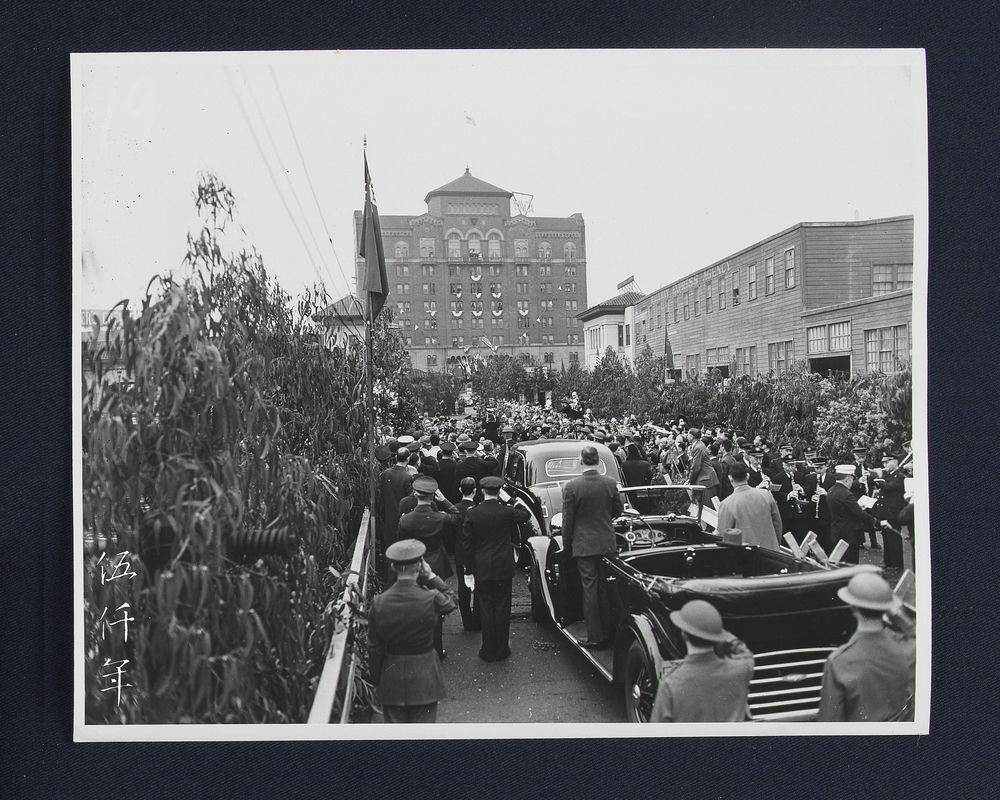
On 25 March 1943, a huge crowd gathered at Pier 14, San Francisco, to welcome Madame Chiang Kai-shek. Photograph courtesy Mr. Roy Delbyck
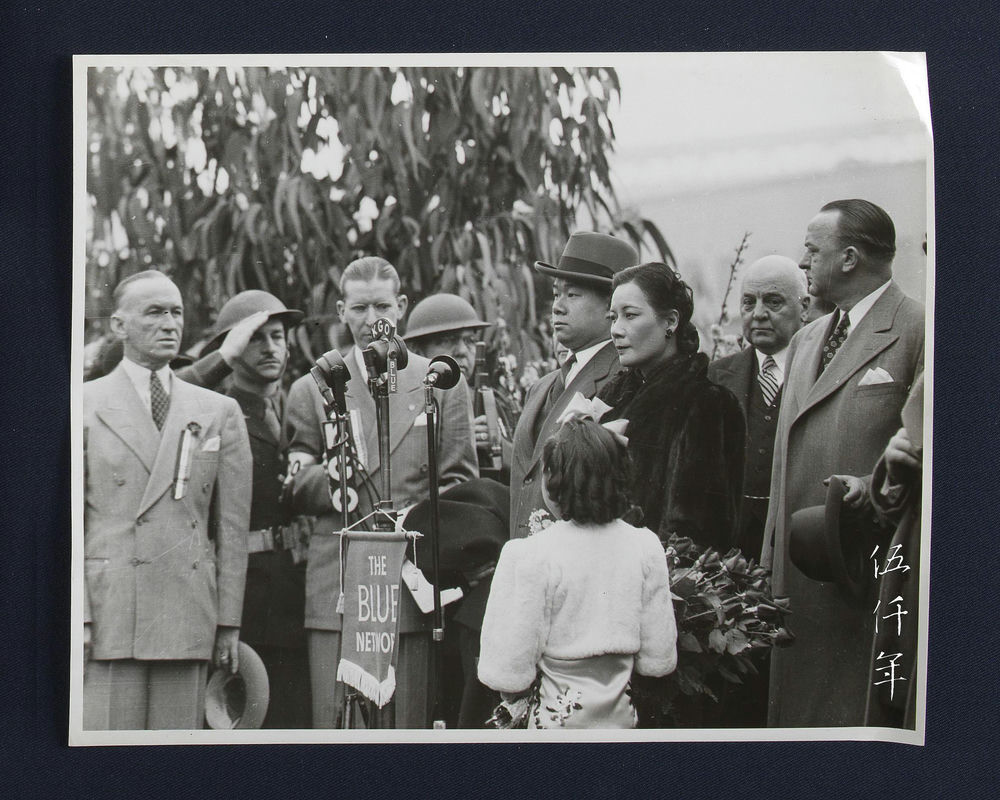
On 25 March 1943, Madame Chiang Kai-shek arrived at Pier 14, San Francisco. Photograph courtesy Mr. Roy Delbyck
Chinatown
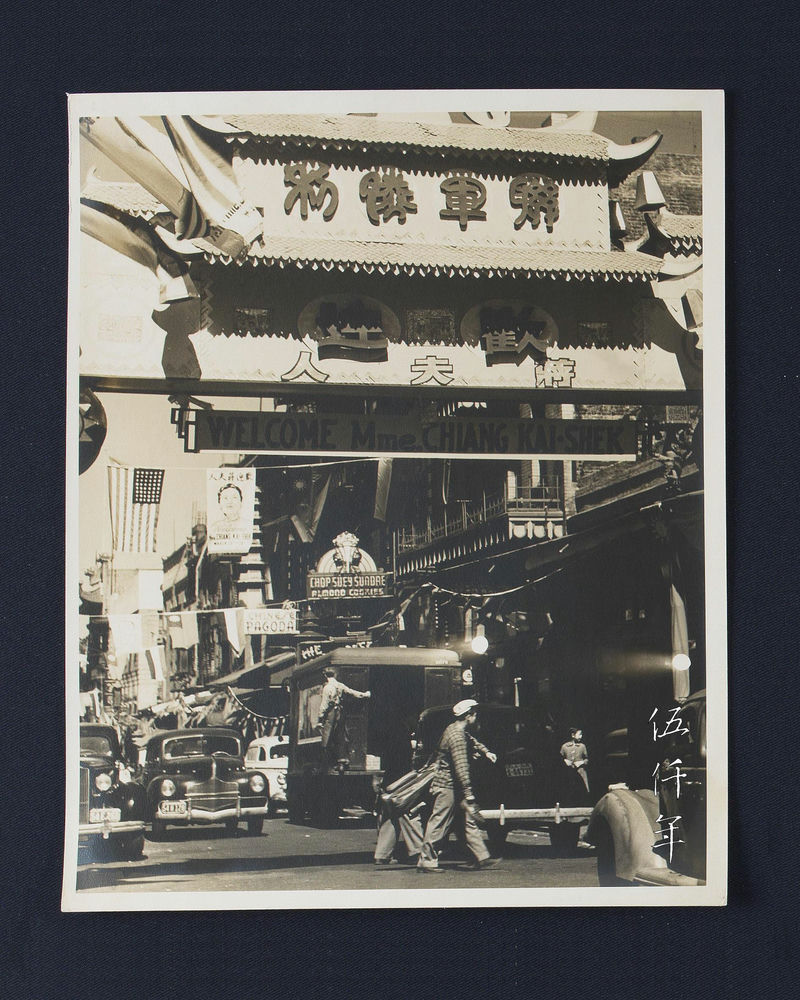
The streets of Chinatown were decorated on 25 March 1943 to welcome Madame Chiang Kai-shek. Photograph courtesy Mr. Roy Delbyck
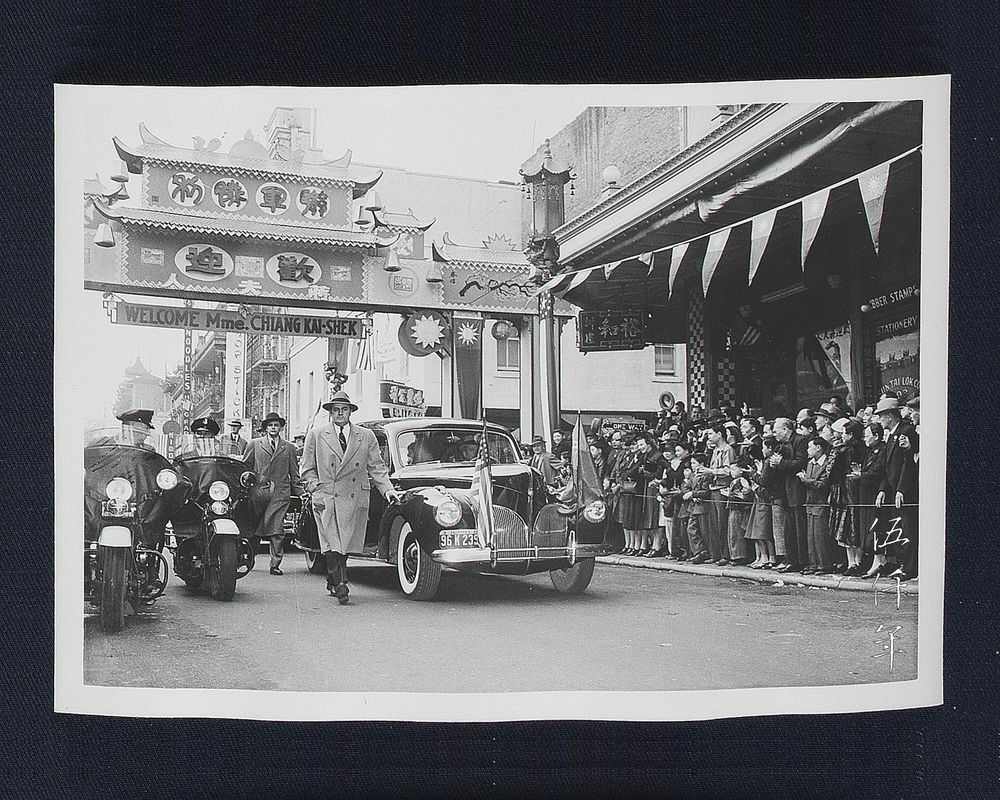
Madame Chiang Kai-shek’s motorcade going through an archway in Chinatown on 25 March 1943. Photograph courtesy Mr. Roy Delbyck
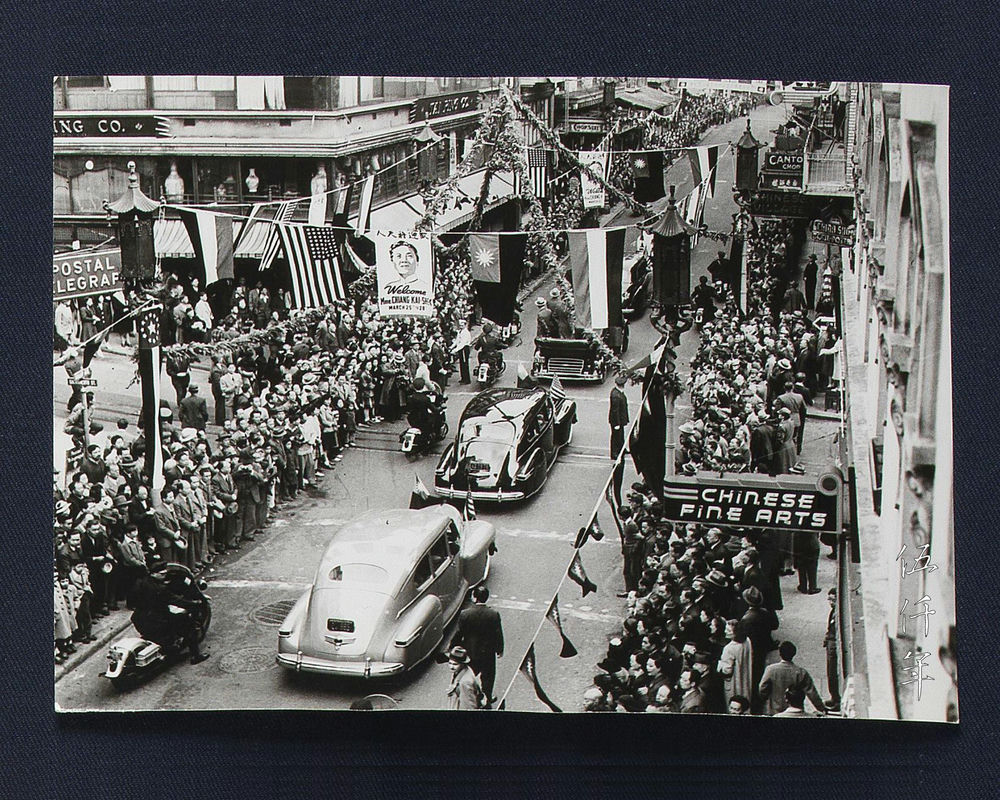
Scene of Madame Chiang Kai-shek’s motorcade moving through Chinatown. Photograph courtesy Mr. Roy Delbyck
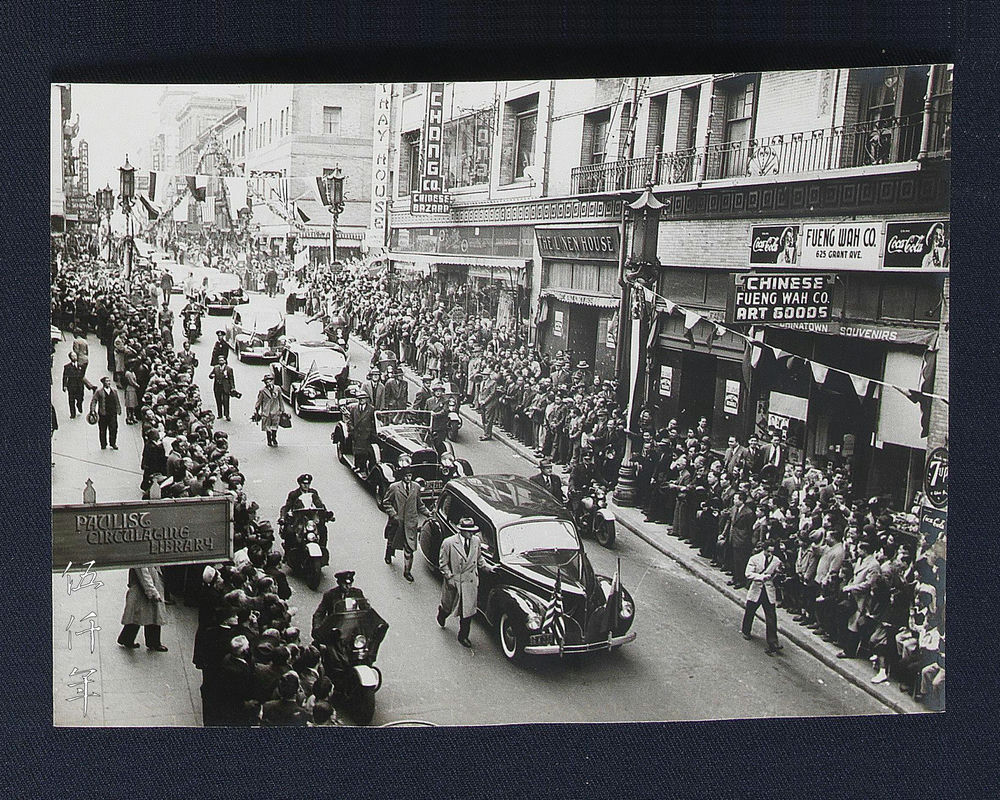
Scene of Madame Chiang Kai-shek’s motorcade moving through Chinatown. Photograph courtesy Mr. Roy Delbyck

Scene of Madame Chiang Kai-shek’s motorcade moving through Chinatown. Photograph courtesy Mr. Roy Delbyck
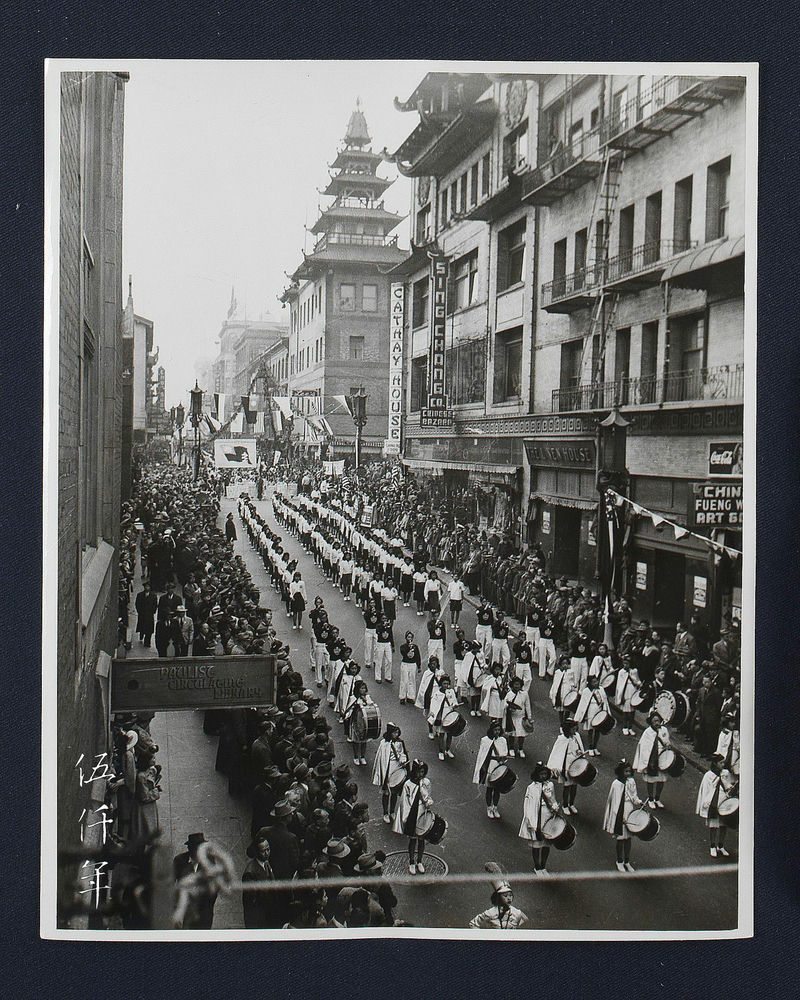
Chinese ladies parade through Chinatown. Photograph courtesy Mr. Roy Delbyck

Welcome party of Chinese children. Photograph courtesy Mr. Roy Delbyck
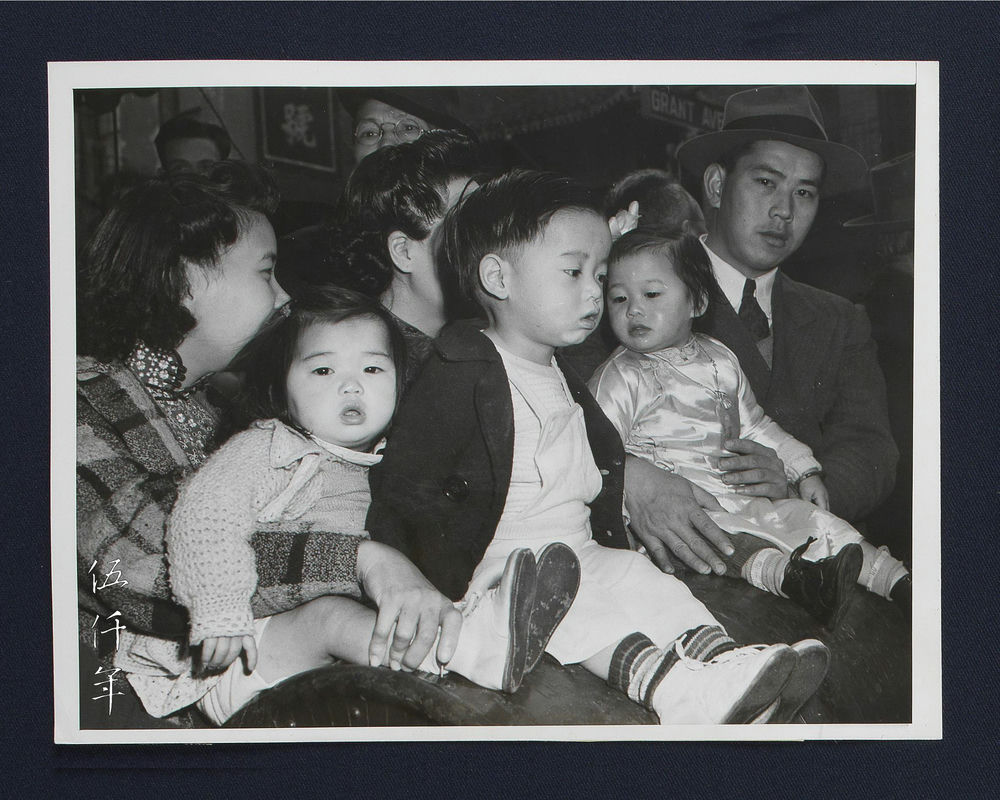
Chinese of all ages wait for Madame Chiang Kai-shek in Chinatown. Photograph courtesy Mr. Roy Delbyck
Parade
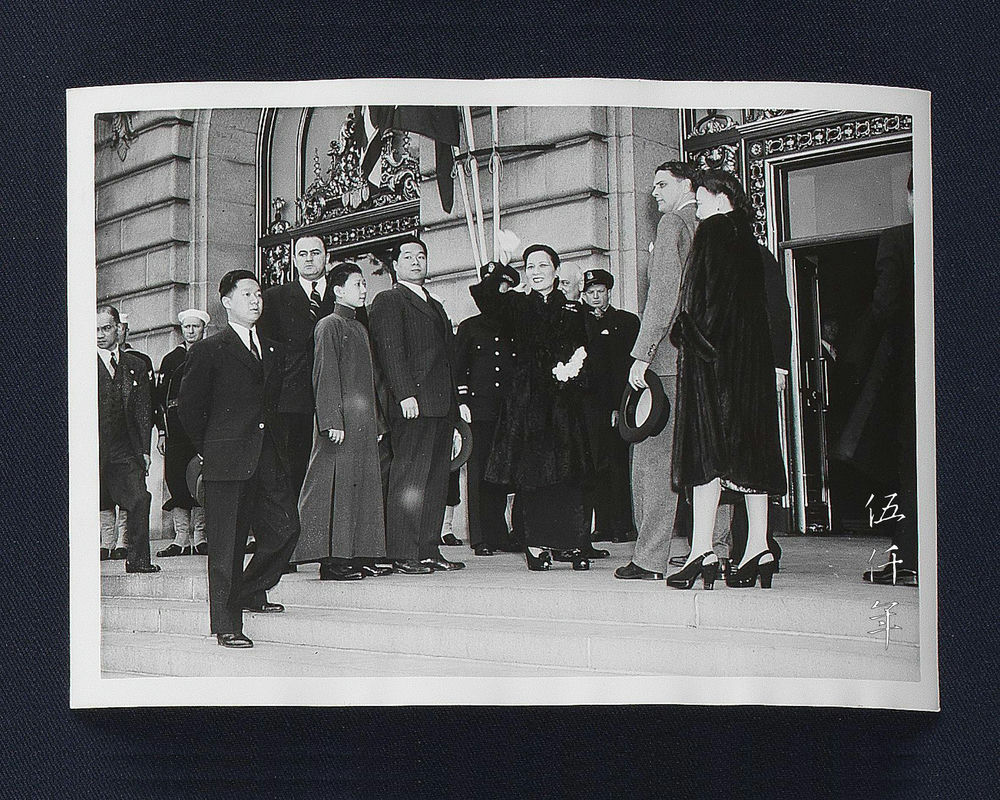
Madame Chiang Kai-shek arriving at the City Hall in San Francisco. Photograph courtesy Mr. Roy Delbyck
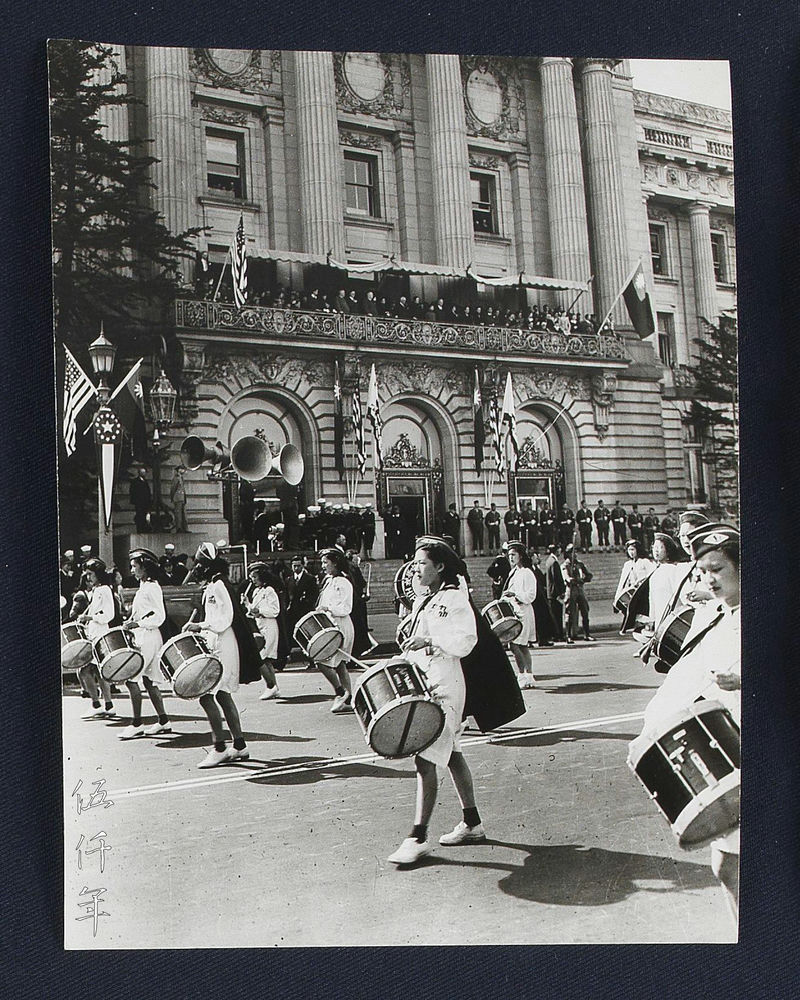
Madame Chiang Kai-shek on the balcony of the City Hall inspecting the Chinese ladies parade. Photograph courtesy Mr. Roy Delbyck

Madame Chiang Kai-shek on the balcony of the City Hall inspecting the parade. Photograph courtesy Mr. Roy Delbyck
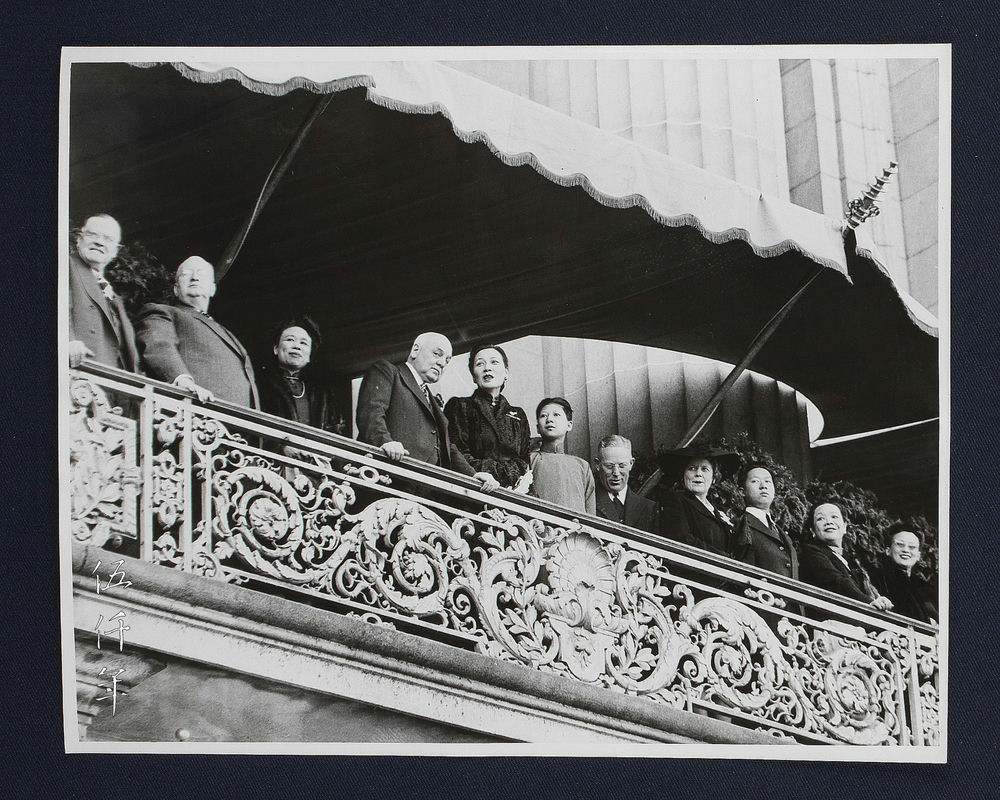
Madame Chiang Kai-shek on the balcony of the City Hall with Mayor Angelo Rossi (left). Photograph courtesy Mr. Roy Delbyck
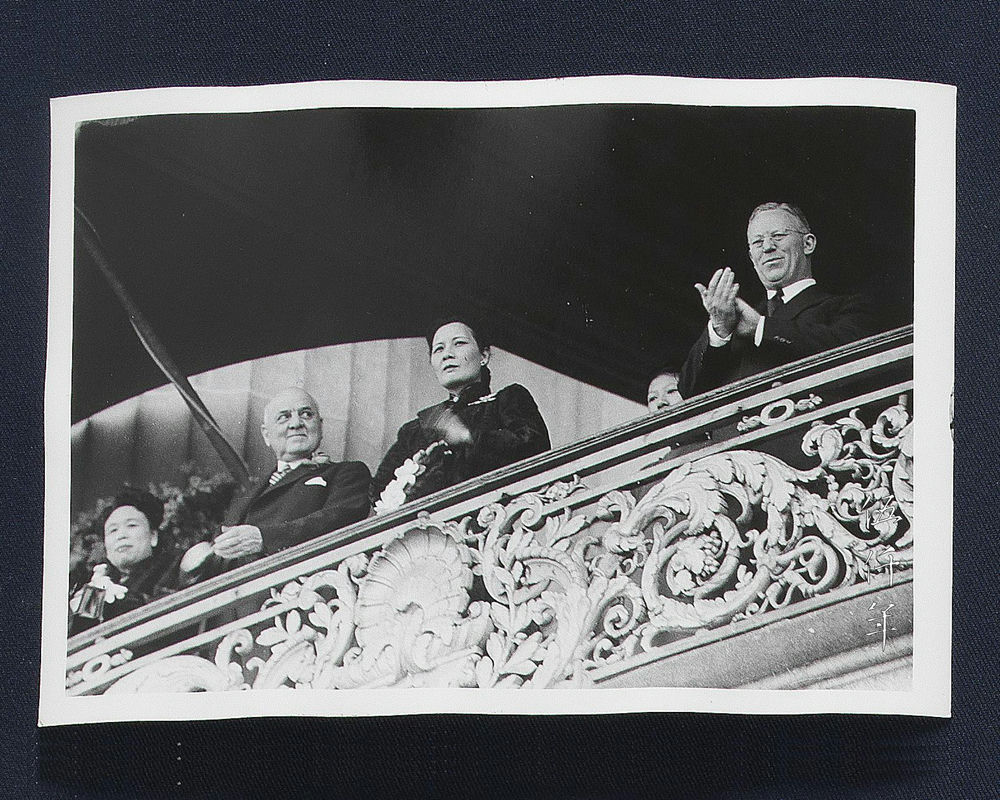
Madame Chiang Kai-shek on the balcony of the City Hall, with Mayor Angelo Rossi on the left and Governor Earl Warren on the right. Photograph courtesy Mr. Roy Delbyck

View from the balcony of the City Hall. Photograph courtesy Mr. Roy Delbyck

Chinese ladies’ parade marching past the City Hall. Photograph courtesy Mr. Roy Delbyck
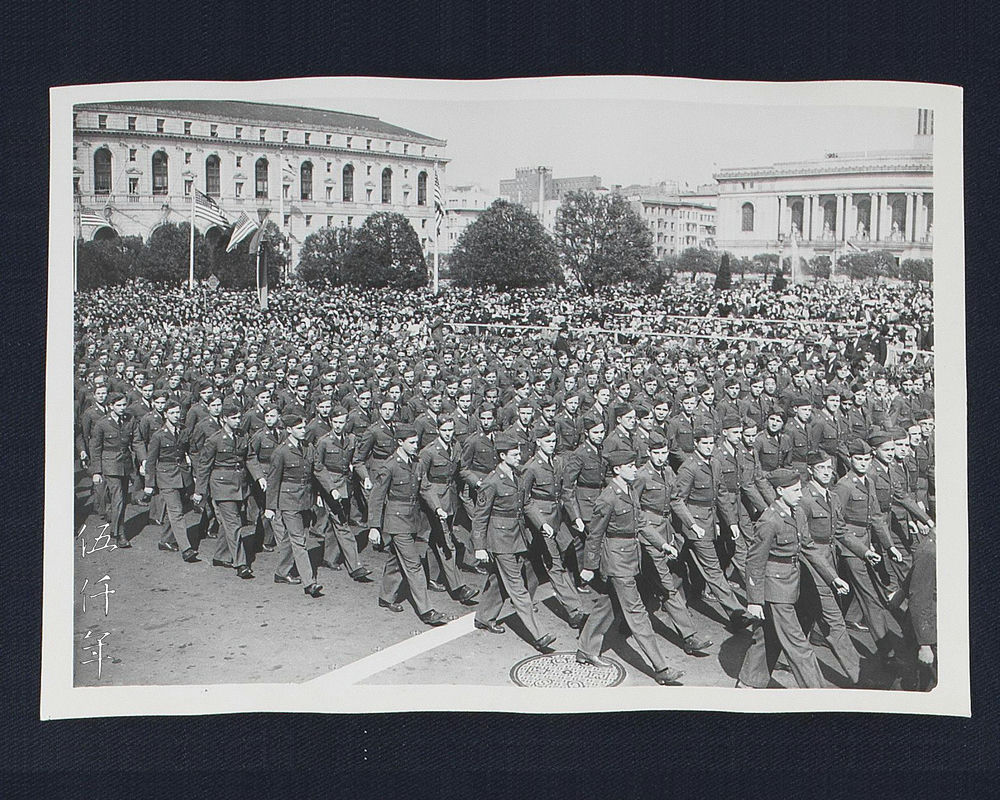
Reserve Officers Training Corps marching past the City Hall. Photograph courtesy Mr. Roy Delbyck

United States Army marching past the City Hall. Photograph courtesy Mr. Roy Delbyck
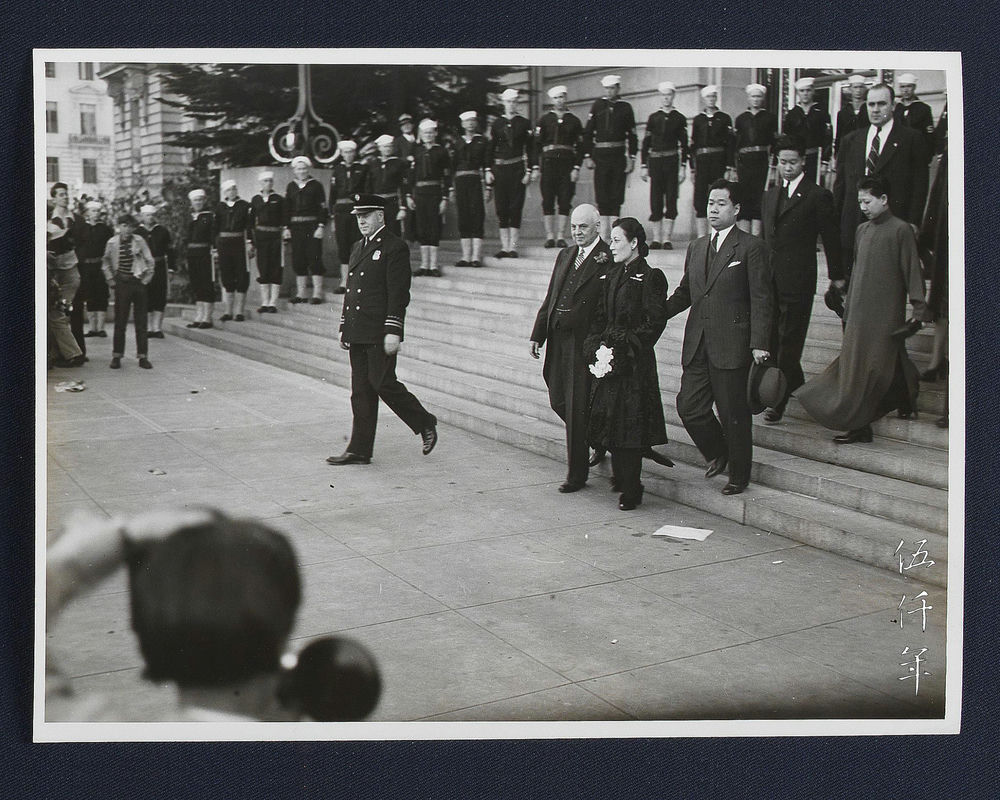
Madame Chiang Kai-shek leaving the City Hall. Photograph courtesy Mr. Roy Delbyck
Press
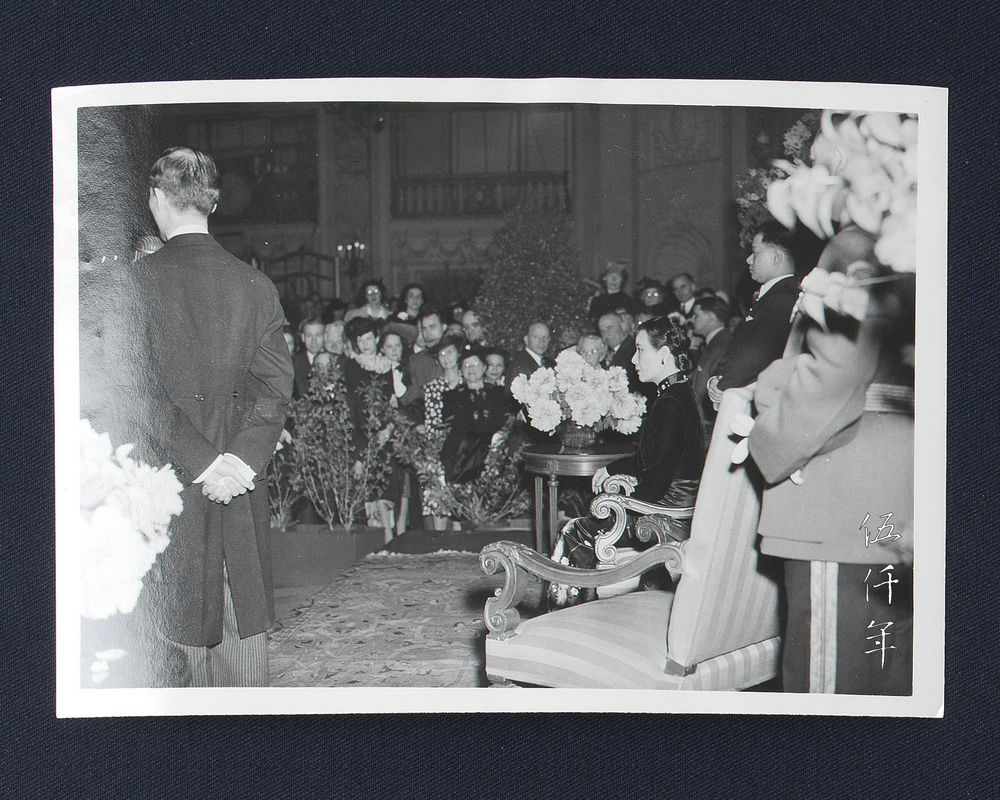
Madame Chiang Kai-shek seated to receive representatives of the press in the Tapestry Room of the Palace Hotel in the afternoon of 26 March 1943. Photograph courtesy Mr. Roy Delbyck

Madame Chiang Kai-shek stood to receive representatives of the press in the Tapestry Room of the Palace Hotel in the afternoon of 26 March 1943. Photograph courtesy Mr. Roy Delbyck
Banquet
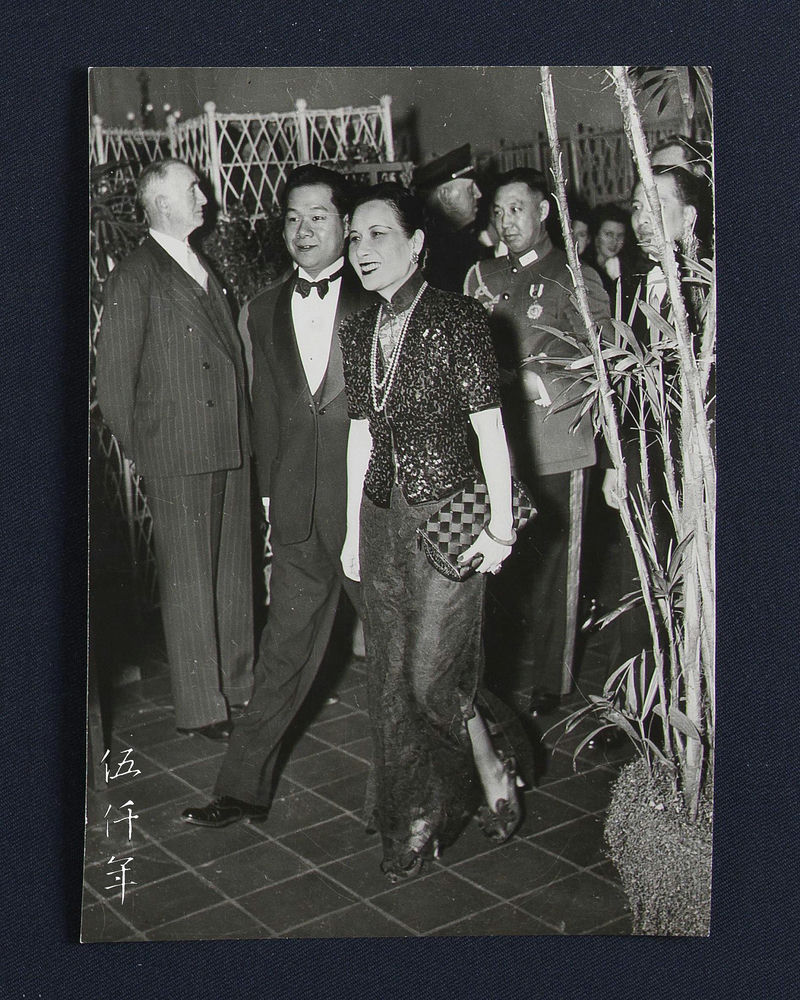
Madame Chiang Kai-shek arriving at the banquet In the evening of 26 March 1943, hosted by the City and the San Francisco Chamber of Commerce at the Palace Hotel. Photograph courtesy Mr. Roy Delbyck
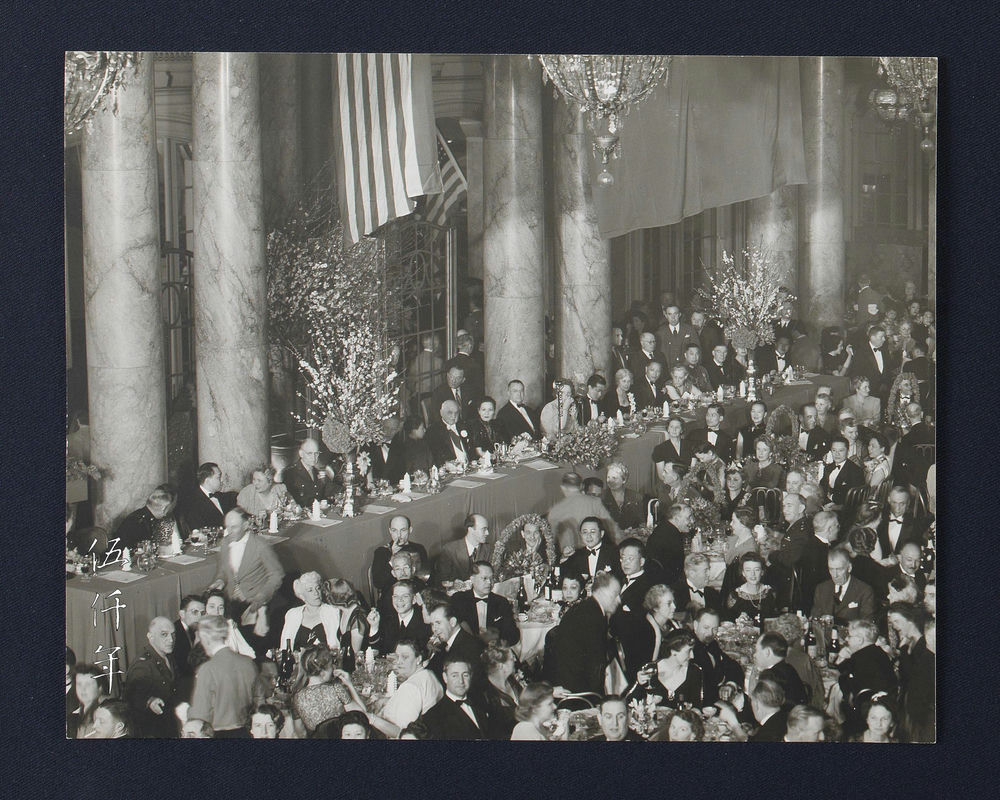
Banquet scene in the evening of 26 March 1943. Photograph courtesy Mr. Roy Delbyck
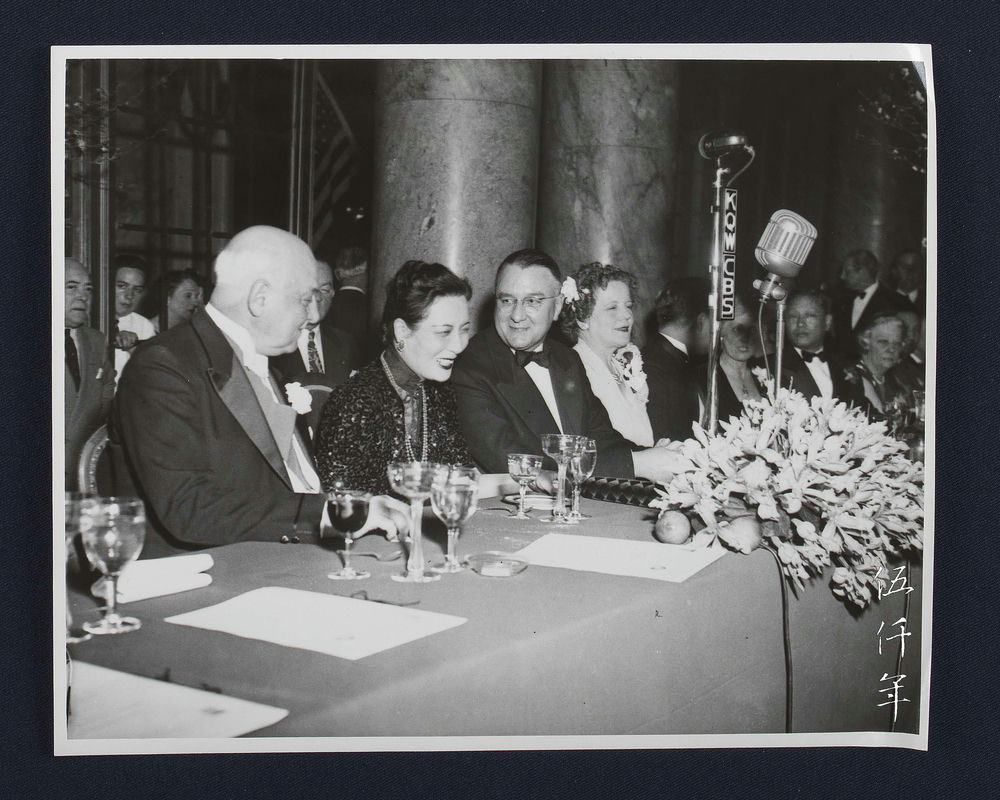
Madame Chiang Kai-shek at the banquet in the evening of 26 March 1943, Mayor Rossi seated on her left. Photograph courtesy Mr. Roy Delbyck
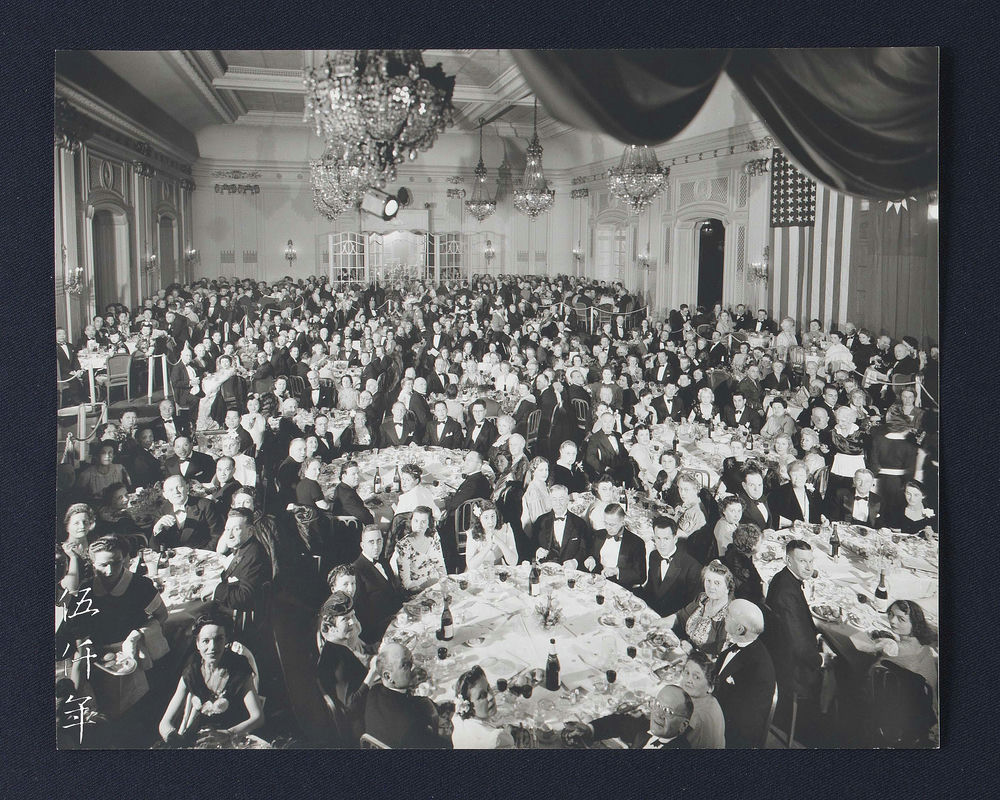
Banquet scene in the evening of 26 March 1943. Photograph courtesy Mr. Roy Delbyck
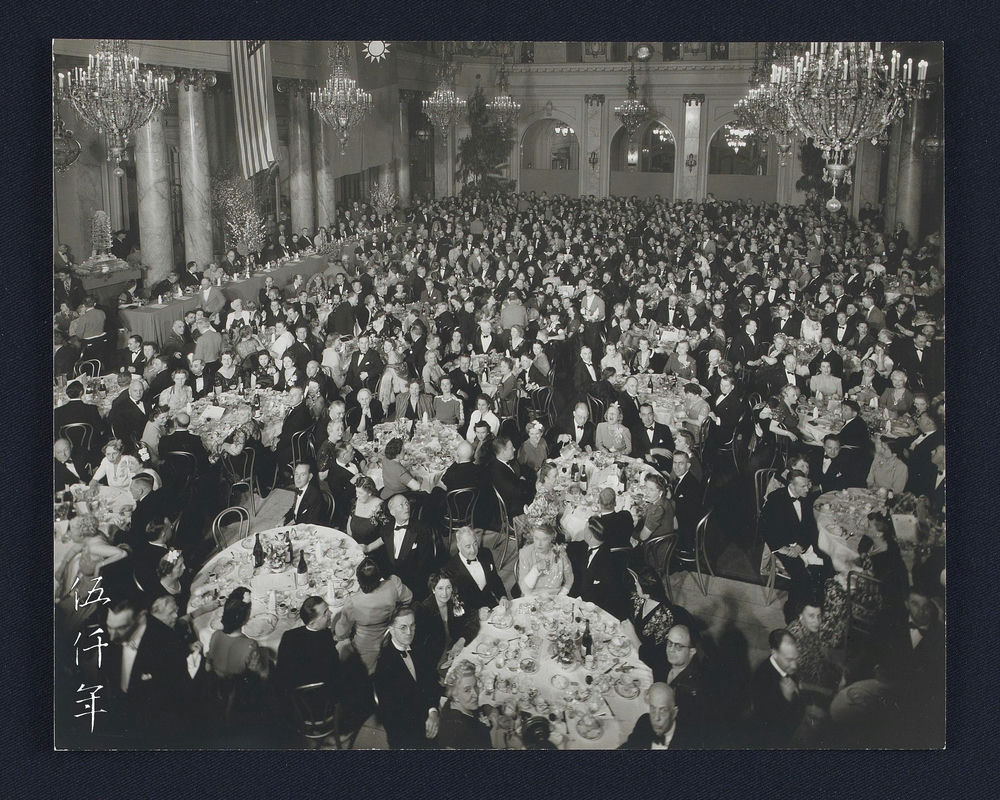
Banquet scene in the evening of 26 March 1943. Photograph courtesy Mr. Roy Delbyck
Dr. Sun Yat-sen

In early afternoon on 28 March 1943, a huge crowd waited for Madame Chiang Kai-shek in the Sun Yat-sen Park near the statue of Dr. Sun Yat-Sen, founder of the Republic of China. Photograph courtesy Mr. Roy Delbyck

In early afternoon on 28 March 1943, Madame Chiang Kai-shek arrived at the statue of Dr. Sun Yat-sen in the Sun Yat-sen Park. Photograph courtesy Mr. Roy Delbyck

In early afternoon on 28 March 1943, Madame Chiang Kai-shek and her party placed a wreath at the statue and paid their respects. Photograph courtesy Mr. Roy Delbyck
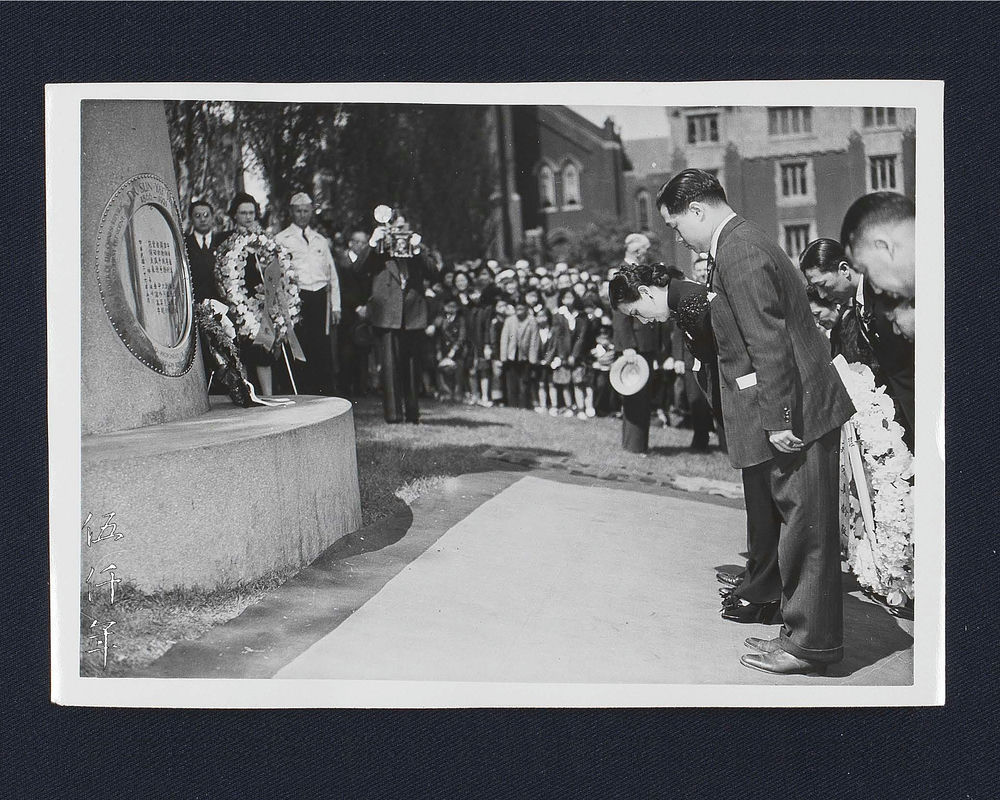
In early afternoon on 28 March 1943, Madame Chiang Kai-shek and her party placed a wreath at the statue and paid their respects. Photograph courtesy Mr. Roy Delbyck
Labour Leaders
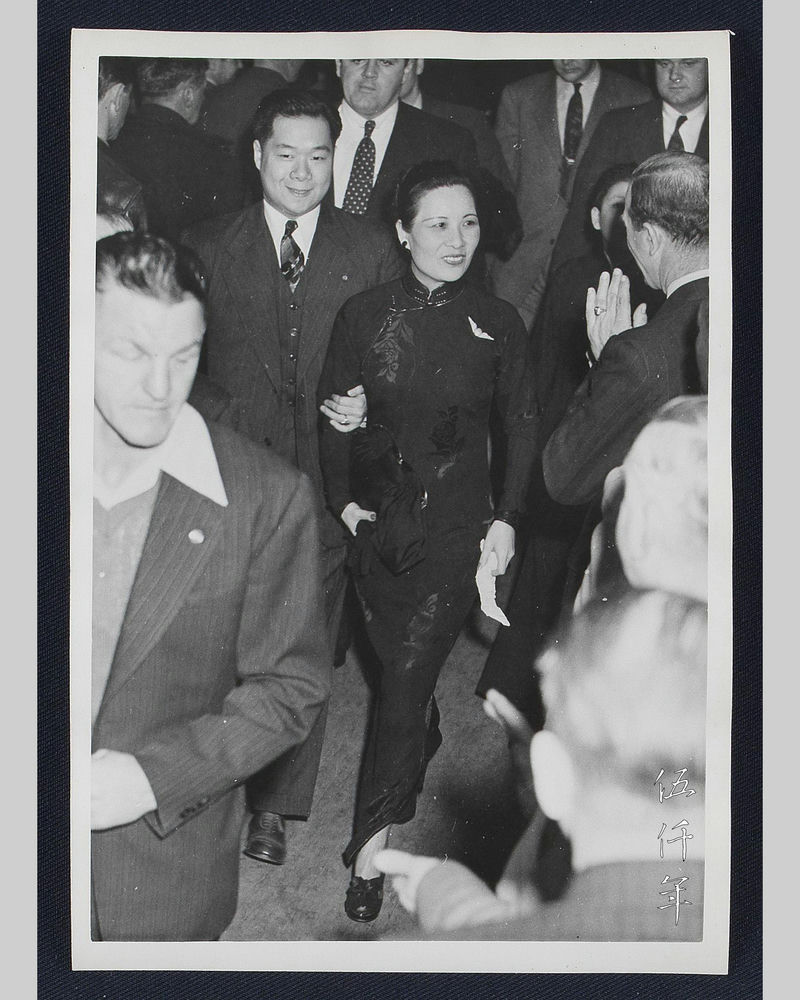
At 4 pm on 29 March 1943, Madame Chiang Kai-shek arrived at the headquarters of the Congress of Industrial Organizations to speak before the labour leaders. Photograph courtesy Mr. Roy Delbyck
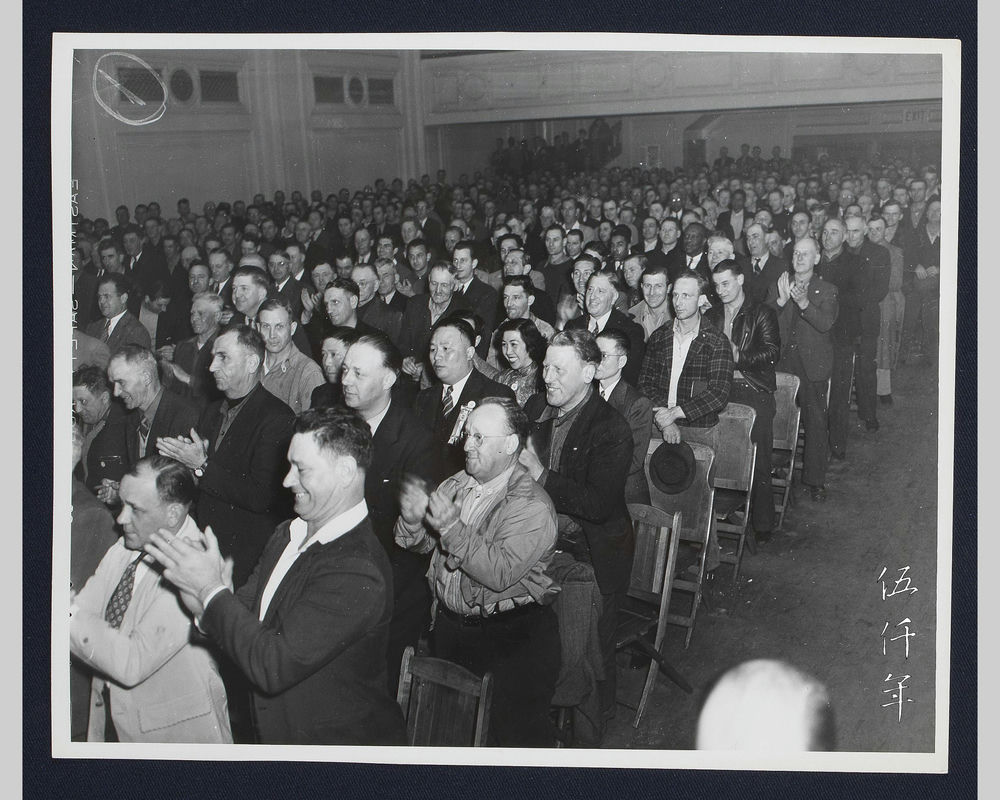
At 4 pm on 29 March 1943, Madame Chiang Kai-shek addressed the labour leaders. View of the audience during her speech. Photograph courtesy Mr. Roy Delbyck
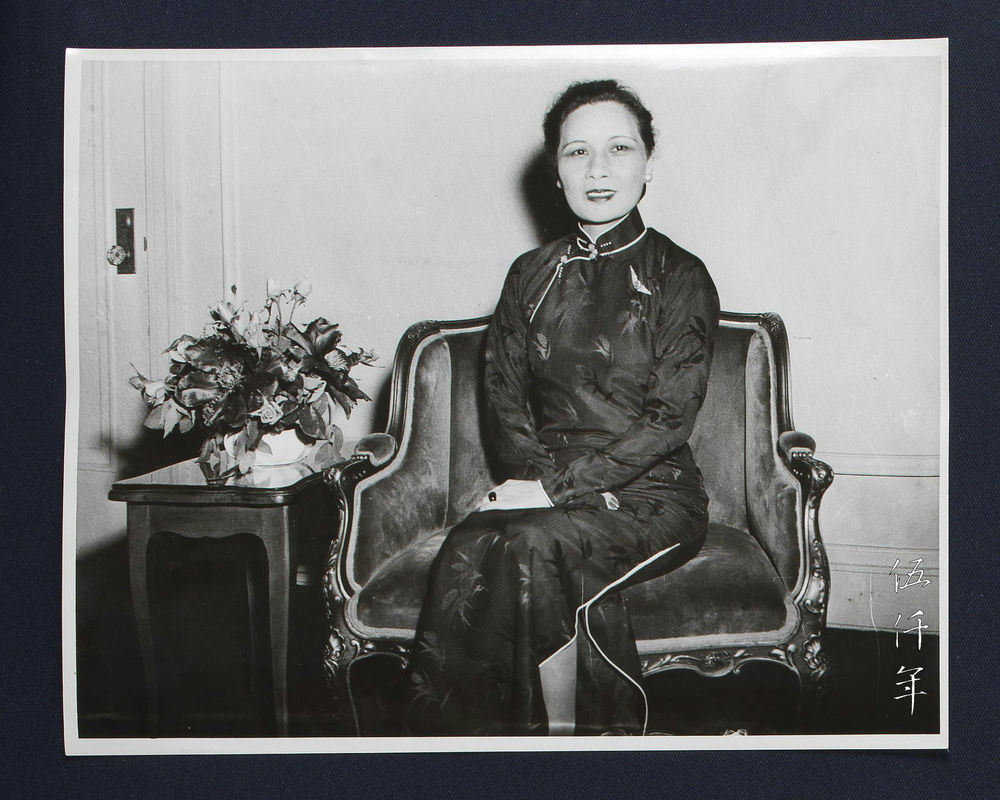
Portrait of Madame Chiang Kai-shek taken before her address to the labour leaders. Photograph courtesy Mr. Roy Delbyck
Los Angeles
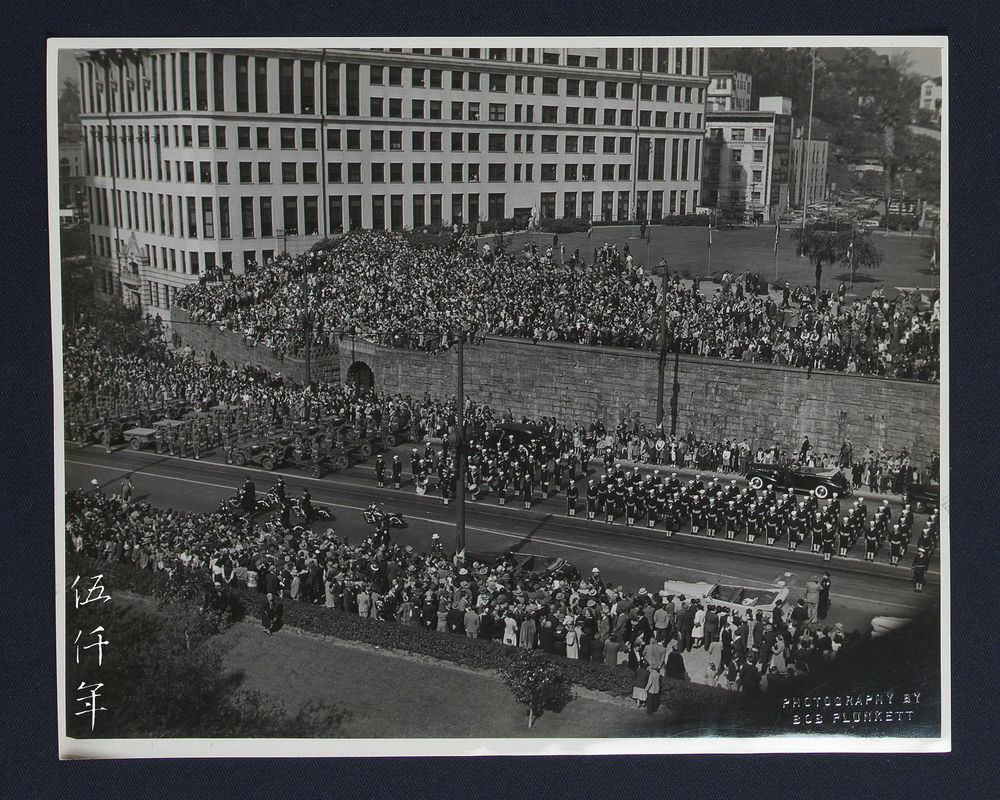
Citizens of Los Angeles lined the streets to welcome Madame Chiang Kai-shek who arrived from San Francisco on 31 March 1943. Photograph courtesy Mr. Roy Delbyck

Citizens of Los Angeles lined the streets to welcome Madame Chiang Kai-shek who arrived from San Francisco on 31 March 1943. Photograph courtesy Mr. Roy Delbyck

The motorcade of Madame Chiang Kai-shek moving through the streets on 31 March 1943. Photograph courtesy Mr. Roy Delbyck

Military parade to welcome Madame Chiang Kai-shek to Los Angeles on 31 March 1943. Photograph courtesy Mr. Roy Delbyck

Military parade to welcome Madame Chiang Kai-shek to Los Angeles on 31 March 1943. Photograph courtesy Mr. Roy Delbyck

Madame Chiang Kai-shek arriving at City Hall to attend the welcome ceremony on 31 March 1943. On her right is Mayor Fletcher Bowron. Photograph courtesy Mr. Roy Delbyck
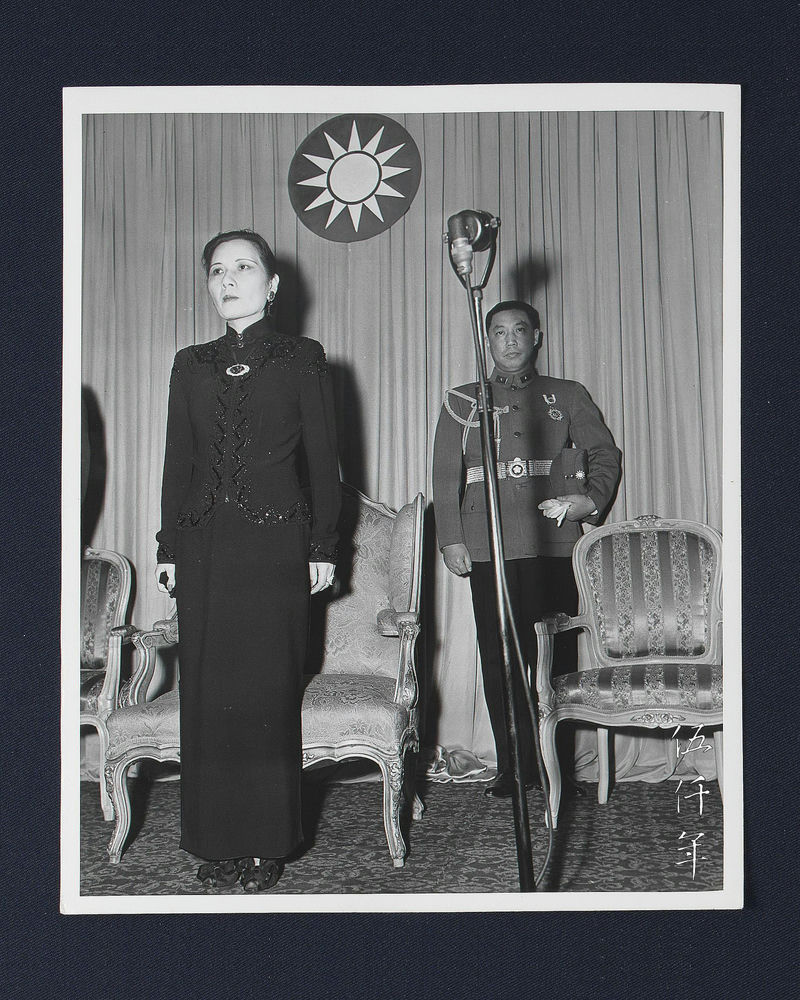
Madame Chiang Kai-shek received representatives of the press at the Ambassador Hotel in the evening of 31 March 1943, the National Anthem of the Republic of China was sung. Photograph courtesy Mr. Roy Delbyck
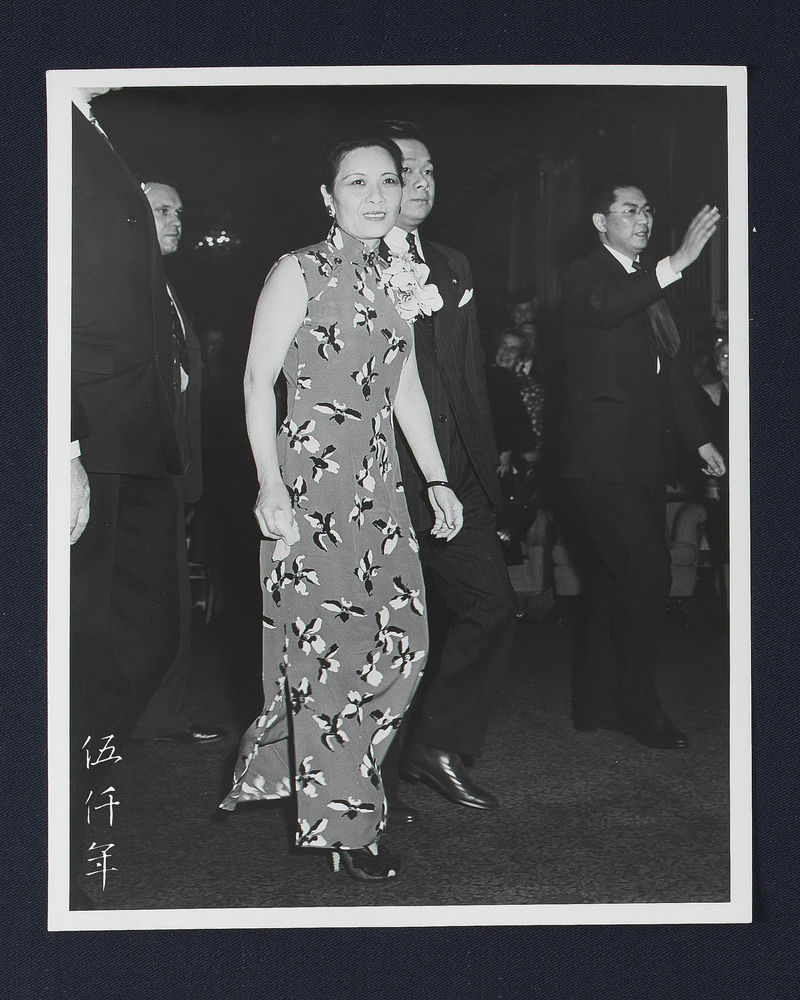
Madame Chiang Kai-shek leaving the reception venue for motion picture stars on 1 April 1943. Photograph courtesy Mr. Roy Delbyck

Madame Chiang Kai-shek and visitors at the Ambassador Hotel, with Ambassador Wellington Koo Vi Kyuin (first right in front row) and Madame Wei Tao-ming (second right in front row). Photograph courtesy Mr. Roy Delbyck

Official banquet to welcome Madame Chiang Kai-shek in the evening of 2 April 1943. Photograph courtesy Mr. Roy Delbyck
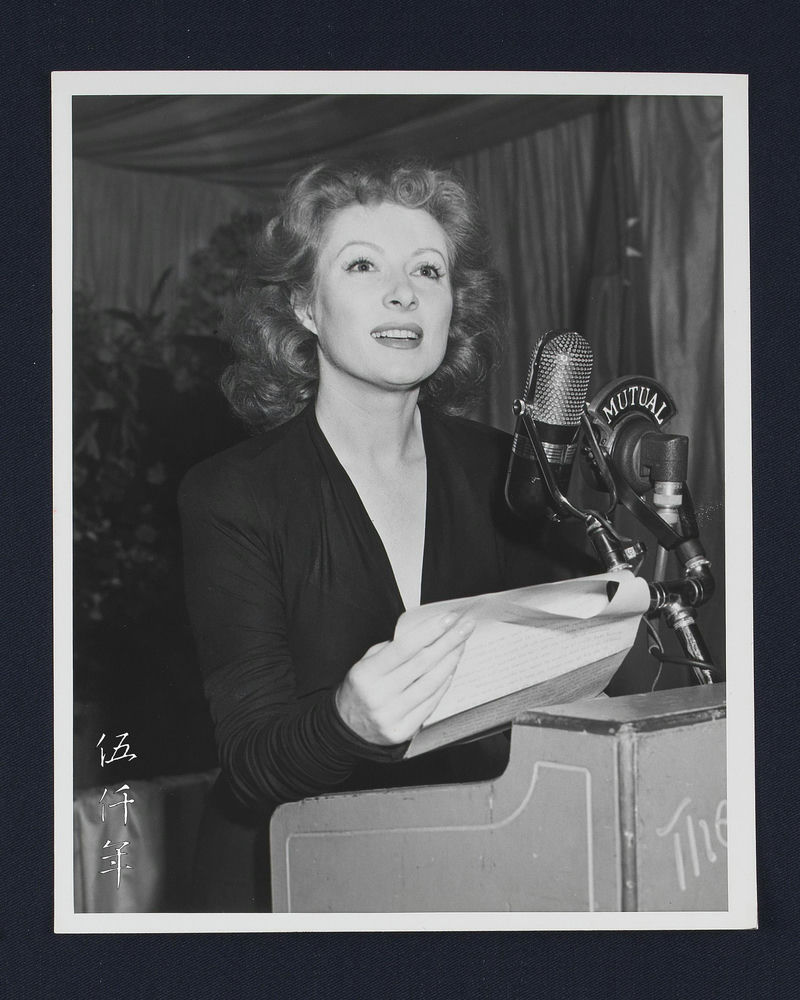
Motion picture star Greer Garson speaking at the official banquet to welcome Madame Chiang Kai-shek in the evening of 2 April 1943. Photograph courtesy Mr. Roy Delbyck

Madame Chiang Kai-shek in car on 4 April 1943. Photograph courtesy Mr. Roy Delbyck

View of Hollywood Bowl from afar during the address by Madame Chiang Kai-shek on 4 April 1943
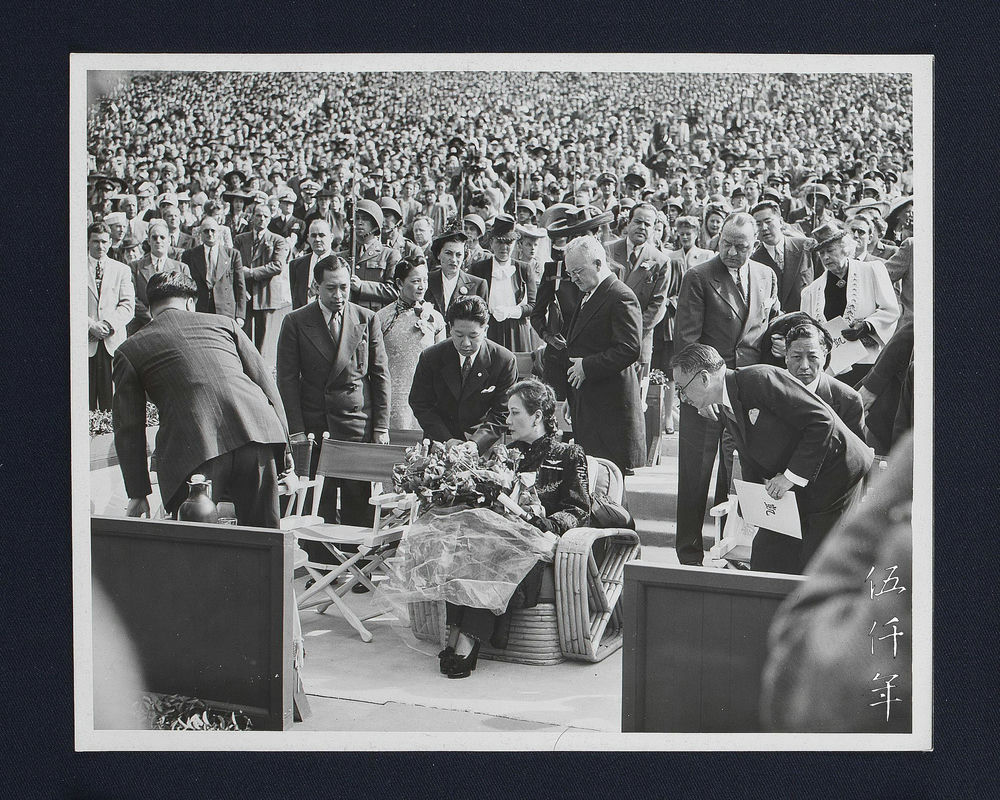
Madame Chiang Kai-shek at Hollywood Bowl before her address on 4 April 1943. Photograph courtesy Mr. Roy Delbyck
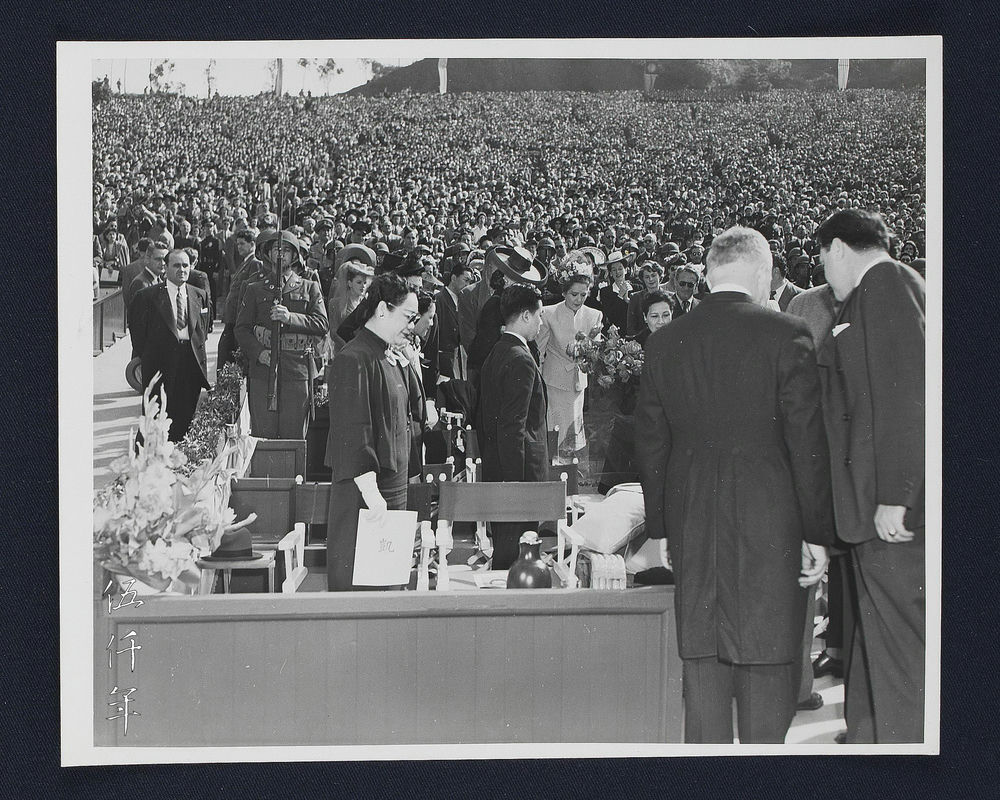
View of audience before Madame Chiang Kai-shek’s address at Hollywood Bowl on 4 April 1943. Photograph courtesy Mr. Roy Delbyck

Madame Chiang Kai-shek at Hollywood Bowl before her address on 4 April 1943. Photograph courtesy Mr. Roy Delbyck
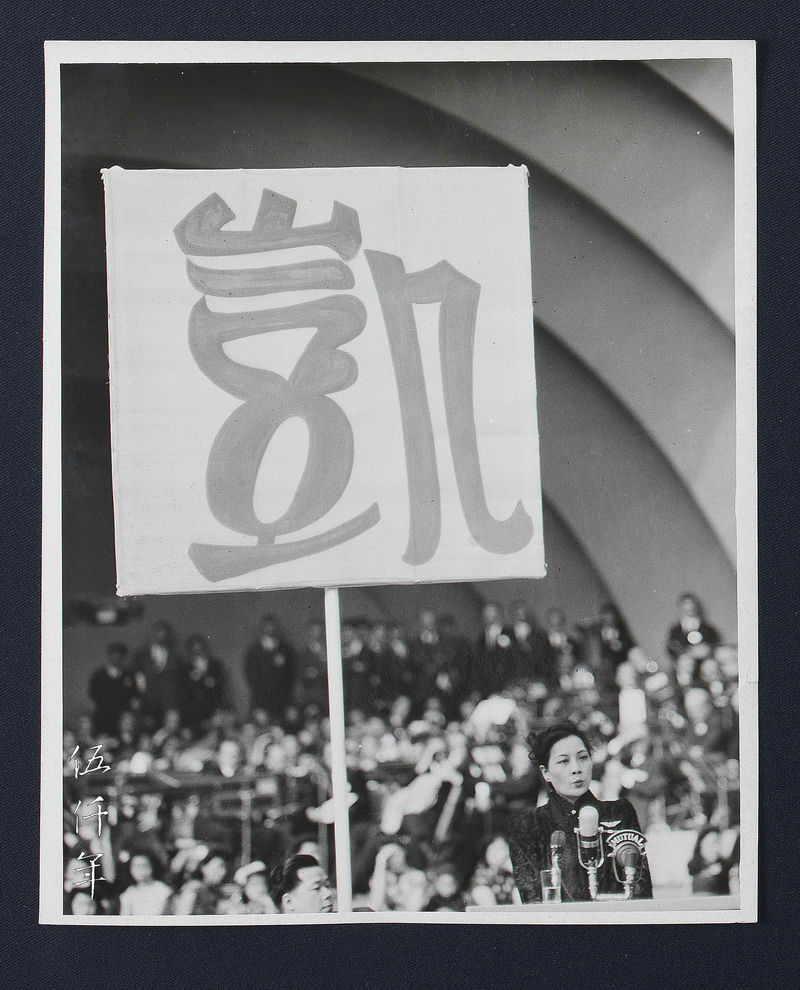
Madame Chiang Kai-shek speaking at Hollywood Bowl with the Chinese character of victory next to her on 4 April 1943. Photograph courtesy Mr. Roy Delbyck
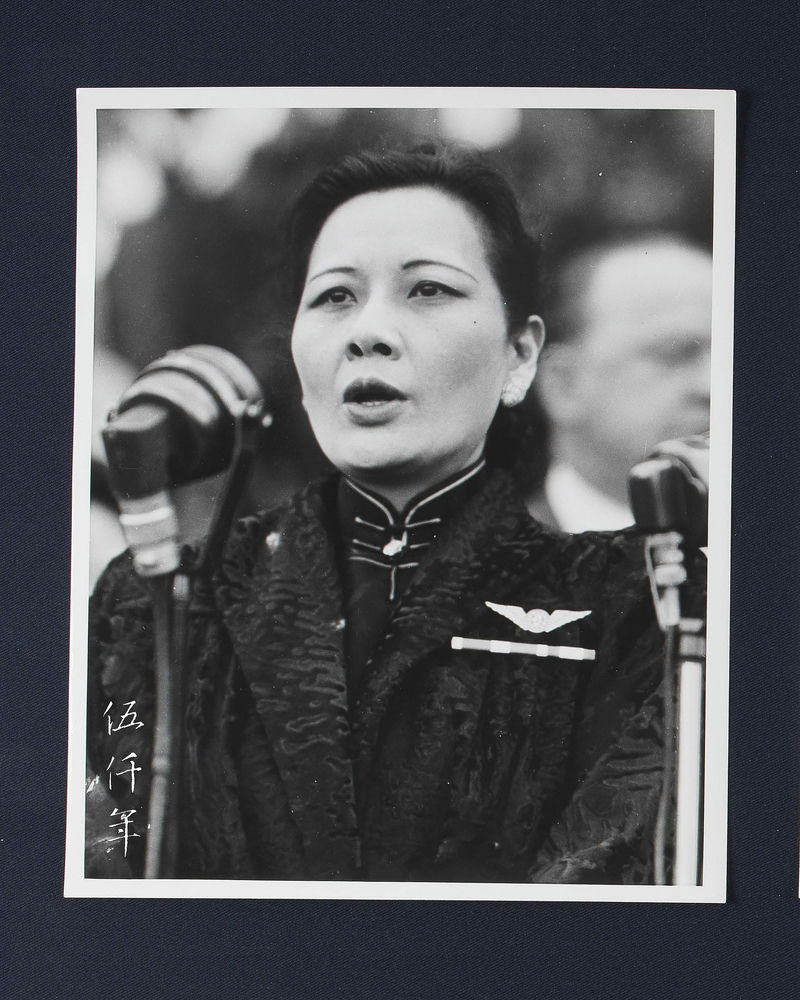
Madame Chiang Kai-shek speaking at Hollywood Bowl on 4 April 1943. Photograph courtesy Mr. Roy Delbyck

Due to exhaustion after the address on 4 April 1943, Madame Chiang Kai-shek asked Ambassador Wellington Koo Vi Kyuin to speak on her behalf at the aircraft factory, explaining the urgency of China’s aviation needs. Photograph courtesy Mr. Roy Delbyck
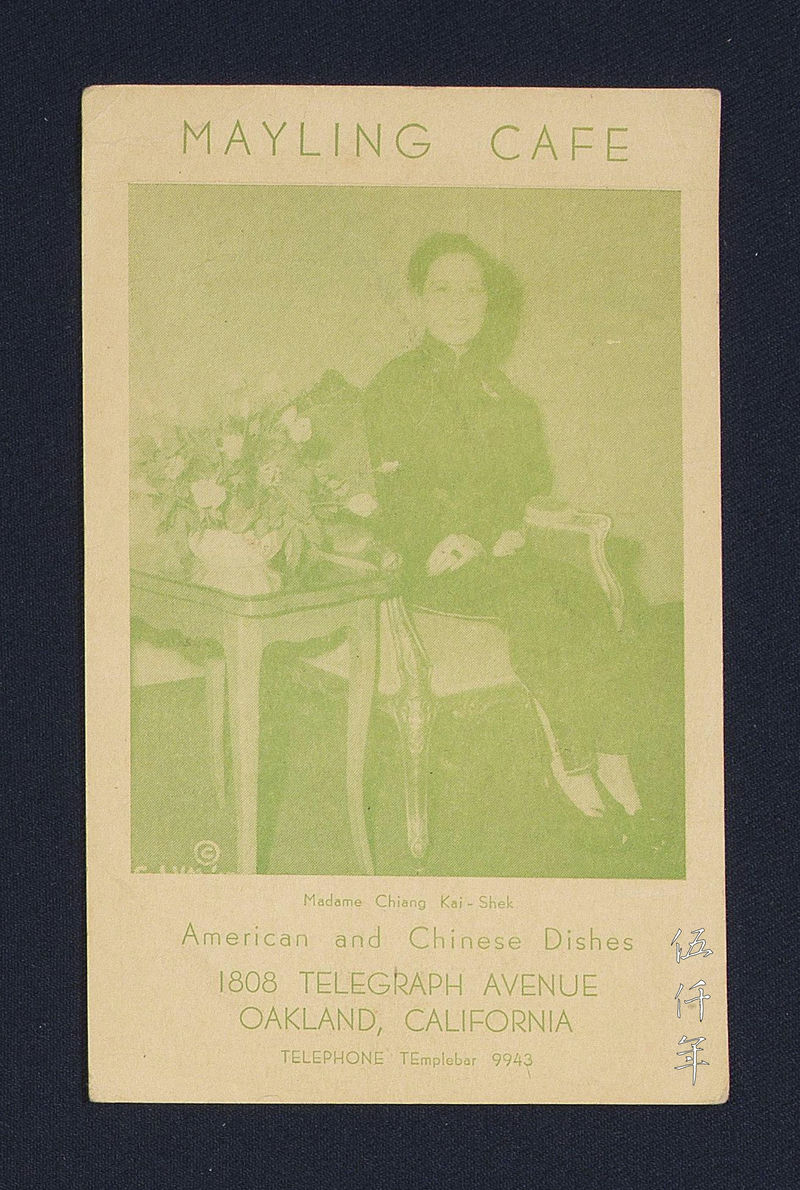
Madame Chiang Kai-shek’s United States tour was a resounding success, even an ordinary restaurant in Oakland, California, identified commercial advantage by changing the name to Mayling Cafe.
Aid China

A copy of Laws, Treaty and Regulations Relating to the Exclusion of Chinese from the United States, published by the Department of Commerce and Labor in July 1903. Photograph courtesy Mr. Roy Delbyck
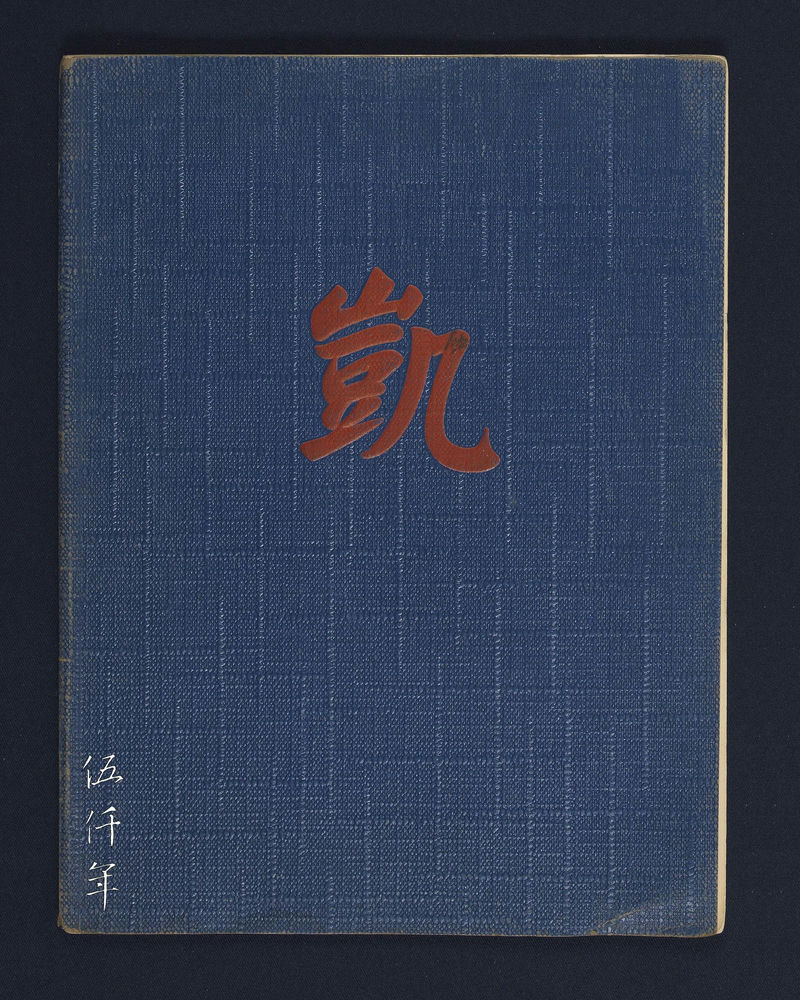
Front cover of book printed with the Chinese character k’ai, meaning victory, published by the United China Relief. Photograph courtesy Mr. Roy Delbyck
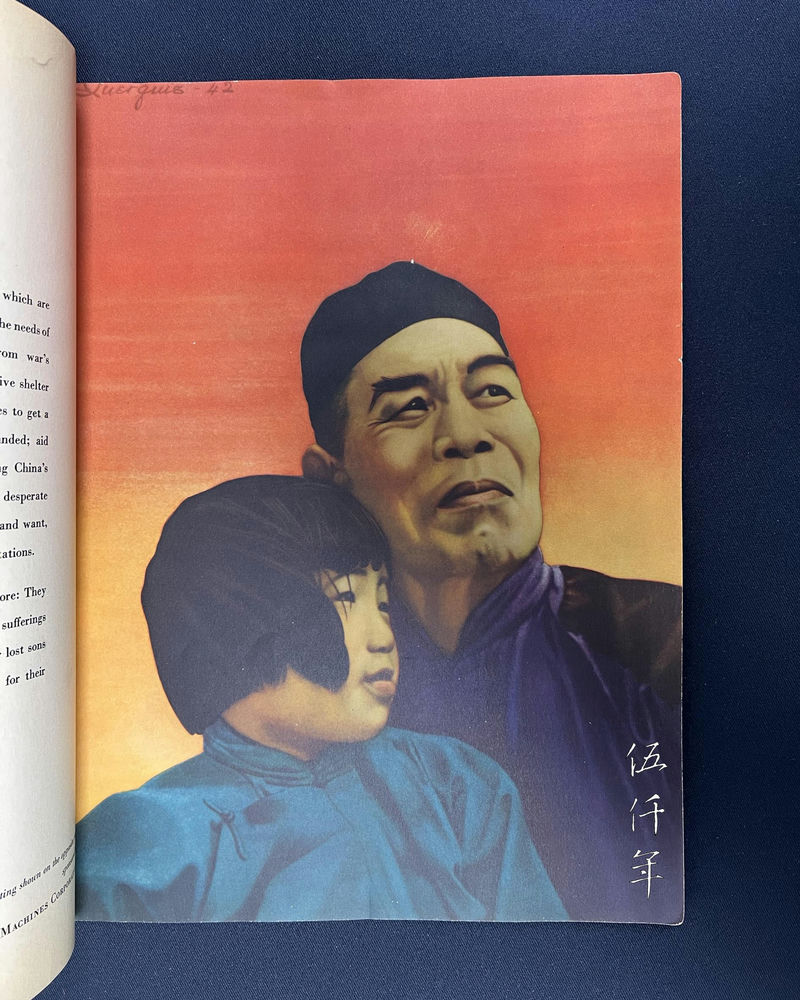
Inside pages of book whose cover was printed with the Chinese character k’ai, meaning victory, published by the United China Relief. Photograph courtesy Mr. Roy Delbyck
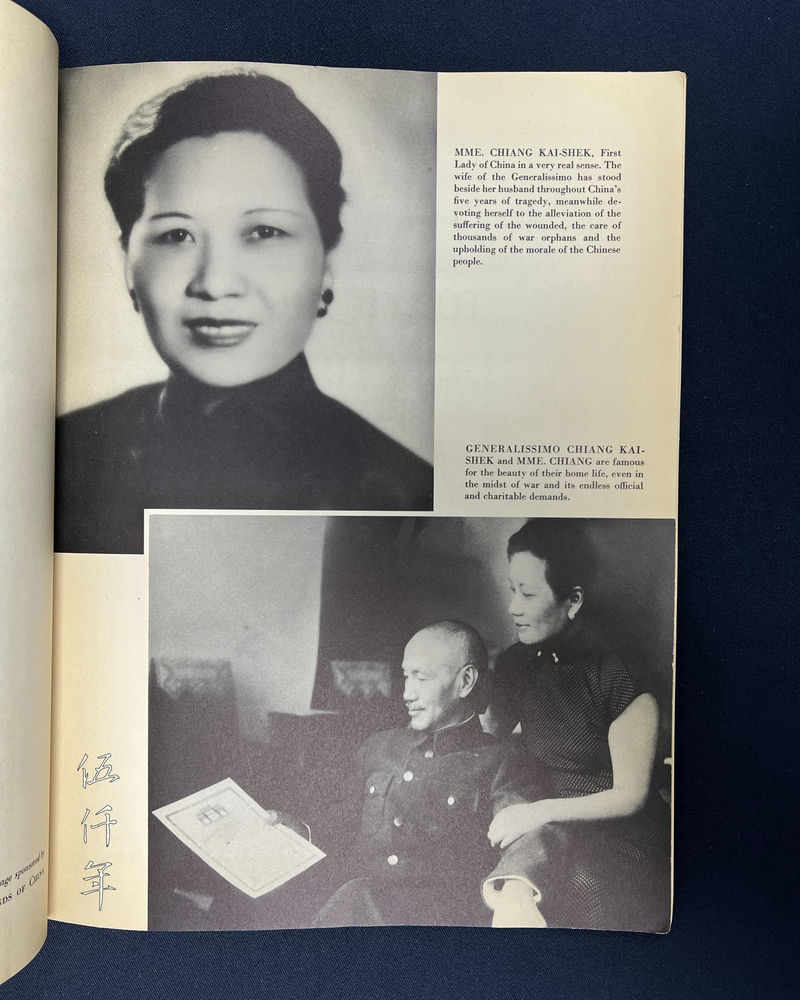
Inside pages of book whose cover was printed with the Chinese character k’ai, meaning victory, published by the United China Relief. Photograph courtesy Mr. Roy Delbyck
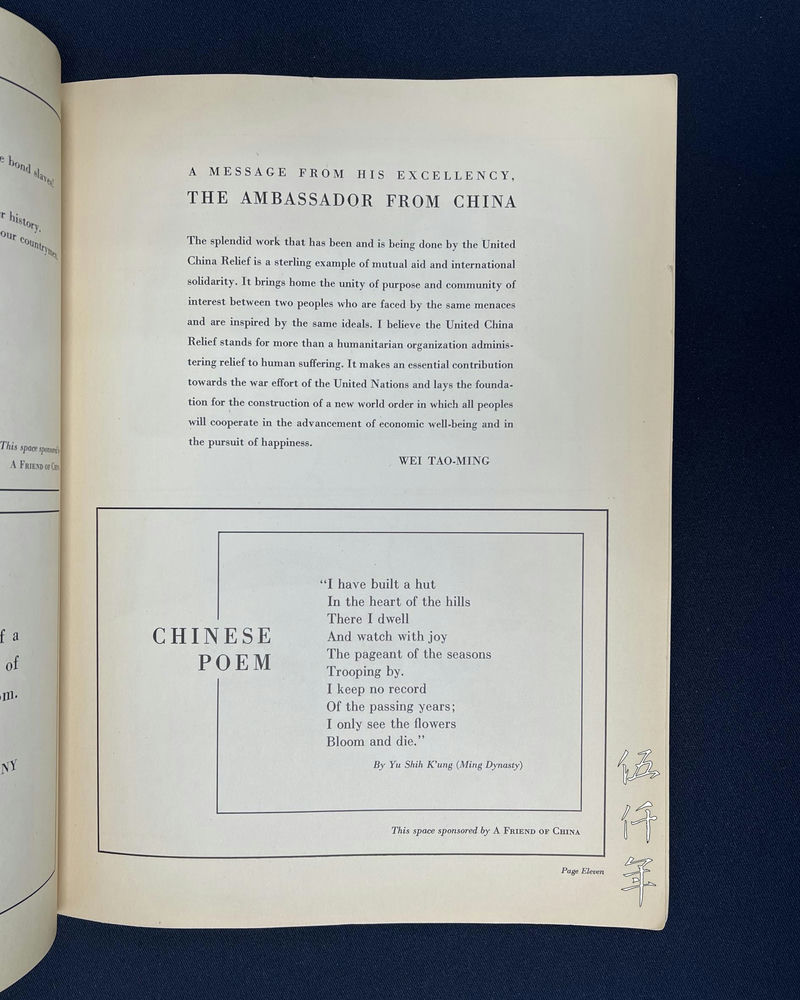
Inside pages of book whose cover was printed with the Chinese character k’ai, meaning victory, published by the United China Relief. Photograph courtesy Mr. Roy Delbyck
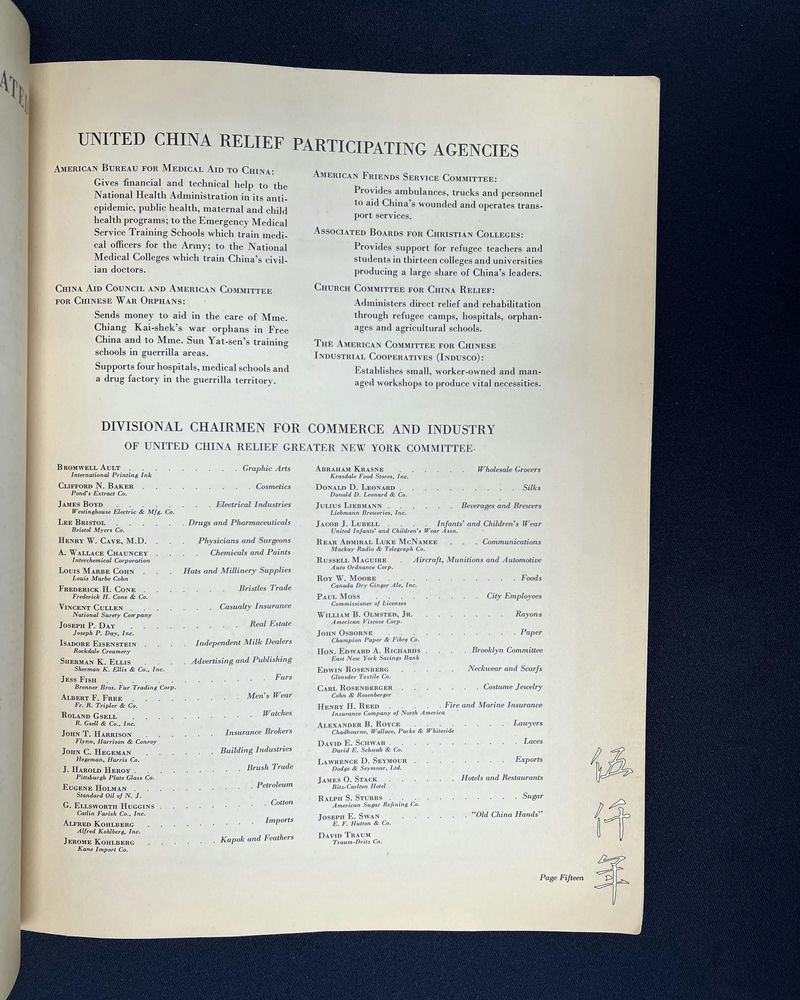
Inside pages of book whose cover was printed with the Chinese character k’ai, meaning victory, published by the United China Relief. Photograph courtesy Mr. Roy Delbyck
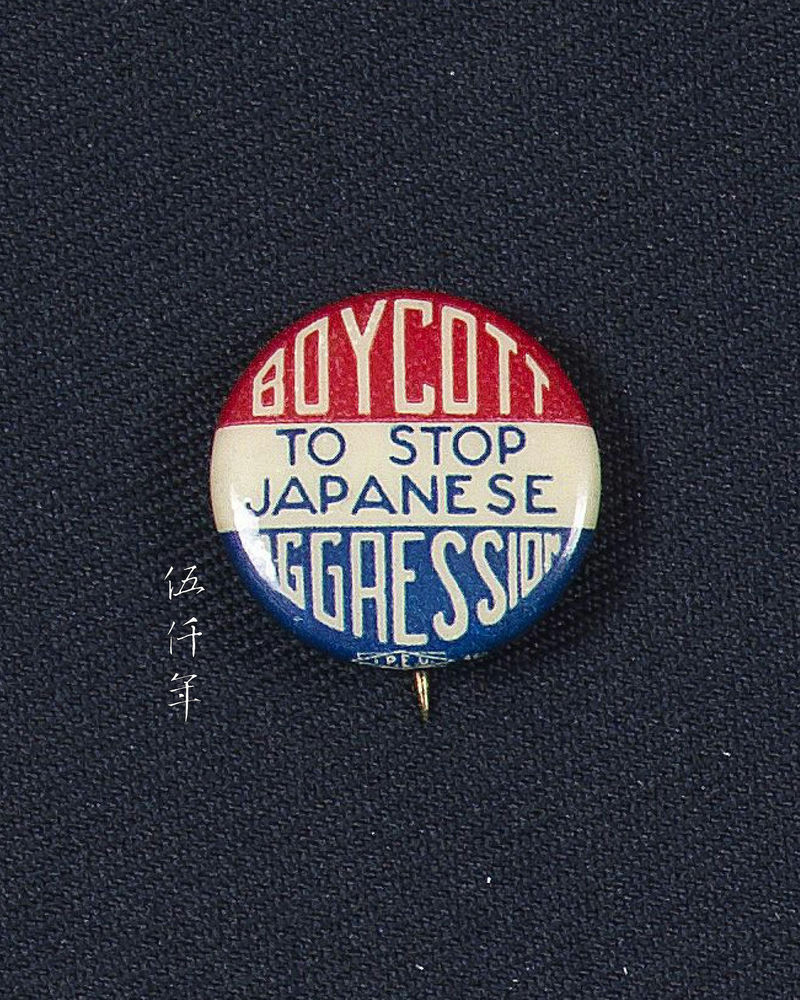
Boycott Japanese goods button pin. Photograph courtesy Mr. Roy Delbyck
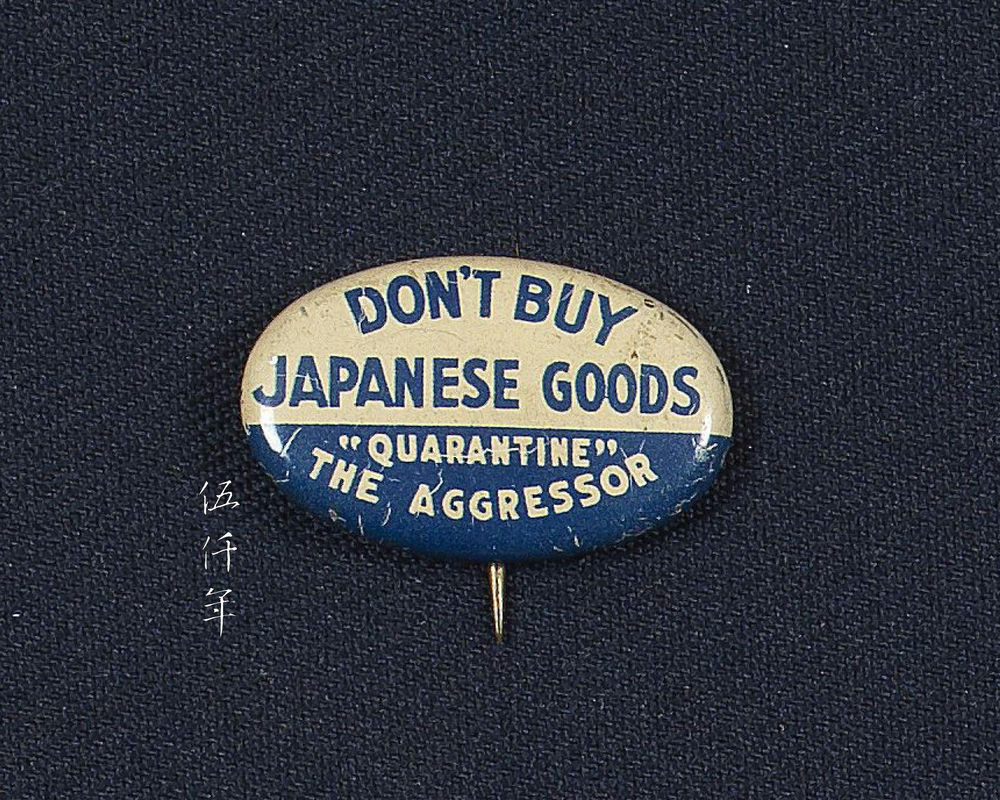
Boycott Japanese goods button pin. Photograph courtesy Mr. Roy Delbyck
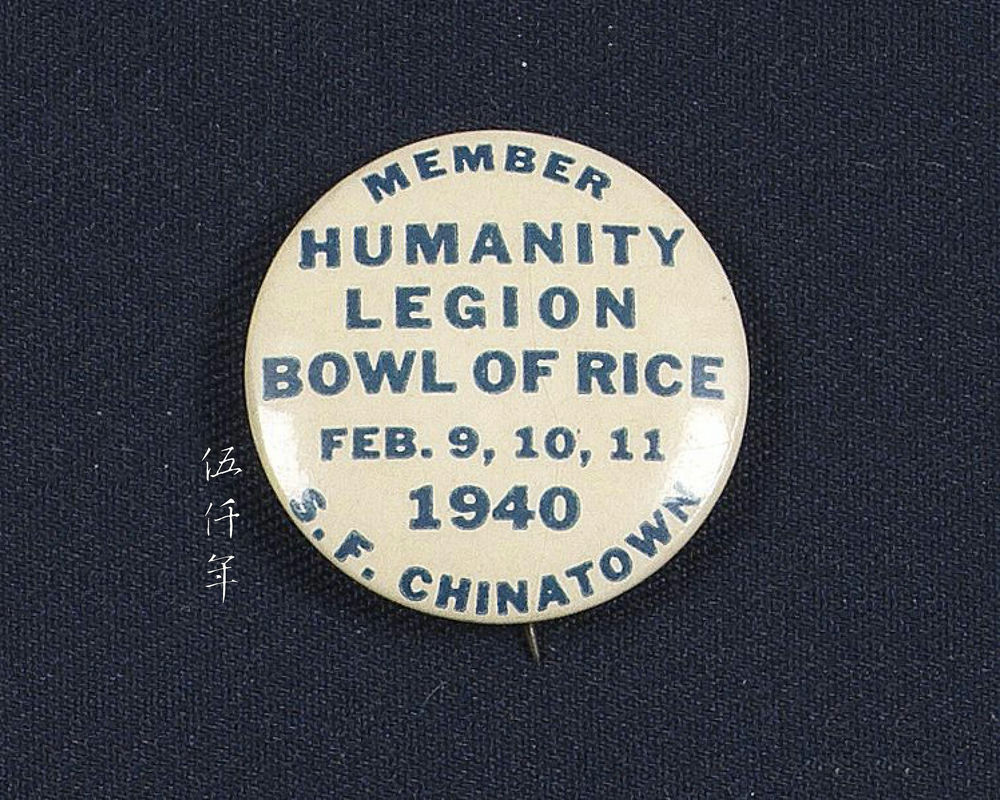
Button pin of San Francisco Chinatown Bowl of Rice Event on 9, 10 and 11 February 1940. Photograph courtesy Mr. Roy Delbyck

Chicago China War Relief button pin. Photograph courtesy Mr. Roy Delbyck
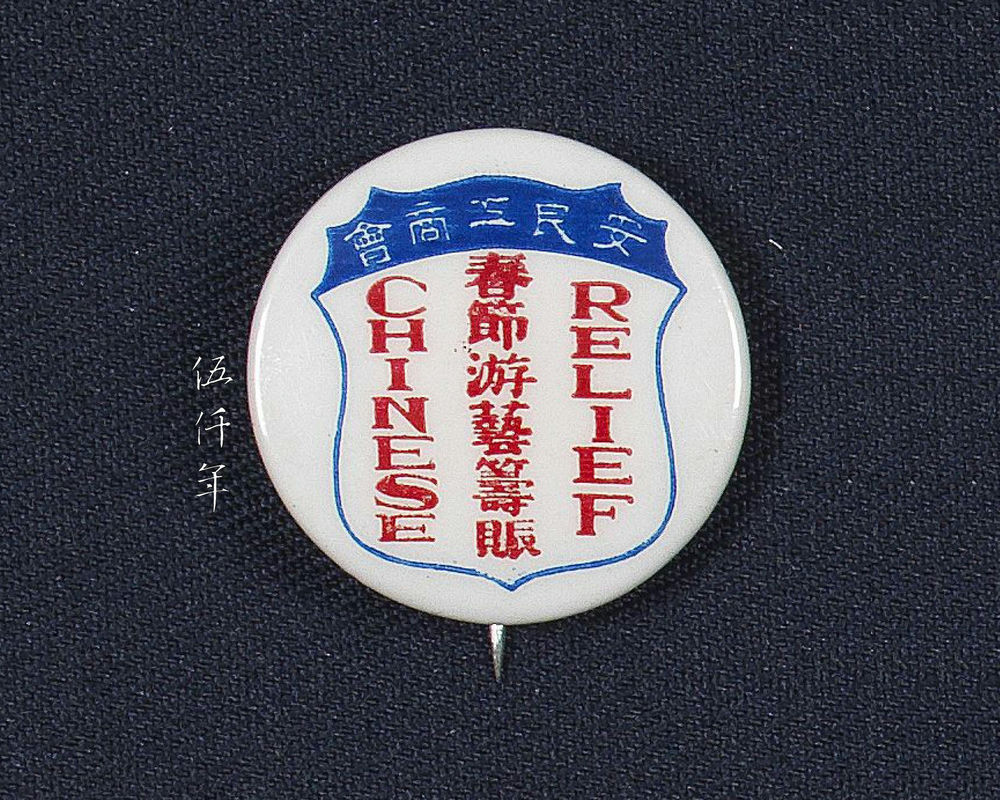
On Leong Chinese Merchants Association Chinese Relief button pin. Photograph courtesy Mr. Roy Delbyck
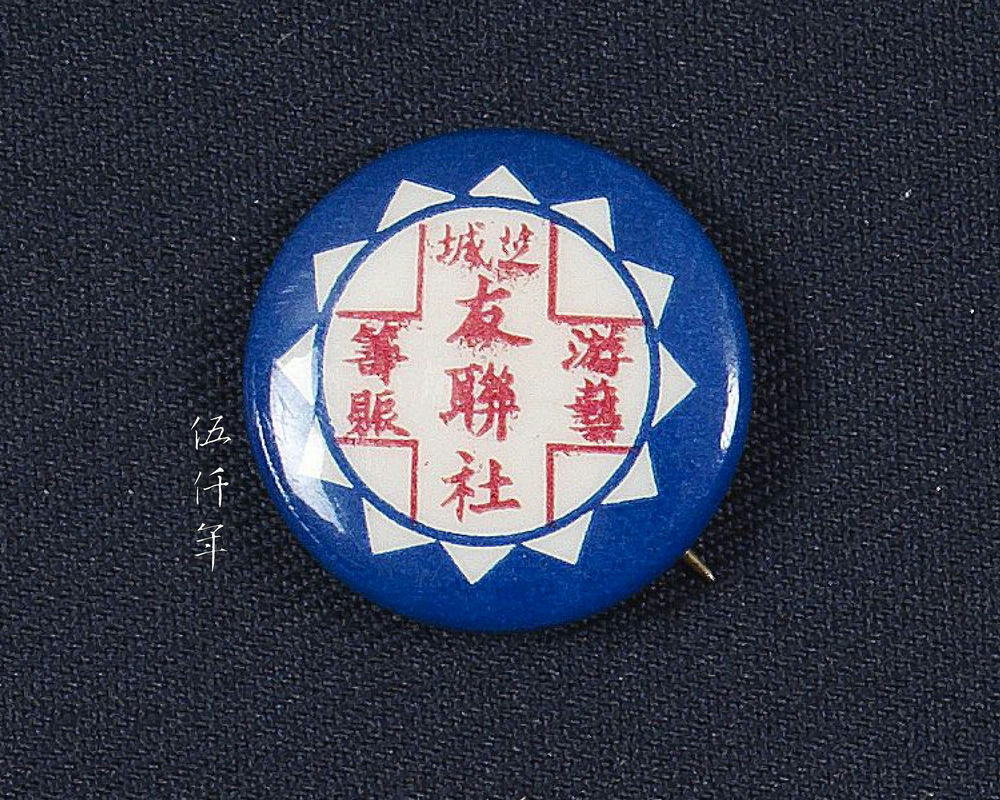
Chicago Yu-lien Society Chinese Relief button pin. Photograph courtesy Mr. Roy Delbyck
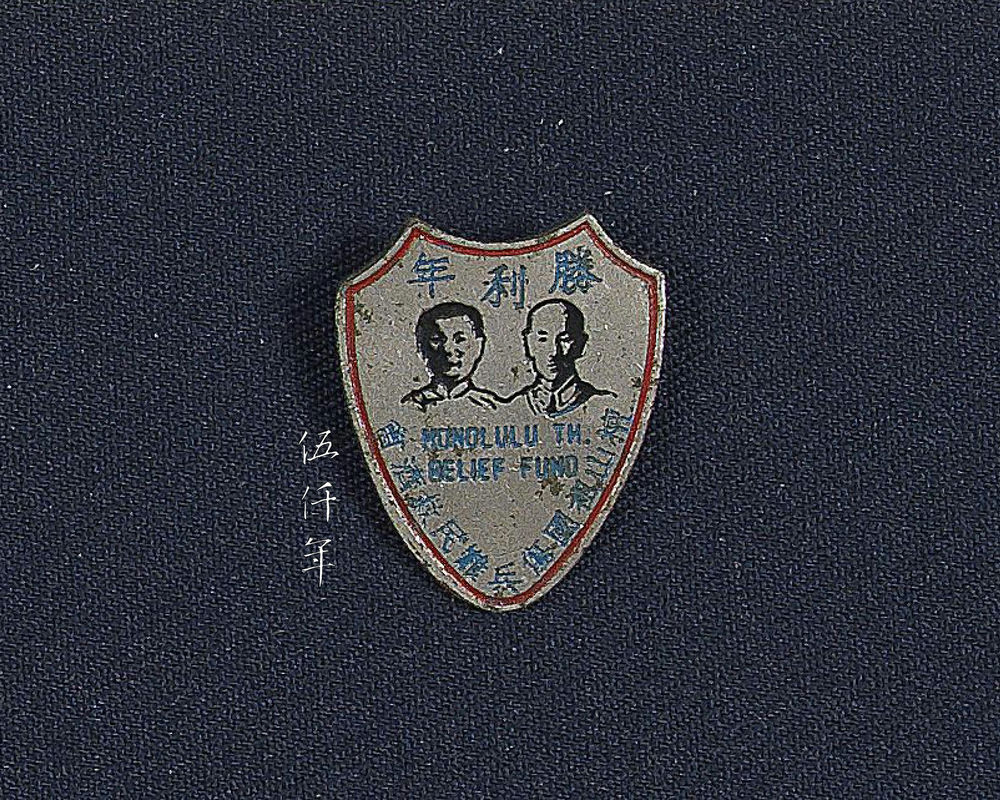
Honolulu Relief Fund button pin. Photograph courtesy Mr. Roy Delbyck
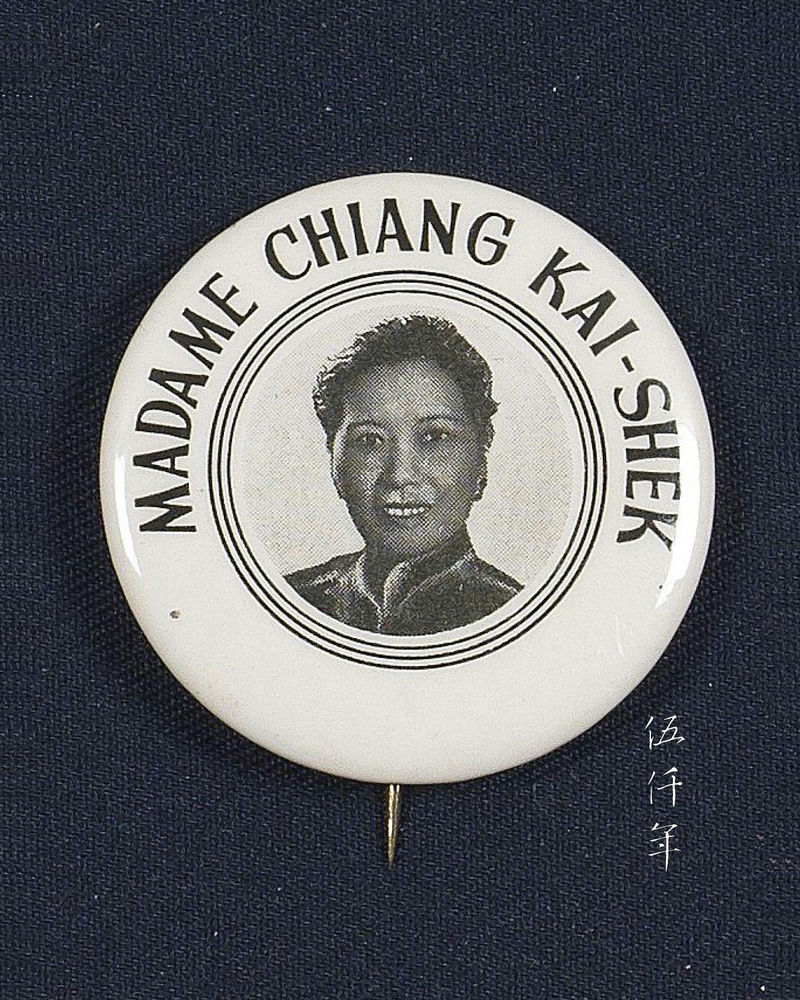
Madame Chiang Kai-shek button pin. Photograph courtesy Mr. Roy Delbyck

Chicago Women’s New Life Movement Association button pin, dated 1942. Photograph courtesy Mr. Roy Delbyck

Chinese rally held in Chicago on the China Unite Day. Photograph courtesy Mr. Roy Delbyck
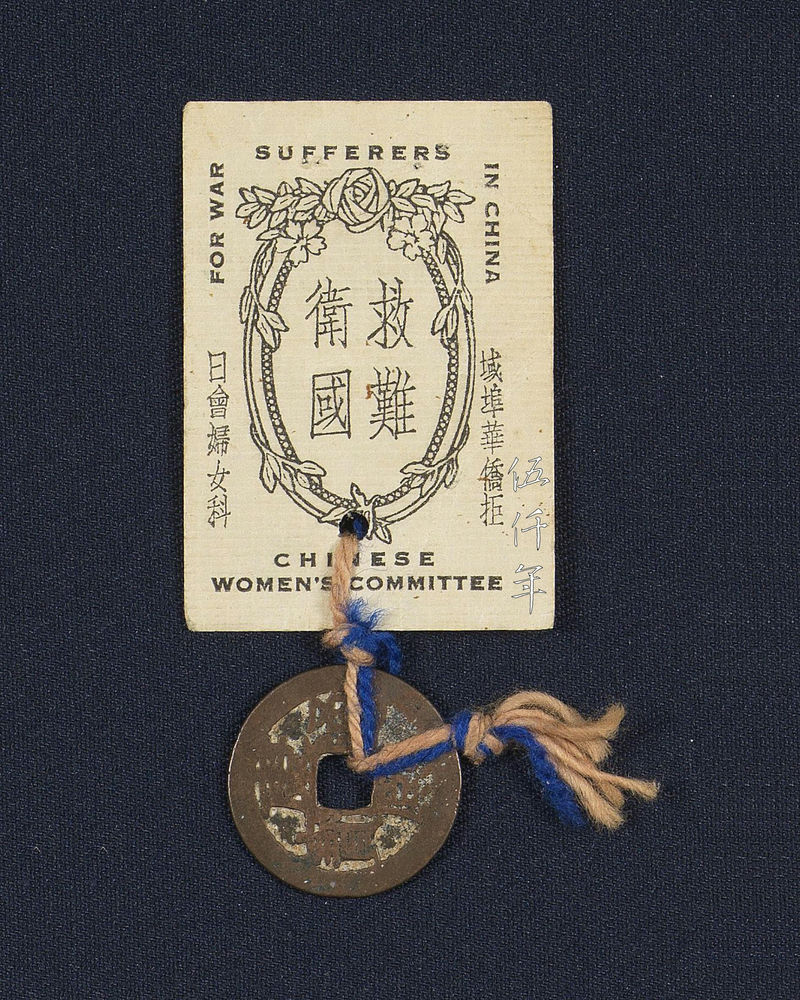
Souvenir of Chinese Women’s Committee with the heading: Sufferers for War in China. Photograph courtesy Mr. Roy Delbyck
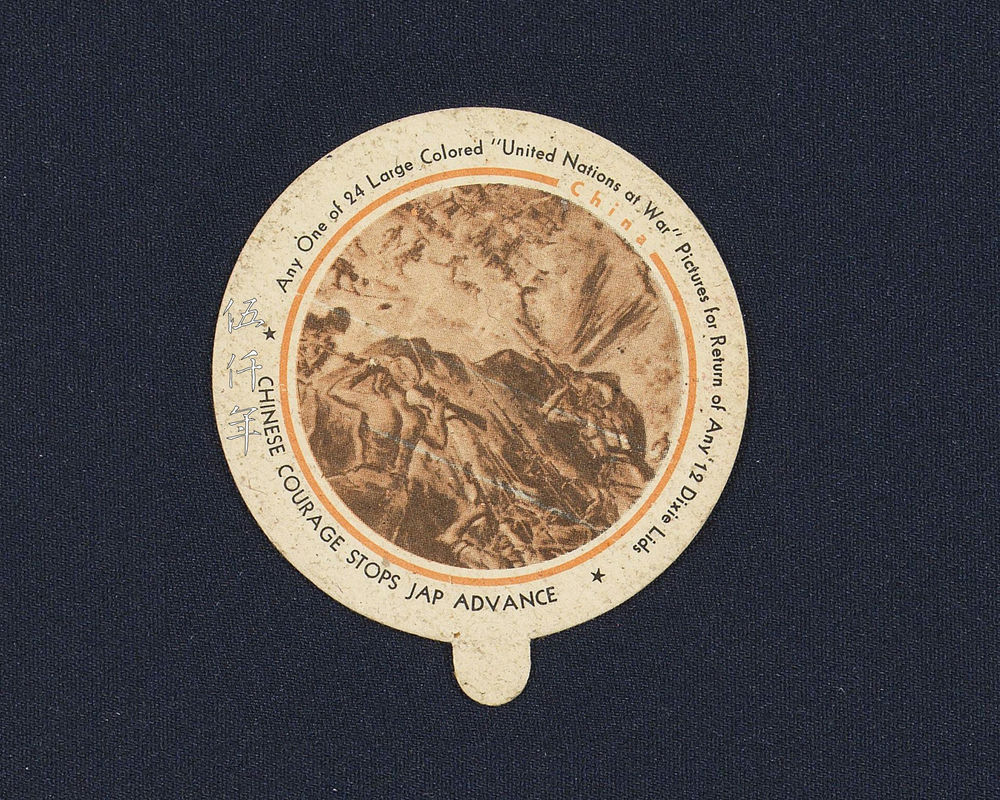
Top of paper lid with the heading: Chinese Courage Stops Jap Advance. Photograph courtesy Mr. Roy Delbyck
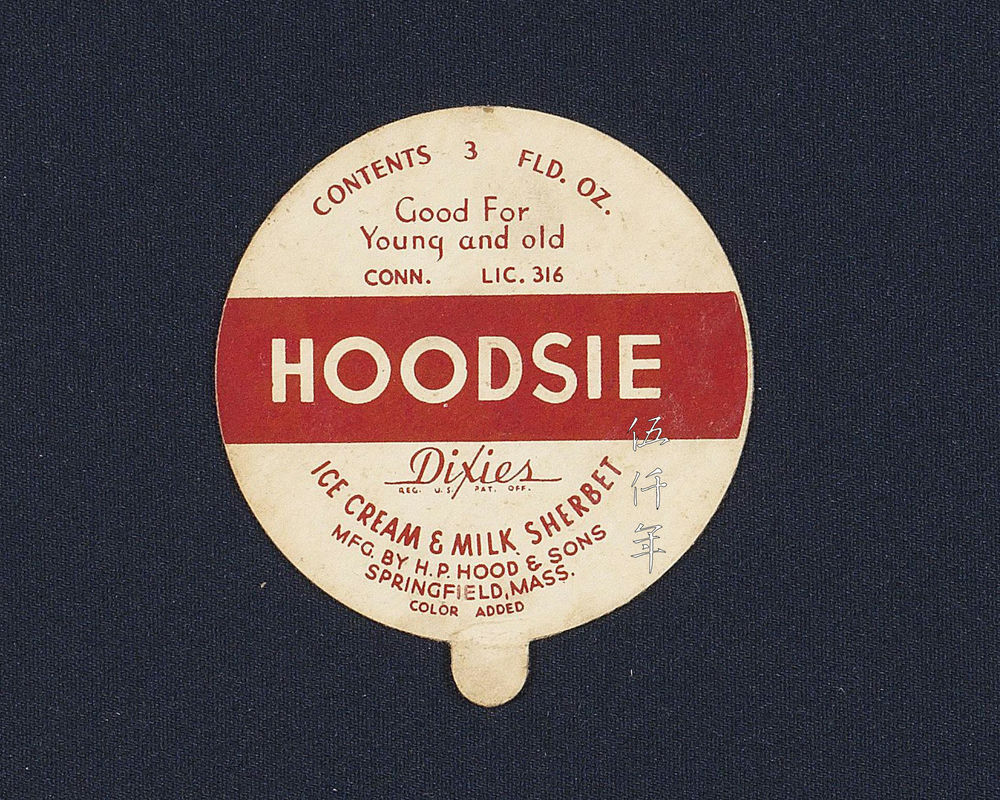
Bottom of paper lid with the heading: Chinese Courage Stops Jap Advance. Photograph courtesy Mr. Roy Delbyck
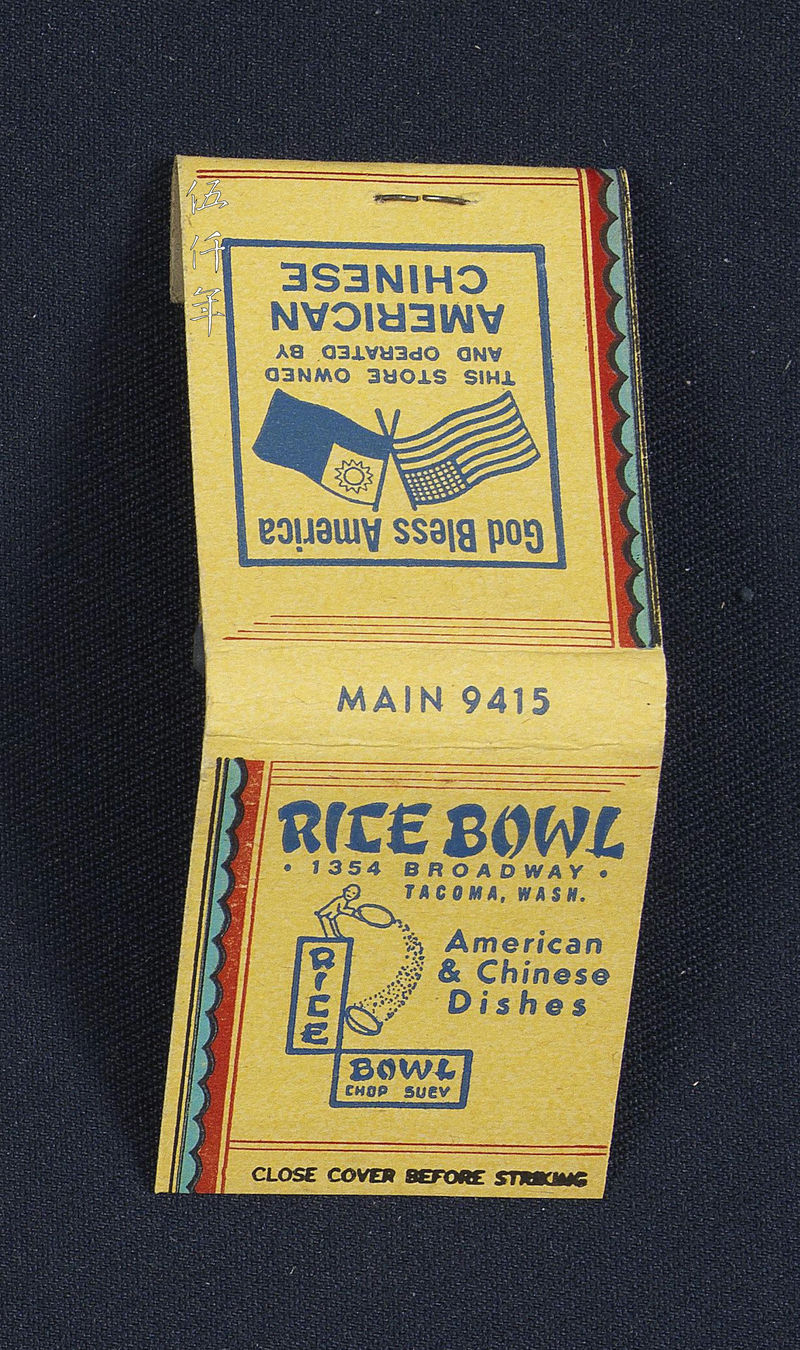
Matchbook for Rice Bowl Restaurant printed with the Republic of China and American flags. Photograph courtesy Mr. Roy Delbyck
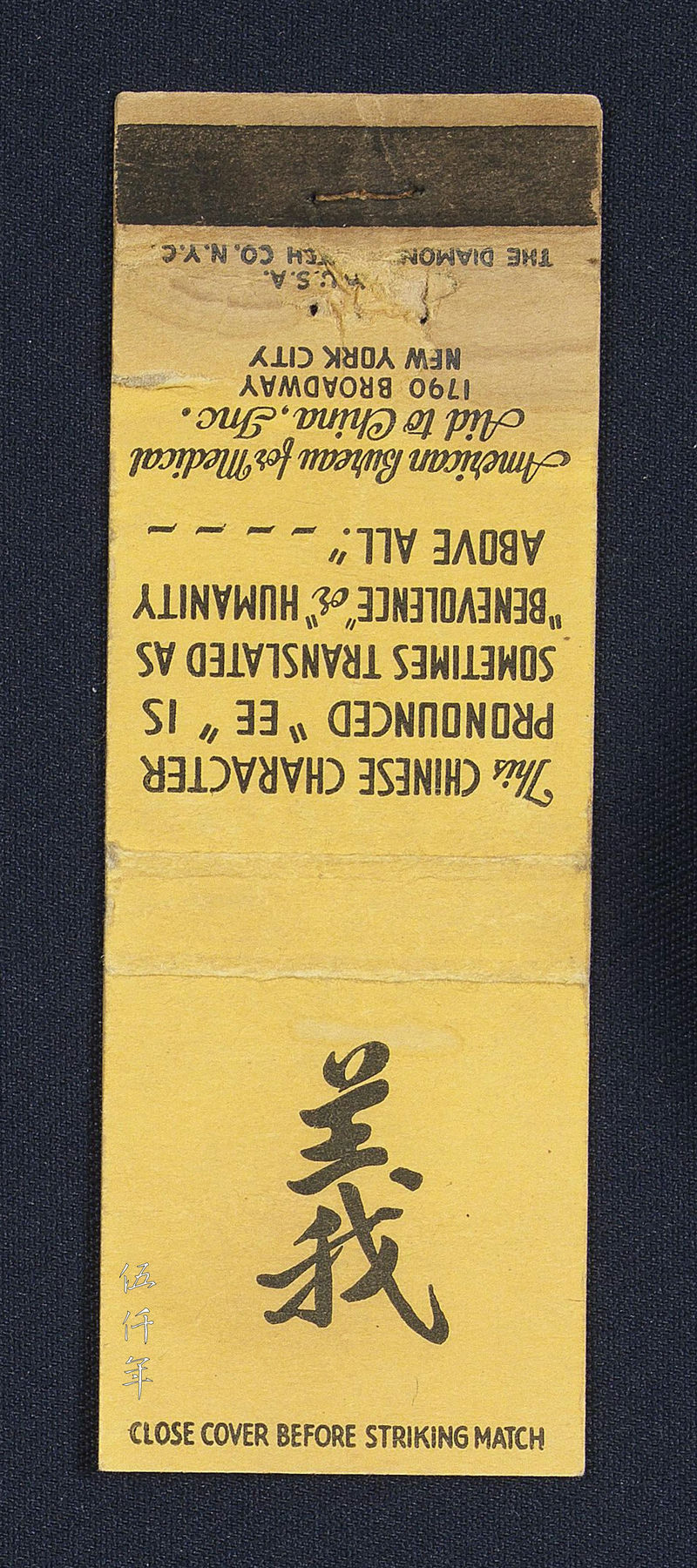
Matchbook for American Bureau for Medical Aid to China printed with the character 義 and caption: The Chinese character pronounced “ee” is sometimes translated as “Benevolence” or “Humanity Above All”. Photograph courtesy Mr. Roy Delbyck
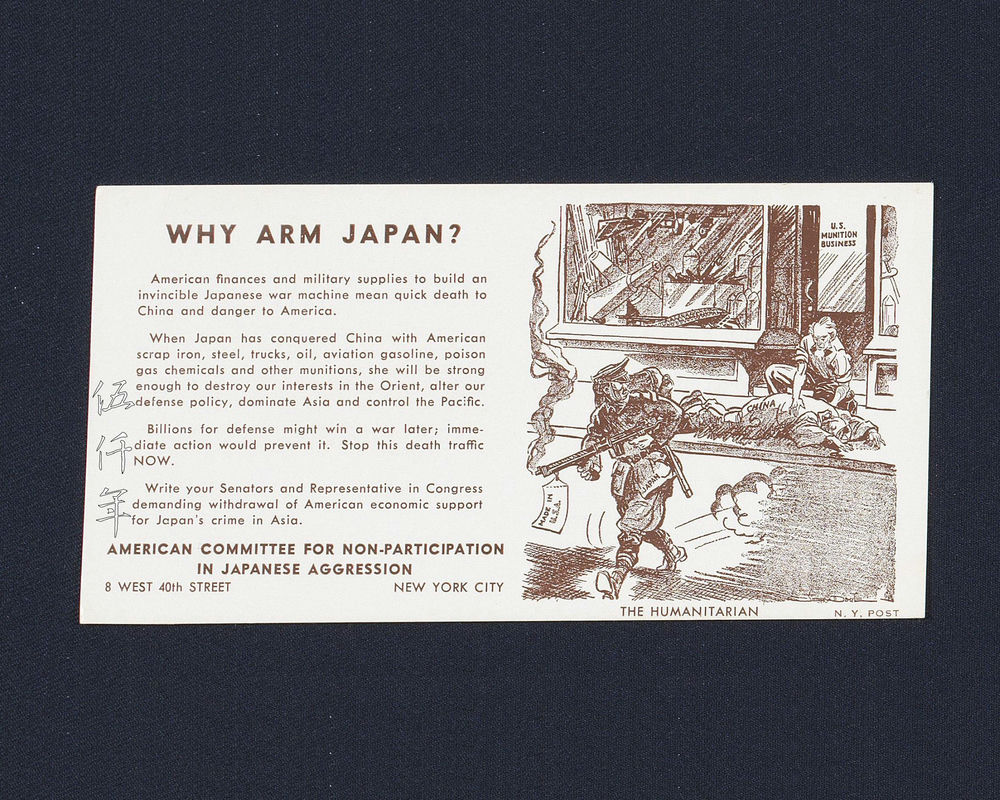
Leaflet by American Committee for Non-Participation in Japanese Aggression with the heading: Why Arm Japan? Photograph courtesy Mr. Roy Delbyck
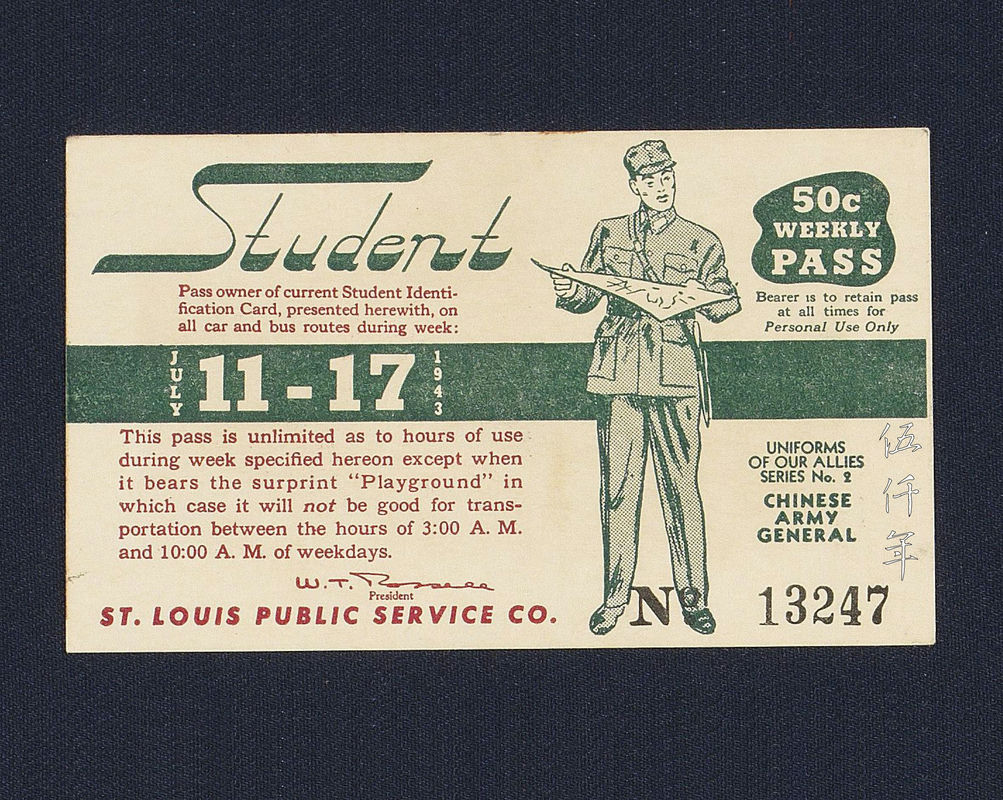
Student pass issued by St. Louis Public Service Co. with illustration of Chinese Army General Uniform. Photograph courtesy Mr. Roy Delbyck

Front of postcard printed by United China Relief. Photograph courtesy Mr. Roy Delbyck

Back of postcard printed by United China Relief. Photograph courtesy by Mr. Roy Delbyck

Front of postcard printed by United China Relief. Photograph courtesy Mr. Roy Delbyck
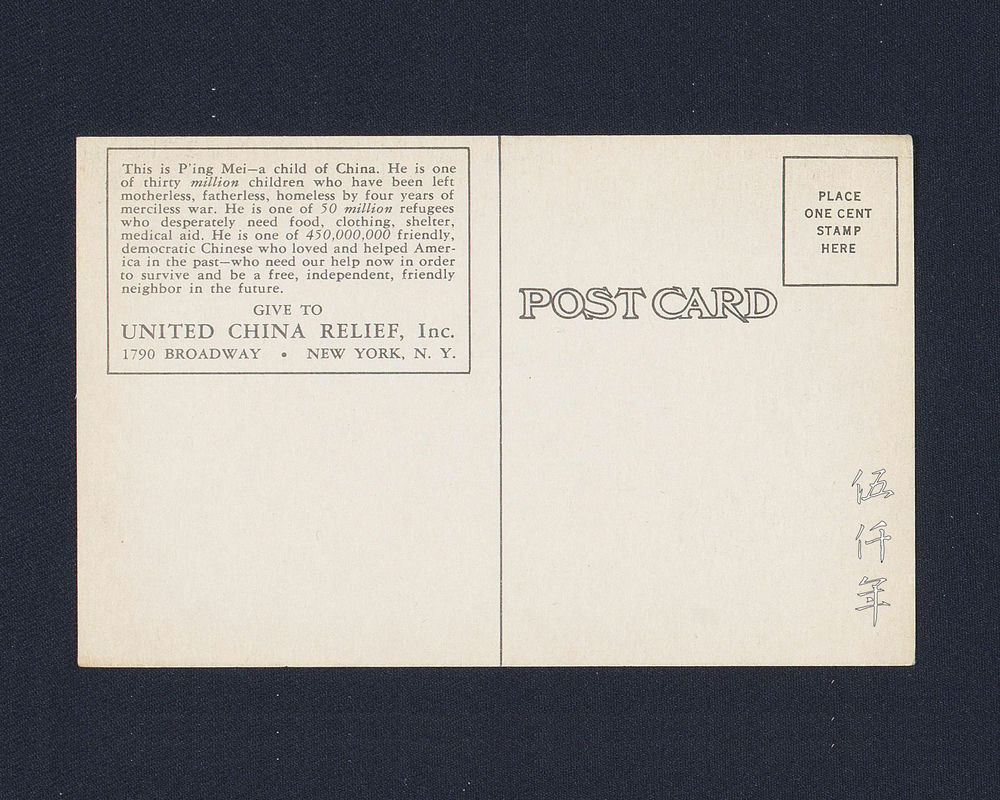
Back of postcard printed by United China Relief. Photograph courtesy Mr. Roy Delbyck

Front of postcard printed by Chinese Women’s Relief Association. Photograph courtesy Mr. Roy Delbyck

Back of postcard printed by Chinese Women’s Relief Association. Photograph courtesy Mr. Roy Delbyck
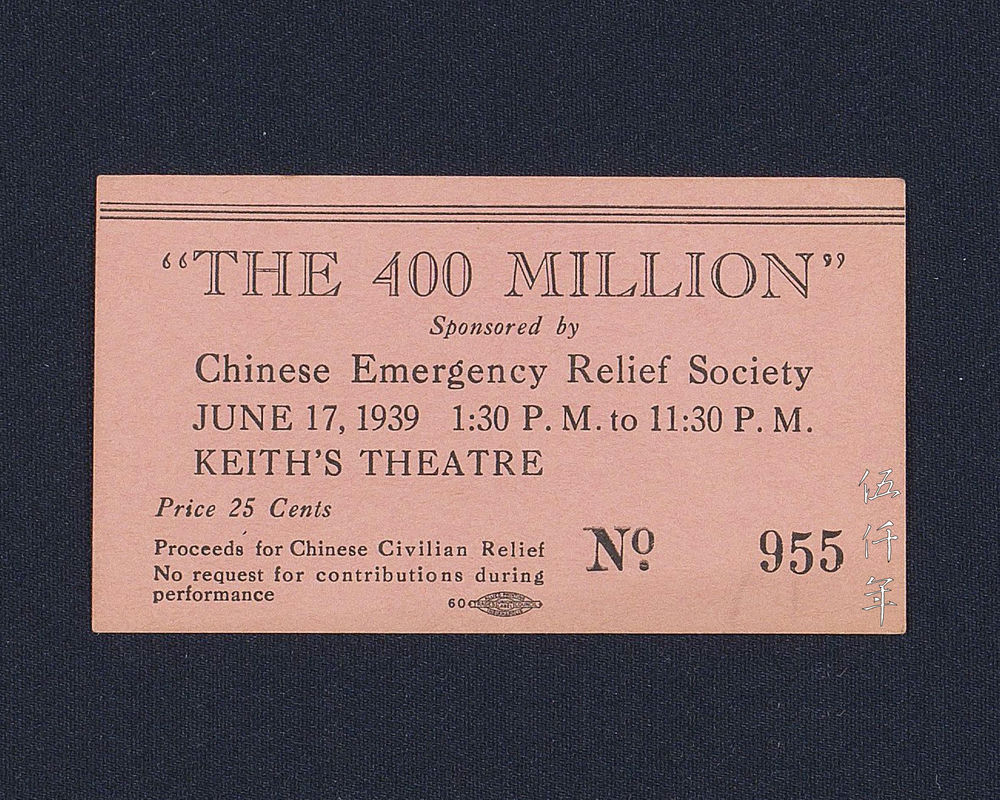
Ticket for The 400 Million on 17 June 1939. Proceeds for Chinese Civilian Relief. Photograph courtesy Mr. Roy Delbyck
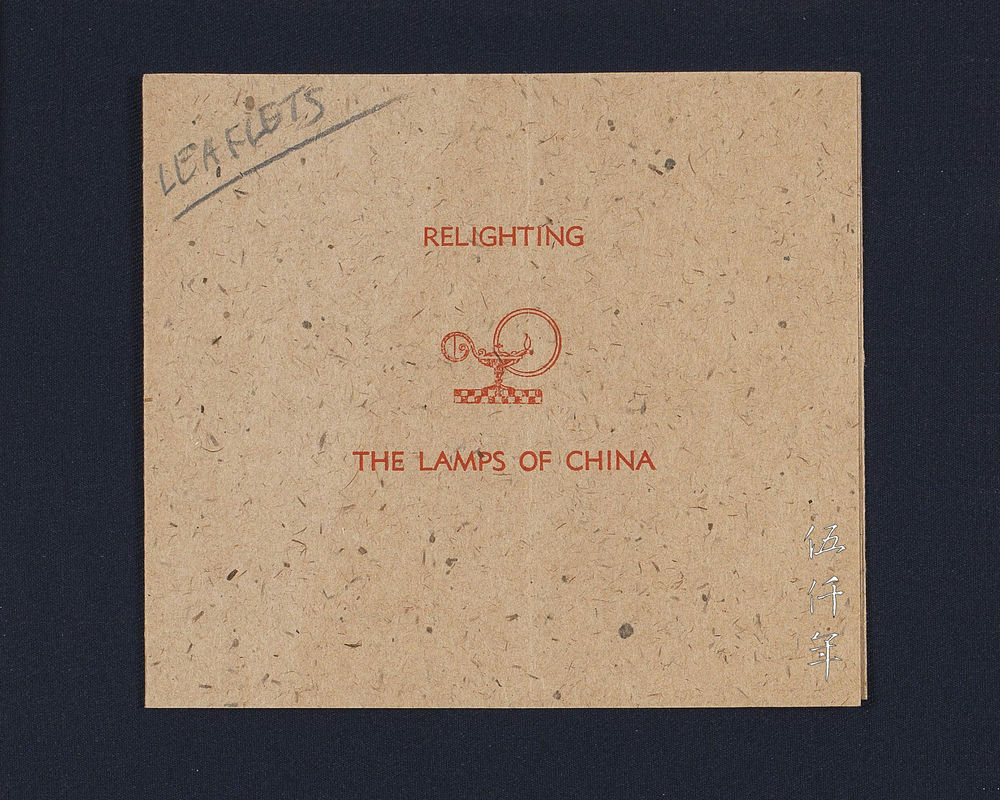
Front cover of pamphlet for Chinese Garden Festival on 6 October 1940, printed with the heading: Relighting the Lamps of China. Photograph courtesy Mr. Roy Delbyck

Inside page of pamphlet for Chinese Garden Festival on 6 October 1940, organized by China Aid Council. Proceeds to China’s first Orthopaedic Hospital and Chinese War Orphans. Photograph courtesy Mr. Roy Delbyck
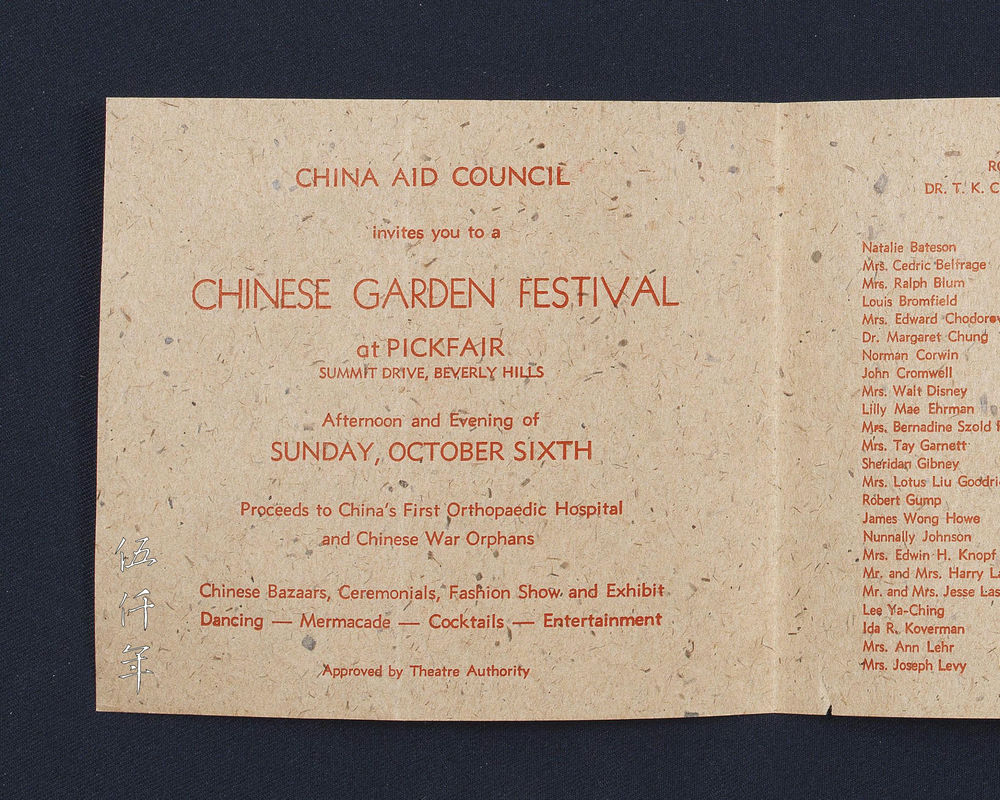
Inside page of pamphlet for Chinese Garden Festival on 6 October 1940, organized by China Aid Council. Proceeds to China’s first Orthopaedic Hospital and Chinese War Orphans. Photograph courtesy Mr. Roy Delbyck
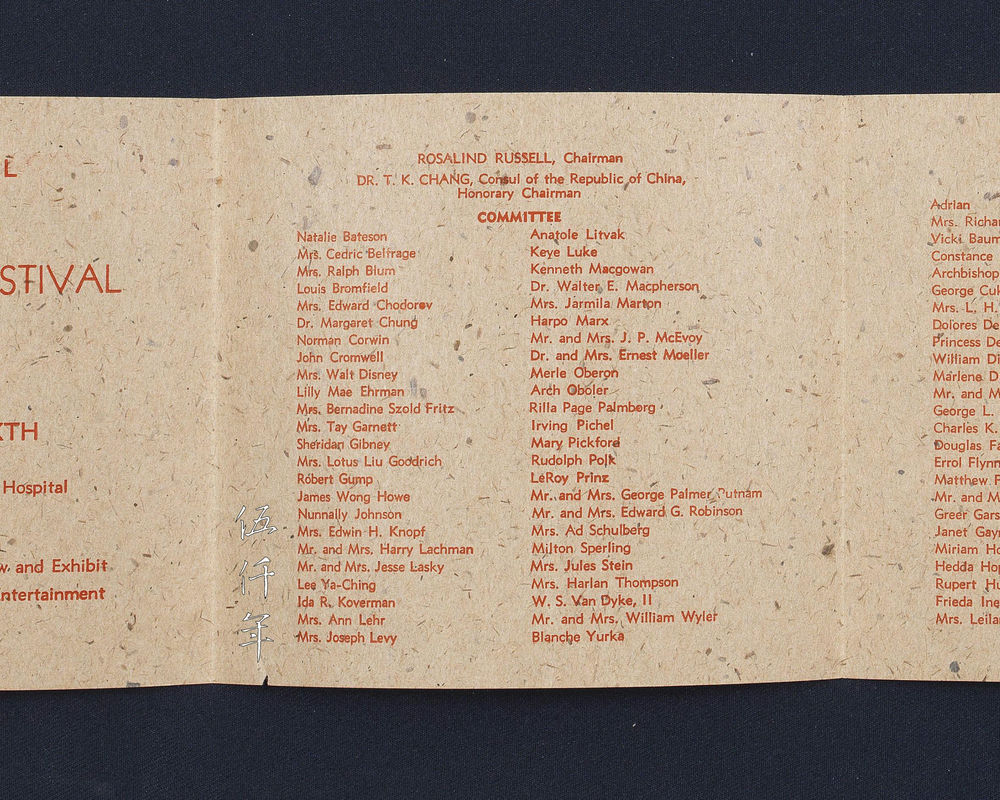
Inside page of pamphlet for Chinese Garden Festival on 6 October 1940, organized by China Aid Council. Proceeds to China’s first Orthopaedic Hospital and Chinese War Orphans. Photograph courtesy Mr. Roy Delbyck
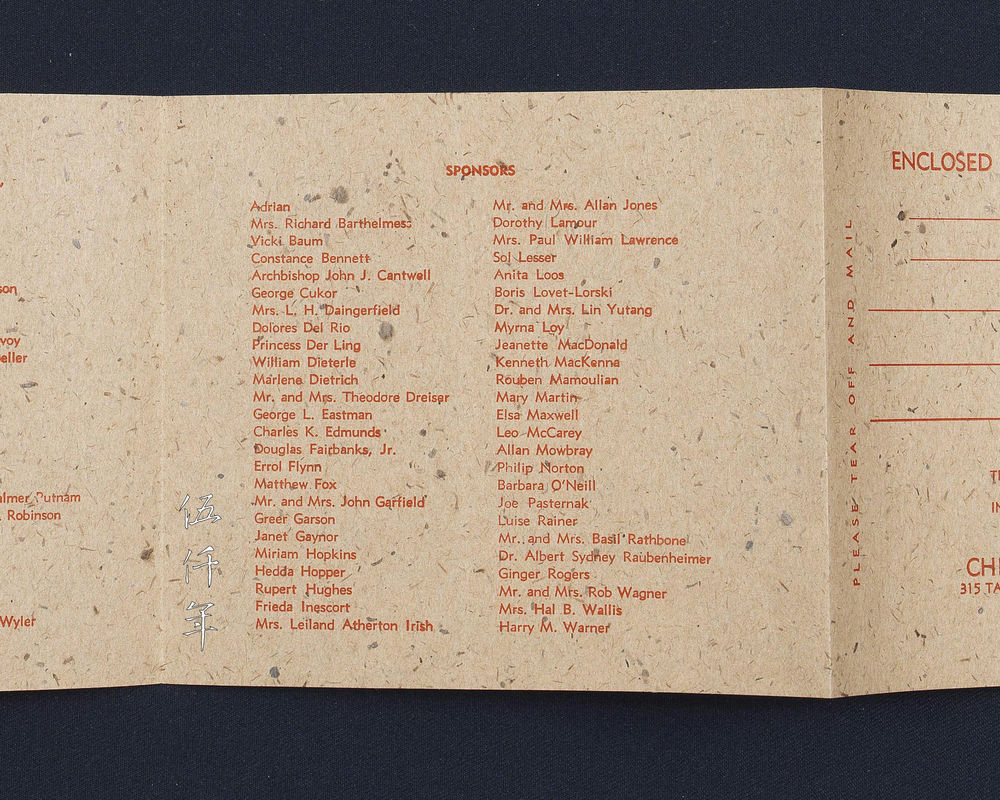
Inside page of pamphlet for Chinese Garden Festival on 6 October 1940, organized by China Aid Council. Proceeds to China’s first Orthopaedic Hospital and Chinese War Orphans. Photograph courtesy Mr. Roy Delbyck
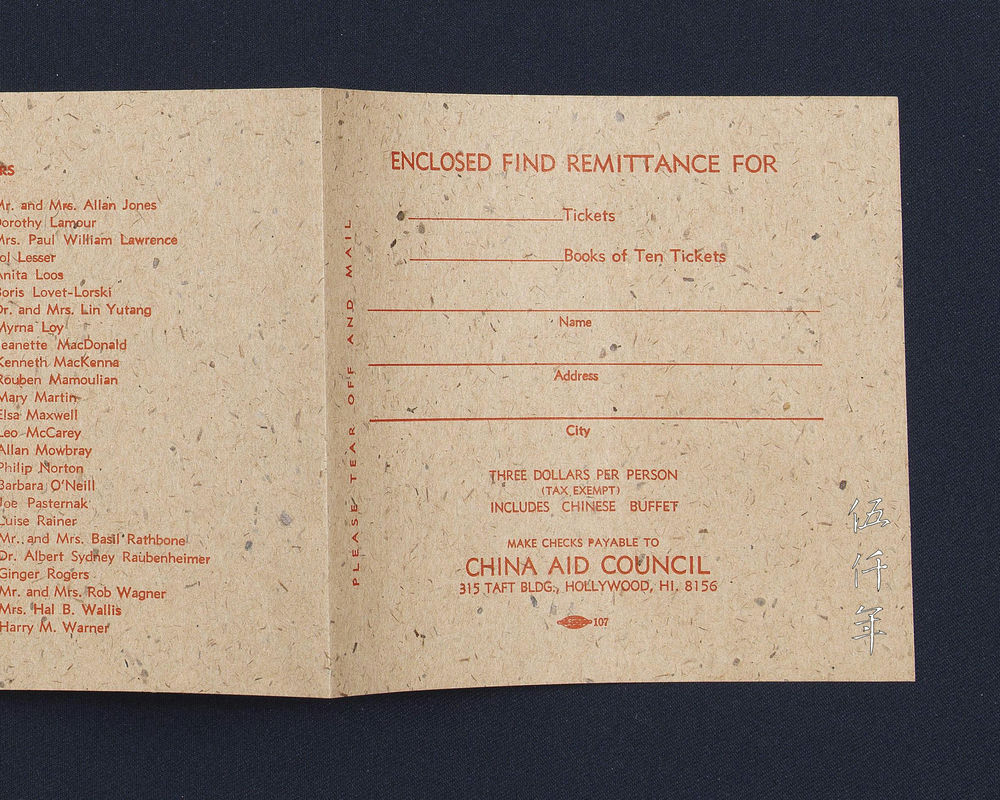
Inside page of pamphlet for Chinese Garden Festival on 6 October 1940, organized by China Aid Council. Proceeds to China’s first Orthopaedic Hospital and Chinese War Orphans. Photograph courtesy Mr. Roy Delbyck

Ticket for Tri-City Bowl of Rice Dance for the Destitute and Suffering Refugees of All Creeds in War Torn China on 1 June 1941. Photograph courtesy Mr. Roy Delbyck
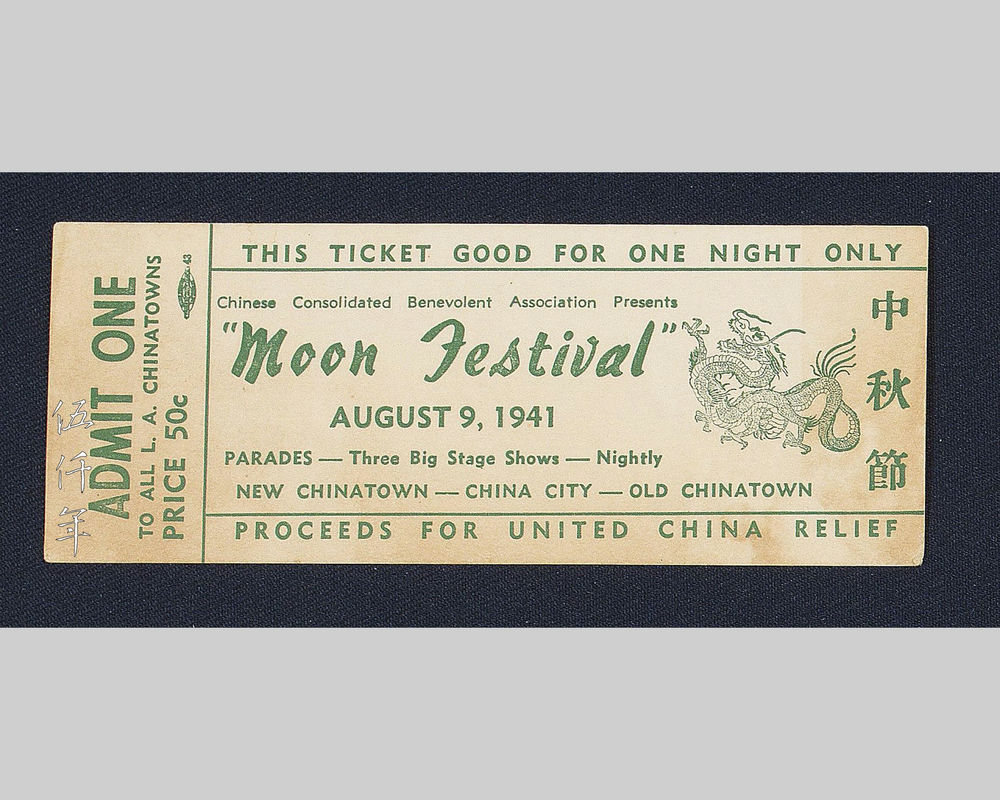
Ticket for Moon Festival on 9 August 1941, proceeds for United China Relief. Photograph courtesy Mr. Roy Delbyck
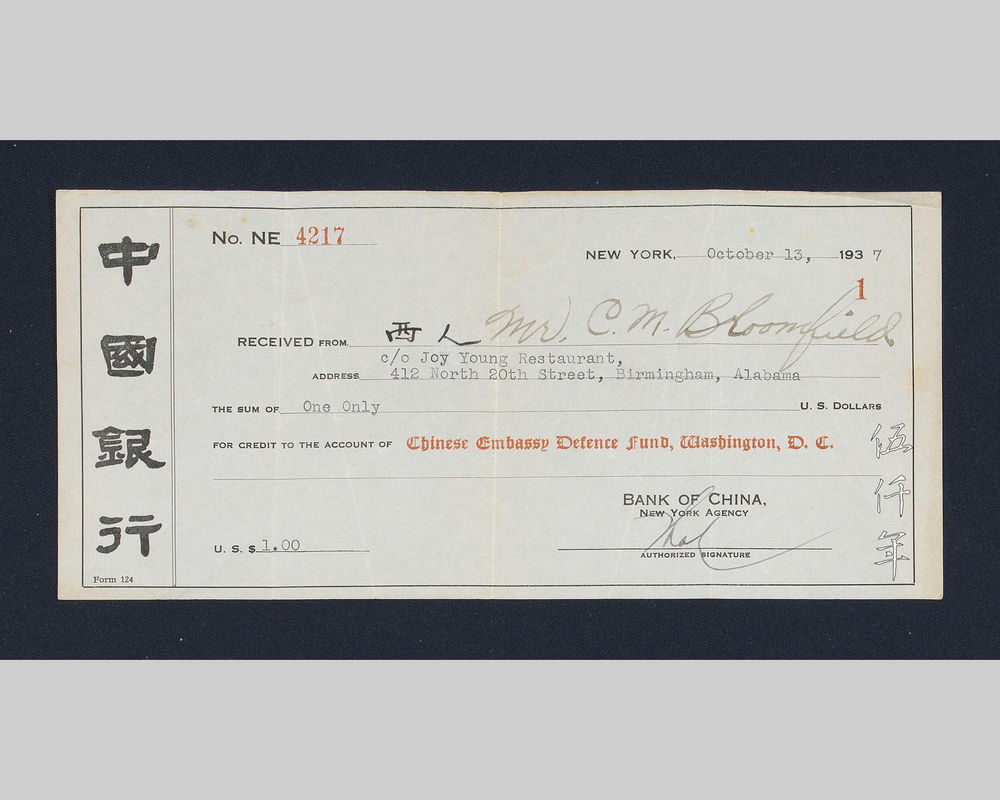
Receipt issued by Bank of China for donation to Chinese Embassy Defense Fund in 1937. Photograph courtesy Mr. Roy Delbyck
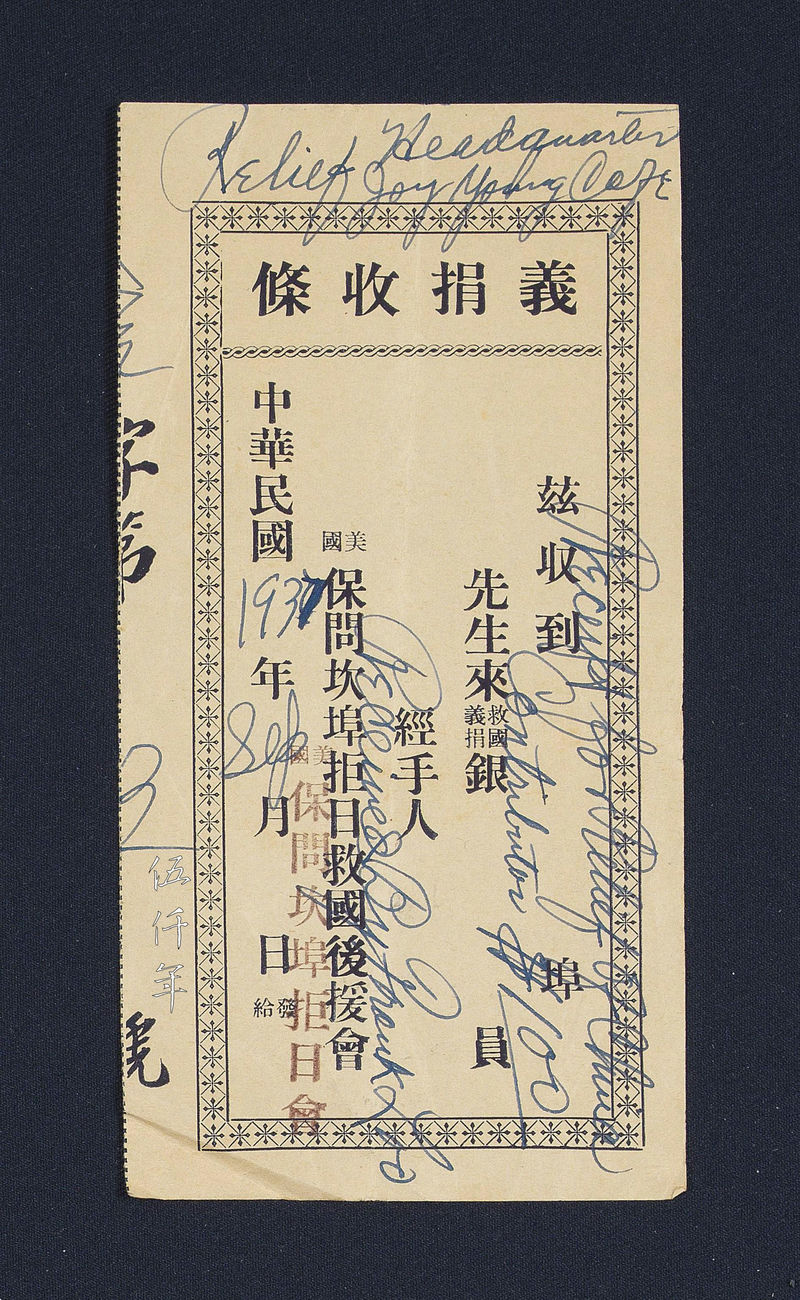
Receipt issued by American Chinese organization for the donation of $100 for Relief of China in 1937. Photograph courtesy Mr. Roy Delbyck
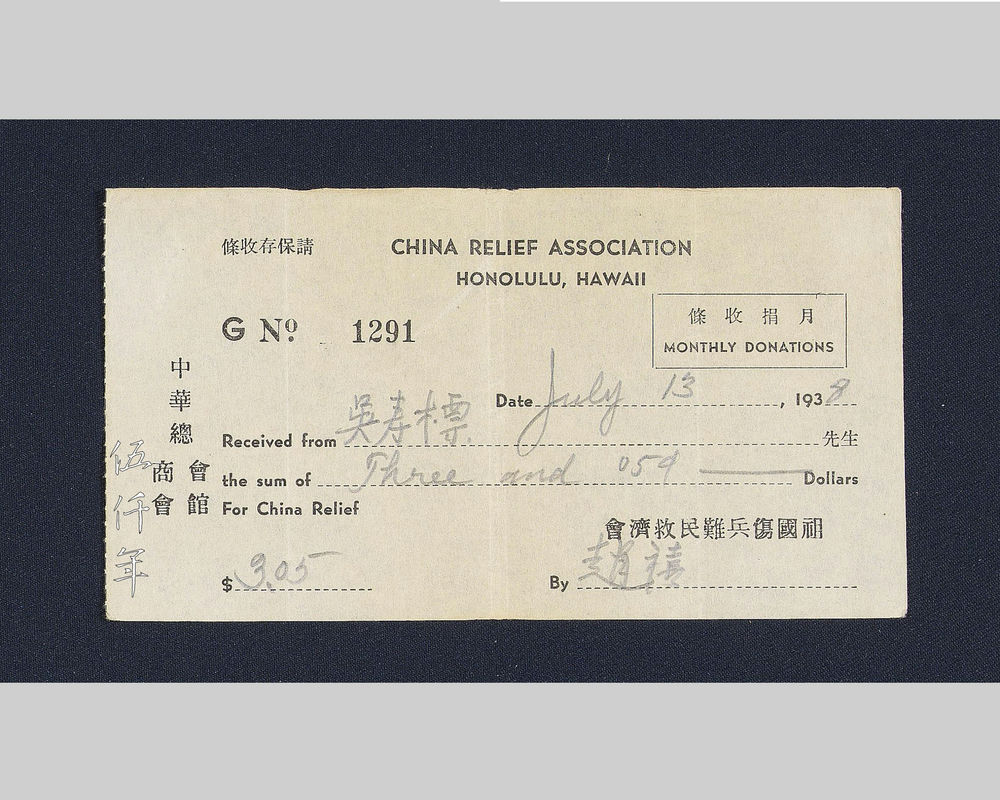
Receipt issued by China Relief Association in Hawaii for donation to China Relief in 1938. Photograph courtesy Mr. Roy Delbyck
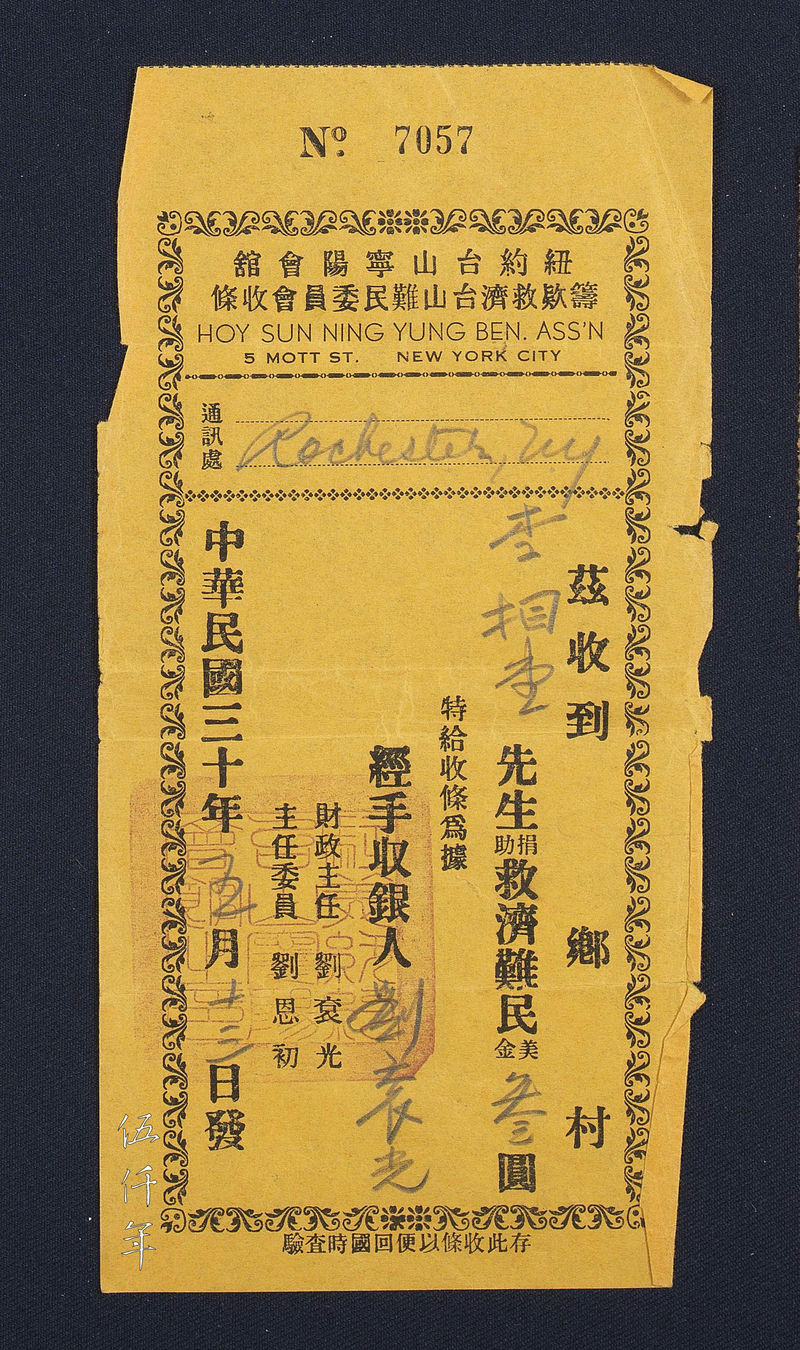
Receipt issued by Hoy Sun Ning Yung Beneficiary Association in New York for donationto China aid in 1941. Photograph courtesy Mr. Roy Delbyck

Invitation to dine with Bishop Yu Pin, sponsored by China War Relief Association, American Friends of the Chinese People and San Francisco Committee Against War Shipments to Japan. Photograph courtesy Mr. Roy Delbyck

Reply card of the invitation to dine with Bishop Yu Pin. Photograph courtesy Mr. Roy Delbyck

Bulletin No. 20 from the American Bureau for Medical Aid to China whose national chairman was Theodore Roosevelt Junior, eldest son of President Roosevelt, and honorary chairman was Madame Chiang Kai-shek. Photograph courtesy Mr. Roy Delbyck

Letter to Princess Der Ling inviting her to attend the first Bowl of Rice Party in the City of Tulare, California. Photograph courtesy Mr. Roy Delbyck

Chinese students on holiday vacation spent their time in New York soliciting funds for the American Bureau for Medical Aid to China on 30 December 1937. Photograph courtesy Mr. Roy Delbyck
Visit Canada
Visit Canada
On 18 February 1943, the 32nd year of the Republic, Madame Chiang Kai-shek delivered a sensational speech in the U.S. Congress that resonated throughout the American continent. The ambassador of the Republic of China to Canada at the time, Ambassador Liu Shih-shun (劉師舜), worked hard to enable Madame Chiang to visit Canada for the purpose of further enhancing the friendship between the two countries. On 14 June the Canadian government sent a special train to New York with Hugh Keenleyside, the Director of the American Division of the Canadian Department of External Affairs, as representative to welcome Madame Chiang. She arrived in the capital Ottawa in the afternoon the same day. The Governor-General of Canada, Major General the Earl of Athlone, and the Prime Minister W. L. Mackenzie King led the entire cabinet, the Speakers of the Senate and the House of Commons, to greet her at the train station in person. They accompanied Madame Chiang to the Government House, where she participated in a ceremony to receive donations for the war effort. At the time, the Ontario China War Relief had raised 3 million Chinese dollars and the Canadian Red Cross had raised 100,000 Canadian dollars. In 1943, one US dollar was equivalent to around 20 Chinese dollars, hence 3 million Chinese dollars was equivalent to around 150,000 U.S. dollars. After accounting for inflation, it is equivalent to 2,668,691 US dollars today. In 1943, 100,000 Canadian dollars is equivalent to around 1,796,106 Canadian dollars today. On the evening of 15 June the Earl of Athlone and his wife hosted a banquet for Madame Chiang, and in the morning of 16 June, she addressed both the Senate and the House of Commons of the Canadian Parliament, providing an account of China’s war effort against Japan. The address was broadcasted on the radio and reached far and wide.
At noon on 16 June, Ambassador Liu hosted a welcome reception for Madame Chiang at the Chateau Laurier hotel in Ottawa which was attended by more than 1,200 guests. In the evening, Prime Minister Mackenzie King hosted a banquet for Madame Chiang at the Country Club. On the 17 and 18, Madame Chiang visited Montreal before returning to New York by special train.
According to The Biography of Ambassador Liu Shih-shun, written by Mr. Liu Tun-jen (劉敦仁), the nephew of Ambassador Liu Shih-shun:
“Six months later, in December 1943, the Canadian Parliament had Madame Chiang’s speech and the meeting program printed into a deluxe booklet. They asked the Chinese Embassy to translate the cover into Chinese and added the Chinese national emblem. The Speaker of the Canadian Senate, Thomas Vien, personally presented the booklet to Ambassador Liu Shih-shun as a commemorative gift and asked him to present the second copy to Madame Chiang.”
We are pleased to present in this exhibition Madame Chiang’s personal copy, which bear her name embossed in gold at the bottom right corner of the cover.
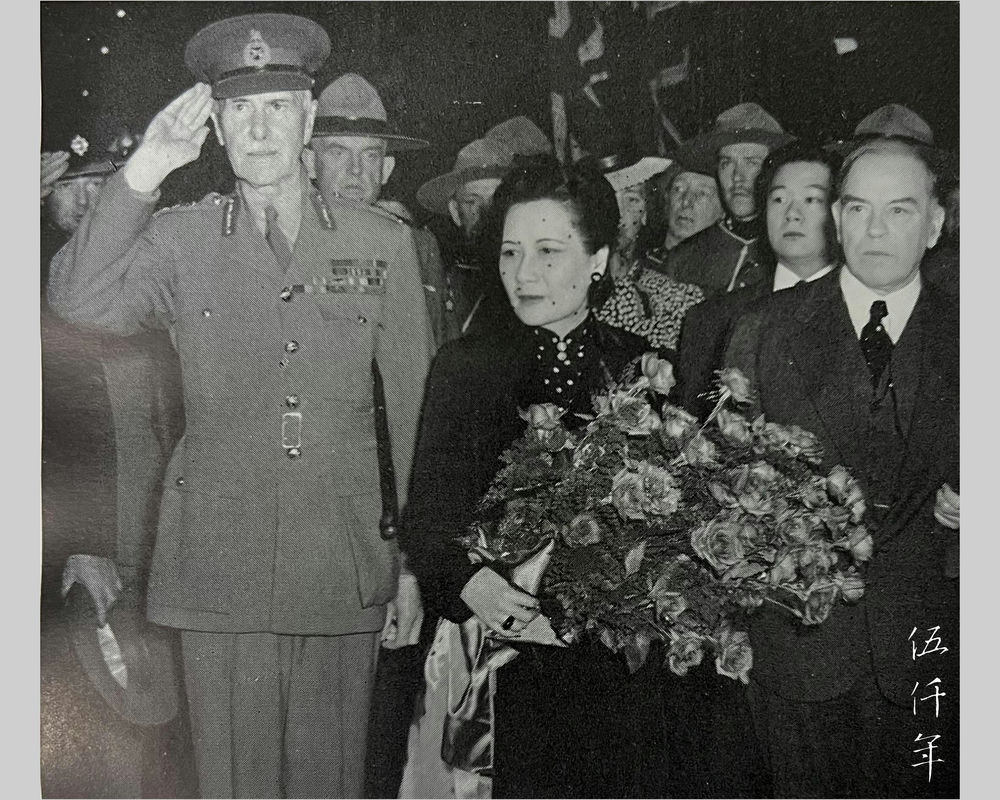
On 15 June 1943, Madame Chiang Kai-shek arrived at the train station in ottawa , the National Anthem of the Republic of China was played. On her left is Governor-General Major General the Earl of Athlone, on her right is Prime Minister Mackenzie King. Photograph courtesy Private Collection

Madame Chiang Kai-shek arrived in Ottawa on 15 June 1943. On 16 June she arrived at the Parliament to address the Senate and the House of Commons. Photograph courtesy Private Collection

View of the floor during Madame Chiang Kai-shek’s address to the Parliament. Madame Chiang was the first woman to address the Parliament of Canada. Photograph courtesy Private Collection

Half a year after Madame Chiang Kai-shek addressed the Canadian Parliament on 16 June 1943, the Canadian Parliament commissioned two custom made leather bound copies of Madame Chiang’s address and associated Parliamentary Proceedings. The Chinese title page was translated by the Chinese Embassy, with the Chinese National Emblem on the top of the page. Thomas Vien, Speaker of the Senate, then presented the two commissioned copies to Ambassador Liu Shih-shun (劉師舜公使), one to him and one to Madame Chiang. The copy displayed here belonged to Madame Chiang, with her name embossed in gold at the lower right on the front cover of the book. Photograph courtesy Private Collection

English title page of custom leather bound book on Madame Chiang Kai-shek’s address to the the Parliament of Canada. Former property of Madame Chiang Kai-shek

Chinese title page of custom leather bound book on Madame Chiang Kai-sheik’s address to the Parliament of Canada. Former property of Madame Chiang Kai-shek

Inside page of custom leather bound book on Madame Chiang Kai-shek’s address to the Parliament of Canada. Former property of Madame Chiang Kai-shek
Confer in Cairo
Confer in Cairo
On 18 November 1943, President Chiang Kai-shek, Madame Chiang Kai-shek, the secretary-general of the Supreme Council of National Defense Wang Ch’ung-hui (王寵惠), the chief of staff of the National Military Council Shang Chen (商震), director of the Chairman’s Attendants First Office Lin Wei (林蔚), director of the Chinese Aviation Commission Chou Chih-jou (周至柔), deputy minister of the Central Propaganda Department Hollington Tong (董顯光), chief aide-de-camp to the Chairman Yü Chi-shih (俞濟時), altogether sixteen of them left the provisional capital Ch’ung-ch’ing by plane and arrived in Cairo on 21 November. Meantime, President Roosevelt of the United States and Prime Minister Churchill of Britain led their aides and advisers to Cairo on 22 and 21 November respectively. Between 23 and 27 November in a total of five days, President Chiang, Roosevelt and Churchill held talks three times, President Chiang and Churchill held talks three times, President Chiang and Roosevelt held talks four times. For the leaders of China, America and Britain to convene a special meeting, it has not been repeated ever since. This event is known in history as the Cairo Conference. For the Cairo Declaration, it was announced simultaneously on 1 December in Ch’ung-ch’ing, Washington and London. The Declaration asserted that all the land Japan occupied in China, including the four provinces in the north-east, Taiwan, P’eng Hu Islands, were to be returned to the Republic of China. Korea was to gain independence, and Japan was to be stripped of her rights over the islands in the Pacific which she had occupied since 1914. China, the United States and Britain were to fight on until the unconditional surrender of Japan.
President Chiang Kai-shek recorded some of his thoughts on the Cairo Conference in his Diary of 28 November 1943. Some lines are:
“Because our conversations, viewpoints and procedures were well ordered and not disorganized during the many consultations that took place this time, the result was better than expected. There are two causes, one was my general trustworthy character, the other was the assistance rendered by my wife. Her contribution was particularly weighty by translating for me and making many arrangements, otherwise this significant result could not have been achieved.”

At 11:45 am on 24 November 1943, leaders of the three nations: President Chiang Kai-shek, Roosevelt and Churchill assembled at Roosevelt’s residence in Cairo to take a group photograph. Roosevelt cordially invited President Chiang to sit in the middle, but he firmly declined and sat himself on the right, hence Churchill sat on the left, and Madame Chiang Kai-shek was invited to join. Photograph courtesy Mr. Roy Delbyck

Portrait of President Chiang Kai-shek, Roosevelt and Madame Chiang Kai-shek taken on 24 November 1943. Photograph courtesy Mr. Roy Delbyck
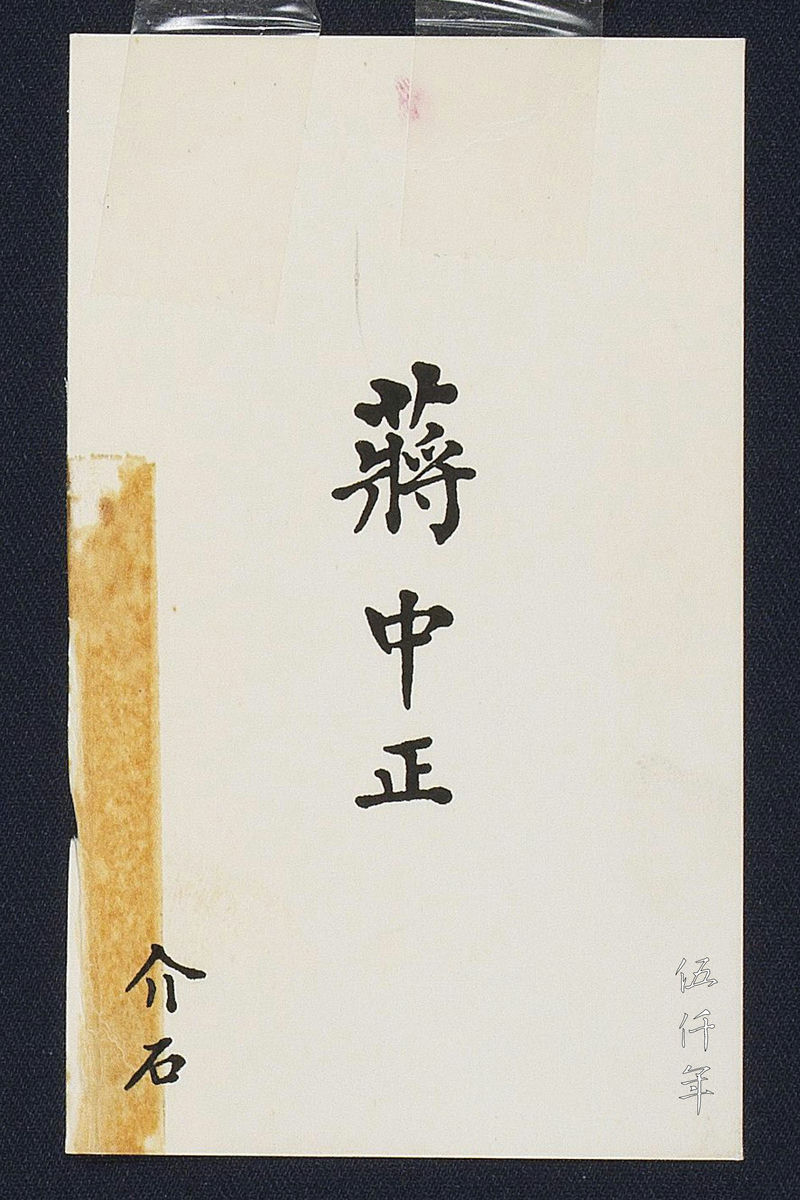
Place card of President Chiang Kai-shek
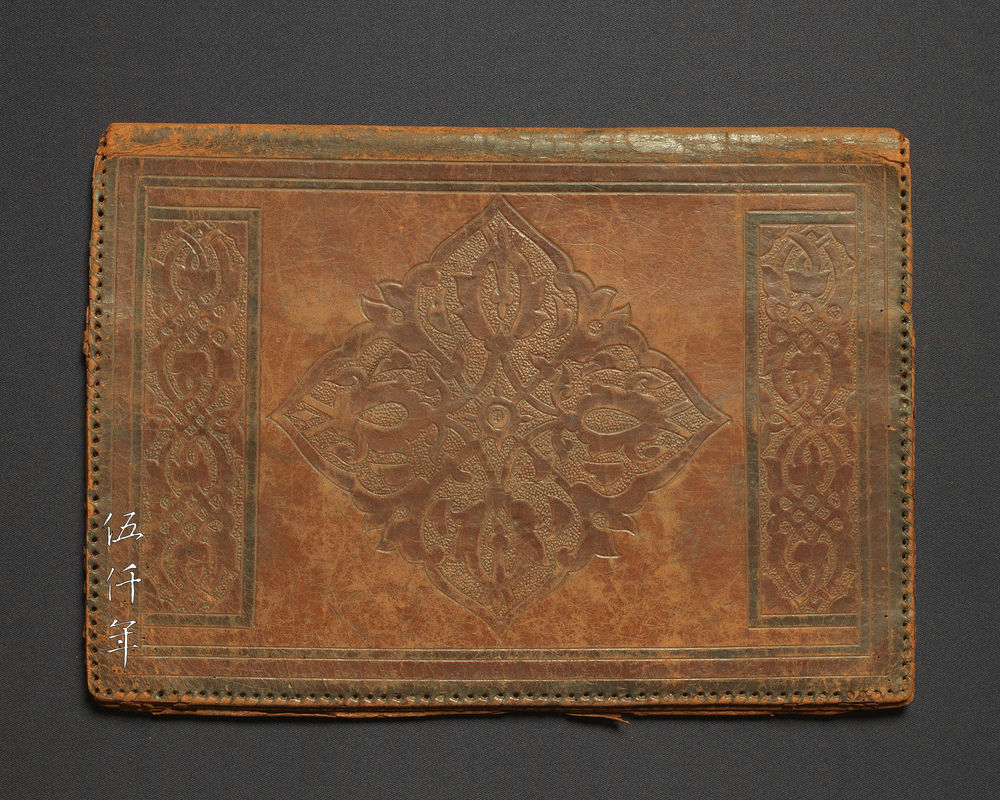
Cover of leather document folder used by Madame Chiang Kai-shek at the Cairo Conference. Upon Madame Chiang’s return from Cairo to China, she gave this leather document folder to her English secretary Mr. Ku Chao-p’eng (古兆鵬先生) as souvenir. Mr. Ku was a native of Hsiang-shan, Kwangtung Province. He graduated from St. John’s University, Shanghai, and was a classmate of President Yen Chia-kan (嚴家淦總統). In December 1960, when Mr. Ku’s youngest daughter Ms. Ku Chih-feng (古稚鳳女士) married Mr. Hsü Ch’eng-tsung (許承宗先生), Mr. Ku presented the leather document folder as a wedding present. Photograph courtesy Mr. Hsü Ch’eng-tsung

Interior of the leather document folder used by Madame Chiang Kai-shek at the Cairo Conference. Photograph courtesy Mr. Hsü Ch’eng-tsung
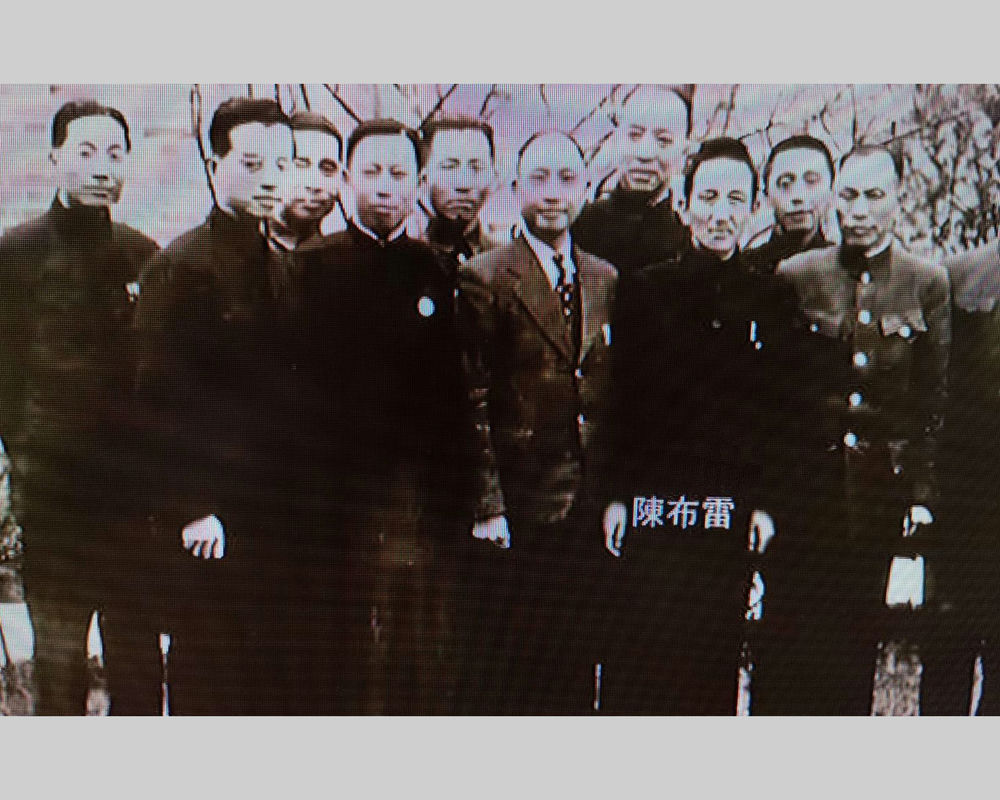
Group photograph of Mr. Ku Chao-peng (centre of first row), Ch’en Pu-lei (陳布雷) who is standing on his right, and others from the Kuomintang Party. Photograph courtesy Mr. Hsü Ch’eng-tsung
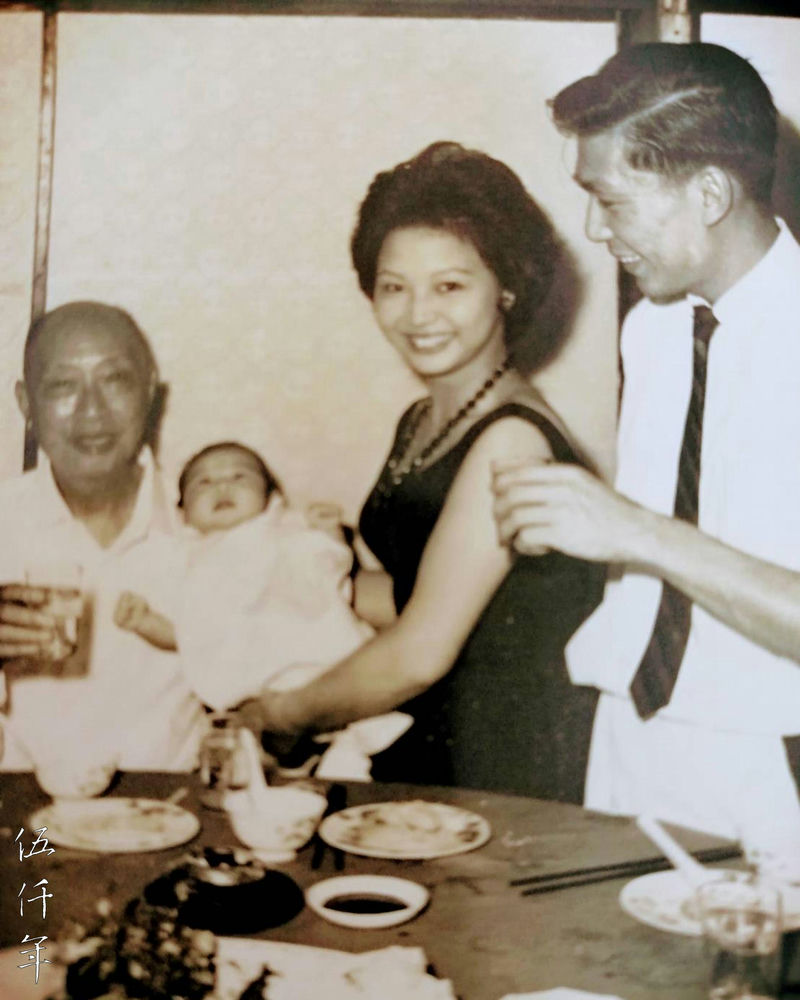
Mr. Ku Chao-peng (left), his daughter Ms. Ku Chih-feng (centre) and Mr. Hsü Ch’eng-tsung (right) in Hong Kong in the 1960s. Photograph courtesy Mr. Hsü Ch’eng-tsung
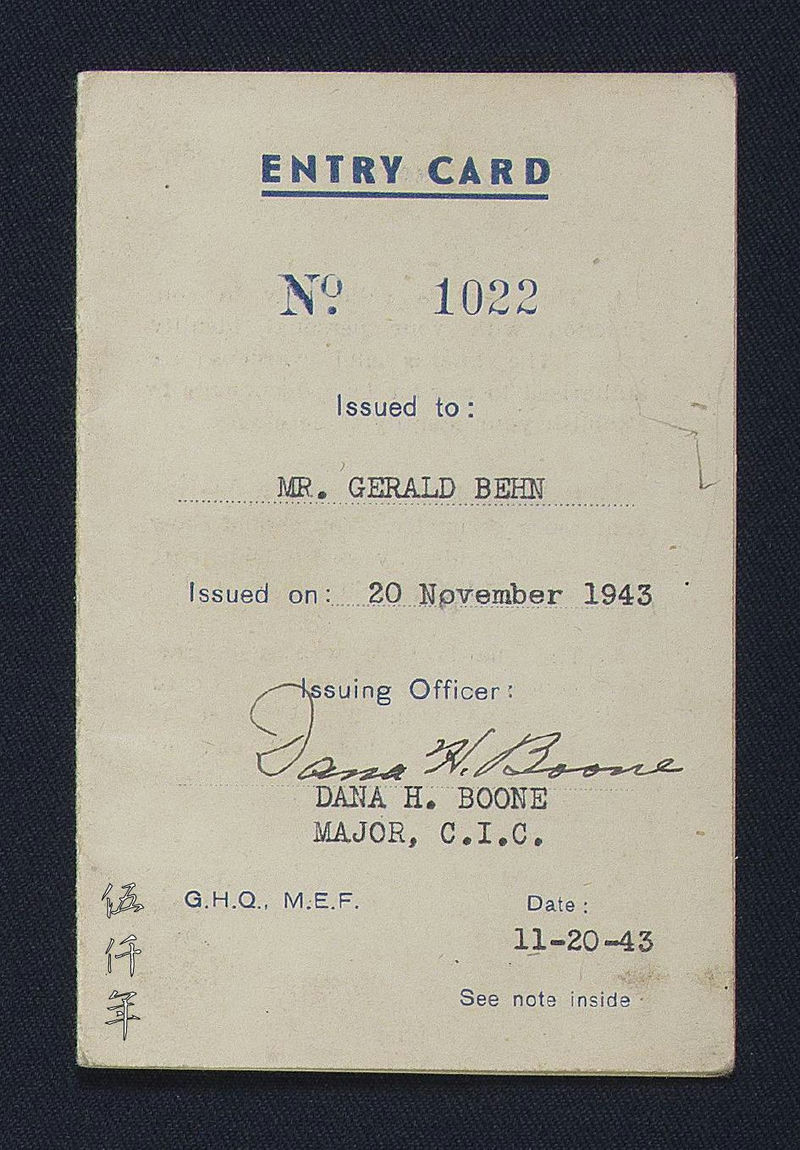
Entry Card issued to Gerald Behn, one of President Roosevelt’s body guards, on 20 November 1943 during the Cairo Conference. Photograph courtesy Mr. Roy Delbyck
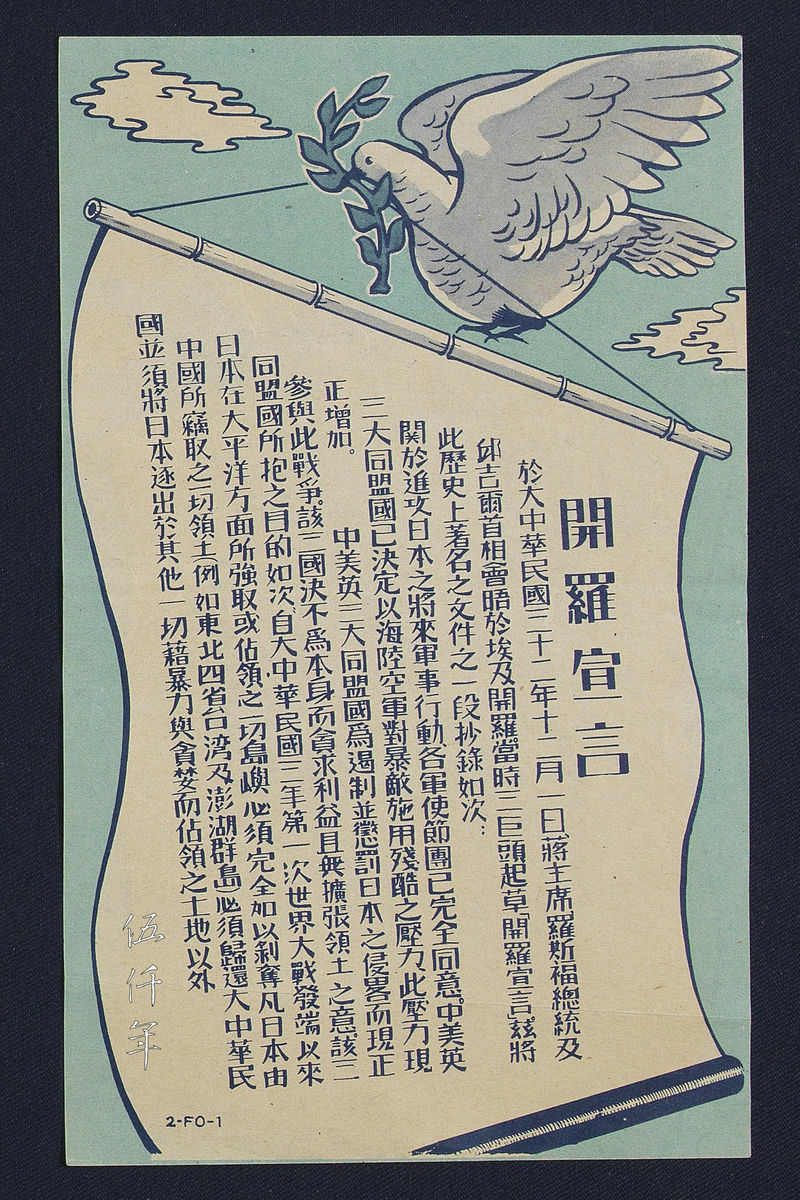
Poster of the Cairo Declaration in Chinese, which was jointly released by the Republic of China, the United States and Great Britain on 1 December 1943. Photograph courtesy Mr. Roy Delbyck

President Chiang Kai-shek and Madame Chiang Kai-shek left Cairo for Karachi on 27 November 1943, and they arrived in the provisional capital Ch’ung-ch’ing on 1 December. This letter was sent from the secretary of Madame Chiang to Brigadier Scott of the British Army in Cairo, thanking him for his assistance in Cairo. Photograph courtesy Mr. Alan Goldstein
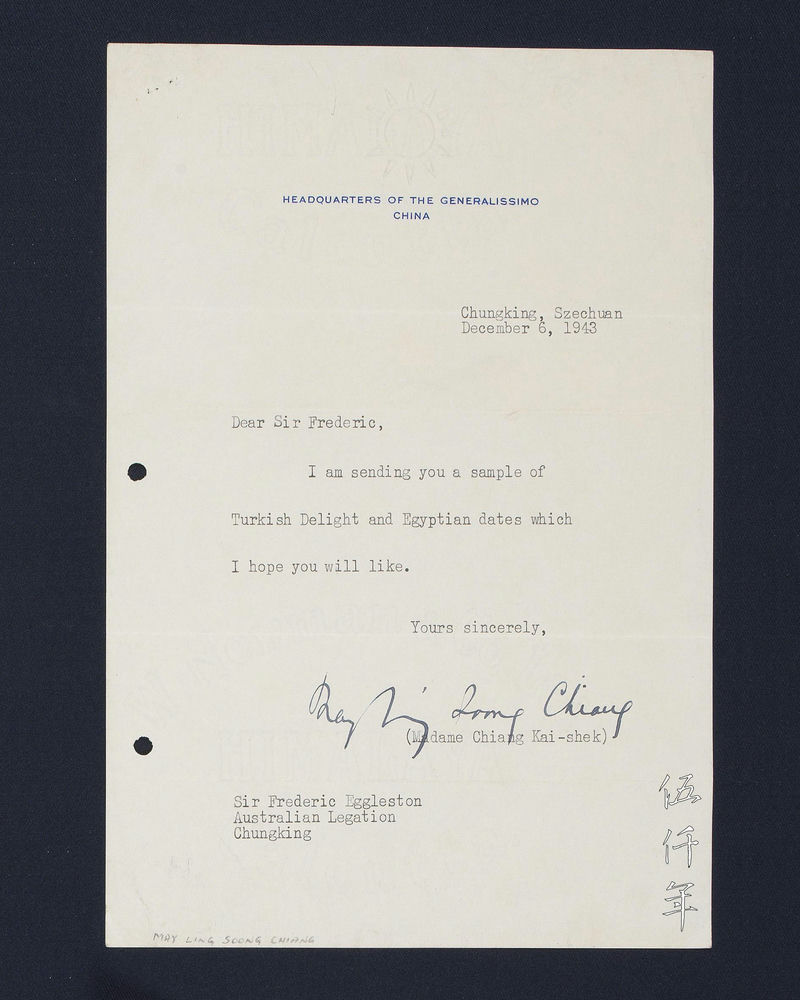
Letter to Frederic Eggleston, the Australian Ambassador to China, from Madame Chiang Kai-shek, on sending him some Turkish Delight and Egyptian dates. This letter was dated 6 December 1943. President Chiang Kai-shek and Madame Chiang Kai-shek left Cairo on 27 November for Karachi, and they arrived in Ch’ung-ch’ing, the provisional capital, on 1 December. One can assume that the Turkish Delight and Egyptian dates were brought back from Cairo. Photograph courtesy Mr. Roy Delbyck
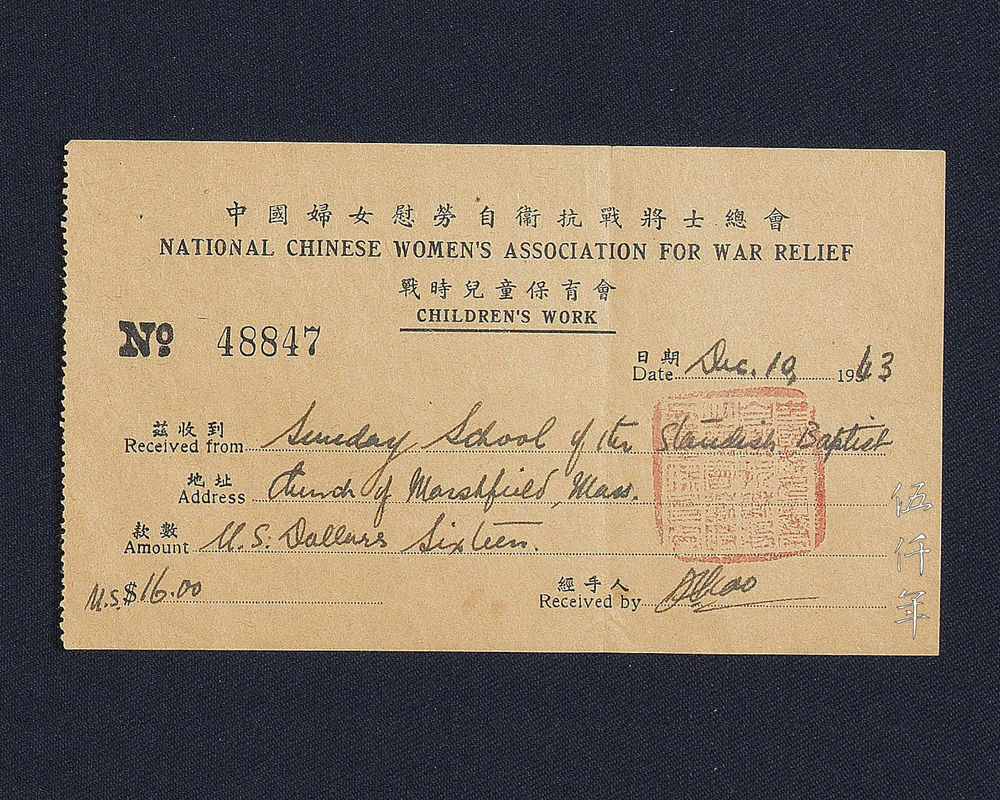
Donation receipt dated 10 December 1943 from the Society for the Care of War-Time Children under the National Chinese Women’s Association for War Relief, which were both founded by Madame Chiang Kai-shek. Photograph courtesy Mr. Roy Delbyck

Thank you letter from the office of Madame Chiang-shek regarding the donation, dated 17 December 1943. Photograph courtesy Mr. Roy Delbyck
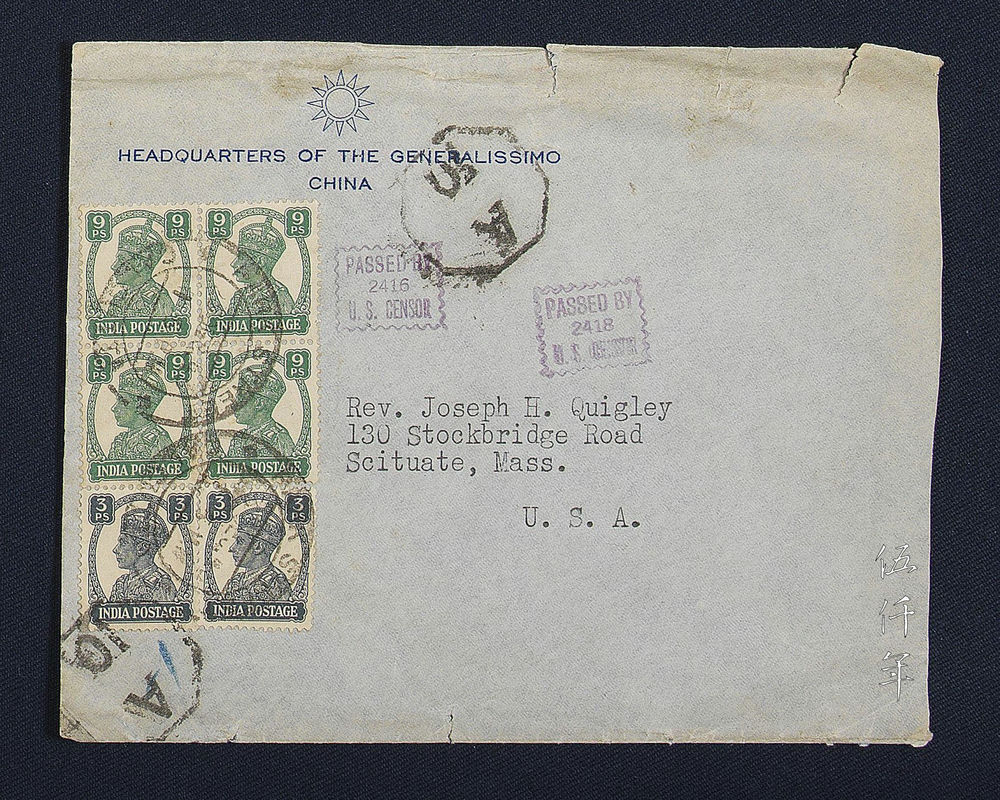
Envelope for the letter and receipt from the office of Madame Chiang Kai-shek. Photograph courtesy Mr. Roy Delbyck
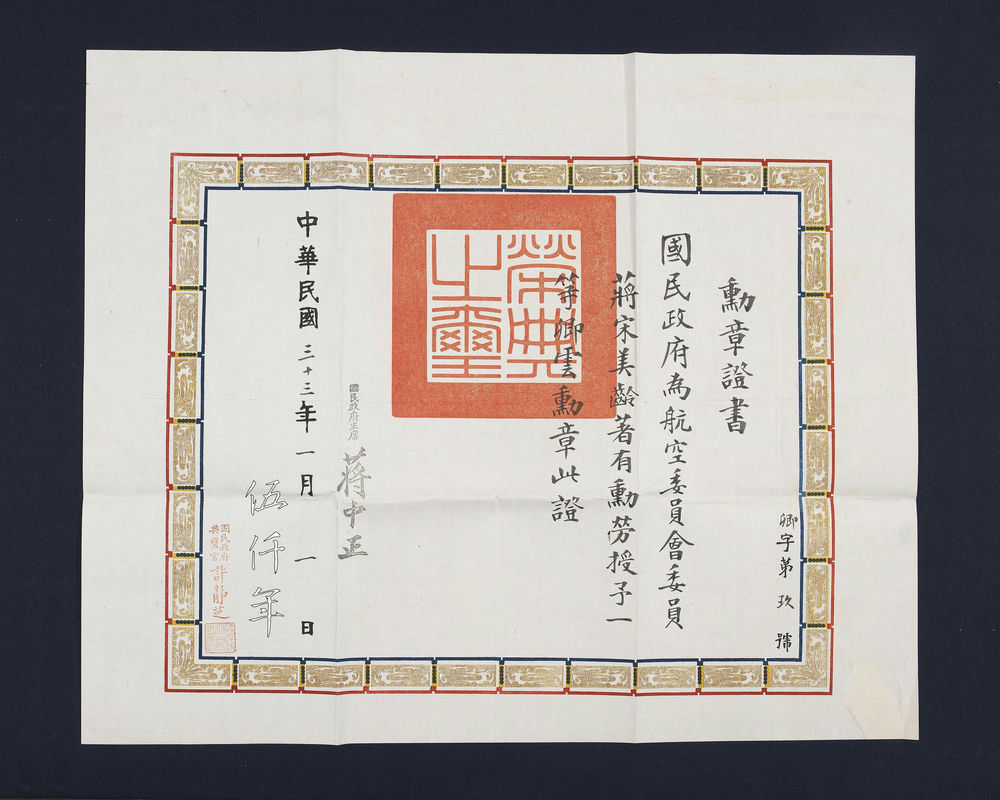
Madame Chiang Kai-shek contributed tremendously to the success of the Cairo Conference. On 1 January 1944, she was awarded the Order of Propitious Clouds First Class, accompanied by a medal certificate. Photograph courtesy Private Collection

Envelope of the medal certificate. Photograph courtesy Private Collection
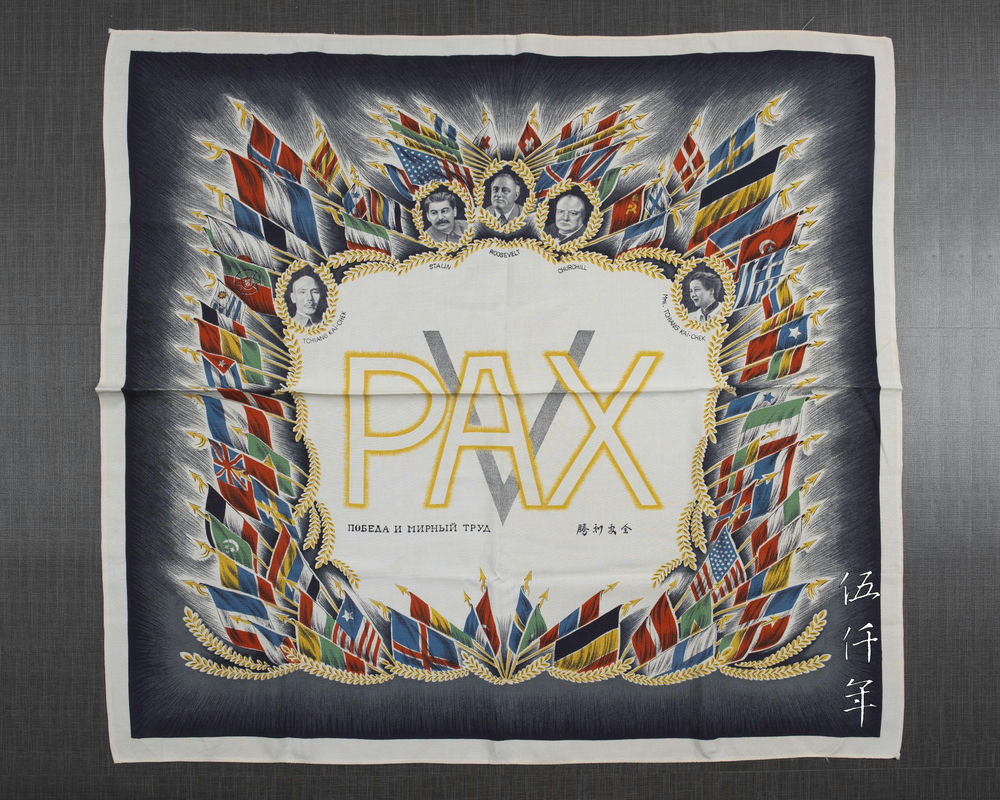
Rayon scarf with the theme of Cairo Conference manufactured in the Soviet Union. Although Stalin did not attend the Cairo Conference, his picture was placed on the scarf. Photograph courtesy Mr. Roy Delbyck
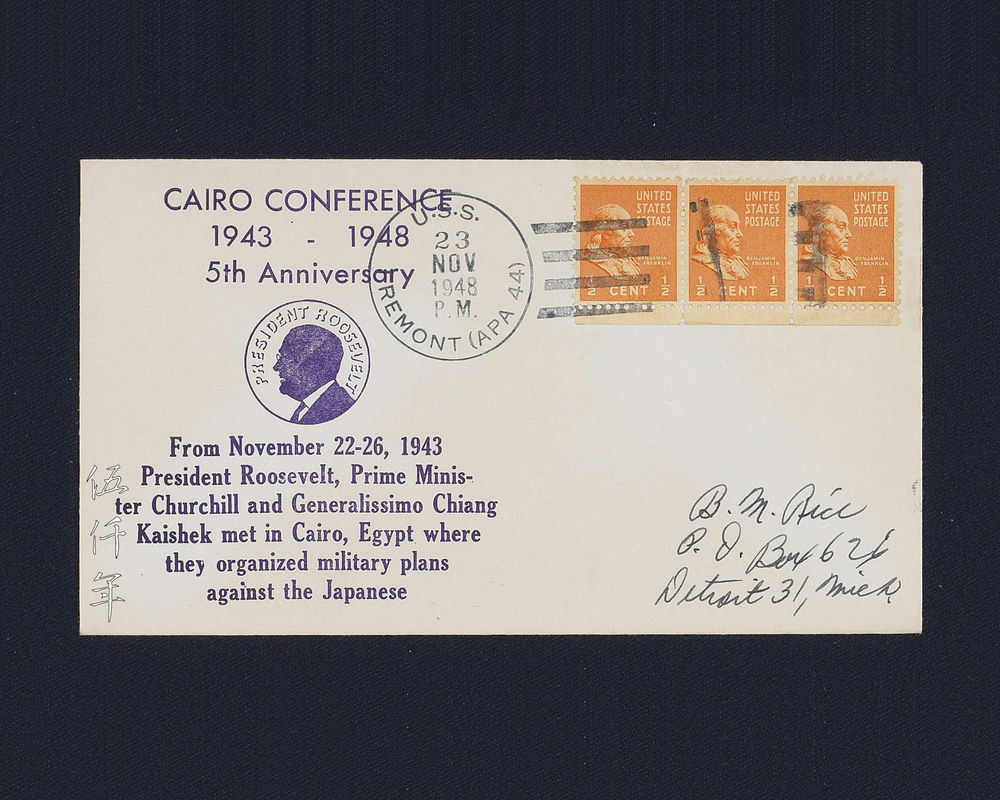
United States First Day Cover affixed with postage stamps to commemorate the fifth anniversary of the Cairo Conference, postmark dated 23 November 1948. Photograph courtesy Mr. Roy Delbyck
Fleeting Victory
Fleeting Victory
On 15 August 1945, in the 34th year of the Republic, Japan announced its unconditional surrender to the Allies. On 2 September the Allies’ representatives held the Japanese surrender ceremony aboard the USS Missouri and signed the surrender documents. On 9 September at 9 o’clock, a ceremony to sign the unconditional surrender document for the Japanese forces in the China War Theater took place in the auditorium of the Central Military Academy in Nanking. While the war against Japan was victorious, catastrophe lay ahead.
On 6 August 1945, the 34th year of the Republic, the United States dropped the first atomic bomb on Hiroshima, Japan. On 8 August they dropped the second atomic bomb on Nagasaki. On 9 August the Soviet Union opportunistically declared war on Japan and entered the conflict by launching a three-pronged military offensive to occupy China’s North and Northeast regions, joining with Chinese communist forces. During the eight-year-long war against Japan, the communist forces avoided battle while expanding their army. According to statistics, in 1937, the 26th year of the Republic, the Chinese communists controlled over 35,000 square miles of land, population number of 1.5 million, and an army of 100,000. By 1945, the 34th year of the Republic, the Chinese communists had extended its control over 225,000 square miles of land, a population of 65 million, and an army of 910,000. In 1947, the 36th year of the Republic, the Chinese communists asked further assistance from the Soviet Union and signed the Harbin Agreement.
During the eight years of the war against Japan, the government maintained a military force of six million personnel. In 1939, the 28th year of the Republic, military spending accounted for 51.8% of the national budget, and by 1945, the 34th year of the Republic, it had risen to 69%. The war resulted in casualties of more than 20 million civilians, whilst the army suffered over 3.21 million deaths, injuries, and disappearances. The air force had 4,321 casualties and lost 2,468 aircraft, while the navy saw the near-total loss of its vessels. Additionally, 206 high-ranking military officials lost their lives. Despite victory in war, China’s economy was ruined, and its society had disintegrated.
The United States, however, used economic aid as leverage to pressure the National Government to accommodate the political participation of the Chinese communists, and American support virtually ended. On 28 November 1948, the 37th year of the Republic, Madame Chiang Kai-shek volunteered to visit the United States to try to seek American aid. She arrived in Washington on 1 December and appealed to U.S. Secretary of State George Marshall to prevent the communist forces from conquering China. The National Government also submitted an urgent appeal on 15 December to the U.S. Congress. Both Marshall and President Truman ignored these pleas and refused to provide assistance which was in stark contrast to the situation when Madame Chiang visited the United States in 1943. In December of the 38th year of the Republic (1949), mainland China fell to the communists, and on 13 January 1950, the 39th year of the Republic, Madame Chiang arrived in Taipei from the United States.
In 1958 the former U.S. military commander in China, General Albert Coady Wedemeyer, published Wedemeyer Reports. In one section, he analyzed:
“Roosevelt’s strategy was to restore the balance in the Far East by accepting Kuomintang China as a potential democracy nation and future Great Power. But he never faced the problems of providing Chiang Kai-shek with the stability and strength needed to realize the potentials: some officials in the lower echelons of the State Department saw to that. Furthermore, in concentrating too long on the defeat of Germany, we let a friendly China become drastically enfeebled. And after the war, as we have seen, we did nothing to help the Chinese Nationalists recoup their strength and retain their control of the vital resources of Manchuria. So the Czars’ historic strategy for Asia ultimately won, after all. The Communists simply moved in.”
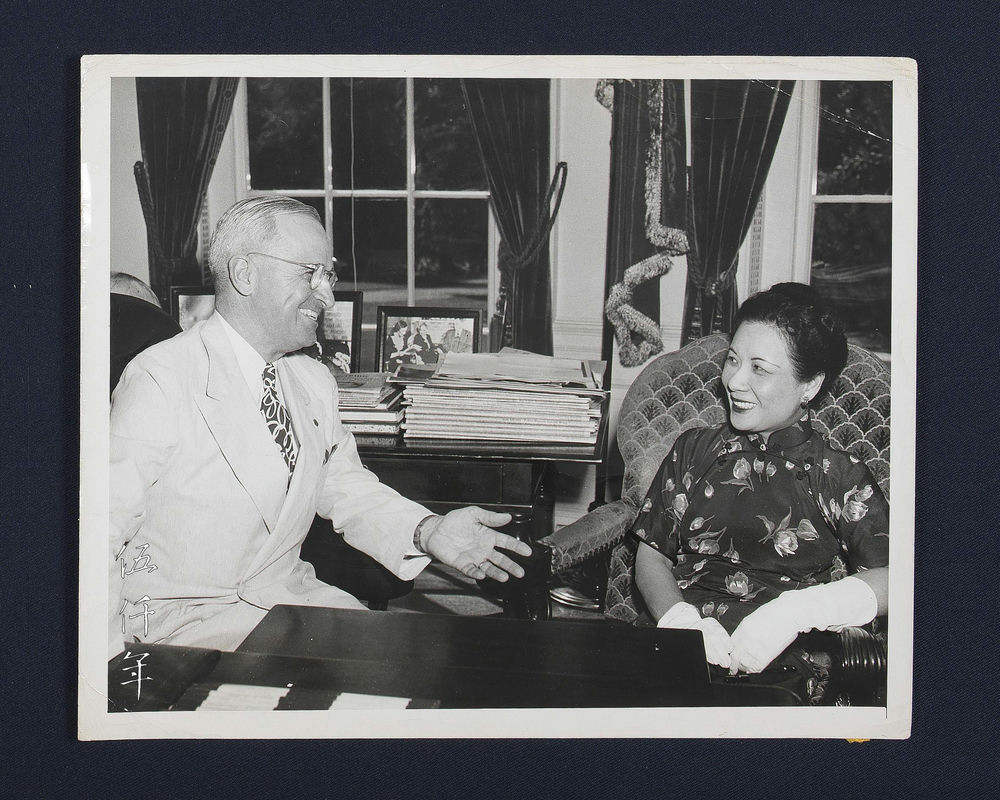
Madame Chiang Kai-shek visiting President Truman at the White House for the first time on 29 August 1945. Photograph courtesy Mr. Roy Delbyck
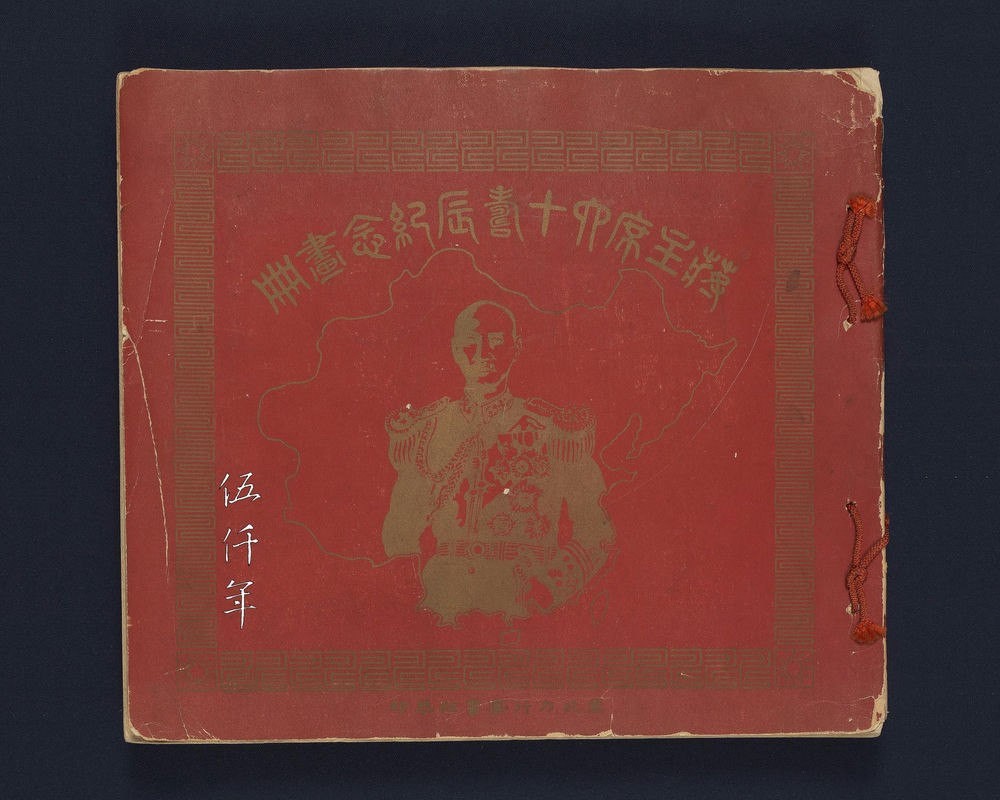
Front cover of Pictorial Book to Commemorate the Sixtieth Birthday of President Chiang Kai-shek, published in 1946. Photograph courtesy Mr. Roy Delbyck

Inside page of Pictorial Book to Commemorate the Sixtieth Birthday of President Chiang Kai-shek with image of ancient tile. Photograph courtesy Mr. Roy Delbyck
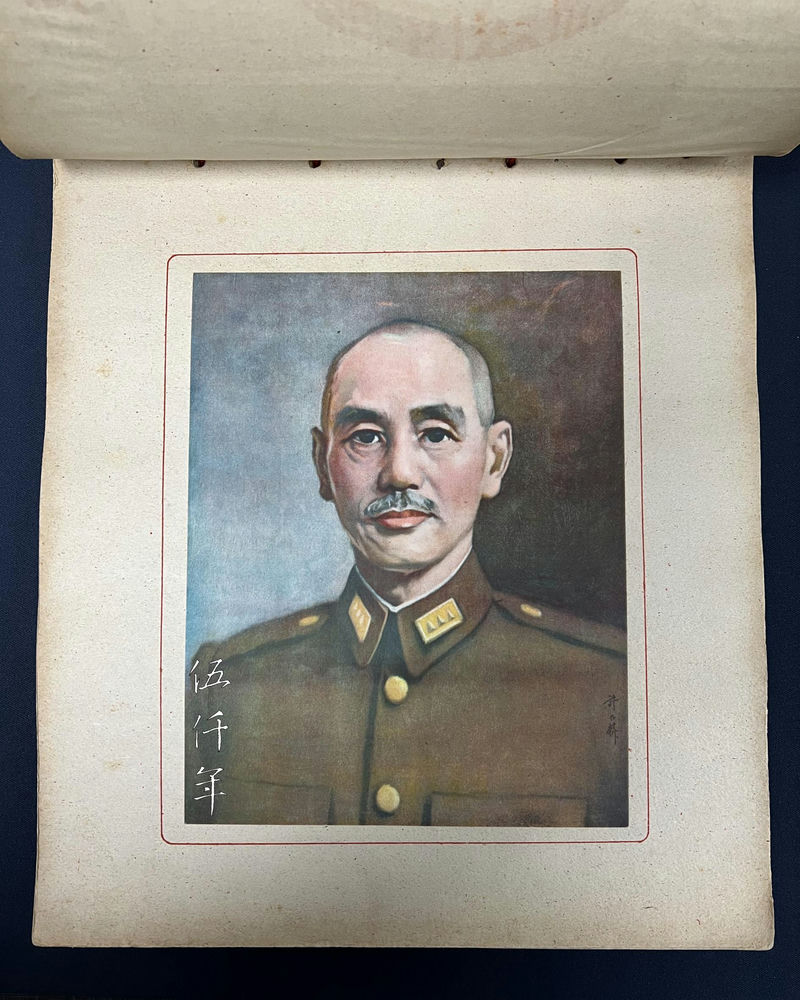
Inside page of Pictorial Book to Commemorate the Sixtieth Birthday of President Chiang Kai-shek with portrait of President Chiang. Photograph courtesy Mr. Roy Delbyck

Inside page of Pictorial Book to Commemorate the Sixtieth Birthday of President Chiang Kai-shek with portrait of Madame Chiang Kai-shek. Photograph courtesy Mr. Roy Delbyck
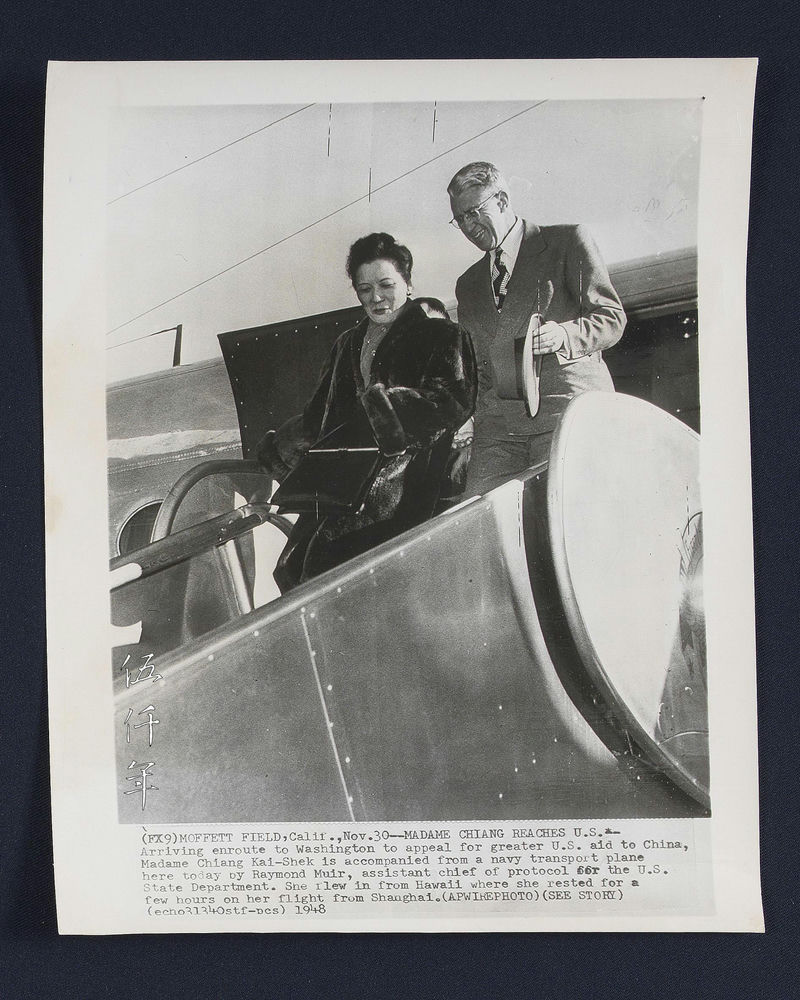
On 30 November 1948, Madame Chiang Kai-shek arrived in Washington once more to seek American aid to counter the communist insurrection. Photograph courtesy Mr. Roy Delbyck
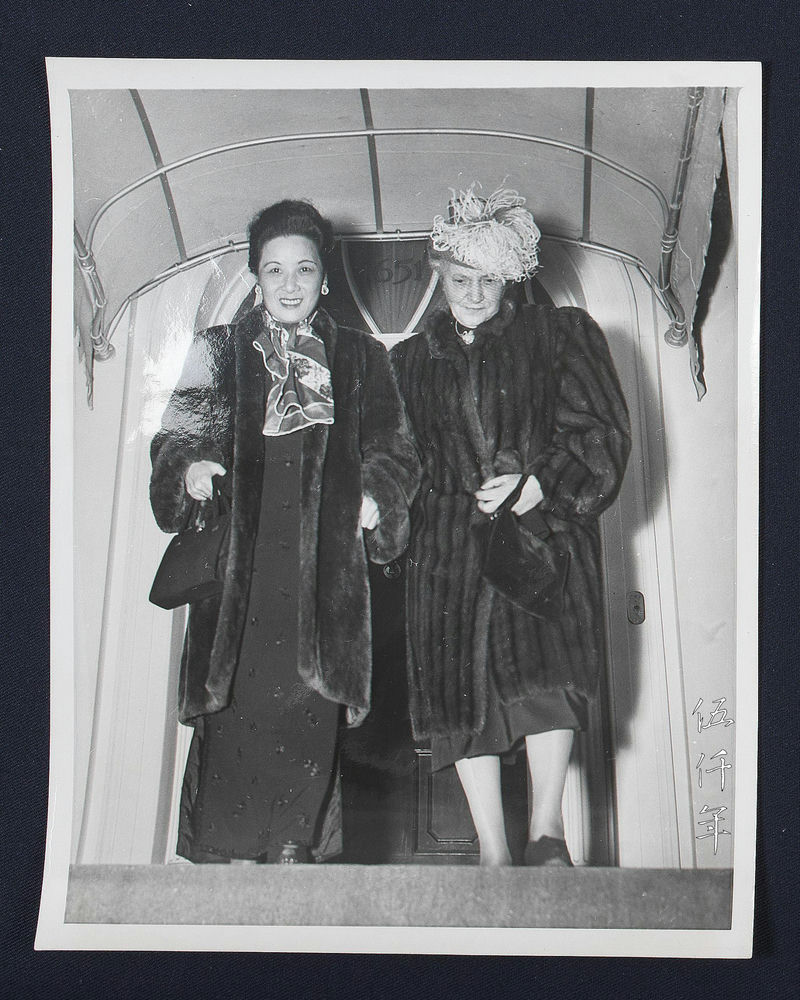
On 10 December 1948, Madame Chiang Kai-shek walked out of Mrs Truman’s house after tea in the company of Mrs. Marshall. Photograph courtesy Mr. Roy Delbyck
Freedom Beachhead
Freedom Beachhead
On 13 January 1950, the 39th year of the Republic, Madame Chiang arrived in Taipei from America. On 17 April she established the Chinese Women’s Anti-Communist and Anti-Russian Federation (中華婦女反共抗俄聯合會), and she served as the chairperson. Subsequently, it was renamed as the National Women’s League of the Republic of China (中華民國婦女聯合會). On 4 August 1952, the 41st year of the Republic, Madame Chiang initiated the establishment of the Taiwan Provincial Anti-Tuberculosis Association (臺灣省防癆協會) which was renamed as Republic of China Anti-Tuberculosis Association (中華民國防癆協會) on 4 January 1958 the 47th year of the Republic. In January 1955, the 44th year of the Republic, Madame Chiang, concerned about the education of the orphans left by the martyred soldiers in the Battle of Ichiangshan Island (一江山戰役) and the Battle of Tachen Islands (大陳島戰役), founded the Kwanghua Children’s Home (光華育幼院) which in the following year was renamed Hua Hsing Children’s Home (華興育幼院). In 1958, the 47th year of the Republic, she became the honorary chairperson of the China National Amateur Athletic Federation (中華全國體育協進會). On 17 July 1973, the 62nd year of the Republic, it was renamed the Republic of China Sports Promotion Association (中華民國體育協進會) and later renamed the Republic of China Sports Federation (中華體育運動總會). In April 1967, the 56th year of the Republic, she founded the Cheng Hsin Rehabilitation Medical Center (振興復健醫學中心) to treat polio and served as the chairperson. It was later renamed the Cheng Hsin General Hospital (振興醫院). On 19 December 1967, the 56th year of the Republic, she became the chairperson of Fu Jen Catholic University (輔仁大學), serving in that position for as long as twenty five years. She is remembered for virtuous nature and enduring deeds.
After the government relocated to Taiwan, Madame Chiang utilized her diplomatic skills to maintain and strengthen ties with those American friends who supported Free China, using their best efforts to influence American policy towards the Republic of China. It is said that such American friends, also known as China Lobby, delayed for nearly thirty years the severance of diplomatic relations between the United States and the Republic of China, and for this, credit is due to the significant role of Madame Chiang.
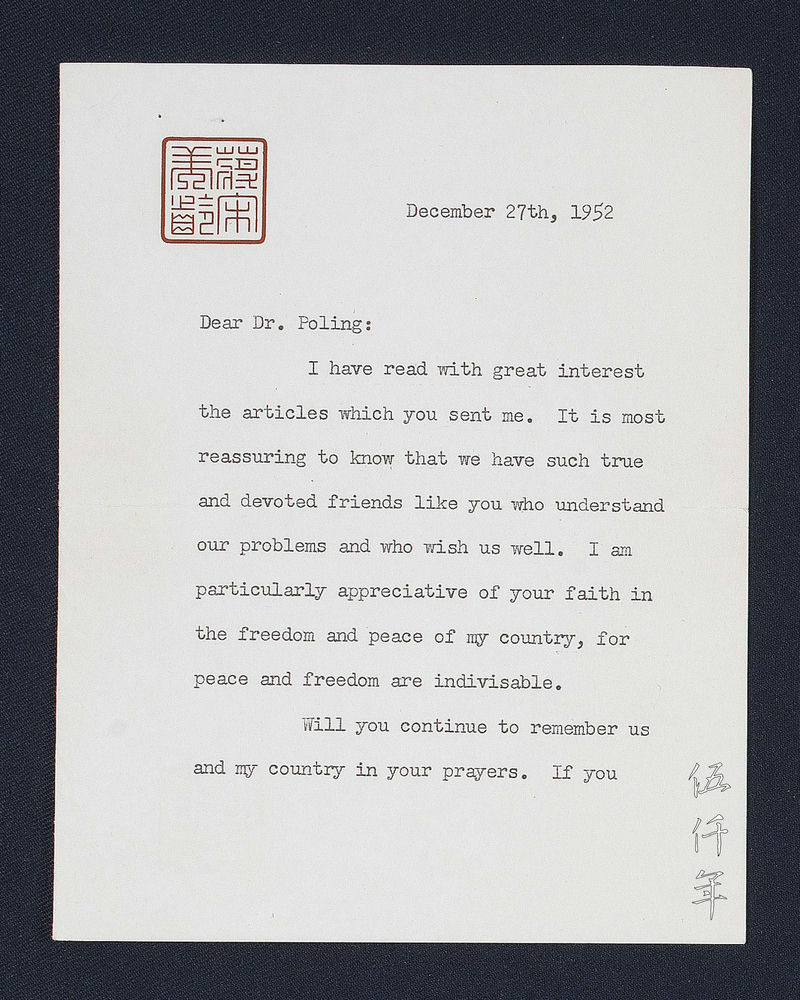
First page of letter to Daniel Poling from Madame Chiang Kai-shek on his support for the Republic of China. The letter was dated 27 December 1952. Photograph courtesy Mr. Roy Delbyck

Second page of letter to Daniel Poling from Madame Chiang Kai-shek on his support for the Republic of China. The letter was dated 27 December 1952. Photograph courtesy Mr. Roy Delbyck
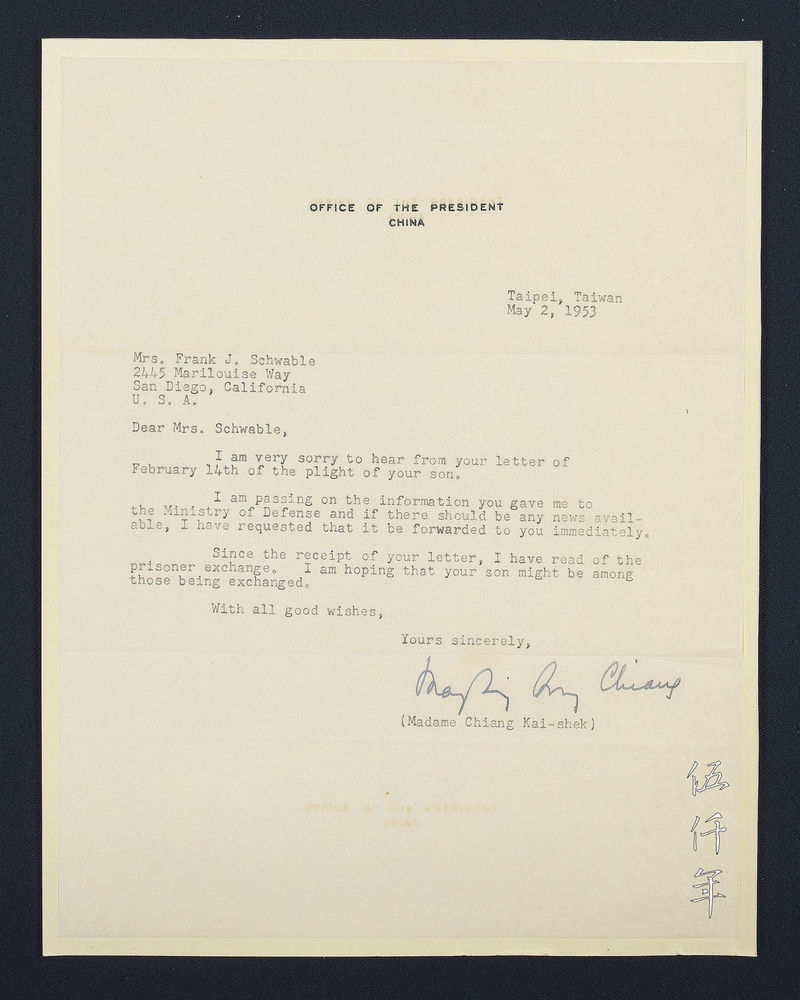
Madame Chiang Kai-shek wrote a reply letter to comfort the mother of an American soldier captured in Korea. The letter was dated 2 May 1953. Photograph courtesy Mr. Roy Delbyck

Envelope of reply letter from Madame Chiang Kai-shek. Photograph courtesy Mr. Roy Delbyck
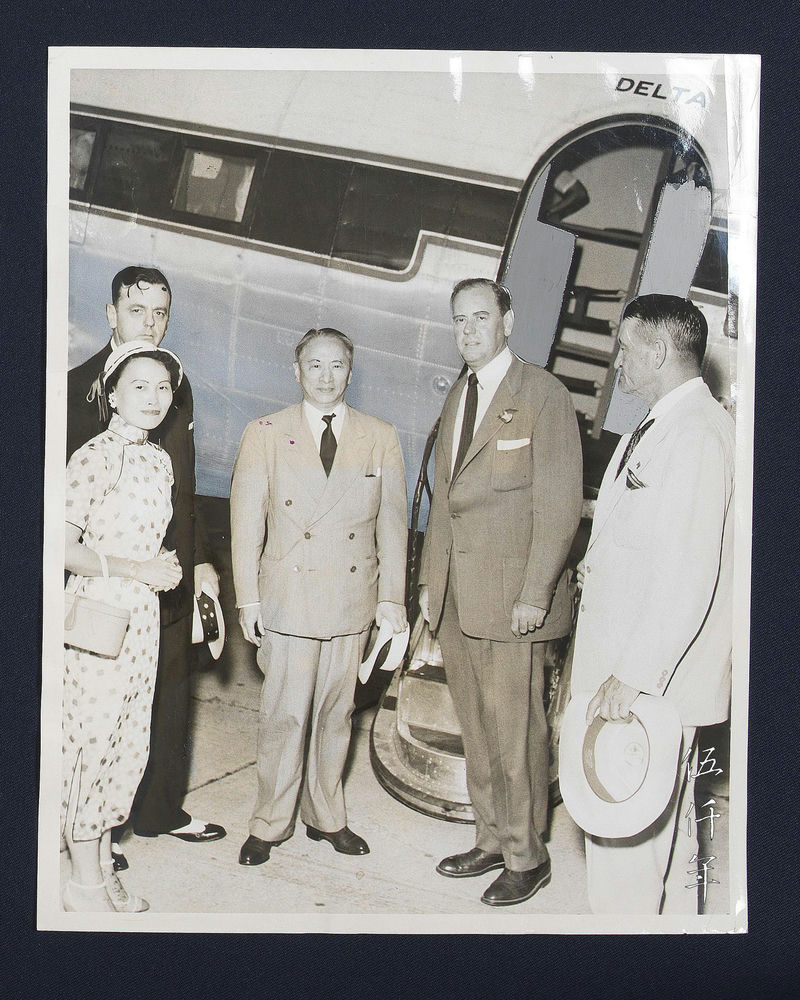
Ambassador Wellington Koo Vi Kyuin arriving at the airport of Monroe on 28 June 1953 to attend the Chiang Kai-shek Day Rally. General Claire Chennault (first right), Mayor John Coon (second right) and Mrs. Claire Chennault (first left) on hand to greet Ambassador Koo. Photograph courtesy Mr. Roy Delbyck
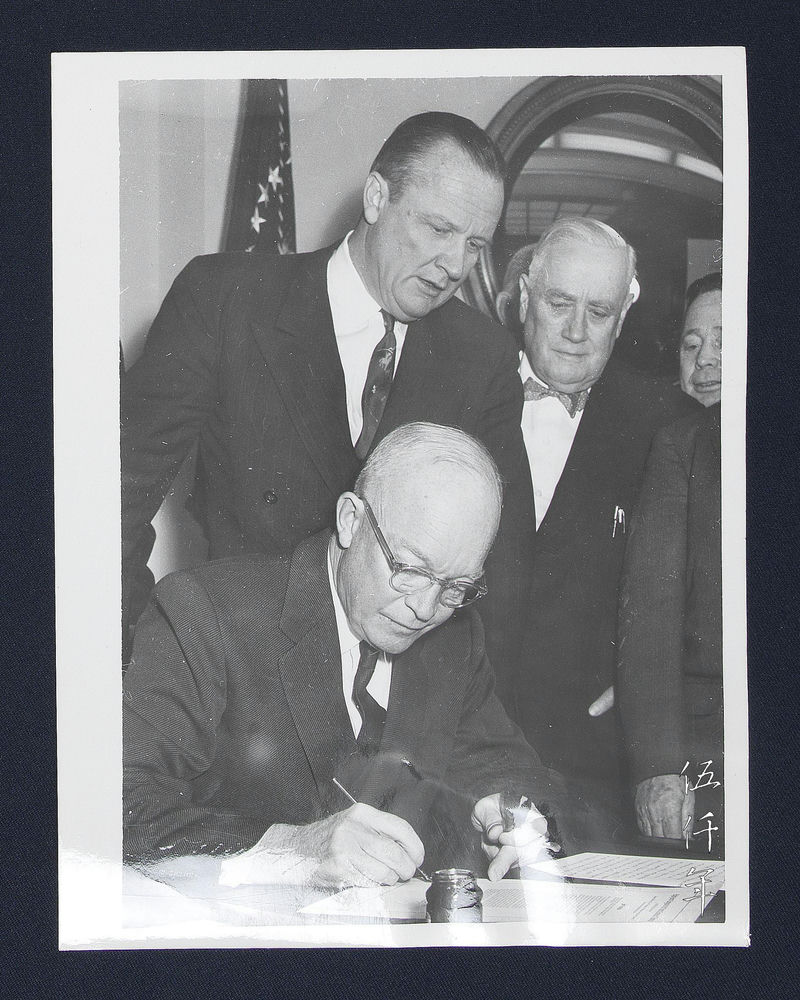
President Eisenhower signs the Formosa Resolution in 1955. Standing behind him is Senator William Knowland. Photograph courtesy Mr. Roy Delbyck

On 9 April 1956, Mr. And Mrs. Randolph Hearst visited President Chiang Kai-shek and Madame Chiang Kai-shek. Photograph courtesy Mr. Roy Delbyck
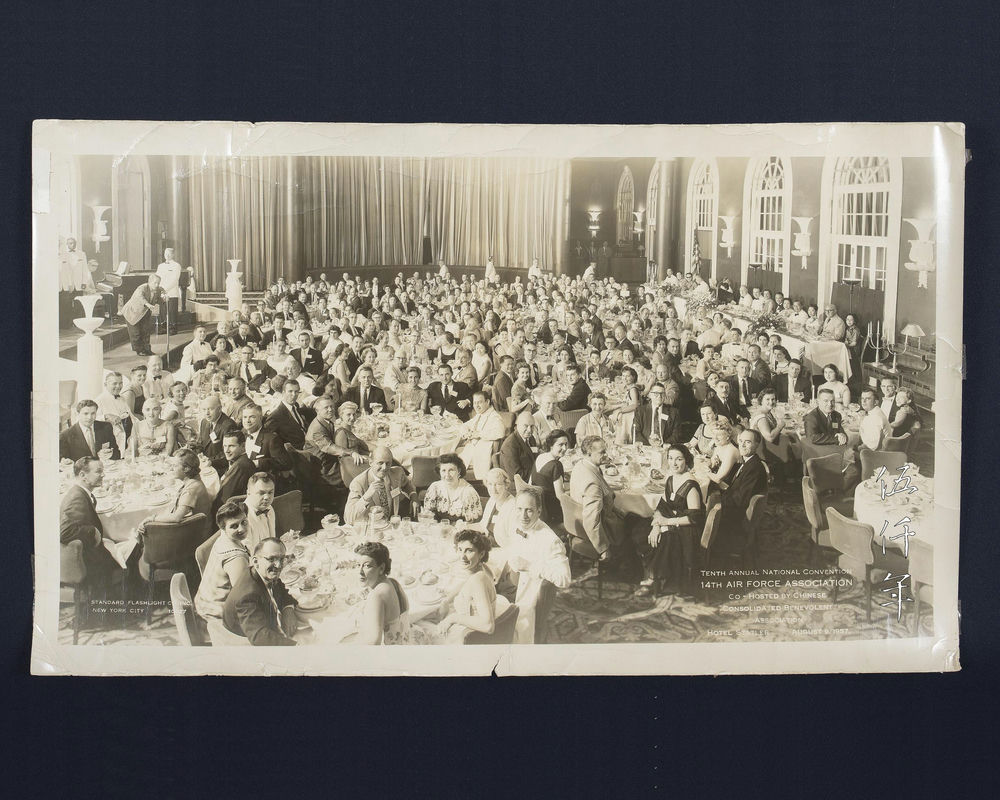
The Tenth Annual National Convention of the 14th Air Force Association (14th Air Force is formerly the American Volunteer Group of the Republic of China), co-hosted by the Chinese Consolidated Benevolent Association on 9 August 1957. Photograph courtesy Mr. Roy Delbyck

Madame Chiang Kai-shek visited General Claire Chennault in New Orleans on 13 July 1958 where he was in the Ochsner Foundation Hospital battling throat cancer. Standing behind him is Madame Claire Chennault. Photograph courtesy Mr. Roy Delbyck

Photograph of Madame Chiang Kai-shek in 1958. Photograph courtesy Mr. Roy Delbyck
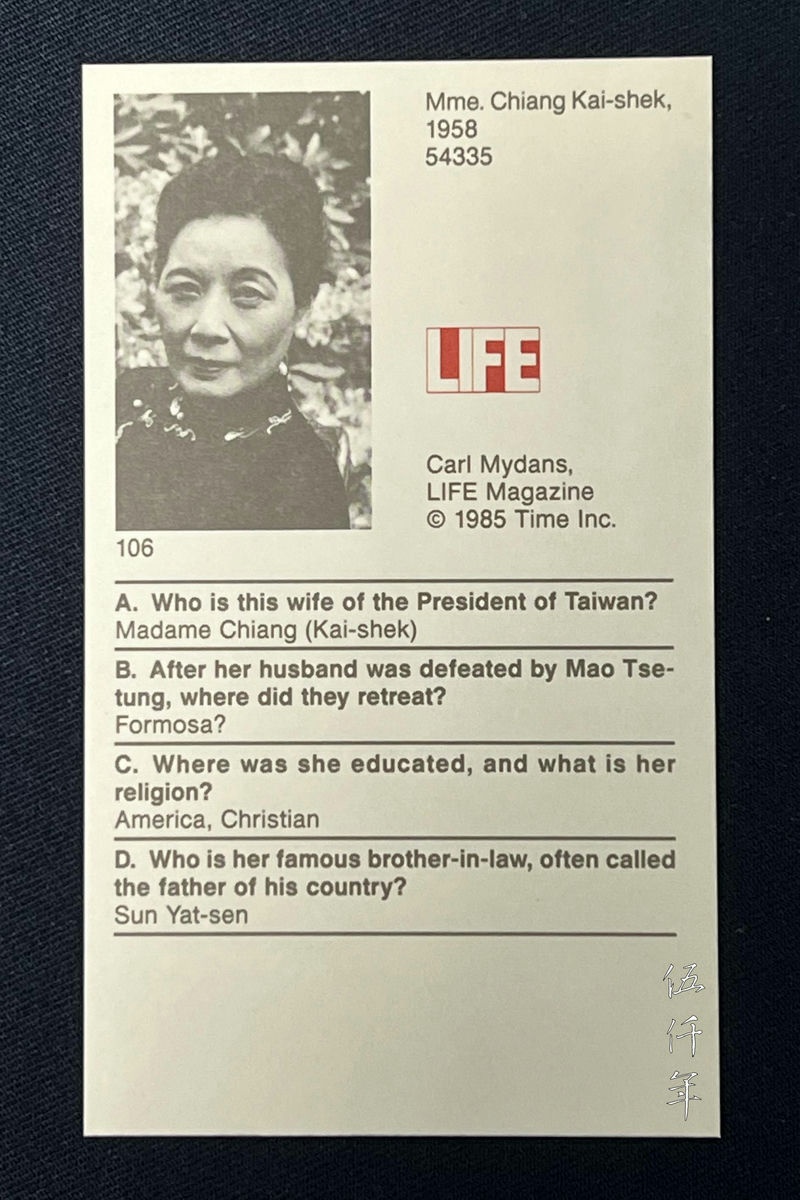
Introduction card of Madame Chiang Kai-shek printed by Life Magazine in 1958. Photograph courtesy Mr. Roy Delbyck

On 16 July 1958, Madame Chiang Kai-shek visited President Eisenhower in the White House. Mrs. Eisenhower standing on the left. Photograph courtesy Mr. Roy Delbyck

On 18 June 1960, President Eisenhower visited the Republic of China. The China Post printed a supplement with the heading: Welcome Ike to Free China. Photograph courtesy Mr. Roy Delbyck

On 18 June 1960, President Eisenhower visited the Republic of China. Nearly 500,000 people turned out to greet him outside the Presidential Office Building. He raised his arms to thank the audience after his speech. He was accompanied by President Chiang Kai-shek and Madame Chiang Kai-shek. Photograph courtesy Mr. Roy Delbyck
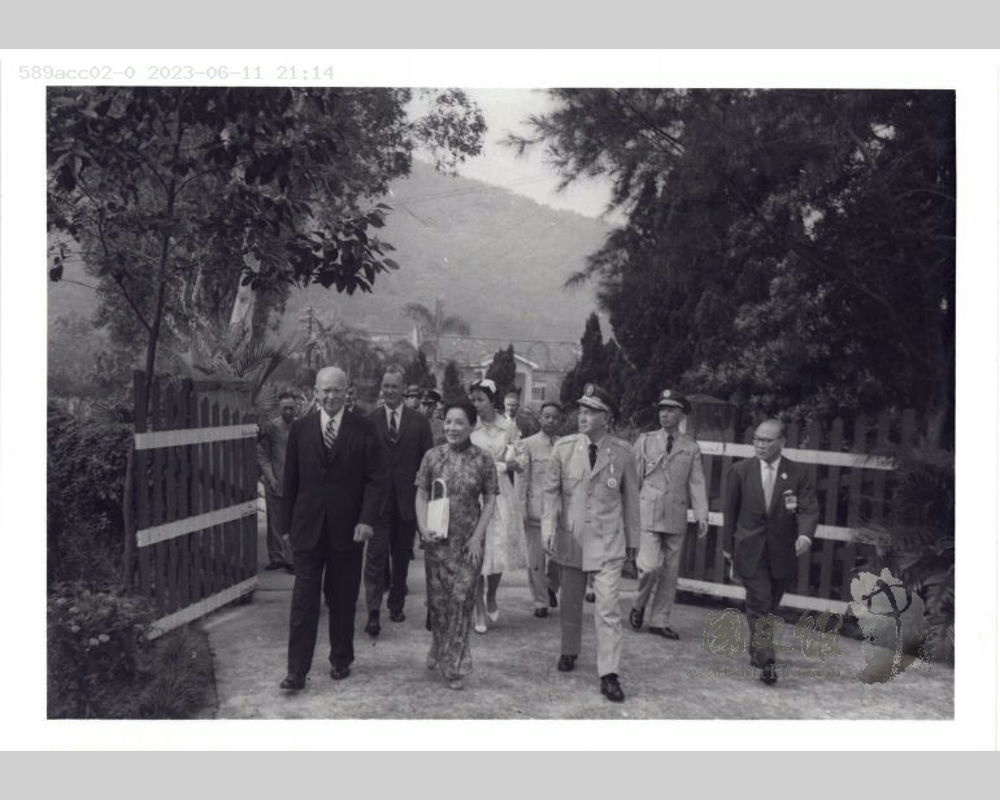
President Chiang Kai-shek and Madame Chiang Kai-shek giving President Eisenhower a tour of the presidential residence. Photograph courtesy Academia Historia

Madame Chiang Kai-shek receiving Vice Admiral Arthur Struble, commander of the Seventh Fleet, sometime between May 1950 and March 1951. Photograph courtesy Academia Historia
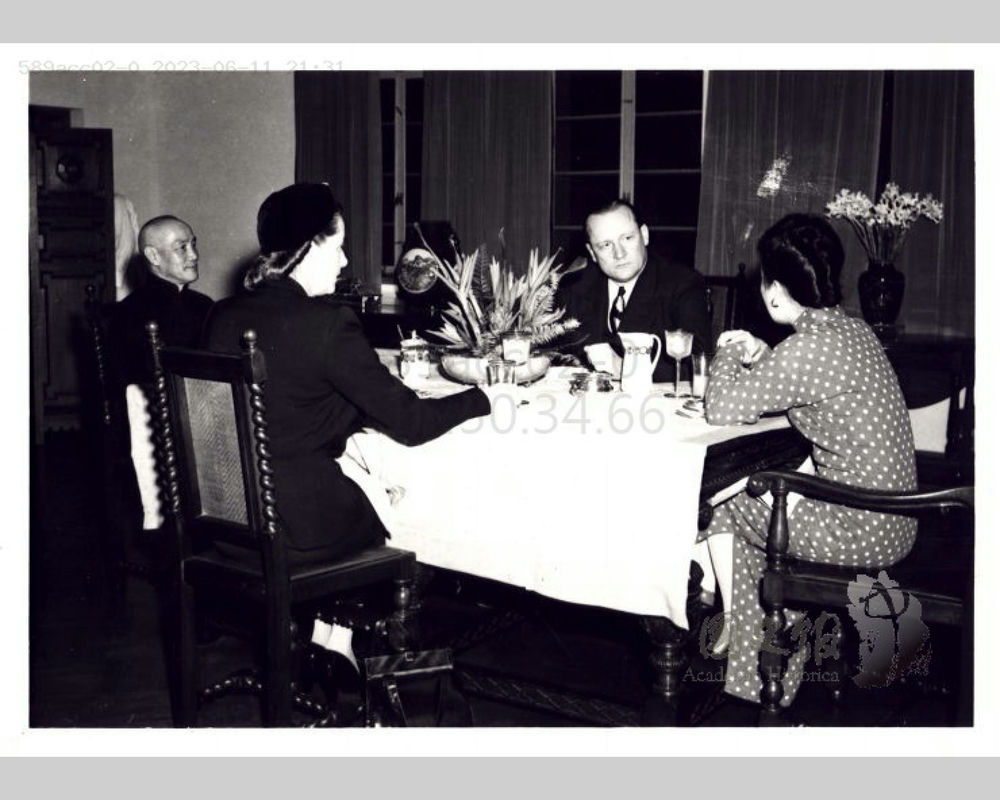
President Chiang Kai-shek and Madame Chiang Kai-shek receiving Senator William Knowland and Mrs. Knowland. Photograph courtesy Academia Historia

President Chiang Kai-shek and Madame Chiang Kai-shek receiving Francis Spellman, the Archbishop of New York. Photograph courtesy Academia Historia
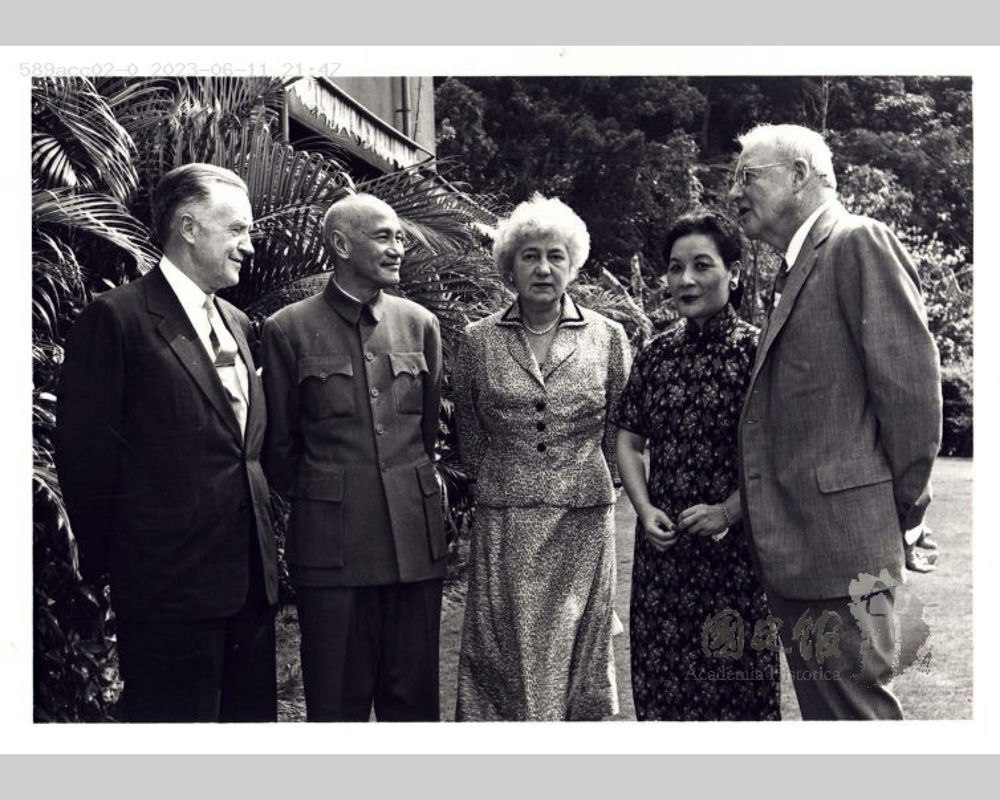
President Chiang Kai-shek and Madame Chiang Kai-shek receiving Secretary of State John Dulles and Assistant Secretary of State Walter Robertson in 1958. Photograph courtesy Academia Historia

President Chiang Kai-shek and Madame Chiang Kai-shek receiving Vice President Lyndon Johnson. Photograph courtesy Academia Historia
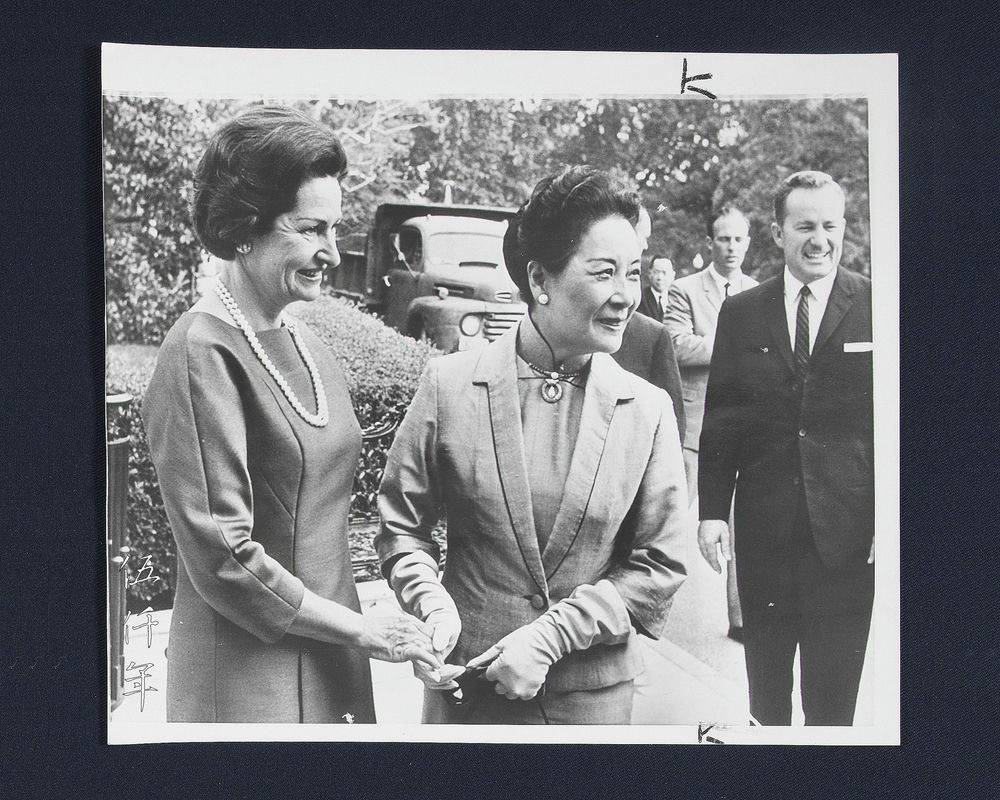
Madame Chiang Kai-shek visiting President Lyndon Johnson in the White House on 15 September 1965. She was greeted at the south entrance by Mrs. Lyndon Johnson. Photograph courtesy Mr. Roy Delbyck.

On 30 October in the 57th year of the Republic (1968), President Chiang Kai-shek and Madame Chiang Kai-shek attended the graduation ceremony of the Republic of China Military Academy. President Chiang Kai-shek awarding the graduation certificate to Mr. Kao Hua-chu, who later became the Defense Minister. This is also the last time President Chiang Kai-shek attended the graduation ceremony of the Republic of China Military Academy. Photograph courtesy Minister Kao Hua-chu
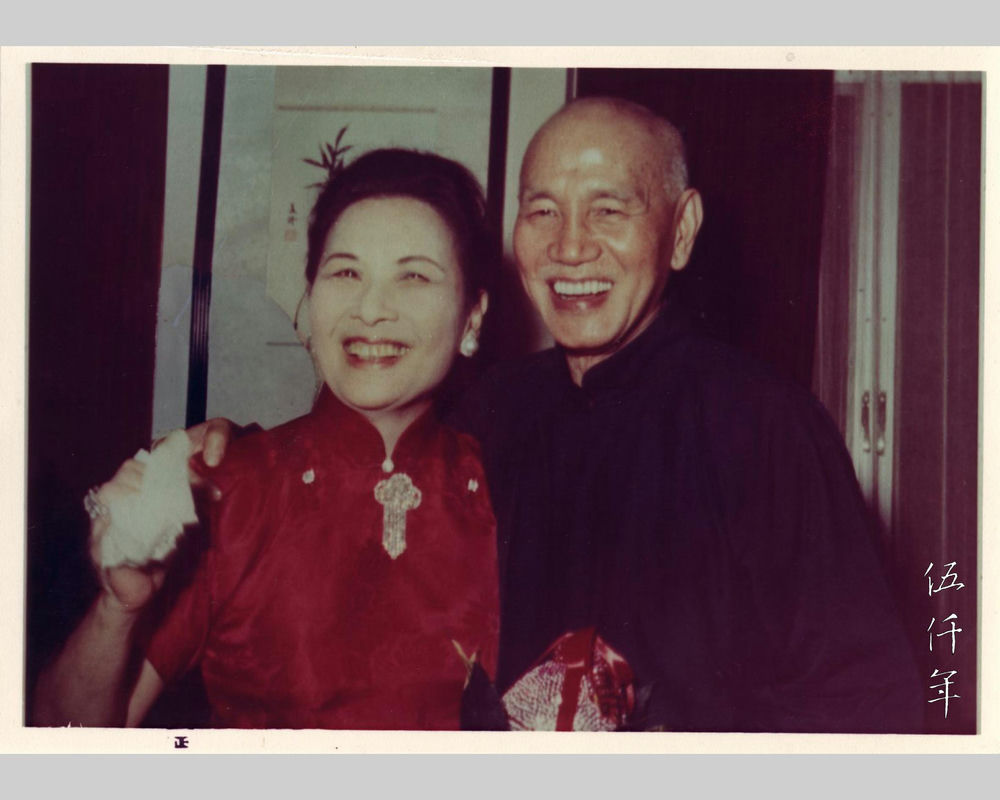
President Chiang Kai-shek and Madame Chiang Kai-shek in their twilight years

Painting of lotus by Madame Chiang Kai-shek. Photograph courtesy Mr. Yang Wei-han
